Exhibit 99.78
Scott Wilson Mining
LAKE SHORE GOLD CORP.
TECHNICAL REPORT ON THE INITIAL MINERAL RESOURCE ESTIMATE FOR THE BELL CREEK MINE, HOYLE TOWNSHIP, TIMMINS, ONTARIO, CANADA
NI 43-101 Report
Author:
Reno Pressacco, M.Sc. (Applied), P. Geo.
January 14, 2011
SCOTT WILSON ROSCOE POSTLE ASSOCIATES INC.
Report Control Form | | | |
| | | |
Document Title | Technical Report on the Initial Mineral Resource Estimate for the Bell Creek mine, Hoyle Township, Timmins, Ontario, Canada |
| | | |
Client Name & Address | Lake Shore Gold Corp. | | |
| 181 University Ave., Suite 2000 | | |
| Toronto, ON, Canada M5H 3M7 | | |
| | | |
Document Reference | Project #1512 | Status & Issue No. | Final Version | |
| | | | |
Issue Date | January 14, 2011 | | | |
| | | |
Lead Author | | | |
| Reno Pressacco | | (Signed) |
| | | |
Peer Reviewer | | | |
| Luke Evans | | (Signed) |
| | | |
Project Manager Approval | | | |
| Luke Evans | | (Signed) |
| | | |
Project Director Approval | | | |
| Wayne Valliant | | (Signed) |
| | | |
Report Distribution | Name | | No. of Copies |
| Client | | |
| | | |
| Scott Wilson RPA Filing | | 1 (project box) |
| | | 1 (project file) |
| | | | | | | |
Scott Wilson Roscoe Postle Associates Inc. | |
55 University Avenue, Suite 501 | |
Toronto, Ontario M5J 2H7 | |
Canada | |
Tel: +1 416 947 0907 | |
Fax: +1 416 947 0395 | |
mining@scottwilson.com | |
SCOTT WILSON RPA
TABLE OF CONTENTS
| | PAGE |
| | |
1 SUMMARY | 1-1 |
| Executive Summary | 1-1 |
| Technical Summary | 1-5 |
2 INTRODUCTION | 2-1 |
3 RELIANCE ON OTHER EXPERTS | 3-1 |
4 PROPERTY DESCRIPTION AND LOCATION | 4-1 |
5 ACCESSIBILITY, CLIMATE, LOCAL RESOURCES, INFRASTRUCTURE AND PHYSIOGRAPHY | 5-1 |
6 HISTORY | 6-1 |
7 GEOLOGICAL SETTING | 7-1 |
| Regional Geology | 7-1 |
| Property Geology | 7-11 |
8 DEPOSIT TYPES | 8-1 |
9 MINERALIZATION | 9-1 |
10 EXPLORATION | 10-1 |
11 DRILLING | 11-1 |
12 SAMPLING METHOD AND APPROACH | 12-1 |
13 SAMPLE PREPARATION, ANALYSES AND SECURITY | 13-1 |
14 DATA VERIFICATION | 14-1 |
15 ADJACENT PROPERTIES | 15-1 |
16 MINERAL PROCESSING AND METALLURGICAL TESTING | 16-1 |
17 MINERAL RESOURCE AND MINERAL RESERVE ESTIMATES | 17-1 |
| Summary | 17-1 |
| Mineral Resources | 17-2 |
| Mineral Reserves | 17-69 |
18 OTHER RELEVANT DATA AND INFORMATION | 18-1 |
19 ADDITIONAL REQUIREMENTS | 19-1 |
20 INTERPRETATION AND CONCLUSIONS | 20-1 |
21 RECOMMENDATIONS | 21-1 |
22 REFERENCES | 22-1 |
23 DATE AND SIGNATURE PAGE | 23-1 |
24 CERTIFICATE OF QUALIFIED PERSON | 24-1 |
25 APPENDIX 1 | 25-1 |
| | | |
i
| Variograms | 25-1 |
26 APPENDIX 2 | 26-1 |
| QA/QC Control Charts | 26-1 |
LIST OF TABLES
| PAGE |
| |
Table 1-1 Mineral Resource Estimate - November 2010 | 1-3 |
Table 1-2 Summary of Historic Drilling at Bell Creek | 1-11 |
Table 1-3 Exploration Drilling - 2005 to 2010 | 1-12 |
Table 4-1 Bell Creek Land Tenure, Taxes and Royalties | 4-5 |
Table 6-1 Previous Work Done in the Hoyle Township Area by the Government of Ontario | 6-2 |
Table 6-2 Bell Creek Historical Production | 6-3 |
Table 6-3 2004 NI 43-101 Compliant Resource Estimate for Bell Creek | 6-3 |
Table 6-4 Work on the Schumacher Property by Previous Operators | 6-4 |
Table 6-5 Historic Resource Estimate for the Schumacher Property | 6-5 |
Table 7-1 Summary of Porcupine Camp Tectonic Assemblages | 7-6 |
Table 7-2 Sequence of Geological Events for the Timmins Camp (Simplified) | 7-8 |
Table 8-1 Porcupine District Operations with Greater than 100,000 oz Au Production | 8-2 |
Table 10-1 Exploration Programs 2005 to 2010 | 10-2 |
Table 11-1 Historic Drilling at Bell Creek | 11-1 |
Table 11-2 Significant Results from Historic Drilling at Bell Creek | 11-3 |
Table 11-3 Significant Results from Recent Drilling by Lake Shore Gold at Bell Creek | 11-7 |
Table 14-1 Results of the Scott Wilson RPA Check Assaying Program | 14-2 |
Table 14-2 Results of the Scott Wilson RPA Database Spot Check Audit | 14-3 |
Table 16-1 Summary of Results for Metallurgical Testing Conducted by Amax on Bell Creek Mineralization (1983) | 16-1 |
Table 17-1 Estimated Mineral Resource by Domain as at November 2010 | 17-1 |
Table 17-2 Summary of the Drill Hole Database (as at October 26, 2010) | 17-3 |
Table 17-3 Descriptive Statistics of the Raw Assays Contained Within the Mineralized Domains | 17-16 |
Table 17-4 Descriptive Statistics of the Capped and Uncapped Composite Assays Contained Within the Mineralized Domains | 17-22 |
Table 17-5 Bulk Density Results | 17-24 |
Table 17-6 Summary of Variography Results | 17-33 |
Table 17-7 Summary of Block Model Limits | 17-34 |
Table 17-8 Summary of Block Model Attributes | 17-34 |
Table 17-9 Summary of Cut-off Grade Input Parameters Estimates | 17-36 |
Table 17-10 Tonnage and Grade (Unclassified, Inclusive of Internal Dilution) Within the 2.2 g/t Au Mineralized Domains | 17-43 |
Table 17-11 Cut-off Grade Sensitivity Analysis (Inclusive of Internal Dilution) | 17-44 |
Table 17-12 Distribution of Contained Gold by Level, All Domains | 17-46 |
Table 17-13 Estimated Horizontal Width (In Metres) of the Mineral Resource Outlines by Level, All Domains | 17-49 |
ii
Table 17-14 Block Model Reconciliation Report | 17-57 |
Table 17-15 Estimated Mineral Resources by Domain as at November 2010 | 17-59 |
Table 17-16 Distribution of Mineral Resources by Royalty Claims | 17-69 |
Table 20-1 Mineral Resource Estimate - November 2010 | 20-2 |
LIST OF FIGURES
| PAGE |
| |
Figure 1-1 Grade-Tonnage Graph as a Function of Cut-off Grade | 1-3 |
Figure 4-1 Location Map | 4-2 |
Figure 4-2 Location of the Mineral Resources Relative to Surface Infrastructure | 4-7 |
Figure 4-3 Claim Map of the Bell Creek Mine | 4-8 |
Figure 7-1 Regional Geology | 7-10 |
Figure 7-2 Property Geology | 7-14 |
Figure 16-1 Mineral Processing Chart | 16-6 |
Figure 17-1 Plan View of the Drill Hole Locations and Mineral Domain Models | 17-4 |
Figure 17-2 View of the Alteration and Mineralization in the North A Domain, Drill Hole BC-09-53 | 17-6 |
Figure 17-3 View of the Alteration and Mineralization in the North A Domain, Drill Hole BC-09-69a | 17-7 |
Figure 17-4 View of the Alteration and Mineralization in the North A Domain, Drill Hole BC-09-77 | 17-7 |
Figure 17-5 Longitudinial View (Looking North) of the Mineralized Domain Models | 17-9 |
Figure 17-6 Sectional View (Looking to Azimuth 280°) of the Mineralized Domain Models | 17-10 |
Figure 17-7 Normal Histogram of Raw Gold Assays Contained Within the North A Domain | 17-13 |
Figure 17-8 Normal Histogram of Raw Gold Assays Contained Within the North A2 Domain | 17-13 |
Figure 17-9 Normal Histogram of Raw Gold Assays Contained Within the North B Domain | 17-14 |
Figure 17-10 Normal Histogram of Raw Gold Assays contained Within the North B2 Domain | 17-14 |
Figure 17-11 Normal Histogram of Raw Gold Assays Contained Within the North A3 Domain | 17-15 |
Figure 17-12 Normal Histogram of Raw Gold Assays Contained Within the North A Extension Domain | 17-15 |
Figure 17-13 Comparison of Raw Gold Assays vs. Sample Length, North A Domain | 17-18 |
Figure 17-14 Comparison of Raw Gold Assays vs. Sample Length, North A2 Domain | 17-19 |
Figure 17-15 Comparison of Raw Gold Assays vs. Sample Length, North B Domain | 17-19 |
Figure 17-16 Comparison of Raw Gold Assays vs. Sample Length, North B2 Domain | 17-20 |
Figure 17-17 Comparison of Raw Gold Assays vs. Sample Length, North A3 Domain | 17-20 |
iii
Figure 17-18 Comparison of Raw Gold Assays vs. Sample Length, North A Extension Domain | 17-21 |
Figure 17-19 Histogram of Bulk Density Results | 17-25 |
Figure 17-20 Longitudinal Projection of the North A Domain Contoured Gold Values | 17-26 |
Figure 17-21 Longitudinal Projection of the North A2 Domain Contoured Gold Values | 17-27 |
Figure 17-22 Longitudinal Projection of the North B Domain Contoured Gold Values | 17-28 |
Figure 17-23 Longitudinal Projection of the North B2 Domain Contoured Gold Values | 17-29 |
Figure 17-24 Longitudinal Projection of the North A3 Domain Contoured Gold Values | 17-30 |
Figure 17-25 Longitudinal Projection of the North A Extension Domain Contoured Gold Values | 17-31 |
Figure 17-26 Longitudinal Projection of the North A Domain Mineral Resources | 17-37 |
Figure 17-27 Longitudinal Projection of the North A2 Domain Mineral Resources | 17-38 |
Figure 17-28 Longitudinal Projection of the North B Domain Mineral Resources | 17-39 |
Figure 17-29 Longitudinal Projection of the North B2 Domain Mineral Resources | 17-40 |
Figure 17-30 Longitudinal Projection of the North A3 Domain Mineral Resources | 17-41 |
Figure 17-31 Longitudinal Projection of the North A Extension Domain Mineral Resources | 17-42 |
Figure 17-32 Grade-Tonnage Graph as a Function of Cut-off Grade | 17-46 |
Figure 17-33 Distribution of Contained Gold (Capped Gold Grades) by Level, All Domains | 17-48 |
Figure 17-34 Estimated Horizontal Width Contours, North A Domain | 17-51 |
Figure 17-35 Estimated Horizontal Width Contours, North A2 Domain | 17-52 |
Figure 17-36 Estimated Horizontal Width Contours, North B Domain | 17-53 |
Figure 17-37 Estimated Horizontal Width Contours, North B2 Domain | 17-54 |
Figure 17-38 Estimated Horizontal Width Contours, North A3 Domain | 17-55 |
Figure 17-39 Estimated Horizontal Width Contours, North A Extension Domain | 17-56 |
Figure 17-40 Longitudinal Projection of the Classified Mineral Resources, North A Domain | 17-61 |
Figure 17-41 Longitudinal Projection of the Classified Mineral Resources, North A2 Domain | 17-62 |
Figure 17-42 Longitudinal Projection of the Classified Mineral Resources, North B Domain | 17-63 |
Figure 17-43 Longitudinal Projection of the Classified Mineral Resources, North B2 Domain | 17-64 |
Figure 17-44 Longitudinal Projection of the Classified Mineral Resources, North A3 Domain | 17-65 |
Figure 17-45 Longitudinal Projection of the Classified Mineral Resources, North A Extension Domain | 17-66 |
Figure 17-46 Plan View of the Distribution of the Mineral Resources by Royalty Claims | 17-70 |
Figure 20-1 Grade-Tonnage Graph as a Function of Cut-off Grade | 20-2 |
iv
LIST OF APPENDIX FIGURES & TABLES
| PAGE |
| |
Figure A25-1 North A Domain Variograms | 25-2 |
Figure A25-2 North B Domain Variograms | 25-5 |
Figure A26-1 Bell Creek Deposit Checked Assays (2009) | 26-2 |
Figure A26-2 Bell Creek Deposit Blanks | 26-3 |
Figure A26-3 Bell Creek Deposit Standards | 26-4 |
v
1 SUMMARY
EXECUTIVE SUMMARY
INTRODUCTION
Scott Wilson Roscoe Postle Associates Inc. (Scott Wilson RPA) was retained by Lake Shore Gold Corp. (Lake Shore Gold) to prepare a Technical Report in support of an initial Mineral Resource estimate for the mineralization at the Bell Creek gold deposit located in Hoyle Township, near Timmins, Ontario. This Technical Report conforms to NI 43-101 Standards of Disclosure for Mineral Projects.
Lake Shore Gold is a publicly traded company listed on the Toronto Stock Exchange and trading under the symbol LSG. Since its founding in 2002, Lake Shore Gold has acquired the rights to the former producing Bell Creek Mine and certain neighbouring properties. The purchase of the Bell Creek was finalized on December 18, 2007, and the purchase of the Schumacher III Estate (Schumacher) property was finalized on December 1, 2005. The Schumacher property hosts a very small portion of the Bell Creek resource. Surface infrastructure at Bell Creek includes a 2,000 tpd mill, a permitted tailings facility, hoist room, headframe, administrative building, warehouse, core logging facility, and assay laboratory.
Since acquiring the property, Lake Shore Gold has been conducting exploration programs at Bell Creek to test for the down-dip extension of the gold mineralization that had been previously exploited. These exploration programs have been successful in tracing the down-dip extensions of both the North A Zone (the former producing horizon) and the North B Zone (a sub-parallel horizon to the North A Zone).
The Qualified Person for this report is Mr. Reno Pressacco, P. Geo., who at the time of preparation of the Mineral Resource estimate held the position of Senior Consulting Geologist with Scott Wilson RPA. Mr. Pressacco visited the Bell Creek property on April 19 to 21, 2010, where he observed the nature of the mineralization in drill core; reviewed and discussed the methods of drilling, sampling, and analysis; reviewed the project’s database structure: and held discussions regarding the modelling approaches.
1-1
INTERPRETATION AND CONCLUSIONS
Lake Shore Gold has been conducting exploration programs at the Bell Creek Mine to test for the down-dip extension of the gold mineralization that had been previously exploited. These exploration programs have been successful in tracing the down-dip extensions of both the North A horizon (the former producing horizon) and the North B horizon (a sub-parallel zone to the North A horizon), and in locating a number of new mineralized horizons at depth that appear to sub-parallel these two zones. To date, gold mineralization has been traced from surface to a depth of approximately 1,200 m and along a strike length of approximately 700 m. The depth extensions of the mineralized systems have not been defined by drilling. In addition, there is potential for additional mineralization along the eastern and western strike extensions at depth.
Additional gold mineralization is known to be present to the west of a north-south striking diabase dyke; however, the focus of exploration completed to date has been to the east of this dike. Modelling of the North A horizon has been restricted to those areas below and to the east of the workings of the former producing Bell Creek Mine such that all of the North A mineral resources are located away from these areas.
Examination of contour plots of the gold distribution for each mineralized domain suggests that the gold mineralization generally follows an overall steep plunge to the south, with a steep rake to the east.
Clipping polygons were created in longitudinal view that outline those portions of the domain model that demonstrate continuity of gold mineralization above the estimated cut-off grade of 2.2 g/t Au for each of the six mineralized domains. The resources were classified into the Measured, Indicated, or Inferred categories with the assistance of the information obtained from the preliminary variography studies. The Mineral Resources are presented in Table 1-1. There are no Mineral Reserves estimated for the Bell Creek property.
1-2
TABLE 1-1 MINERAL RESOURCE ESTIMATE — NOVEMBER 2010
Lake Shore Gold Corp. — Bell Creek Deposit
| | | | Capped Grade | | | |
Category | | Tonnes | | (g/t Au) | | Oz Au | |
Measured | | 410,000 | | 4.51 | | 59,300 | |
Indicated | | 1,380,000 | | 4.32 | | 191,800 | |
Measured & Indicated | | 1,790,000 | | 4.36 | | 251,200 | |
| | | | | | | |
Inferred | | 8,427,000 | | 4.40 | | 1,192,900 | |
Notes:
1. CIM definitions were followed for classification of Mineral Resources.
2. Mineral Resources are estimated at a cut-off grade of 2.2 g/t Au.
3. Mineral Resources are estimated using an average long-term gold price of US$1,125 per ounce, and a US$/C$ exchange rate of 0.95.
4. A minimum mining width of approximately two metres was used.
5. Capped gold grades are used in estimating the Mineral Resource average grade.
6. Sums may not add due to rounding.
7. Mr. Reno Pressacco, M.Sc.(A), P.Geo., is the Qualified Person for this resource estimate.
A sensitivity analysis was carried out to examine the impact upon the tonnage and average grade of an increase in the cut-off grade up to 5.0 g/t Au. To this end, a series of individual clipping polygons were created for each domain for a given cut-off grade and were used to prepare the various tonnage and grade reports. The results are graphically presented in Figure 1-1.
FIGURE 1-1 GRADE-TONNAGE GRAPH AS A FUNCTION OF CUT-OFF GRADE
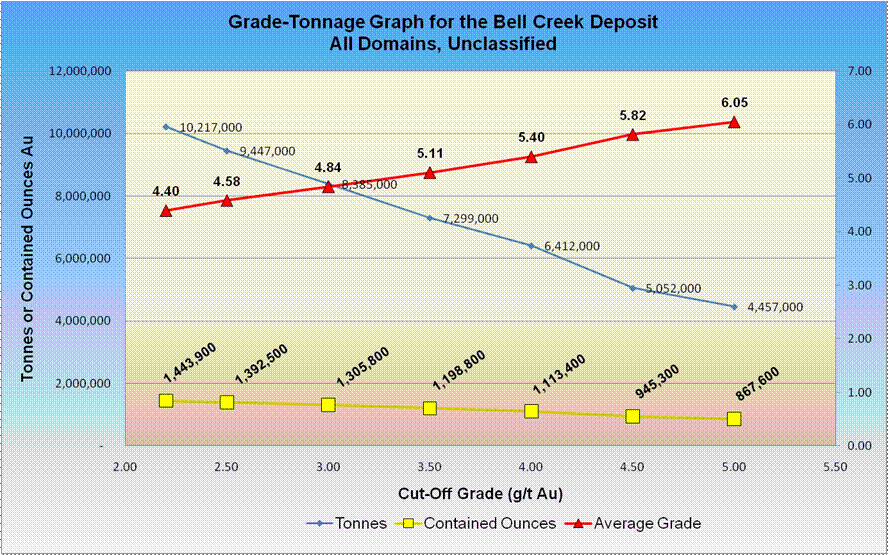
1-3
RECOMMENDATIONS
As a result of its spot check audit of the Bell Creek drill hole database, Scott Wilson RPA finds that the lithologic coding for a number of the drill holes completed by Canamax Resources Inc. (Canamax) in the database is not an accurate reflection of the descriptions in the drill log. Scott Wilson RPA recommends that a program of review/editing of the lithology codes for the Canamax drill holes be carried out prior to building a lithology model.
As well, Scott Wilson RPA notes that zero values have been inserted in the digital database for unsampled intervals. Scott Wilson RPA believes that this can result in a misleading understanding of the sampling coverage and could possibly affect assay statistics. Scott Wilson RPA recommends that a program of review/editing of the assay entries for the Canamax drill holes be carried out.
Scott Wilson RPA recommends that continued studies, in conjunction with accurate reconciliation studies, be carried out in the future to refine the capping level estimates.
Scott Wilson RPA recommends that additional density readings be determined for all six of the mineralized domains in a systematic manner.
The initial mineralization domain models have been prepared using criteria that take into consideration such items as the intensity and style of alteration, the intensity and style of quartz veining, and the gold contents of the mineralized zones. These criteria have been successful in outlining a number of mineralized domains in which the overall trend of the gold mineralization is as steeply south-plunging shoots. Trend analysis suggests that other controls may be affecting the distribution of gold on a more local level. Consequently, Scott Wilson RPA recommends building a lithologic model to improve the understanding of the structural controls at Bell Creek. As well, a lithology model may assist future mine planning studies.
The gold grades contained in the initial block model were interpolated using an inverse distance squared algorithm. Scott Wilson RPA recommends that the gold grades of any future block models also be estimated using the ordinary kriging as an additional cross check.
1-4
It can be seen that the limits of the gold mineralization remain open both along strike and down dip. Additional drilling is clearly warranted to extend the limits of the mineralization. As well, in-fill drilling is recommended in the Inferred areas.
Scott Wilson RPA also recommends that metallurgical testing be carried out on representative samples from each mineralized domain. As well, geotechnical studies should be carried out to support future mine planning studies.
TECHNICAL SUMMARY
PROPERTY DESCRIPTION AND LOCATION
The Bell Creek Mine is located in the Porcupine Mining District’s Hoyle Township, approximately 20 km, by road, northeast of Timmins, Ontario. Access to the property is gained via Florence Street, a 6.7 km long all-weather asphalt and gravel road north of Ontario Provincial Highway 101.
All claims are either patented or leased mineral claims or patented veteran lots (Vet Lots) and remain valid in perpetuity so long as the annual taxes remain paid in full. The Bell Creek Mine property comprises 12 patent claims and two patents covering a total area of approximately 320 ha. The Schumacher property is a Boer War Vet Lot with an area of approximately 64 ha. It is bounded to the west by Bell Creek and the east by the Vogel property.
LAND TENURE
Lake Shore Gold, on December 18, 2007, finalized an agreement with Goldcorp Canada Ltd. (Goldcorp) and Kinross Gold Corporation (Kinross) to acquire the Bell Creek Mine. Consideration for the acquisition consists of C$7.5 M in cash and C$2.5 M worth of Lake Shore Gold shares at a price of $1.51 per share (1,655,629 shares) as well as 2 M warrants exercisable for a period of two years at C$2.41 per share
The agreement is subject to a 2% Net Smelter Return (NSR) royalty payable to the Porcupine Joint Venture (PJV) comprising Goldcorp and Kinross. Kinross has subsequently assigned its rights under the agreement to Goldcorp Inc. Underlying royalty agreements affect some of the Bell Creek claims including three agreements with
1-5
net profit interests that can be purchased outright for relatively small amounts and a 5% NSR on the Enermark claims, which cover most of the resource. Any payments to Enermark will be deducted from the Goldcorp 2% NSR. The Schumacher property is not subject to the Goldcorp 2% NSR, however, it has a separate agreement that includes a 2% NSR.
Lake Shore Gold entered into an “Exploration Agreement” with Mattagami, Flying Post, Matachewan and Wahgoshig First Nations on March 10, 2009. The Exploration Agreement is intended to promote a cooperative and mutually respectful relationship concerning Lake Shore Gold’s exploration drilling and future activities on its mining claims within the traditional territories of the First Nations listed above.
All required permits and closure plans are in place for the advanced exploration program. The tailings treatment facilities are being managed by Lake Shore Gold’s staff with regularly scheduled inspections by Golder Associates.
SITE INFRASTRUCTURE
At the time of acquisition by Lake Shore Gold, the surface and underground infrastructure at the Bell Creek Mine included the following:
· A conventional mill which includes crushing and grinding circuits, a gravity concentration circuit and cyanide leaching and Carbon-In-Pulp (CIP) gold absorption process. The throughput capacity of the mill has recently been upgraded to approximately 2,000 tpd by Lake Shore Gold.
· A coarse ore bin.
· A permitted tailings facility comprising a newly constructed polishing pond and associated infrastructure.
· An administrative building and dry facility with office space, including a conference room, an infirmary, a main garage, a millwright shop, and an electrical shop.
· A standalone assay laboratory.
· A warehouse for reagents and lubricants.
· A core shack.
· Water treatment and supply facilities.
1-6
· A cyanide destruction plant.
· �� A hoist room, a headframe, and a 300 m deep shaft.
· A decline, ventilation raises, and a series of ramp-connected levels.
· A rolling fleet of trackless mine equipment.
The power supply of the site is provided by a 115 kV power line, from the city of Timmins. Scott Wilson RPA believes that the property has sufficient surface rights to carry out mining operations, however, the capacity of the tailings storage facility may need to be increased to accommodate future production.
HISTORY
In 1980-1981, a joint venture between Rosario and Dupont Canada Exploration discovered gold mineralization in the North A and Northeast zones of the property. The Bell Creek West Zone was discovered in 1989. Canamax was operator from 1986 to 1991. Falconbridge Gold operated Bell Creek from 1991 to 1992, followed by Kinross until closure in 1994. The mine was kept on care and maintenance until 2001 when it was allowed to flood. Bell Creek produced at a rate of 381 tpd and is reported to have produced in excess of 576,000 short tons of ore at a grade of 0.197 oz/ton (6.13 g/t) Au using vertical sublevel retreat, longhole, and shrinkage mining methods. The bulk of the production was derived from the North A Zone where mining occurred on multiple levels.
GEOLOGY
The Bell Creek deposit is located in the western part of the Archean aged Southern Abitibi Greenstone Belt, a supracrustal complex of moderately to highly deformed, usually greenschist facies, volcanic-dominated oceanic assemblages that are approximately 2.7 Ma in age. Supracrustal rocks in the Timmins region are assigned as members of seven volcanic and two sedimentary assemblages within the Western Abitibi Subprovince of the Superior Province. Intrusions were emplaced during the Archean and Proterozoic eons.
Keewatin Series greenstone volcanics are found in spatially discrete groupings and contain tholeiitic volcanic lineages as well as other volcanic assemblages that were tectonically combined with spatially discrete komatiite-rich assemblages, banded iron
1-7
formations, and turbidite-bearing sedimentary basins. Unconformably overlying the Keewatin Series are younger sub-aqueous to sub-aerial volcanic-sedimentary rocks of the Timiskaming Series. These rocks occur along the margins of late regional tectonic deformation zones that are near strike-parallel shears and/or faults which commonly show high strain and tight, vertically verging folding.
Batholiths and stocks found in the Southern Abitibi are approximately sequential from tonalite-monzonite-granodiorite through massive granodiorite, granite, feldspar ± quartz porphyry to syenite.
The Bell Creek deposit properties are underlain by carbonate altered, greenschist facies Archean-aged, metavolcanic and clastic metasedimentary rock units belonging to the Tisdale and Porcupine assemblages. The strike of the rock units varies across the properties. In the Bell Creek Mine area, strike is generally west-northwest and west-east. Lithologies strike west-east in the Schumacher and Vogel areas. The rock units generally dip steeply south, however, at depth the dip undulates to vertical and then expresses a steep dip to the north. The metavolcanic portion of the stratigraphy represents the lower portion of the Tisdale Group with the ultramafic metavolcanic rocks belonging to the Hershey Lake Formation, or the lowermost unit. The mafic metavolcanic variolitic and iron tholeiitic flow units are interpreted as being characteristic of the middle unit. The Krist Formation, the upper unit, is absent from Hoyle Township.
Intruding the Archean rock units is a north-south trending swarm of diabase dykes which have been correlated with the Paleo-Proterozoic age Matachewan swarm. This mafic intrusive unit contains up to 15% magnetite and weathers an orange-brown colour.
Overlying the Archean bedrock is the Quaternary geology unit of the Barlow-Ojibway Formation. This is a sequence of glacio-lacustine deep water varved silts and clays overlain by gravel and clay till of the Matheson till sheet. Recent organic deposits, of black mud and peat overlie the Quaternary geology.
The Bell Creek deposit is situated north of the North Tisdale Anticline, within an Archean-aged metavolcanic and metasedimentary rock synclinal fold/fault sequence, and positioned between two D2 reverse faults. The thrusting has been interpreted as the formation of the North Tisdale Anticline D2 and F2 events. The strike is parallel to
1-8
the surface traces of the thrust plane and anticlinal axis. Stratigraphic tops point to the south and, near surface, the rock units dip steeply south. At depth, the dip undulates to vertical and changes to steep north dipping. There is an F4 northeast-southwest synclinal axis at Hoyle Pond Mine. The overprint and significance of this fold event is not known at Bell Creek.
DEPOSIT TYPES
Bell Creek is an Archean-aged mesothermal gold deposit. Mesothermal gold deposits comprise high Fe or high ratio Fe/(Fe + Mg) greenstone type rocks that induce sulphidization reactions and gold precipitation and are thought to have formed during the final orogenic phases of Archean tectonism. Most mesothermal gold systems are interpreted to have developed along active and permeable low displacement faults and shear zones adjacent to large crustal scale deformation zones. Clusters of large deposits commonly occur in greenschist-facies and, to a lesser extent, amphibolite-facies, country rocks.
MINERALIZATION
In the Porcupine Camp, gold mineralized structures most commonly form in relatively competent volcanics intruded by felsic porphyry stocks and dikes prior to the deposition of the Timiskaming assemblages. Timiskaming conglomerates suggest a prolonged gold deposition event from the creation of the steep south dipping DPFZ up to the latest episode of crustal stabilization.
Fracture intensity and alteration increase toward mineralized zones. Alteration consists of bulk and fracture-controlled sericite, Fe-dolomite to ankerite, quartz and dark green to black chlorite. Microfractures contain late chlorite and carbonate veinlets. Distal carbonatization, resulting in grey carbonate zones, is quite common.
The gold mineralization in the Hoyle Antiform occurs along selvages of quartz veins and wall rocks, in stylolitic fractures in quartz veins, in fine grained pyrite, and in association with amorphous carbon. High grade gold mineralization occurs within quartz veins contained in alteration zones. The alteration zones are characterized by carbonate, graphitic and amorphous carbon, fine grained pyrite, sericite, and/or paragonite and are
1-9
enriched in Au, As, Bi, and W. This style of alteration is referred to by mine geologists as “grey zones” and is an exploration target in Hoyle Township.
The Bell Creek West Zone mineralization consists of 2% to 10% pyrite, with accessory arsenopyrite, pyrrhotite, chalcopyrite, and minor quartz veins and veinlets. Approximately 90% of the gold is associated with the disseminated sulphides that occur in association with altered quartz-carbonate-sericite-sulphide zones ranging from 0.5 m to 7 m in width. Lenses, which are approximately 100 m in length and 200 m in vertical extent, strike west-east and plunge steeply to the east. Multiple mineralized zones are identified along a one kilometre strike length of the mafic/ultramafic metavolcanic contact. Active carbon occurs in some of the mineralized pods in the form of sheared graphitic interflow sediments and has a deleterious effect on gold recovery; consequently mining was not planned where this was encountered.
The North Zone at Bell Creek consists of two sub-parallel, west-northwest striking, 70° south dipping mineralized vein systems, the A (south or upper) and the B (north or lower) zones or horizons.
The North A Zone outcrops approximately 200 m north of the Bell Creek headframe and consists of a marker quartz vein that varies from 0.1 m to two metres in width with an associated alteration halo. Approximately 0.5 m in average width, the vein parallels the regional schistosity and cross-cuts lithology. Bright green hydromuscovite occurs as fractures and slip coatings in the vein, with visible gold occurring with the mica. Brown tourmaline (dravite) is ubiquitous. The North A Zone averages 6 g/t Au to 10 g/t Au over two metre to 10 m widths. Adjacent to the quartz marker vein is a grey to buff coloured altered zone which contains 5% to 15% pyrite and pyrrhotite, with accessory chalcopyrite and arsenopyrite. Up to 30% of the gold in the North A Zone occurs within the alteration halo, in discrete sulphide zones and in vein-brecciated wall rock zones that extend up to five metres from the margin of the core vein.
At the time of active production at Bell Creek, the North B Horizon was considered uneconomic to mine due to the low gold grades relative to the metal price of the day and because portions of the wall rocks were thought to contain active carbon, which was determined to be detrimental to gold recovery.
1-10
SCHUMACHER PROPERTY
The Schumacher property is underlain by the same stratigraphy as the Bell Creek Mine. Portions of the metavolcanic rock units were explored for the eastward extensions of the Bell Creek West, and North A Zone mineralized zones.
EXPLORATION
Lake Shore Gold has been actively exploring in the Bell Creek area since 2005. Lake Shore Gold’s diamond drill programs were designed to test the mine stratigraphy at depth and the existence of flat veins, as well as to provide geotechnical information and information on the overburden depths. Bell Creek Mine diamond drilling programs have tested the West Zone, North A Zone below, and surrounding areas of the underground workings: as well as the West Veins system, the East Veins system, and the newly discovered Portal vein array.
After the acquisition of the Schumacher property, drilling continued to test the flat veins located in the eastern portion of the property, as well as the volcanic stratigraphy.
DRILLING
HISTORIC DRILLING
A summary of historic drill programs at Bell Creek completed prior to Lake Shore Gold’s involvement is shown in Table 1-2.
TABLE 1-2 SUMMARY OF HISTORIC DRILLING AT BELL CREEK
Lake Shore Gold — Bell Creek Deposit
Company | | Year | | Location | | No. of Holes | | Metres | |
Rosario | | 1978-1981 | | surface | | 65 | | 9,842 | |
Amax | | 1982 | | surface | | 34 | | 5,520 | |
Canamax | | 1988-1991 | | underground | | 227 | | 13,022 | |
Falconbridge Gold | | 1992-1994 | | underground | | 64 | | 6,155 | |
PFV | | 1995 | | surface | | 7 | | 1,807 | |
PJV | | 2005 | | surface | | 36 | | 11,469 | |
Totals | | | | | | 433 | | 47,815 | |
1-11
LAKE SHORE GOLD DRILLING
All work performed by Lake Shore Gold at Bell Creek is referenced to the Bell Creek mine grid, which has been extended eastward through the Schumacher and Vogel properties.
Work completed by the data cut-off date of October 26, 2010 is summarized in Table 1-3.
TABLE 1-3 EXPLORATION DRILLING - 2005 TO 2010
Lake Shore Gold — Bell Creek Deposit
Location | | Number of
Drill Holes | | Metres | | Samples
Taken | |
Bell Creek | | 161 | | 80,439 | | 22,239 | |
Bell Creek (underground)(1) | | 59 | | 7,020 | | 1,834 | |
Schumacher | | 22 | | 7,196 | | 1,763 | |
Totals | | 202 | | 91,904 | | 25,147 | |
Notes
(1) includes 6 grout holes for fresh air raise.
HISTORIC QUALITY ASSURANCE/QUALITY CONTROL
It is not known whether Certified Reference Material (CRM) or blank samples were used by Rosario. Scott Wilson RPA notes that only one diamond drill hole from this period falls within the resource volume.
Duplicate and CRM samples were processed with drill core samples forwarded by Amax, Canamax, and PFV as part of Swastika Laboratories Ltd.’s in-house quality assurance and quality control (QA/QC) program. Results of duplicate analyses were returned and are recorded on drill logs. No check analyses were completed by an independent assay laboratory.
No check analyses were completed on underground diamond drill core assayed at the Bell Creek assay laboratory.
Sampling and assaying carried out for the PJV followed the standard PJV QA/QC program which included the insertion of one CRM, one blank, and a duplicate for each
1-12
20 samples assayed. The operator of the PJV reported that the QA/QC program did not identify any major issues.
LAKE SHORE GOLD QA/QC
One blank sample and one CRM standard are inserted in the sample stream for every 20 to 25 samples submitted for analysis. Drill core from a barren diabase dike is used for blanks.
Scott Wilson RPA has reviewed the control charts for the QA/QC program carried out by Lake Shore Gold and has found that the results are acceptable for use in preparation of Mineral Resource estimates.
DATA VERIFICATION
A small program of check assaying was carried out by Scott Wilson RPA wherein a total of 15 samples from drill hole BC-09-69A were selected. The quarter-sawed core samples were sent to the Acme Analytical Laboratories Ltd. (Acme) facility located in Vancouver, British Columbia, where gold was determined using Acme’s G601 method code for fire assays. While such a small number of check samples cannot be considered as adequate to confirm the accuracy of all of the assays contained within the Bell Creek drill hole database, Scott Wilson RPA is satisfied that it has independently confirmed the presence of gold in approximately similar quantities as have been reported by Lake Shore Gold in the selected samples from the Bell Creek deposit.
Scott Wilson RPA completed its data verification activities by conducting a program of spot checking of the drill hole database. For this program, approximately 10% of the drill holes that intersected the mineralized domain models at Bell Creek were selected for validation on a semi-random basis. At Scott Wilson RPA’s request, because of the discovery of a typographic error in drill hole 4-9, Lake Shore Gold carried out a program of assay validation for all samples in the drill hole database with gold values greater than 6 g/t Au. A total of 105 assay values greater than 6 g/t Au contained within assays carried out by previous owners were validated. Of these, the original assay certificate for only one sample could not be located.
1-13
As a result of the data validation efforts, Scott Wilson RPA believes that the drill hole data representing the mineralization intersected by drilling at the Bell Creek deposit is appropriate for use in the preparation of Mineral Resource estimates.
MINERAL RESOURCE ESTIMATE
Scott Wilson RPA carried out an audit of the resource block model prepared by Lake Shore Gold of the gold mineralization found at the Bell Creek Mine, and subsequently prepared a Mineral Resource estimate for the North A, North A2, North B, North B2, North A3, and North A Extension domains using the supplied block model.
The Scott Wilson RPA Mineral Resource estimates at a cut-off grade of 2.2 g/t Au are presented in Table 1-1. Based on the density of drilling, observed continuity of the gold mineralization, and variography results, Scott Wilson RPA has classified the Mineral Resources into the Measured, Indicated, and Inferred categories.
There are no Mineral Reserves present on the Bell Creek property as of the date of this Technical Report.
DESCRIPTION OF THE DATABASE
The cut-off date for the drill hole database was October 26, 2010. The database contains 726 drill holes. This drill hole information was modified slightly so as to be compatible with the format requirements of the Gemcom-Surpac v.6.1.4 mine planning software.
GEOLOGICAL DOMAIN INTERPRETATIONS
Lake Shore Gold constructed a series of domain models of the various mineralized horizons that is consistent with the current geological understanding at Bell Creek. In all, six domains were created, five of which occur as a series of sub-parallel, east-west striking, steeply south-dipping sheets (the North A, North A2, North A3, North B and North B2 domains). One domain (the North A Extension) is interpreted as a minor split or bifurcation of the North A domain, and is located immediately below the western limit of the lowermost level of the Bell Creek Mine.
1-14
GRADE CAPPING
All samples contained within the six three-dimensional domain solids were coded in the database and extracted for analysis. Normal histograms were generated from this extraction file and the descriptive statistics of the sample data sets were checked. The grade caps were selected by examining the histogram for the grade at which outlier assays began to occur.
Lake Shore Gold applied a constant capping value of 34 g/t Au to the assays for all six domains. The data suggest, however, that a future refinement could include the application of separate capping values to each domain. Scott Wilson RPA conducted a capping sensitivity analysis for each of the domains separately and found that five of the six domains were relatively insensitive to capping level changes. These five domains comprise most of the Mineral Resources estimated at Bell Creek.
COMPOSITING METHODS
All samples contained within the six domain models were composited using the fixed-length method. Scott Wilson RPA believes that this method is appropriate for this style of mineralization.
BULK DENSITY
Scott Wilson RPA has carried out a small program of bulk density measurements on samples of the Bell Creek mineralized material taken from the remaining historical drill core. A total of 15 samples of drill core were shipped to the Acme facility in Vancouver, British Columbia. The bulk densities of the samples were determined using Acme’s G8SG method based on water displacement.
An average bulk density of 2.82 tonnes/m3 is suggested from this small data set. Scott Wilson RPA recommends that additional density readings be determined for all six of the mineralized domains in a systematic manner.
TREND ANALYSIS
Scott Wilson RPA conducted a short study of the overall trends that may be present within each of the six mineralized domains to help guide the variography studies. Average gold grades, across the width of the mineralized vein for each drill hole that pierced each of the six domain models, were hand-contoured on a longitudinal projection.
1-15
Examination of the contour plots suggests that the gold mineralization for the North A, North A2, North B, and North B2 domains generally follows an overall steep plunge to the south, with a slight rake of perhaps 10° to 20° from vertical to the east. Within these larger steeply plunging, steeply east-raking zones, sub-zones of higher grades are suggested in areas with higher drill hole density. The limited information that is available at this time suggests that these sub-zones plunge moderately to shallowly to the west, and may represent the intersection lineations of two mineralizing structures, dilational flexures, or the influence of a yet unrecognized structural control on the gold distribution.
VARIOGRAPHY
The North A and North B domain down plunge variograms have reasonably good model fits that identified maximum ranges of approximately 30 m to 40 m. Efforts to identify the continuity and anisotropies for the other domains were not successful due to the limited number of data pairs.
BLOCK MODEL CONSTRUCTION
An upright, non-rotated, partial percentage block model with the long axis of the blocks oriented along azimuth 090º and dipping vertically was constructed using the GEMS v.6.2.3 software. The selected block sizes were 2 m x 3 m x 3 m (width, length, height). A number of attributes were also created to store such information as metal grades, distances to and the number of informing samples, domain codes, resource classification codes, and claim owners.
Gold grades were interpolated into the individual blocks for the mineralized domains using the inverse distance squared interpolation method. A single-pass approach was used with a search ellipse of 80 m radius.
“Hard” domain boundaries were used to prevent composites from influencing blocks situated in nearby domains. Only the capped, composited grades of the drill hole intersections were used to estimate block gold grades.
CUT-OFF GRADE
Scott Wilson RPA estimated an underground cut-off grade of 2.2 g/t Au based on a US$1,125/oz gold price, an exchange rate of $0.95 (USD:CAD), a $76 per tonne operating cost, and the historical Bell Creek mill recovery of 93%.
1-16
BLOCK MODEL VALIDATION
Validation efforts for the Mineral Resource estimate at the Bell Creek deposit included visual, statistical and volumetric checks. Scott Wilson RPA found good visual spatial and statistical correlation between the average block and composite gold grades for each domain. In addition, the reported block model volumes for each domain are essentially the same as the domain solid volumes.
1-17
2 INTRODUCTION
Scott Wilson Roscoe Postle Associates Inc. (Scott Wilson RPA) was retained by Mr. Eric Kallio, Vice President, Exploration of Lake Shore Gold Corp. (Lake Shore Gold), to prepare a Technical Report in support of an initial Mineral Resource estimate for the mineralization at the Bell Creek gold deposit located in Hoyle Township, near Timmins, Ontario. This Technical Report conforms to NI 43-101 Standards of Disclosure for Mineral Projects.
Lake Shore Gold is a publicly traded company listed on the Toronto Stock Exchange and trading under the symbol LSG. Lake Shore Gold was founded in 2002 to explore for precious and base metals hosted within the Quebec and Ontario portions of the Canadian Shield. Since its founding, Lake Shore Gold has acquired the rights to the former producing Bell Creek Mine and certain neighbouring properties. The purchase of the Bell Creek was finalized on December 18, 2007, and the purchase of the Schumacher III Estate property (Schumacher) was finalized on December 1, 2005. Since completing the acquisition of these claims, Lake Shore Gold has been conducting exploration programs at Bell Creek to test for the down-dip extension of the gold mineralization that had been previously exploited. These exploration programs have been successful in tracing the down-dip extensions of both the North A Zone (the former producing horizon) and the North B Zone (a sub-parallel horizon to the North A Zone). Lake Shore Gold has also been successful in locating a number of new mineralized horizons at depth that appear to sub-parallel these two zones. To date, gold mineralization has been traced from surface to a depth of approximately 1,200 m and along a strike length of approximately 700 m. The mineralization remains open at depth. In addition, there is potential for additional mineralization along the eastern and western strike extensions at depth.
The current report is based on data provided to Scott Wilson RPA by Lake Shore Gold and obtained from other relevant, publicly available information from such sources as the World Wide Web, various Canadian Federal and Provincial government maps, reports and databases, and academic journals. This Technical Report discloses the exploration results obtained from Bell Creek as at October 26, 2010.
2-1
The Qualified Person for this report is Mr. Reno Pressacco, P. Geo., who at the time of preparation of the Mineral Resource estimate held the position of Senior Consulting Geologist with Scott Wilson RPA. Mr. Pressacco visited the Bell Creek property on April 19 to 21, 2010, where he observed the nature of the mineralization in drill core, reviewed and discussed the methods of drilling, sampling, and analysis, reviewed the project’s database structure, and held discussions regarding the modelling approaches. The site visit was conducted in the presence of Mr. Keith Green, Mr. Ralph Koch, and Mr. Anthony Camuti, all of whom are currently employed by Lake Shore Gold.
Bell Creek’s principal asset is the Mineral Resources as presented in this report. In addition, Bell Creek has a newly expanded 2,000 tpd conventional mill which includes crushing and grinding circuits, a gravity concentration circuit, and cyanide leaching and Carbon-In-Pulp (CIP) gold adsorption processes. Bell Creek hosts surface and underground infrastructure such as warehouses, mechanical shops, ventilation systems, administration and dry facilities, permitted tailings facilities, hoist and headframe structures, coarse ore bin, ramps, shafts and ventilation raises, a mobile equipment fleet, electrical systems, water treatment and supply, heaters, as well as road and electric power access.
Prior Scott Wilson RPA involvement with the Bell Creek property includes site visits and descriptions prepared by Mr. Pressacco while in the employ of the Ontario Geological Survey. The results of these activities were presented in Open File Report 5985 (Pressacco, 1999). Scott Wilson RPA’s predecessor, Roscoe Postle Associates Inc. (RPA), conducted a property valuation on the Schumacher property in 1997 for Pentland Firth Ventures Ltd. (PFV).
The documentation reviewed, and other sources of information, are listed at the end of this report in Section 22, References.
2-2
LIST OF ABBREVIATIONS
Units of measurement used in this report conform to the SI (metric) system. All currency in this report is Canadian dollars (C$) unless otherwise noted.
m | | micron |
°C | | degree Celsius |
°F | | degree Fahrenheit |
mg | | microgram |
A | | ampere |
a | | annum |
az | | azimuth |
bbl | | barrels |
Btu | | British thermal units |
C$ | | Canadian dollars |
cal | | calorie |
cfm | | cubic feet per minute |
cm | | centimetre |
cm2 | | square centimetre |
d | | day |
dia. | | diameter |
dmt | | dry metric tonne |
dwt | | dead-weight ton |
ft | | foot |
ft/s | | foot per second |
ft2 | | square foot |
ft3 | | cubic foot |
g | | gram |
G | | giga (billion) |
Gal | | Imperial gallon |
g/L | | gram per litre |
g/t | | gram per tonne |
gpm | | Imperial gallons per minute |
gr/ft3 | | grain per cubic foot |
gr/m3 | | grain per cubic metre |
hr | | hour |
ha | | hectare |
hp | | horsepower |
in | | inch |
in2 | | square inch |
J | | joule |
k | | kilo (thousand) |
kcal | | kilocalorie |
kg | | kilogram |
km | | kilometre |
km/h | | kilometre per hour |
km2 | | square kilometre |
kPa | | kilopascal |
kVA | | kilovolt-amperes |
kW | | kilowatt |
kWh | | kilowatt-hour |
L | | litre |
Lph | | litres per hour |
L/s | | litres per second |
m | | metre |
M | | mega (million) |
m2 | | square metre |
m3 | | cubic metre |
mg | | milligram |
min | | minute |
MASL | | metres above sea level |
ml | | millilitre |
mm | | millimetre |
mph | | miles per hour |
MVA | | megavolt-amperes |
MW | | megawatt |
MWh | | megawatt-hour |
m3/h | | cubic metres per hour |
opt, oz/st | | ounce per short ton |
oz | | Troy ounce (31.1035g) |
oz/dmt | | ounce per dry metric tonne |
ppm | | part per million |
psia | | pound per square inch absolute |
psig | | pound per square inch gauge |
RL | | relative elevation |
s | | second |
st | | short ton |
stpa | | short ton per year |
stpd | | short ton per day |
t | | metric tonne |
tpa | | metric tonne per year |
tpd | | metric tonne per day |
US$ | | United States dollar |
USg | | United States gallon |
USgpm | | US gallon per minute |
V | | volt |
W | | watt |
wmt | | wet metric tonne |
yd3 | | cubic yard |
yr | | year |
2-3
3 RELIANCE ON OTHER EXPERTS
This report has been prepared by Scott Wilson Roscoe Postle Associates Inc. (Scott Wilson RPA) for Lake Shore Gold Corp. (Lake Shore Gold). The information, conclusions, opinions, and estimates contained herein are based on:
· Information available to Scott Wilson RPA at the time of preparation of this report,
· Assumptions, conditions, and qualifications as set forth in this report, and
· Data, reports, and other information supplied by Lake Shore Gold and other third party sources.
For the purpose of this report, Scott Wilson RPA has relied on ownership information provided by Lake Shore Gold. Scott Wilson RPA has not researched property title or mineral rights for the Bell Creek property and expresses no opinion as to the ownership status of the property.
Scott Wilson RPA has relied on Lake Shore Gold for guidance on applicable taxes, royalties, and other government levies or interests, applicable to revenue or income from Bell Creek.
Except for the purposes legislated under provincial securities laws, any use of this report by any third party is at that party’s sole risk.
3-1
4 PROPERTY DESCRIPTION AND LOCATION
The Bell Creek Mine is located in the Porcupine Mining District’s Hoyle Township, approximately 20 km, by road, northeast of Timmins, Ontario (Figure 4-1). Access to the property is gained via Florence Street, a 6.7 km long all-weather asphalt and gravel road north of Ontario Provincial Highway 101. The project is situated approximately 564 km north-northwest of Toronto, Ontario. The mine infrastructure is located within National Topography Series Map reference 42-A-11 southeast, at longitude 81° 10’ 41” west and latitude 48° 33’ 45” north. Universal Transverse Mercator (UTM) coordinates for the project centre utilizing projection North American Datum (NAD) 83, Zone 17 are approximately 486,860.5 m east, 5,377,802 m north.
Five separate agreements have been executed for the acquisition of Bell Creek and the Schumacher Estate III (Schumacher) Boer War veteran lot (Vet Lot) property. All claims are located in Hoyle Township and the claim boundaries are defined by a surveyed fabric established by the Government of Ontario. All claims are either patented or leased mineral claims or patented Vet Lots and remain valid in perpetuity so long as the annual taxes remain paid in full.
BELL CREEK MINE AND MILL
The Bell Creek Mine property comprises 12 patent claims and two patents covering a total area of approximately 320 ha. A summary of the claims, surface and mining rights, taxes, and royalties is given in Table 4-1.
Bell Creek was operated by Canamax Resources Inc. (Canamax) between 1989 and 1991. Falconbridge Gold Inc. (Falconbridge Gold) operated the mine between 1991 and 1992, followed by Kinross Gold Corporation (Kinross) in 1993 and 1994 when mining operations ceased. The mine was kept on care and maintenance until 2001 when it was allowed to flood. In 2002, the Porcupine Joint Venture (PJV), a joint venture between Placer Dome Canada Ltd. (Placer Dome) and Kinross, was formed and in 2005 the property was reactivated. Goldcorp Inc. acquired Placer Dome’s interest later that year and became the operator of the PJV (Butler, 2008).
4-1

4-2
On January 31, 2007, Lake Shore Gold announced that the company had entered into a binding letter of agreement with Goldcorp Canada Ltd. (Goldcorp), as manager of the PJV, to acquire the Bell Creek Mine. In March 2007, the two companies agreed to amend their binding letter of agreement to extend the due diligence period and the acquisition was finalized on December 18, 2007. Consideration for the acquisition consists of C$7.5 M in cash and C$2.5 M worth of Lake Shore Gold shares at a price of $1.51 per share (1,655,629 shares) as well as 2 M warrants exercisable for a period of two years at C$2.41 per share
The agreement is subject to a 2% Net Smelter Return (NSR) royalty payable to the PJV comprised of Goldcorp and Kinross. Kinross has subsequently assigned its rights under the agreement to Goldcorp Inc. Underlying royalty agreements affect some of the Bell Creek claims including three agreements with net profit interests that can be purchased outright for relatively small amounts and a 5% NSR on the Enermark claims, which cover most of the resource. Any payments to Enermark will be deducted from the Goldcorp 2% NSR. The Schumacher property is not subject to the Goldcorp 2% NSR, however, it has a separate agreement that includes a 2% NSR. A summary of the land tenure is provided in Table 4-1.
The underlying agreements are described by Butler (2008) as follows:
· The Allerston-Rosario Agreement - a registered agreement (402978) between Ralph Allerston and Canamax, formerly Rosario Resources Canada Ltd. (Rosario) whereby Allerston shall retain a 10% Net Profit Interest (NPI) from any commercial production. The NPI may be purchased for a lump sum of C$400,000 (previous payments have been completed as required). After the lump sum payment of C$400,000, the NPI will no longer be payable. The lands affected are under 1338LC (leasehold patent mining and leasehold patent surface rights) being the south halves of Lots 11 and 12 of Concession 2 in Hoyle Township.
· The Broulan-Enermark Agreement — a registered agreement dated January 8, 1980 (304105), between Broulan Reef Mines Ltd. (Broulan) and Rosario, then assigned to Amax of Canada Ltd. (Amax) on December 30, 1981, and then assigned to Falconbridge Gold (in 1991), whereby Broulan retains a 5% NSR on the lands, adjusted as per a schedule, to be paid 30 days after the end of each quarter. If production is not sold in the quarter, the NSR is not payable for unsold production. The Enermark Income Fund (Enermark) amalgamated with Broulan and is now part of the Enerplus Resource Fund (Enerplus). Enerplus appears to be the recipient of any royalty agreements. The lands affected are under leasehold patent 155LC mining rights only. The surface rights under freehold
4-3
patent 3559SEC are not under any obligation of the Broulan/Enermark Agreement.
· The Fisher et al. Agreement — a registered agreement (316796) between Casselman, Casselman, Fisher (CC&F), and Rosario, whereby CC&F shall be paid a 10% NPI from any commercial production from the lands within six months of the end of each fiscal year of operation of the mining property. The 10% NPI can be purchased for C$100,000, above the original option payments. The lands affected are under freehold patent 24055SEC mining rights and freehold patent 15504SEC surface rights.
· The Prentice et al. Agreement — an unregistered agreement (dated July 16, 1979) between D.F. Prentice, R. McLennan, J.F. McLennan, A. Robertson, St. Andrews Church, and Rosario wherein Prentice et al. shall retain a 10% NPI from any commercial productions from the lands. The 10% NPI can be purchased for C$100,000 above the original option payments. The lands affected are under freehold patent 460SND mining rights only. The surface rights under freehold patent 1755SEC are not part of this agreement.
SCHUMACHER PROPERTY
In November 2005, Lake Shore Gold signed a 20-year lease agreement giving it a leasehold interest in the surface and mining rights on the Schumacher property. The lease is renewable for another 20-year term. The property is a Boer War Vet Lot and, as such, is a freehold patent with both surface and mining rights (granted by the Crown before May 6, 1913). There is no requirement to file assessment reports with the Ministry of Northern Development and Mines (MNDM). As the property is a Vet Lot in a surveyed township, its boundaries are fixed for an area of approximately 64 ha. It is bounded to the west by Bell Creek and the east by the Vogel property.
Lake Shore Gold is required to make an annual advanced payment of C$25,000 in years four to six of the lease and C$50,000 in years seven to nine of the lease and to pay a 2% NSR (Butler, 2008).
4-4
TABLE 4-1 BELL CREEK LAND TENURE, TAXES AND ROYALTIES
Lake Shore Gold Corp. — Bell Creek Deposit
Mining
Claim # | | Taxes
Paid To
MNDMF(1) | | Taxes
Paid to
MAH(2) | | Taxes
Paid to C
of T(3) | | Project(6) | | Tenure | | Surface/
Mining
Rights(4) | | PCL# | | PIN# | | Owner | | Ha | | Expiry
Date | | |
P515775 | | 382.43 | | 198.94 | | | | BELL CREEK | | Leas | | MRO & SRO | | 1338 SEC LC | | 65360-0046 | | Lake Shore Gold Corp. Allerston-Rosario Royalty (10% NPI(5)) | | 127.475 | | 2025 | | Mining Lease Number 107727 |
P515776 | | | | | BELL CREEK | |
P515777 | | | | | BELL CREEK | |
P515778 | | | | | BELL CREEK | |
P515779 | | | | | BELL CREEK | |
P515780 | | | | | BELL CREEK | |
P515781 | | | | | BELL CREEK | |
P515782 | | | | | BELL CREEK | |
P44696 | | 192.43 | | | | | | BELL CREEK | | Lease | | MRO | | 155 SEC LC | | 65360-0129 | | Lake Shore Gold Corp. Broulan-Enermark (5% NSR(5)) | | 64.142 | | 2027 | | Mining Lease Number 107916 |
P44697 | | | | | BELL CREEK | |
P44698 | | | | | BELL CREEK | |
P44699 | | | | | BELL CREEK | |
P44696 | | | | | | 157,141.16 | | BELL CREEK | | Patent | | SRO | | 3559 SEC SEC | | 65360-0045 | | Lake Shore Gold Corp. | | | | |
P44697 | | | | | | | BELL CREEK | | Patent | | | |
P44698 | | | | | | | BELL CREEK | | Patent | | | |
P44699 | | | | | | | BELL CREEK | | Patent | | | |
N 1/2 L11, C1 | | 259 | | | | | | BELL CREEK | | Patent | | MRO | | 24055 SEC SEC | | 65360-0027 | | Lake Shore Gold Corp. Fisher et al. (10% NPI) | | 64.749 | | | | |
N 1/2 L11, C1 | | | | | | 100.13 | | BELL CREEK | | Patent | | SRO | | 15504 SEC SEC | | 65360-0026 | | Lake Shore Gold Corp. | | | | | | |
N 1/2 L10, C1 | | 259.81 | | | | | | BELL CREEK | | Patent | | MRO | | 460 SEC SND | | 65360-0029 | | Lake Shore Gold Corp. Prentice et al. (10% NPI) | | 64.952 | | | | |
N 1/2 L10, C1 | | | | | | 100.13 | | BELL CREEK | | Patent | | SRO | | 1755 SEC SEC | | 65360-0028 | | Lake Shore Gold Corp. | | | | | | |
P. 1502 | | City of Timmins | | 120.11 | | | | SCHUMACHER | | Patent | | MRO & SRO | | 1598 SEC SEC | | 65360-0030 | | The Canada Trust Company Schumacher, Frederick William Estate of (2% NSR) | | 64.952 | | 11/29/2025 | | |
(1) MNDF = Ministry of Northern Development, Mines and Forestry
(2) MAH = Ministry of Municipal Affairs and Housing
(3) C of T = City of Timmins
(4) SRO = Surface Rights Only, MRO = Mining Rights Only
(5) NPI=Net Profits Interest, NSR=Net Smelter Return
(6) Bell Creek claims subject to Goldcorp 2% NSR.
4-5
Lake Shore Gold entered into an “Exploration Agreement” with Mattagami, Flying Post, Matachewan, and Wahgoshig First Nations on March 10, 2009. The Exploration Agreement is intended to promote a cooperative and mutually respectful relationship concerning Lake Shore Gold’s exploration drilling and future activities on its mining claims within the traditional territories of the First Nations listed above.
All required permits and closure plans are in place for the advanced exploration program. The tailings treatment facilities are being managed by Lake Shore Gold’s staff with regularly scheduled inspections by Golder Associates.
Since the accepted closure plan was filed, some additional construction activities have occurred at Bell Creek which include:
· Construction of a ventilation raise
· Construction of a Carbon-In-Leach tank (CIL) and secondary containment for the tank
· Construction of a polishing pond for the storage and clarification of mine water and the infrastructure associated with it
· Construction of some minor buildings and infrastructure
The financial costs for reclamation and closure of these items will be included in future closure plans along with the financial assurance being adjusted to include these new disturbances.
A summary of the previous mining operations is presented in Powers (2009). A plan view showing the location of the Mineral Resources, mine workings, and existing tailings ponds relative to the outside property boundaries is presented in Figure 4-2. A plan view of the claim map is presented in Figure 4-3.
4-6
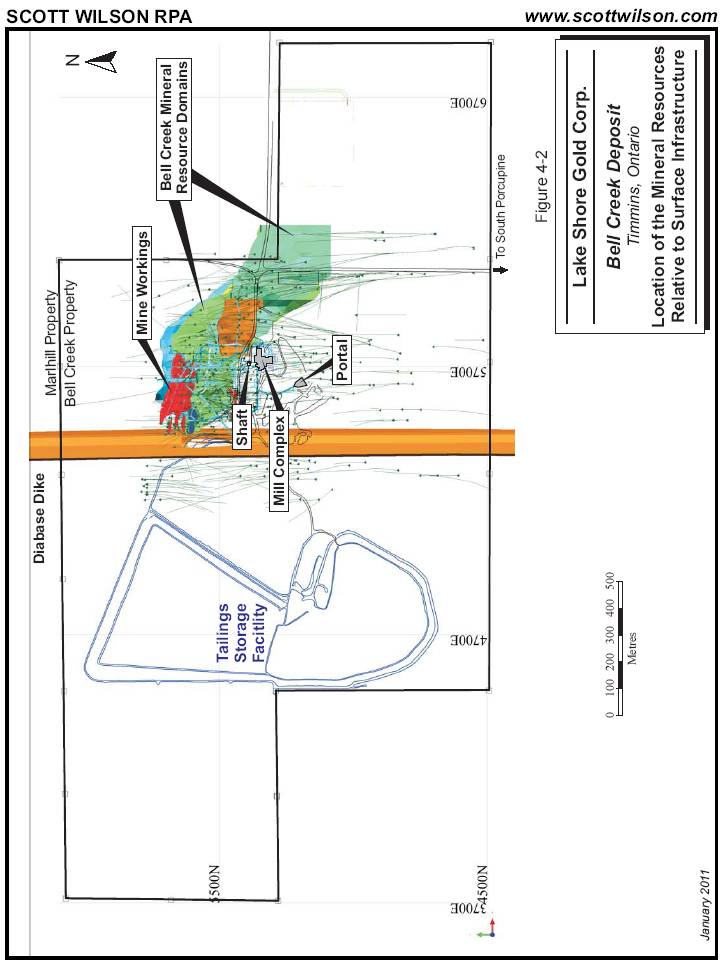
4-7
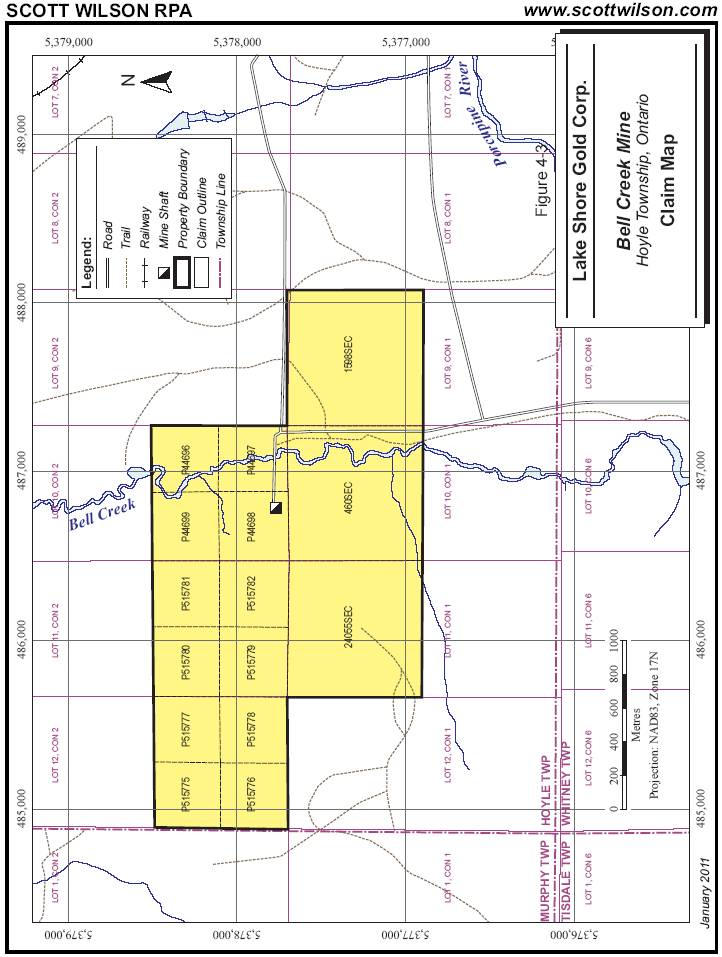
4-8
5 ACCESSIBILITY, CLIMATE, LOCAL RESOURCES, INFRASTRUCTURE AND PHYSIOGRAPHY
ACCESSIBILITY
Access to the Bell Creek property is gained via Florence Street, a 6.7 km long all-weather asphalt and gravel road, north of Ontario Provincial Highway 101, approximately 20 km northeast of Timmins, Ontario. The area is serviced from Toronto via Highways 400, 69 to Sudbury, and Highway 144 to Timmins; or Hwy 11 from Barrie to Matheson and 101 westward to Timmins. The City of Timmins is also serviced by regularly scheduled airline flights from Toronto.
CLIMATE
The project area, and the City of Timmins experience a continental climate with an average mean temperature range of -17.5°C (January) to +17.4° (July) and an annual precipitation of approximately 830 mm.
Local lakes start to freeze over approximately mid-November, with spring breakup taking place in early to mid-May. Work can be carried out uninterrupted twelve months a year.
LOCAL RESOURCES
The local economy of Timmins is dominated by the mining and logging industries. Timmins is one of Canada’s largest municipalities with an area of 321,000 ha. The Abitibi region has a long history of mining activity, and an experienced mining labour pool is accessible in the Timmins area. Mining supplies and contractors are locally obtainable and general labour is readily available. The 2006 census indicates the population of Timmins to be 42,455 persons. The project enjoys the support of local communities.
The Victor M. Power Airport has scheduled service provided by three carriers, Air Canada Jazz, Bearskin Airlines, and Air Creebec. The Timmins District Hospital is a major referral health care centre for northeastern Ontario.
5-1
All-weather road access and electrical power transmission lines are established and operational to Bell Creek.
INFRASTRUCTURE
At the time of acquisition by Lake Shore Gold, the surface and underground infrastructure at the Bell Creek Mine included the following:
· A conventional mill which includes crushing and grinding circuits, a gravity concentration circuit and cyanide leaching and CIP gold absorption process. The throughput capacity of the mill has recently been upgraded to approximately 2,000 tpd by Lake Shore Gold.
· A coarse ore bin.
· A permitted tailings facility comprising a newly constructed polishing pond and associated infrastructure.
· An administrative building and dry facility with office space, including a conference room, an infirmary, a main garage, a millwright shop, and an electrical shop.
· A stand alone assay laboratory.
· A warehouse for reagents and lubricants.
· A core shack.
· Water treatment and supply facilities.
· A cyanide destruction plant.
· A hoist room, a headframe, and a 300 m deep shaft.
· �� A decline, ventilation raises and a series of ramp-connected levels.
· A rolling fleet of trackless mine equipment.
The power supply of the site is provided by a 115 kV power line, from the City of Timmins. Scott Wilson RPA believes that the property has sufficient surface rights to carry out mining operations, however, it appears possible that the capacity of the tailings storage facility will need to be increased to accommodate future production.
5-2
PHYSIOGRAPHY
Bell Creek exhibits low to moderate topographic relief, with the property elevation ranging from 285 MASL to 298 MASL. Drainage is characterized by slow, meandering creeks and rivers into the Arctic watershed. Bell Creek, which lends its name to the deposit, flows across the property and into the Porcupine River in a north-northwest direction. Outcrop exposure is less than 3%.
The Timmins area is situated in plant hardiness zone 2a, which supports boreal forest tree species and an active timber, pulp, and paper industry. Local trees species include: American Mountain-Ash, Balsam Fir, Black Spruce, Eastern White Cedar, Eastern White Pine, Jack Pine, Pin Cherry, Red, Tamarack, Trembling Aspen, White Birch, White Spruce, and Speckled Alder.
Timber was harvested from the Schumacher property in 1997. A small stand of trees was removed from west of the Bell Creek headframe in 2009.
5-3
6 HISTORY
The discovery of gold occurrences in the Timmins area began to appear in the historic record in the early part of the twentieth century. The extension of the railway lines from Cobalt, Ontario, in the early 1900s allowed for new access to the gold discoveries found near Porcupine and Nighthawk Lakes. With increased access to the region, numerous gold discoveries were reported that initiated the rush to the Porcupine Gold Camp. World class gold deposits were found in the area, with 1909 being of particular note with the discovery of the Vipond, Dome, and Hollinger mines.
Few bedrock outcrops in the Bell Creek area and the clay-rich nature of the surface cover restricted prospectors’ ability to find alluvial gold trains in creek bottoms and trace them back to the source material — the main exploration method employed at the time. With the advent of airborne geophysics in the 1960s, the first discoveries were made below the clay-rich belt that surrounds Timmins. Prior to that, gold was found either in outcrop directly or along the strike of outcrops. Gold mineralization found below this “clay-belt” occurred in what is now southern Hoyle Township (Butler, 2008).
Prior to the 1960s, little geological work is found in the public domain for the Bell Creek area. Work completed by the Ontario Geological Survey (OGS) and Ontario Department of Mines for the Hoyle Township area is summarized in Table 6-1.
6-1
TABLE 6-1 PREVIOUS WORK DONE IN THE HOYLE TOWNSHIP AREA BY THE GOVERNMENT OF ONTARIO
Lake Shore Gold Corp. — Bell Creek Deposit
Year | | Author | | Work Done |
| | | | |
1924 | | Rose | | Preparation of the first geological map of Hoyle Township (Map: ARM33d) |
| | | | |
1941 | | Berry | | Mapped Hoyle and southern part of Gowan Township as part of Bigwater Lake Area (Map ARM48N) |
| | | | |
1964 | | Ginn et al. | | Compiled the first small scale map covering Hoyle and Gowan Townships (1:253,440 scale. Map revised in 1973.) |
| | | | |
1980 | | Hunt, D.S.,
Maharaj, D. | | Timmins Data Series, preliminary map P2088m |
| | | | |
1983 | | Richard, J.A. | | Quaternary geology, Pamour Area, Cochrane District, preliminary map P2680 |
| | | | |
1988 | | Geoterrex
Limited | | Airborne electromagnetic survey, Total intensity magnetic survey. Survey date: 1987, Map 81072 |
| | | | |
1991 | | Berger, B.R. | | Geology of Hoyle and Gowan Townships, District of Cochrane, Open file map, OFM0175 |
| | | | |
1992 | | Berger, B.R. | | Geology of Hoyle and Gowan Townships, District of Cochrane, Open report, OFR58335 |
| | | | |
1998 | | Berger, B.R. | | PreCambrian Geology, Hoyle Township |
| | | | |
1999 | | Pressacco, R. | | Special Project: Timmins Ore Deposit Description, Open file report, OFR5985 |
| | | | |
2001 | | Richard, J.A. | | Quaternary Geology, Pamour Area, Map M2655 |
| | | | |
2005 | | Bateman, R.,
Ayer, H.A..,
Dubé, B.,
Hamilton, M.A. | | The Timmins-Porcupine Gold Camp, Northern Ontario, the Anatomy of an Archean Greenstone Belt and Its Gold Mineralization: Discover Abitibi Initiative, Open file report OFR6258 |
| | | | |
2005 | | Bateman, R. | | Precambrian Geology, Parts of Whitney and Hoyle Townships, Preliminary map, P3547-REV |
BELL CREEK HISTORY
In 1980-1981, a joint venture between Rosario and Dupont Canada Exploration discovered gold mineralization in the North A and Northeast zones of the property. The Bell Creek West Zone was discovered in 1989.
Canamax was operator from 1986 to 1991. Falconbridge Gold operated Bell Creek from 1991 to 1992, followed by Kinross until closure in 1994. The mine was kept on care and maintenance until 2001 when it was allowed to flood. Bell Creek produced at a rate of 380 tpd and was reported to have produced 576,000 short tons of ore at a grade of 0.197 oz/ton (6.13 g/t) Au using vertical sublevel retreat, longhole, and shrinkage mining
6-2
methods. This includes some ore from Marlhill. The bulk of the production was derived from the North A Zone where mining occurred on multiple levels (Butler, 2008). Table 6-2, from Pressacco (1999), summarizes historical ore production from Bell Creek.
TABLE 6-2 BELL CREEK HISTORICAL PRODUCTION
Lake Shore Gold Corp. – Bell Creek Deposit
| | Short Tons | | Grade | | Recovered | | | |
Year | | Produced | | (opt Au) | | Ounces Au | | Remarks | |
1987 | | 55,180 | | 0.173 | | 9,558 | | Mill commissioned in July | |
1988 | | 135,324 | | 0.195 | | 24,648 | | 93.4% mill recovery | |
1989 | | 146,727 | | 0.203 | | 29,786 | | 94% mill recovery, includes Marlhill ore | |
1990 | | 66,666 | | 0.206 | | 13,728 | | Excludes 82,200 tons of Marlhill ore | |
1992 | | 138,171 | | 0.195 | | 26,880 | | Includes co-mingled Marlhill ore | |
1992 | | 5,030 | | 0.223 | | 1,112 | | | |
1993 | | Limited | | — | | — | | | |
1994 | | 33,899 | | 0.207 | | 7,017 | | | |
Total | | 576,017 | | 0.197 | | 112,739 | | | |
HISTORIC RESOURCE AND RESERVE ESTIMATES
The most recent NI 43-101 compliant Mineral Resource estimate was done by the PJV in 2004 using a polygonal model and a gold price of US$425 per oz. This model was updated in 2005 to a computer generated block model that yielded similar grades but was reclassified by PJV as a “Mineral Inventory”. The 2004 estimate is derived from Butler (2008) and summarized below in Table 6-3.
TABLE 6-3 2004 NI 43-101 COMPLIANT RESOURCE ESTIMATE FOR BELL CREEK
Lake Shore Gold Corp. — Bell Creek Deposit
Classification | | Tonnes | | Grade Au (g/t) | |
Measured | | 0 | | 0 | |
Indicated | | 190,922 | | 8.25 | |
Inferred | | 346,936 | | 7.70 | |
6-3
SCHUMACHER PROPERTY
Canamax held an option to the Schumacher property in 1984 to1985 and conducted a three hole drill program (core diameter unknown) that encountered minor low grade gold-bearing veins that did not exceed 0.31 g/t Au over one metre.
In the period 1986 to 1990, Falconbridge Gold completed geophysical surveys and drilled 24 diamond drill holes (diameter unknown) that encountered sporadic alteration and mineralization. Small, anomalous intersections of 25.5 g/t Au over 0.5 metre and 13.34 g/t Au over 0.25 metre were reported.
In 1995, PFV entered into a mining lease agreement, established an exploration grid, and conducted an undisclosed amount of ground geophysical surveys. In 1996, PFV cored 25 drill holes (diameter unknown) encountering 4.40 g/t Au over 5.1 metres (including 34.19 g/t Au over 0.4 metre) and 3.28 g/t Au over 7.3 metres. In 1997, PFV drilled an additional five holes that were used in a property valuation report prepared by RPA. At the time, the property was valued at C$2.3 M.
Exploration work performed by operators prior to Lake Shore Gold is summarized in Table 6-4.
TABLE 6-4 WORK ON THE SCHUMACHER PROPERTY BY PREVIOUS OPERATORS
Lake Shore Gold Corp. – Bell Creek Deposit
| | | | Work Type | |
| | | | Diamond Drilling | | Geophysics | |
Company/Group | | Year(s) | | Holes | | Total (m) | | EM | | Mag | |
Canamax | | 1984-1985 | | 3 | | 1,004 | | | | | |
Falconbridge | | 1986-1990 | | 24 | | 8,135.3 | | undisclosed | |
PJV | | 1995-1997 | | 30 | | 8,853 | | undisclosed | |
HISTORIC RESOURCE AND RESERVE ESTIMATES
In 1996, PFV commissioned an independent consultant, Unto Jarvi, to produce a resource estimate based on available drill information. As this resource predated National Instrument 43-101, it is quoted in Table 6-5 for historic purposes only and
6-4
cannot be relied upon. In 1997, Crick reported a “drill-indicated” resource based on the additional drilling done by PFV. This resource, with approximately half of the mineralization occurring above the 125 m level hosted in stacked flat vein sets, also predates NI 43-101 and is quoted for historic purposes only (Butler, 2008).
TABLE 6-5 HISTORIC RESOURCE ESTIMATE FOR THE SCHUMACHER PROPERTY
Lake Shore Gold Corp. — Bell Creek Deposit
Year | | Classification | | Tonnes | | Grade Au (g/t) | |
19961 | | Undefined | | 156,117 | | 5.99 | |
19972 | | “Drill-indicated” | | 673,425 | | 2.89 | |
Notes:
1. Employed a cut-off grade of 3 g/t Au, a 200 g/t Au top cut.
2. Employed a cut-off grade of 3 g/t Au, a 34.29 g/t Au top cut, a minimum 1.5 m width, and allowing for a 15 m crown pillar.
6-5
7 GEOLOGICAL SETTING
REGIONAL GEOLOGY
The Bell Creek deposit is located in the western part of the Archean aged Southern Abitibi Greenstone Belt, a supracrustal complex of moderately to highly deformed, usually greenschist facies, volcanic-dominated oceanic assemblages that are approximately 2.7 Ma in age. Supracrustal rocks in the Timmins region are assigned as members of seven volcanic and two sedimentary assemblages within the Western Abitibi Subprovince of the Superior Province. Intrusions were emplaced during the Archean and Proterozoic eons.
Keewatin Series greenstone volcanics are found in spatially discrete groupings and contain tholeiitic volcanic lineages as well as other volcanic assemblages that were tectonically combined with spatially discrete komatiite-rich assemblages, banded iron formations, and turbidite-bearing sedimentary basins. Unconformably overlying the Keewatin Series are younger sub-aqueous to sub-aerial volcanic-sedimentary rocks of the Timiskaming Series. These rocks occur along the margins of late regional tectonic deformation zones that are near strike-parallel shears and/or faults which commonly show high strain and tight, vertically verging folding.
Batholiths and stocks found in the Southern Abitibi are approximately sequential from tonalite-monzonite-granodiorite through massive granodiorite, granite, feldspar ± quartz porphyry to syenite.
Approximately one century of geological study has occurred in the Timmins area. A brief, and by no means exhaustive, summary of milestones over that period is presented below and is mostly taken from Powers, 2009.
In 1896, Burwash assigned Precambrian volcanic and sedimentary rocks in the Porcupine camp to the Huronian period of the Paleo-Proterozoic era.
Between 1911 and 1925, Burrows produced the first geological map and developed a nomenclature consistent with the relationships observed by earlier workers in the Lake Timiskaming area. He made key observations regarding the spatial and temporal
7-1
relationships between the Timiskaming metasediments and Keewatin Series volcanic rocks, identified the intrusive phases as post-Timiskaming in age (2.7 Ma to 2.5 Ma), and defined the relationship between the Keweenawan diabase dykes and the Matachewan quartz diabase dykes.
In 1933, Graton et al. proposed the subdivision of Keewatin volcanics in Tisdale Township. From oldest to youngest, the rocks were subdivided into the Northern, McIntyre, Central, Vipond, and Gold Centre series. The term “99 Flow” was applied to the massive flow at the base of the Vipond.
In work done in 1936 and 1939, Hurst notes that metasedimentary rocks in the Timmins area both overlie and underlie an angular unconformity. He assigned the rocks above the unconformity to the Timiskaming Series and those below the unconformity to the Keewatin Series. He interpreted the porphyries as subvolcanic stocks, emplaced into volcanic vents, and the source of the felsic volcaniclastic extrusives. Later, in 1944, Holmes interpreted the porphyries to post-date Keewatin volcanics and Timiskaming metasediments.
In 1948, Jones presented a more detailed classification scheme modelled after Graton et al. (1933) and based on his work at the Hollinger Mine. Jones introduced alphanumeric classification (e.g., V8E), gave formation status to the Northern, Central and Vipond Series, assigned the McIntyre Series to the base of the Central Series, and renamed it the 95 Flow. That same year, Dunbar defined two groups of Keewatin volcanic rocks and named them Deloro Group and Tisdale Group. Dunbar also discriminated the Krist Formation from the underlying Tisdale Group and placed it in the Hoyle Series. Also in 1948, Buffam, adapted Jones’ Hollinger Mine terminology to the Moneta Mine, added the term “Krist Fragmental”, and described the unconformity at the base of the Krist Formation that separates it from the underlying Tisdale Group mafic volcanic flows.
In 1954, Moore included the Krist Formation with the Timiskaming Group. Following the original interpretation by Burrows in 1911, Moore placed the unconformity between Keewatin and Timiskaming rocks at the base of the Krist Formation. Also in 1954, Fuse applied Jones’ Tisdale Group nomenclature to rocks exposed at the McIntyre Mine. This was followed, in 1960, by Griffis establishing a more detailed subdivision of Tisdale Group rocks at the same deposit.
7-2
Ferguson et al. attempted to correlate the Timmins area stratigraphy in 1968, assigning Krist Fragmental to the uppermost formation in the Tisdale Group.
In 1974, using Jensen Cation Plots, Pyke subdivides the Deloro and Tisdale Groups into six formations based upon major oxide geochemical classification. The Deloro Group (Formations I through III) is a predominantly calc-alkaline sequence approximately 4,500 m to 5,000 m in thickness comprised mainly of andesite and basaltic flows at its base, dacitic flows and rhyolitic pyroclastics above, and, commonly, iron formation at or near the top. Most of the Deloro Group is confined to a large, centrally located domal structure. The beginning of the 4,000 m thick Tisdale Group (Formations IV through VI) is marked by a major change in volcanism. At its base, the Tisdale Group is predominantly composed of ultramafic rocks and basaltic komatiites that are overlain by a thick sequence of tholeiitic basalt flows. The uppermost formation is composed largely of calc-alkaline dacitic volcanoclastics (Pyke, 1974).
In 1975, Lorsong subdivided the Porcupine Group into Whitney, Beatty, Dome, and Three Nations formations.
Pyke, in 1976, renamed the six formations from youngest, Donut Lake, Redstone, Boomerang, Goose Lake, Schumacher, and Krist and assigned all metasedimentary rocks to Formation VI as the sole unit of the Porcupine Group. Pyke considered the Porcupine Group to be a time-equivalent of the Upper Deloro and the entire Tisdale Groups. Later, in 1978, he renamed the Tisdale and Deloro Groups the Upper and Lower subgroups respectively. He also raised Formations I through VI to Group status but, according to Brisbin (1997), this reorganization did not meet with universal acceptance.
Intrusive rocks and selected volcanic rocks of the Timmins area were dated using U-Pb zircon methods by Frarey and Krough (1986), Mortensen (1989), and Corfu et al. (1989).
In 1988, Mason et al. suggest that the emplacement of the porphyry intrusive rocks prepared the host rock for subsequent hydrothermal fluid migration and gold mineralization. Fracturing and brittle faulting generated prior to intrusion of the porphyries during a period, or periods, of magmatic tumescence resulted in highly fractured centres that were subsequently exploited by hydrothermal mineralizing
7-3
systems. The eruption of the Krist Formation pyroclastic rocks and Keewatin folding and faulting may have also initiated ground preparation and localized magmatic and hydrothermal activity.
In 1991, Jackson and Fyon defined a lithostratigraphic association of rock units in the Western Abitibi Subprovince within the boundaries of 55 tectonic assemblages. An assemblage is defined as stratified volcanic and/or sedimentary rock units built during a discrete interval of time in a common depositional or volcanic setting. Jackson and Fyon (1991) suggest a four stage evolutionary model for the Southern Abitibi Greenstone Belt:
· Formation of submarine oceanic assemblages in regional-scale, complex micro-plate interactions perhaps caught between two larger converging plates located north and south of the micro-plate region;
· Termination of submarine volcanism by collision of a large continental mass to the south at ~2700 Ma. The collision may have been oblique, involving the 2800 to 3000 Ma Minnesota River Valley gneiss terrane;
· Tectonic thickening during collision led to emergent sediment source area(s) for post ~2700 Ma turbidite deposits, including both local deposits and a massive sedimentary accretionary wedge. As collision continued, previously formed volcanic and turbidite deposits, including the Pontiac Subprovince, were deformed;
· Terminal subduction, possibly involving complex plate interactions at 2685 to 2675 Ma, generated alkalic volcanic rocks and alluvial—fluvial sediments in proximity to crustal—scale shear zones.
In 1992, Melnik-Proud interpreted the gold-bearing quartz-carbonate-albite veins to not only be spatially, but temporally and genetically associated with albite dykes found in the Hollinger—McIntyre complex.
Brisbin defined the Krist as a formation within the Hoyle Group in 1997. He proposed and assigned a new lithostratigraphic unit termed the Hersey Lake Formation. This unit is composed of intercalated ultramafic and mafic flows that compose the base of the Tisdale Group in the core of the North Tisdale Anticline. Correlative flows are exposed in the south, on the Delnite, Aunor, and Buffalo Ankerite mine properties. The upper contact of the Hersey Lake Formation is defined as the upper contact of the highest ultramafic flow in the Tisdale Group (Brisbin, 1997).
7-4
In 1999, Pressacco is published in Ontario Geological Survey Special Project: Timmins Ore Deposits Descriptions.
Ayer et al. (2000), with the aid of additional remapping and geochronological data, proposed a reinterpretation of the Jackson-Fyon Tectonic Assemblages, reducing the number from 55 to nine including seven volcanic and two metasedimentary assemblages. Presently, the assemblages are interpreted as autochthonous, not allochthonous. Geochemistry of the volcanic units indicates an interaction between plume and subduction zone melts. The Porcupine assemblage is interpreted to be the result of submarine turbidite fans which are coeval with batholith emplacement, regional folding and collision with the Opatica Subprovince. The Timiskaming assemblage is believed to be the result of subaerial alluvial fan-fluvial sedimentation associated with continental arc magmatism.
The Discover Abitibi Initiative (DAI) started in 2002 with a mission to coordinate and direct an integrated geoscientific investigation of the Abitibi Greenstone Belt (Discover Abitibi, 2010). Still active, the DAI brings together the talents of geologists, prospectors, mining industry leaders, the OGS, and the Geological Survey of Canada (GSC) to the Timmins - Kirkland Lake Gold Camps to assess the fundamental architecture and processes which were responsible for the gold and base metal endowment
STRUCTURAL GEOLOGY
Rhys (2003) describes the regional penetrative structures of the Timmins area as being constrained between 2700 Ma and 2670 Ma, and characterized by pre-metamorphic folds (D1) to a sequence of syn-metamorphic folding events (D2 and D3) which overprint D1 folds. The D1 event is multiphase, recorded by truncation of folds at the unconformable base of the Krist-Porcupine sequence. The Destor Porcupine Fault Zone (DPFZ) accounts for two stages of deformation:
· an episode of syn-Timiskaming (2680 to 2677 Ma) brittle faulting, which truncates D1 folds and created the basins for Timiskaming sedimentation, and
· a phase of syn-metamorphic D2-D3 shear zone development, which is represented by a band of highly strained rock, generally several hundred metres wide.
7-5
The syn-metamorphic D2-D3 events are often characterized by west-northwest trending foliations, steeply dipping stretching and intersection lineations, and shear zones. The displacement along the DPFZ in the Timmins area is sinistral.
Tectonic assemblages of the Abitibi Subprovince east of the Kapuskasing Structural Zone are shown in Figure 7-1 and summarized in Table 7-1. A simplified sequence of geological events is given in Table 7-2.
TABLE 7-1 SUMMARY OF PORCUPINE CAMP TECTONIC ASSEMBLAGES
Lake Shore Gold Corp. — Bell Creek Mine
Assemblage | | Description |
Timiskaming | | |
| | Unconformably deposited from 2680 - 2670 Ma (10 Ma) |
| | Conglomerate, sandstone, and alkalic volcanics |
| | Coeval Au mineralization occurs near regional fault zones (DPFZ & Cadillac |
| | Larder Lake Fault) |
| | Two end member types: |
| | · Quartz veins (Timmins & Val d’Or) |
| | · Sulphide rich Stockworks (Holloway Twp., Kirkland Lake, Matachewan) |
| | |
Porcupine | | |
| | Age of 2690 - 2680 Ma (10 Ma) |
| | Turbidites with minor conglomerates & iron formation locally |
| | Krist Formation is coeval with calc-alkalic felsic porphyries 2691±3 to 2688±2 Ma |
| | Alkali Intrusive Complex (Thunder Creek) 2687+/-3 Ma (Barrie, 1992) |
| | |
Blake River | | |
| | Age of 2701 - 2697 Ma (4 Ma) |
| | Tholeiitic & calc-alkaline mafic to felsic volcanics |
| | VMS deposits associated with F3 felsic volcanics at Noranda |
| | Syngenetic Au & base metals (Horne, Thompson, Bousquet) |
| | |
Kinojevis | | |
| | Age of 2702 - 2701 Ma (1 Ma) |
| | Tholeiitic mafic flows |
| | Interflow Turbidites |
| | F3 Felsic Volcanics |
7-6
Assemblage | | Description |
Tisdale | | |
| | Age of 2710 - 2703 Ma (7 Ma) |
| | Tholeiitic to komatiite suite |
| | Calc-alkaline suite |
| | VMS Deposit: Kamiskotia — tholeiitic volcanics, gabbros & F3 felsics |
| | · Val d’Or — calc-alkaline volcanics & F2 felsics |
| | · Sheraton Township area — intermediate-felsic calc-alkaline volcanics |
| | Ni-Cu-PGE: Shaw Dome, Texmont, Bannockburn |
| | |
Kidd-Munroe | | |
| | Age of 2719 - 2711 Ma (8 Ma) |
| | Tholeiitic to komatiitic |
| | Calc-alkaline suite |
| | Ni-Cu-PGE (Alexo) |
| | VMS deposit: |
| | · F3 felsic volcanics & komatiites (Kidd Creek) |
| | · Tholeiitic-komatiitic volcanism (Potter) |
| | |
Stoughton-Roquemaure | | |
| | Age of about 2723 - 2720 Ma (3 Ma) |
| | Mg- and Fe-rich tholeiitic basalts |
| | Localized komatiites and felsic volcanics |
| | PGE mineralization in mafic-ultramafic intrusions and komatiites (Mann and Boston Townships) |
| | |
Deloro | | |
| | Age of about 2730 - 2724 Ma (6 Ma) |
| | Mafic to felsic calc-alkaline volcanics |
| | Commonly capped by regionally extensive chemical sediments |
| | Two different types of VMS deposits: |
| | · F2 felsic volcanics and synvolcanic intrusion (Normetal) |
| | · Localized sulphide-rich facies in regional oxide facies iron formations (Shunsby) |
| | |
Picaud | | |
| | Age of 2750 — 2735 Ma (15 Ma) |
| | Mg- and Fe-rich tholeiitic basalt |
| | Localized komatiites and felsic volcanics |
7-7
TABLE 7-2 SEQUENCE OF GEOLOGICAL EVENTS FOR THE TIMMINS
CAMP (SIMPLIFIED)
Lake Shore Gold Corp. — Bell Creek Deposit
Event | | Age (Ma) | | Reference |
| | Faulting | | |
| | | | |
Diabase (Matachewan) Dyke Intrusion | | | | |
· Hearst Dyke — Diabase | | 2461 ± 2 | | Heaman, 1988 |
| | | | |
Penetrative Deformation/Greenschist Facies Metamorphism | | ~2633 | | |
Timiskaming Sedimentation
Unconformity/Folding
Copper Gold Mineralization and Related Hydrothermal Alteration
Albitite Dyke Intrusion (Algoman) (and Related Hydrothermal Alteration?) | | | | |
· Albitite Dyke | | 2673 ± 3 | | Mortensen, 1987 |
· Watabeag Batholith | | 2676 ± 2 | | Frarey and Krough, 1986* |
· Winnie Lake Stock (monzonite) | | 2677 ± 2 | | Frarey and Krough, 1986* |
· Garrison Stock (monzonite) | | 2678 ± 2 | | Corfu et al., 1989 |
· Garrison Stock (monzonite) | | 2679 ± 4 | | Frarey and Krough, 1986* |
· Otto Stock (syenite) | | 2680 ± 1 | | Corfu et al., 1989 |
· Watabeag Batholith | | 2681 ± 3 | | Frarey and Krough, 1986* |
· Adams Stock | | 2686 ± 3 | | Frarey and Krough, 1986* |
· Lake Abitibi Batholith (granodiorite) | | 2689 ± 3 | | Mortensen, 1987 |
Porphyry intrusion (Algoman), emplacement of heterolithic breccias, and related hydrothermal alteration | | | | |
· Crown Porphyry | | 2688 ± 2 | | Corfu et al., 1989 |
· Pearl Lake Porphyry | | 2689 ± 1 | | Corfu et al., 1989 |
· Preston Porphyry | | 2690 ± 2 | | Corfu et al., 1989 |
· Paymaster Porphyry | | 2690 ± 2 | | Corfu et al., 1989 |
· Millerton Porphyry | | 2691 ± 3 | | Corfu et al., 1989 |
7-8
Event | | Age (Ma) | | Reference |
| | Beatty Sedimentation | | |
| | | | |
Krist (Keewatin) Calc-alkaline | | 2691 ± 3 to | | |
Volcanism and Sedimentation | | 2688 ± 2 | | |
| | (revised) | | |
Unconformity
Tilting/Folding?
Watabeag Batholith (Diorite) | | 2699 ± 2 | | Frarey and Krogh, 1986* |
| | | | |
Tisdale Group (Keewatin) Komatiite- Tholeiitic-Calc-alkaline Volcanism | | | | |
· 99 Flow | | 2707 ± 3 | | Ayre, OGS* |
· Aquarius Diorite | | 2705 ± 10 | | Corfu et al., 1989 |
· Flavrian Stock (trondhjemite) | | 2701 ± 1.5 | | Mortensen, 1987 |
| | | | |
Deloro Group (Keewatin) Komatiite- Tholeiitic-Calc-alkaline Volcanism | | | | |
· Dunite | | 2707 ± 3 | | Corfu et al., 1989 |
* cited in Powers, 2009.
7-9

7-10
PROPERTY GEOLOGY
The Bell Creek deposit properties are underlain by carbonate altered, greenschist facies Archean-aged, metavolcanic and clastic metasedimentary rock units belonging to the Tisdale and Porcupine assemblages. The strike of the rock units varies across the properties. In the Bell Creek Mine area, strike is generally west-northwest and west-east. Lithologies strike west-east in the Schumacher and Vogel areas. The rock units generally dip steeply south, however, at depth the dip undulates to vertical and then expresses a steep dip to the north (Powers, 2009). The metavolcanic portion of the stratigraphy represents the lower portion of the Tisdale Group, with the ultramafic metavolcanic rocks belonging to the Hershey Lake Formation (Brisbin, 1997) or Pyke’s (1982) lowermost unit, Formation IV. The mafic metavolcanic variolitic and iron tholeiitic flow units are interpreted as being characteristic of Pyke’s (1982) middle unit, Formation V. The Krist Formation, Pyke’s upper unit, is absent from Hoyle Township (Berger, 1998).
The ultramafic metavolcanic rocks are comprised of massive, spinifex, and polysutured textured flows and derived schists. Ultramafic schist is characterized by a fissile habit, abundant talc, and Mg-rich chlorite and carbonate (Berger, 1998). Limited whole rock analyses completed on the lithologies in Hoyle Township indicates the lower ultramafic metavolcanic rock unit to be basaltic komatiite (Berger, 1998; Pressacco, 1999). Kent (1990) describes the ultramafic rock sequence at Bell Creek as a lens-shaped unit that forms pods 100 m to 200 m thick, which locally exhibits intense ankerite-fuchsite alteration.
The mafic metavolcanic rocks exhibit massive, pillowed and breccia flow textures. Berger (1998) observed that stratigraphic tops of the pillows consistently faced to the south or the west in the Tisdale assemblage within Hoyle Township. Based upon the west facing pillow, Berger believed there was no evidence that the mafic metavolcanic rocks of the Tisdale assemblage were folded. Flow units occur with a flow top breccia which exhibits a gradational contact into a pillowed base. Variolitic flows are common within the mafic volcanic sequence. A correlation of the variolitic flows of the Bell Creek deposit area with the variolitic flow of the Tisdale Group, especially the V10 (Vipond Formation) flow unit is implied, but has not been verified by detailed mapping and geochemical testing. The mafic schists occur as a fine grained fissile unit that weathers
7-11
a dark green to orange brown colour. Common to Pyke’s Middle Formation of the Tisdale assemblage are leucoxene bearing Fe-rich tholeiitic basalts. The presence of abundant leucoxene has been used to distinguish between the lower formation Mg-rich basalts (leucoxene absent) and the Fe-rich tholeiitic basalts. Whole rock analysis results returned from six of Berger (1992, 1994) samples plotted as Fe-tholeiites (three samples), calc-alkaline basalts (two samples), and tholeiitic andesite (one sample) (Pressacco, 1999).
The metasedimentary rock units are composed of wacke, siltstone, mudstone, graphite, and pyritic mudstone and are correlated with the Hoyle assemblage (Jackson and Fyon, 1991; Berger, 1998). The Hoyle assemblage has been redefined as a formation and is an extensive part of the Porcupine assemblage, which includes the Beatty Formation of metasedimentary rocks located in the core of the Porcupine Syncline (Bateman et al., 2005). Wacke beds vary from five millimetres to over one metre thick and display grain gradation. Chlorite and sericite are the most common alteration minerals in the matrix, whereas biotite is absent in most metasediments in Hoyle Township. Siltstone is rare in the Hoyle assemblage, occurring as thin layers overlying wacke beds. Green, grey, and dark grey mudstone occurs throughout the Hoyle assemblage overlying wacke. Graphite and amorphous carbon are the major opaque minerals and comprise less than 5% of the rock. Graphitic and pyritic mudstone is a distinctive rock type that generally occurs along, or within, 400 m of the contacts with mafic metavolcanic rocks. Pyrite comprises from 1% to 30% of the graphitic mudstone and occurs in two forms, as nodular pyrite balls that are one millimetre to two centimeters in diameter, and as disseminated to massive laminated or bedded layers one millimetre and 10 mm thick (Berger, 1998).
Intruding the Archean rock units is a north-south trending swarm of diabase dykes which has been correlated with the Paleo-Proterozoic age Matachewan swarm. This mafic intrusive unit contains up to 15% magnetite and weathers an orange-brown colour. Berger (1998) describes a Cretaceous regolith that was intersected in several reverse circulation overburden drill holes in Hoyle Township. He describes the unit as being a green to gold coloured, gritty clay that is commonly indurated and locally forms a hardpan layer. This unit indicates that Archean rocks were subjected to intense laterite-like weathering.
7-12
Overlying the Archean bedrock is the Quaternary geology unit of the Barlow-Ojibway Formation. This is a sequence of glacio-lacustine deep water varved silts and clays overlain by gravel and clay till of the Matheson till sheet. Recent organic deposits, of black mud and peat, overlie the Quaternary geology.
STRUCTURAL GEOLOGY
The Bell Creek deposit is situated north of the North Tisdale Anticline, within an Archean-aged metavolcanic and metasedimentary rock synclinal fold/fault sequence, and is positioned between two D2 reverse faults. Bateman et al. (2005) interpret the thrusting as the formation of the North Tisdale Anticline D2 and F2 events. The strike is parallel to the surface traces of the thrust plane and anticlinal axis. Stratigraphic tops point to the south and, near surface, the rock units dip steeply south. At depth, the dip undulates to vertical and changes to steep north dipping (Powers, 2009). Bateman et al. (2005) illustrate an F4 northeast-southwest synclinal axis at Hoyle Pond Mine. The overprint and significance of this fold event is not known at Bell Creek.
Figure 7-2 illustrates the generalized property geology relative to the property survey lines, and cultural and topographical features.
7-13
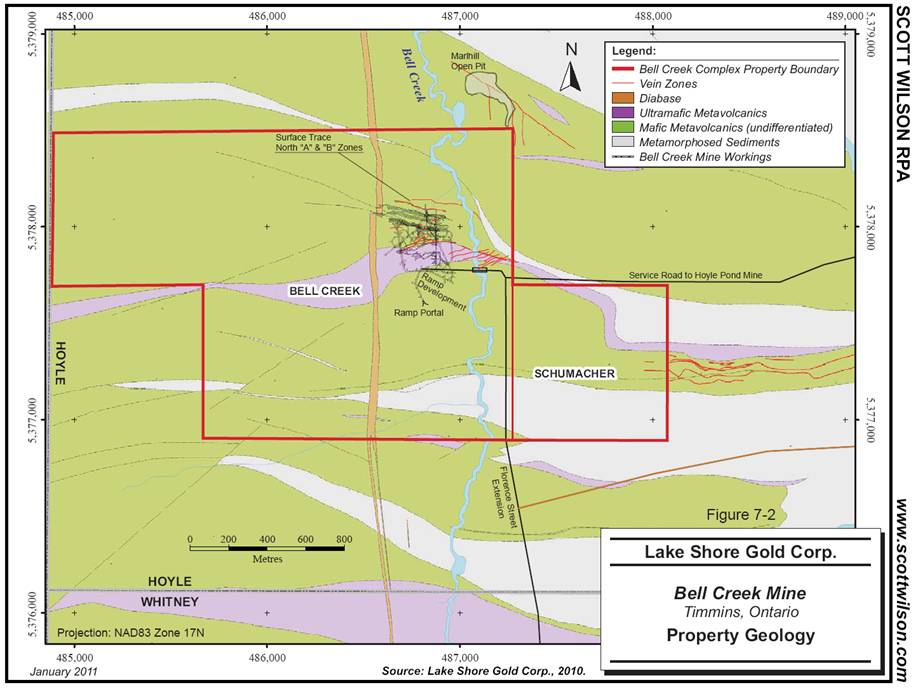
7-14
8 DEPOSIT TYPES
The Porcupine area is well known for hosting two mineral deposit types:
· Xstrata’s Kidd Creek mine, which is a volcanogenic massive sulphide deposit; and
· Several Archean-aged mesothermal gold deposits, of which Bell Creek is an example.
Approximately 15% of the gold mined to date in the Porcupine Camp has come from bulk tonnage, sheeted vein and stockwork deposits, and, to a lesser extent, from narrow veins hosted in Timiskaming-aged sedimentary rocks. These deposits have been mined at the Dome Mine in Tisdale Township, and at the Pamour, Falconbridge Hoyle, Broulan, Hallnor, and Bonetal mines in Whitney Township.
Mesothermal gold deposits comprise high Fe or high ratio Fe/(Fe + Mg) greenstone type rocks that induce sulphidization reactions and gold precipitation and are thought to have formed during the final orogenic phases of Archean tectonism. Regionally, deposits occur in the vicinity of large deformation zones associated with secondary or tertiary deformation. Cox (2000) describes the development of most mesothermal gold systems along active and permeable low displacement faults and shear zones adjacent to large crustal scale deformation zones. Clusters of large deposits commonly occur in greenschist-facies, and, to a lesser extent, amphibolite-facies, country rocks (Butler, 2008).
Gold production to the end of 2006, from some 50 operational sites, is reported to be 2,028,140 kg of Au (65,206,222 oz Au). Table 8-1 highlights the 21 locations that exceeded production of 3,110 kg of Au (100,000 oz Au). The gold deposits of Whitney Township were not examined here but are described by Aitken (1990) and by Brisbin (1997).
8-1
TABLE 8-1 PORCUPINE DISTRICT OPERATIONS WITH GREATER THAN
100,000 OZ AU PRODUCTION
Lake Shore Gold Corp. — Bell Creek Deposit
Deposit | | Oz Au (000) | |
Hollinger | | 19,328 | |
Dome | | 15,911 | |
McIntyre – Pamour - Schumacher | | 10,752 | |
Pamour #1 (pits 3,4, 7, Hoyle) | | 4,594 | |
Aunor – Pamour (#3) | | 2,502 | |
Hoyle Pond | | 2,690 | |
Hallnor (Pamour #2) | | 1,646 | |
Preston | | 1,539 | |
Paymaster | | 1,192 | |
Coniaurum/Carium | | 1,110 | |
Buffalo Ankerite | | 957 | |
Delnite (Open Pit) | | 924 | |
Pamour (other sources) | | 677 | |
Broulan Reef Mine | | 500 | |
Broulan Porcupine | | 241 | |
Owl Creek | | 237 | |
Hollinger Pamour Timmins | | 182 | |
Nighthawk | | 176 | |
Moneta | | 149 | |
Crown | | 138 | |
Bell Creek | | 113 | |
Source: http://www.mndm.gov.on.ca/mines/ogs/resgeol/office
The following subsections are a summary of the local Timmins area gold mineralization and stratigraphic association taken from Brisbin (1997).
HERSHEY LAKE FORMATION
Approximately 4.5 M oz Au have been produced from veins spatially associated with small quartz feldspar porphyry stocks and dykes which intrude Hersey Lake Formation flows on the Delnite, Aunor, Buffalo Ankerite, and Paymaster properties. Veins hosted in mafic flows intercalated with ultramafic flows adjacent to the Timiskaming unconformity have accounted for a significant portion of 6.1 M oz Au produced from the Broulan—Hallnor—Pamour mine area. In Hoyle Township, gold-bearing veins hosted within mafic flows of the Hersey Lake Formation were mined at Bell Creek, Marlhill, and Owl Creek mines and are being mined at Hoyle Pond Mine. Massive white quartz veins are hosted
8-2
in a carbonatized peridotitic komatiite unit near the Beaumont Shaft in northeastern Tisdale Township, but no gold production from that property is recorded.
CENTRAL FORMATION
Central Formation flows and interflow carbonaceous argillites are very important hosts for gold mineralization. The Central Ore Zone on the Hollinger property, all major gold zones in the McIntyre Mine, and a number of the vein systems in the Coniaurum Mine all occur within the Central Formation. A black, carbonaceous argillite is the uppermost unit in the Northern Member. It is the host for number 3, 5, and 25 veins in the McIntyre, 91 veins in the Hollinger Mine, and the single vein mined at Moneta Mine (Mason and Melnik, 1986). The 95 Member at the McIntyre Mine forms the hangingwall to the important veins hosted by the carbonaceous argillite that caps the Northern Member. The 95C was prominent marker unit at the Moneta, Hollinger, and McIntyre mines. It hosts 84 Vein in the Hollinger Mine and 7 Vein in the McIntyre Mine, which together yielded more than 3 M oz Au (Jones, 1985, as cited in Brisbin, 1997).
VIPOND FORMATION
The 99 Flow of the Vipond Formation is the stratigraphically uppermost unit to be affected by intense alteration in the Central Ore Zone of the Hollinger property. It displays intense ankerite alteration, weakly to moderate sericite alteration, and pyrite mineralization and hosts gold-bearing veins along its strike length on the south limb of the Central Tisdale Anticline. Mineralized exposures of the 99 Flow occur in open pits of the Hollinger property, on the McIntyre property, where it crops out immediately adjacent to Pear Lake porphyry south of Pearl Lake, and on the Coniaurum property, where it hosts number 2, 5, and 10 veins. The South Shaft was sunk on sub-horizontal white quartz on the Davidson Tisdale property in northeast Tisdale Township. There is no alteration present in this area and no significant production resulted from this shaft.
The V8 unit of the Vipond Formation is a complex and variable entity which as a whole forms a consistent stratigraphic unit, but within which there is less consistency due to facies variations. Its economic importance is underscored by the fact that 14 of the 20 quartz ankerite veins which up to 1979 accounted for 20% of gold produced at the Dome Mine (Fryer et al., 1979) were hosted by the Vipond Formation, and that the most important hosts were the Key and Spherulitic sub-units of the V8 (Crick, 1991). Very
8-3
little gold production has been derived from veins hosted with the V8 in the Hollinger—McIntyre—Coniaurum area. A portion of 92 Vein and 20 Vein were hosted in the V8 on the south side of the Hollinger property.
The V9 unit is a black carbonaceous argillite which overlies the V8 unit in the McIntyre (Griffis, 1960), Hollinger (Hall, 1985, as cited in Brisbin, 1997) Vipond (Dougherty, 1934) and Dome (Holmes, 1968) mines. Despite its presence over a wide area, there are sections where it is absent. On the McIntyre property, it is up to six metres thick but averages 1.5 m thick. The V9 is an important host for mineralization at the Vipond Mine (Dougherty, 1934). It hosts 20/24 Vein at the McIntyre and Coniaurum mines, much of the 92 Vein and 44 Vein at the Hollinger Mine, and quartz ankerite veins at the Dome Mine.
The most important zones of mineralization at the Vipond Mine occur in the V10A, known there as the 10 Flow (Dougherty, 1934). On the Coniaurum property, 40 Vein occurs in the V10A and adjacent V10B sub-units. The V10A hosts portions of the 92, 93, and 44 veins on the Hollinger property. Some of the “Dacite Ore” at the Dome occurs in a V10A. The carbonaceous argillite interval that overlies the V10A is a locus of quartz veining where it is present at the Vipond Mine (Dougherty, 1934) and hosts much of 93 Vein at the Hollinger Mine. The V10B hosts part of 93 and 44 veins at the Hollinger Mine, a portion of 40 Vein on the Coniaurum property, and “Dacite Ore” in the Dome Mine. The V10C hosts “Dacite Ore” at the Dome Mine.
GOLD CENTRE FORMATION
The only mineralization hosted by Gold Centre Formation flows occurs in vein systems in the “Northern Flows” at the Dome Mine similar to those in “Dacite Ore” in the underlying Vipond Formation
KRIST FORMATION
No gold mineralization is known to occur within the Krist Formation.
BEATTY FORMATION
No significant gold mineralization is known to occur within the Beatty Formation. Some of the auriferous veins hosted within the basal conglomerate of the Timiskaming Group
8-4
at the North Dome Shaft do transgress the contact with the Beatty Formation, but they pinch out within a few metres of the contact (Brisbin, 1997).
8-5
9 MINERALIZATION
In the Porcupine Camp, gold mineralized structures most commonly form in relatively competent volcanics intruded by felsic porphyry stocks and dykes prior to the deposition of the Timiskaming assemblages. Porphyries dating from 2691 ± 3 Ma to 2688 ± 2 Ma intruded the already folded and faulted greenstone sequences and initiated the mesothermal systems with the formation of associated albitites. Observations of pyrrhotite and gold-mineralized clasts at both Pamour and Dome mines within Timiskaming conglomerates suggest a prolonged gold deposition event from the creation of the steep south dipping DPFZ up to the latest episode of crustal stabilization (Butler, 2008).
Fracture intensity and alteration increase toward mineralized zones. Alteration consists of bulk and fracture-controlled sericite, Fe-dolomite to ankerite, quartz, and dark green to black chlorite. Microfractures contain late chlorite and carbonate veinlets. Distal carbonatization, resulting in grey carbonate zones, is quite common (Butler, 2008).
Kinross and PFV first coined the term “New Mines Trend” to describe areas of the Hoyle antiform and synform that host the current and past producing Hoyle Pond, Owl Creek, Marlhill, and Bell Creek mines and the Schumacher and Vogel advanced exploration projects.
Berger (1998) describes the gold mineralization as occurring along selvages of quartz veins and wall rocks, in stylolitic fractures in quartz veins, in fine grained pyrite, and in association with amorphous carbon. High grade gold mineralization occurs within quartz veins contained in alteration zones. The alteration zones are characterized by carbonate, graphitic and amorphous carbon, fine grained pyrite, sericite, and/or paragonite and are enriched in Au, As, Bi, and W. This style of alteration is referred to by mine geologists as “grey zones” and is an exploration target in Hoyle Township.
The gold-bearing North A Zone and West Zone were discovered by Canamax while drill testing electromagnetic and induced polarization (IP) geophysical anomalies. During the period of 1987 to 1994, the MNDM records report the milling of 576,017 short tons to produce 112,739 oz of Au at an average grade of 0.197 oz/st Au, or 6.13 g/t Au, from the North A and West zones.
9-1
BELL CREEK MINE
The Bell Creek West Zone was discovered in 1980 while drill testing electromagnetic conductors and IP anomalies. Kent (1990) describes the Bell Creek West Zone mineralization as occurring on or near the contact of the ultramafic metavolcanic and mafic fragmental metavolcanic rock units, with the latter as the preferred host. Mineralization consists of 2% to 10% pyrite, with accessory arsenopyrite, pyrrhotite, chalcopyrite, and minor quartz veins and veinlets. Approximately 90% of the gold is associated with the disseminated sulphides that occur in association with altered quartz-carbonate-sericite-sulphide zones that range from 0.5 m to seven metres in width. Lenses that are approximately 100 metres in length and 200 metres in vertical extent strike west-east and plunge steeply to the east. Multiple mineralized zones are identified along a one kilometre strike length of the mafic/ultramafic metavolcanic contact. Active carbon occurs in some of the mineralized pods in the form of sheared graphitic interflow sediments. The presence of the active carbon has a deleterious effect on gold recovery; consequently mining was not planned where this was encountered (Kent, 1990).
The North Zone at Bell Creek was intersected in 1981 while targeting IP anomalies. Consisting of two sub-parallel, west-northwest striking, 70° south dipping mineralized vein systems, the North Zone is comprised of two horizons, the A (south or upper) and the B (north or lower) zones.
The North A Zone outcrops approximately 200 metres north of the Bell Creek headframe and consists of a marker quartz vein that varies from 0.1 m to two metres in width with an associated alteration halo. Approximately 0.5 m in average width, the vein parallels the regional schistosity and cross-cuts lithology. Bright green hydromuscovite occurs as fractures and slip coatings in the vein, with visible gold occurring with the mica. Brown tourmaline (dravite) is ubiquitous. The North A Zone averages 6 g/t Au to 10 g/t Au over two metre to 10 m widths. Adjacent to the quartz marker vein is a grey to buff coloured altered zone which contains 5% to 15% pyrite and pyrrhotite, with accessory chalcopyrite and arsenopyrite. Up to 30% of the gold in the North A Zone occurs within the alteration halo, in discrete sulphide zones and in vein-brecciated wall rock zones that extend up to five metres from the margin of the core vein.
At the time of active production at Bell Creek, the North B Horizon was considered uneconomic to mine due to the low gold grades relative to the metal price of the day and
9-2
because portions of the wall rocks were thought to contain active carbon, which was determined to be detrimental to gold recovery (Kent, 1990).
SCHUMACHER PROPERTY
The Schumacher property is underlain by the same stratigraphy as the Bell Creek Mine. Portions of the metavolcanic rock units were explored for the eastward extensions of the Bell Creek West, and North A Zone mineralized zones. Prior to Lake Shore Gold’s acquisition of the property, a total of 58 diamond drill holes were drilled between 1984 and 1997 by Canamax, Falconbridge Gold, and PFV for an aggregate length of 17,992 m. Three non-NI 43-101 compliant Mineral Resource estimates were completed on the Schumacher property. In 1996, Unto Jarvi, P.Eng., estimated 156,000 tonnes at 5.99 g/t Au within five sub-vertical zones. An estimate prepared by Dean Crick, P.Geo., totalled 673,000 tonnes at 2.89 g/t Au (Powers, 2009). The third resource estimate is referenced from the MNDM-Mineral Deposits Inventory (MDI) file and Kinross’ 1997 annual report illustrating a resource of 152,000 tonnes of 6.19 g/t Au. These zones are situated at the eastern portion of the property and appear to be the westward continuation of the mineralization underlying the Vogel property. Scott Wilson RPA notes that, as these Mineral Resource estimates predate the Standards of Disclosure for Mineral Projects as defined in NI 43-101, they cannot be relied upon and are quoted for historic purposes only.
9-3
10 EXPLORATION
Lake Shore Gold has been actively exploring in the Bell Creek area since 2005. A control grid using an extension of the Bell Creek coordinate system was established and the property boundaries were located and referenced with respect to this control grid. A magnetometer geophysical survey was completed but was not instrumental in defining stratigraphy. Lake Shore Gold’s diamond drill programs were designed to test the mine stratigraphy at depth and the existence of flat veins, as well as to provide geotechnical information and information on the overburden depths.
After the acquisition of the Schumacher property, drilling continued to test the flat veins located in the eastern portion of the property, as well as to test the volcanic stratigraphy. In 2006, three stratigraphic holes totalling 3,307 m in aggregate length were followed by three shorter holes (totalling 546 m) along the margins of the gold-bearing zone. Later, in Q3 of 2006, Lake Shore Gold drilled an additional 912 m in three holes in an attempt to determine a shallow bedrock location for a potential ramp portal entrance. In addition to the standard core logging procedures, these holes were logged for Rock Quality Designation (RQD) (Butler, 2008). Recent drilling has been testing the down dip and down plunge extensions of mineralization intersected along the Bell Creek side of the common boundary.
Bell Creek Mine diamond drilling programs have tested the West Zone, North A Zone below and surrounding areas of the underground workings; as well as the West Veins system, the East Veins system, and the newly discovered Portal vein array. A new advanced exploration ramp is collared at UTM, NAD 83, Zone 17 coordinate 486,814 East, 5,377,603 North. The 5 m by 5 m ramp will provide access to the North A Zone, as well as testing targets along the way, and has advanced 2,447 m.
Work completed by the data cut-off date of October 26, 2010, is summarized in Table 10-1.
10-1
TABLE 10-1 EXPLORATION PROGRAMS 2005 TO 2010
Lake Shore Gold – Bell Creek Deposit
| | Number of | | | | Samples | |
Location | | Drill Holes | | Metres | | Taken | |
Bell Creek | | 161 | | 80,439 | | 22,239 | |
Bell Creek (underground)(1) | | 59 | | 7,020 | | 1,834 | |
Schumacher | | 22 | | 7,196 | | 1,763 | |
Notes
(1) includes 6 grout holes for fresh air raise.
10-2
11 DRILLING
HISTORIC DRILLING
Diamond drilling in the general vicinity of the Bell Creek deposit has been conducted by several companies, with the first drill hole recorded in government assessment files dating from 1940 (Alton C.B. Township 1 concession 9). Assessment reports on early work lacks assay results or identifiable collar locations. Consequently, diamond drill program descriptions begin with the Rosario drilling program that was completed in 1978.
A summary of historic drill programs at Bell Creek completed prior to Lake Shore Gold’s involvement is shown in Table 11-1:
TABLE 11-1 HISTORIC DRILLING AT BELL CREEK
Lake Shore Gold – Bell Creek Deposit
| | | | | | | | Bell Creek Area | |
| | | | Hole Sequence | | | | No. of | | | |
Company | | Year | | From | | To | | Location | | Holes | | Metres | |
Rosario | | 1978 | | MH78-1 | | MH78-7 | | surface | | 7 | | 868.98 | |
| | 1979 | | MH79-01 | | MH79-5 | | surface | | 5 | | 655.36 | |
| | 1980 | | MH80-01 | | MH80-19 | | surface | | 15 | | 2,523.69 | |
| | 1981 | | MH81-01 | | MH81-46 | | surface | | 38 | | 5,793.92 | |
| | | | | | | | | | | | | |
Amax(1) | | 1982 | | 1202-01-101 | | 1202-01-136 | | surface | | 34 | | 5,520.20 | |
| | | | | | | | | | | | | |
Canamax(1) | | 1988 to 1991 | | UG1-01 | | UG1-07 | | underground | | 7 | | 284.60 | |
| | | | UG2-01 | | UG2-07 | | underground | | 7 | | 248.72 | |
| | | | UG3-01 | | UG3-08 | | underground | | 8 | | 344.70 | |
| | | | UG4-01 | | UG4-09 | | underground | | 9 | | 2,557.71 | |
| | | | BC-88-01 | | BC-88-10 | | underground | | 10 | | 271.45 | |
| | | | 88-240-01 | | 88-240-15 | | underground | | 15 | | 141.42 | |
| | | | UG 2c-01-88 | | UG 2c-01-88 | | underground | | 2 | | 63.10 | |
| | | | UG 3b-01-01-88 | | UG 3b-01-05-88 | | underground | | 5 | | 171.00 | |
| | | | 180-01A-88 | | 180-05-88 | | underground | | 6 | | 120.41 | |
| | | | 120-01-88 | | 180-02-88 | | underground | | 2 | | 106.38 | |
| | | | 180-89-01 | | 180-89-04 | | underground | | 4 | | 228.90 | |
| | | | 240-89-01 | | 240-89-04 | | underground | | 4 | | 210.61 | |
| | | | 89-11 | | 89-18 | | underground | | 8 | | 357.39 | |
11-1
| | | | | | | | Bell Creek Area | |
| | | | Hole Sequence | | | | No. of | | | |
Company | | Year | | From | | To | | Location | | Holes | | Metres | |
| | | | 9001 | | 9080 | | underground | | 66 | | 3,412.15 | |
| | | | 9101 | | 9183 | | underground | | 74 | | 4,503.68 | |
| | | | | | | | | | | | | |
Falconbridge | | 1992 to 1994 | | 9201 | | 9229 | | underground | | 25 | | 2,401.00 | |
| | | | 9401 | | 9460 | | underground | | 39 | | 3,754.47 | |
| | | | | | | | | | | | | |
PFV | | 1995 | | KB380 | | KB411 | | surface | | 7 | | 1,807.00 | |
| | | | | | | | | | | | | |
PJV | | 2005 | | BC05-01 | | BC05-41 | | surface | | 36 | | 11,469.00 | |
Notes
(1) Drill holes identified as C “hole number” in database
Rosario drilling (1978 to 1981) consists of both north-to-south and south-to-north oriented drill holes in the general vicinity of the mine, with no drill holes collared within 1,000 m of anticipated future mine workings.
The North A and North B veins were first intersected in 1980. The strike of veins is at 100° azimuth and they dip 70° south, yielding intersections approximately normal to the vein strike (10° variance).
Amax and Canamax surface drilling between 1982 and 1990 was completed at 30 m centres on a north-south oriented grid presently referred to as the Bell Creek Mine grid. The collar orientation for most drill holes was 360° azimuth, yielding intersections approximately normal to the strike of the vein (10° variance).
Diamond drilling from underground mine workings, by Canamax (1988 through 1991) and Falconbridge (1991 through 1994), was completed from prepared diamond drill cutouts with drill holes fanned to provide coverage of the target area. Intersection angles therefore vary considerably.
Subsequent surface drilling by PFV and PJV used the Bell Creek Mine grid, predominantly with north-aiming drill collars.
11-2
Drill holes BC05-31 to BC05-36 completed by PJV were collared east of the mine workings and were oriented at 330° azimuth, presumably to compensate for downhole deviation.
Significant assay intersections for historic drilling programs are summarized in Table 11-2.
TABLE 11-2 SIGNIFICANT RESULTS FROM HISTORIC DRILLING AT BELL CREEK
Lake Shore Gold Corp. – Bell Creek Deposit
| | | | | | | | | | Grade | | | |
| | | | From | | To | | Core Length(1) | | Uncapped | | Capped(2) | | | |
Hole-ID | | Section | | (m) | | (m) | | (m) | | (g/t Au) | | (g/t Au) | | Zone | |
9140 | | 5550E | | 62.0 | | 65.2 | | 3.2 | | 2.09 | | 2.09 | | North A | |
9144 | | 5800E | | 198.8 | | 201.0 | | 2.2 | | 4.70 | | 4.70 | | North B | |
9151 | | 5550E | | 0.3 | | 5.9 | | 5.4 | | 7.86 | | 7.86 | | North A | |
9152 | | 5550E | | 0.5 | | 8.7 | | 7.8 | | 5.07 | | 5.07 | | North A | |
9153 | | 5550E | | 32.6 | | 34.1 | | 1.6 | | 4.89 | | 4.89 | | North AX | |
9153 | | 5500E | | 44.4 | | 49.8 | | 5.4 | | 4.55 | | 4.55 | | North A | |
9158 | | 5500E | | 60.9 | | 63.4 | | 2.4 | | 4.91 | | 4.91 | | North A | |
9159 | | 5475E | | 33.9 | | 38.4 | | 4.6 | | 3.18 | | 3.18 | | North AX | |
9159 | | 5475E | | 49.8 | | 51.6 | | 1.8 | | 5.25 | | 5.25 | | North A | |
9167 | | 5550E | | 0.0 | | 2.0 | | 2.0 | | 7.24 | | 7.24 | | North A | |
9168 | | 5575E | | 0.0 | | 1.6 | | 1.6 | | 1.91 | | 1.91 | | North A | |
9211 | | 5700E | | 65.3 | | 67.2 | | 1.9 | | 8.80 | | 8.80 | | North A | |
9214 | | 5525E | | 240.8 | | 242.6 | | 1.8 | | 8.65 | | 8.65 | | North AX | |
9216 | | 5500E | | 276.6 | | 278.6 | | 2.0 | | 3.33 | | 3.33 | | North A | |
9219 | | 5750E | | 231.6 | | 234.7 | | 3.1 | | 1.51 | | 1.51 | | North A | |
9222 | | 5500E | | 269.0 | | 271.1 | | 2.1 | | 4.83 | | 4.83 | | North A | |
9223 | | 5725E | | 76.5 | | 78.0 | | 1.5 | | 5.96 | | 5.96 | | North A | |
9407 | | 5700E | | 9.8 | | 13.0 | | 3.2 | | 2.22 | | 2.22 | | North A | |
9409 | | 5700E | | 8.5 | | 12.0 | | 3.5 | | 4.53 | | 4.53 | | North A | |
9411 | | 5650E | | 7.6 | | 13.0 | | 5.4 | | 5.73 | | 5.73 | | North A | |
9412 | | 5450E | | 12.5 | | 15.0 | | 2.5 | | 3.80 | | 3.80 | | North A | |
9413 | | 5475E | | 11.8 | | 14.4 | | 2.6 | | 5.23 | | 5.23 | | North A | |
9414 | | 5475E | | 13.1 | | 15.8 | | 2.7 | | 3.67 | | 3.67 | | North A | |
9415 | | 5475E | | 12.0 | | 16.0 | | 4.0 | | 19.19 | | 6.31 | | North A | |
9430 | | 5725E | | 102.0 | | 103.4 | | 1.4 | | 2.44 | | 2.44 | | North A | |
9431 | | 5725E | | 100.9 | | 102.8 | | 1.9 | | 3.63 | | 3.63 | | North A | |
9433 | | 5750E | | 103.0 | | 105.0 | | 2.0 | | 3.58 | | 3.58 | | North A | |
9434 | | 5750E | | 108.0 | | 109.8 | | 1.8 | | 2.12 | | 2.12 | | North A | |
9435 | | 5775E | | 150.0 | | 158.7 | | 8.7 | | 3.05 | | 3.05 | | North B | |
9436 | | 5775E | | 126.5 | | 128.0 | | 1.5 | | 3.69 | | 3.69 | | North A | |
11-3
| | | | | | | | | | Grade | | | |
| | | | From | | To | | Core Length(1) | | Uncapped | | Capped(2) | | | |
Hole-ID | | Section | | (m) | | (m) | | (m) | | (g/t Au) | | (g/t Au) | | Zone | |
9437 | | 5750E | | 115.0 | | 120.5 | | 5.5 | | 4.55 | | 4.55 | | North A | |
9439 | | 5650E | | 148.7 | | 154.0 | | 5.3 | | 3.59 | | 3.59 | | North A | |
9440 | | 5650E | | 162.6 | | 167.1 | | 4.5 | | 7.41 | | 7.41 | | North A | |
9441 | | 5675E | | 116.0 | | 118.3 | | 2.3 | | 10.39 | | 9.42 | | North A | |
9442 | | 5700E | | 118.9 | | 124.0 | | 5.1 | | 1.50 | | 1.50 | | North A | |
9443 | | 5575E | | 120.5 | | 124.3 | | 3.8 | | 10.04 | | 9.20 | | North A | |
9444 | | 5600E | | 113.2 | | 116.3 | | 3.1 | | 3.45 | | 3.45 | | North A | |
9445 | | 5575E | | 103.2 | | 105.2 | | 2.0 | | 10.21 | | 9.01 | | North A | |
9446 | | 5575E | | 105.0 | | 107.0 | | 2.0 | | 4.78 | | 4.78 | | North A | |
9449 | | 5550E | | 63.0 | | 65.5 | | 2.5 | | 4.81 | | 4.46 | | North A | |
9450 | | 5525E | | 54.0 | | 56.0 | | 2.0 | | 3.71 | | 3.71 | | North AX | |
9450 | | 5525E | | 60.7 | | 62.7 | | 2.0 | | 8.57 | | 8.57 | | North A | |
9451 | | 5500E | | 53.1 | | 55.9 | | 2.8 | | 10.09 | | 10.09 | | North AX | |
9452 | | 5500E | | 60.8 | | 62.1 | | 1.3 | | 7.87 | | 7.87 | | North A | |
9453 | | 5525E | | 52.5 | | 55.3 | | 2.8 | | 9.85 | | 6.72 | | North AX | |
9453 | | 5525E | | 59.5 | | 61.0 | | 1.5 | | 6.88 | | 6.88 | | North A | |
9455 | | 5475E | | 59.8 | | 61.7 | | 1.9 | | 3.80 | | 3.80 | | North AX | |
9455 | | 5575E | | 78.8 | | 80.3 | | 1.5 | | 4.12 | | 4.12 | | North A | |
9460 | | 5625E | | 122.7 | | 128.6 | | 5.9 | | 8.54 | | 8.54 | | North A | |
2-4 | | 5650E | | 27.9 | | 30.5 | | 2.6 | | 1.58 | | 1.58 | | North B | |
2-6 | | 5700E | | 27.6 | | 31.4 | | 3.5 | | 2.10 | | 2.10 | | North B | |
3-1 | | 5700E | | 43.5 | | 45.5 | | 2.0 | | 2.49 | | 2.49 | | North B | |
3-7 | | 5775E | | 38.1 | | 42.1 | | 4.0 | | 1.54 | | 1.54 | | North B | |
4-2 | | 5675E | | 215.8 | | 218.1 | | 2.3 | | 3.85 | | 3.85 | | North A | |
4-3 | | 5600E | | 277.0 | | 280.2 | | 3.2 | | 3.05 | | 3.05 | | North B | |
4-9 | | 5600E | | 226.9 | | 228.6 | | 1.7 | | 6.08 | | 6.08 | | North A | |
240-03 | | 5725E | | 21.8 | | 28.7 | | 6.9 | | 5.45 | | 5.45 | | North A | |
240-06 | | 5750E | | 49.0 | | 53.0 | | 4.0 | | 2.32 | | 2.32 | | North B | |
240-13 | | 5725E | | 52.0 | | 54.2 | | 2.2 | | 5.80 | | 5.80 | | North B | |
2C01 | | 5700E | | 23.1 | | 26.3 | | 3.2 | | 3.23 | | 3.23 | | North B | |
3B02 | | 5725E | | 21.3 | | 25.4 | | 4.1 | | 1.51 | | 1.51 | | North B | |
3B03 | | 5675E | | 25.9 | | 29.9 | | 4.0 | | 3.37 | | 3.37 | | North B | |
3B04 | | 5675E | | 22.9 | | 26.8 | | 4.0 | | 1.98 | | 1.98 | | North B | |
3B05 | | 5675E | | 28.3 | | 33.6 | | 5.3 | | 4.52 | | 4.52 | | North B | |
4-1B | | 5700E | | 175.0 | | 181.0 | | 6.0 | | 7.03 | | 7.03 | | North A | |
BC05-12 | | 5775E | | 328.6 | | 330.8 | | 2.1 | | 1.74 | | 1.74 | | North A2 | |
BC05-12 | | 5775E | | 370.4 | | 373.0 | | 2.6 | | 4.31 | | 4.31 | | North A | |
BC05-21 | | 5800E | | 346.1 | | 348.3 | | 2.2 | | 15.76 | | 7.07 | | North B | |
BC05-22 | | 5800E | | 320.8 | | 329.7 | | 8.9 | | 8.81 | | 8.81 | | North A | |
BC05-23 | | 5775E | | 256.2 | | 260.0 | | 3.8 | | 3.63 | | 3.63 | | North A | |
BC05-28 | | 5875E | | 332.0 | | 338.3 | | 6.3 | | 5.88 | | 5.88 | | North A | |
BC05-28 | | 5875E | | 403.2 | | 404.9 | | 1.7 | | 3.03 | | 3.03 | | North B | |
BC05-31 | | 5775E | | 458.9 | | 463.6 | | 4.7 | | 2.73 | | 2.73 | | North A | |
C102 | | 5675E | | 125.5 | | 129.5 | | 4.0 | | 2.50 | | 2.50 | | North B | |
11-4
| | | | | | | | | | Grade | | | |
| | | | From | | To | | Core Length(1) | | Uncapped | | Capped(2) | | | |
Hole-ID | | Section | | (m) | | (m) | | (m) | | (g/t Au) | | (g/t Au) | | Zone | |
C112 | | 5725E | | 81.0 | | 84.5 | | 3.5 | | 3.63 | | 3.63 | | North B | |
C113 | | 5600E | | 100.0 | | 101.7 | | 1.7 | | 1.92 | | 1.92 | | North B | |
C121 | | 5650E | | 124.7 | | 129.0 | | 4.3 | | 1.67 | | 1.67 | | North B | |
C123 | | 5675E | | 173.8 | | 177.8 | | 4.0 | | 3.04 | | 3.04 | | North B | |
C124 | | 5775E | | 114.4 | | 117.5 | | 3.1 | | 2.60 | | 2.60 | | North B | |
C125 | | 5725E | | 170.8 | | 174.0 | | 3.2 | | 2.43 | | 2.43 | | North B | |
C127 | | 5675E | | 208.0 | | 212.0 | | 4.0 | | 4.26 | | 4.26 | | North B | |
C128 | | 5750E | | 175.5 | | 177.3 | | 1.8 | | 3.91 | | 3.91 | | North B | |
C129 | | 5775E | | 136.2 | | 138.0 | | 1.8 | | 3.85 | | 3.85 | | North A | |
C134 | | 5675E | | 262.5 | | 264.5 | | 2.0 | | 1.62 | | 1.62 | | North B | |
C135 | | 5750E | | 212.7 | | 216.2 | | 3.5 | | 4.50 | | 4.50 | | North A | |
C136 | | 5800E | | 196.7 | | 199.3 | | 2.6 | | 1.91 | | 1.91 | | North A | |
C136 | | 5800E | | 246.7 | | 248.7 | | 2.0 | | 1.75 | | 1.75 | | North B | |
C137 | | 5850E | | 178.7 | | 180.7 | | 2.0 | | 2.36 | | 2.36 | | North A | |
C141 | | 5700E | | 200.4 | | 206.1 | | 5.7 | | 2.47 | | 2.47 | | North B | |
C142 | | 5775E | | 183.0 | | 185.3 | | 2.3 | | 5.00 | | 5.00 | | North A | |
C142 | | 5750E | | 224.3 | | 228.7 | | 4.4 | | 2.06 | | 2.06 | | North B | |
C143 | | 5775E | | 82.0 | | 84.5 | | 2.5 | | 5.55 | | 5.55 | | North A | |
C143 | | 5775E | | 127.2 | | 129.2 | | 2.0 | | 1.84 | | 1.84 | | North B | |
C144 | | 5800E | | 133.0 | | 135.0 | | 2.0 | | 1.31 | | 1.31 | | North B | |
C145 | | 5850E | | 92.9 | | 94.9 | | 2.0 | | 1.55 | | 1.55 | | North A | |
C145 | | 5850E | | 152.0 | | 154.0 | | 2.0 | | 2.77 | | 2.77 | | North B | |
C146 | | 5725E | | 119.0 | | 122.0 | | 3.0 | | 2.03 | | 2.03 | | North B | |
C184 | | 5475E | | 349.2 | | 351.2 | | 2.0 | | 4.29 | | 4.29 | | North AX | |
C188 | | 5600E | | 360.9 | | 363.8 | | 2.9 | | 4.35 | | 4.35 | | North A | |
C190 | | 5650E | | 358.5 | | 360.4 | | 1.9 | | 4.57 | | 4.57 | | North A | |
C191 | | 5725E | | 345.0 | | 347.0 | | 2.0 | | 4.06 | | 4.06 | | North A | |
C192 | | 5725E | | 285.9 | | 287.4 | | 1.5 | | 3.69 | | 3.69 | | North A | |
C299 | | 5800E | | 273.6 | | 275.7 | | 2.2 | | 2.75 | | 2.75 | | North A | |
C299 | | 5800E | | 328.6 | | 330.8 | | 2.2 | | 10.54 | | 10.54 | | North B | |
C300 | | 5800E | | 315.6 | | 321.6 | | 6.0 | | 4.03 | | 4.03 | | North A | |
C300 | | 5800E | | 372.0 | | 375.2 | | 3.3 | | 1.99 | | 1.99 | | North B | |
KB403 | | 5800E | | 120.5 | | 122.0 | | 1.5 | | 2.24 | | 2.24 | | North A | |
KB404 | | 5775E | | 104.2 | | 105.6 | | 1.4 | | 2.21 | | 2.21 | | North B | |
KB405 | | 5775E | | 40.4 | | 43.4 | | 3.0 | | 4.24 | | 4.24 | | North B | |
MH8145 | | 5675E | | 49.4 | | 55.1 | | 5.5 | | 4.11 | | 4.11 | | North B | |
Notes:
(1) Core lengths only. True widths will be less than the core length depending upon the relative angle of intersection between the drill hole and the target structure.
(2) Top cut value of 34 g/t Au.
11-5
LAKE SHORE GOLD DRILLING
All work performed by Lake Shore Gold at Bell Creek is referenced to the Bell Creek mine grid, which has been extended eastward through the Schumacher and Vogel properties. Proposed diamond drill hole collar locations are spotted in reference to this grid. Upon completion of each drill hole, L. Labelle Surveys of Timmins surveyed the final collar location in reference to the mine grid using the UTM, NAD 83, Zone 17 datum.
During surface drilling programs, azimuth and inclination readings are taken at 30 m to 50 m intervals down the holes using a Reflex EZ-Shot instrument to aid in tracking the path of the drill hole as drilling progresses. Upon completion, it is standard procedure to have each bore hole resurveyed by Halliburton/Sperry Drilling Services of North Bay, Ontario, using a north-seeking gyro. The data from the gyroscopic surveys are then inserted in the drill hole database.
Lake Shore Gold reports that flattening of recently completed surface diamond drill holes greater than 800 m in depth results in intersections which are believed to be at approximately true thicknesses.
Drill holes completed from underground are also referenced to the Bell Creek mine grid and are monitored downhole in 50 m intervals using a Reflex EZ-Shot instrument. Drilling is conducted from prepared diamond drill cut-outs stations, with drill holes fanned to provide coverage of the target area. Intersection angles of the drill holes with the target structures therefore vary considerably. Upon completion of a bore hole, the collar location is surveyed by the Bell Creek Survey department.
An image of the drill hole collar locations as at the October 26, 2010 data cut-off date are shown in Figure 17-1 in Section 17 of this report.
Significant assay results from drilling completed by Lake Shore Gold at Bell Creek are summarized in Table 11-3.
11-6
TABLE 11-3 SIGNIFICANT RESULTS FROM RECENT DRILLING BY LAKE SHORE GOLD AT BELL CREEK
Lake Shore Gold Corp. — Bell Creek Deposit
| | | | | | | | | | Grade | | | |
| | | | From | | To | | Core Length(1) | | Uncapped | | Capped(2) | | | |
Hole-ID | | Section | | (m) | | (m) | | (m) | | (g/t Au) | | (g/t Au) | | Zone | |
Surface Drilling | | | | | | | | | | | | | |
BC-08-07B | | 5550E | | 961.5 | | 964.3 | | 2.8 | | 5.91 | | 5.91 | | North B | |
BC-08-09 | | 5975E | | 1,013.9 | | 1,028.6 | | 14.7 | | 4.42 | | 4.31 | | North A | |
BC-08-09 | | 5950E | | 1,049.3 | | 1,053.9 | | 4.7 | | 6.07 | | 6.07 | | North B2 | |
BC-08-09A | | 5975E | | 948.3 | | 961.5 | | 13.2 | | 2.25 | | 2.25 | | North A2 | |
BC-08-09A | | 5975E | | 1,086.5 | | 1,088.5 | | 2.0 | | 1.76 | | 1.76 | | North B | |
BC-08-09B | | 6000E | | 927.3 | | 933.7 | | 6.4 | | 3.23 | | 3.23 | | North A2 | |
BC-08-09B | | 6000E | | 1,010.8 | | 1,012.5 | | 1.7 | | 5.58 | | 5.58 | | North B2 | |
BC-08-09C | | 6025E | | 908.2 | | 916 | | 7.8 | | 4.76 | | 4.76 | | North A2 | |
BC-08-09C | | 6000E | | 973.6 | | 979.4 | | 5.8 | | 5.94 | | 5.94 | | North A | |
BC-08-09C | | 6000E | | 1,003.5 | | 1,005.6 | | 2.1 | | 4.41 | | 4.41 | | North B2 | |
BC-08-23 | | 6050E | | 612.6 | | 617.8 | | 5.2 | | 2.93 | | 2.93 | | North A2 | |
BC-08-23A | | 6025E | | 616.8 | | 620.7 | | 3.9 | | 3.80 | | 3.80 | | North A2 | |
BC-08-23B | | 6025E | | 615.8 | | 617.7 | | 1.9 | | 1.79 | | 1.79 | | North A2 | |
BC-08-23C | | 6025E | | 615.1 | | 617.1 | | 2.0 | | 1.53 | | 1.53 | | North A2 | |
BC-08-24 | | 5650E | | 771.6 | | 780.5 | | 8.9 | | 4.70 | | 3.99 | | North B | |
BC-08-24B | | 5675E | | 768.5 | | 775.4 | | 6.9 | | 5.30 | | 5.30 | | North B | |
BC-08-27 | | 5700E | | 675.2 | | 677.7 | | 2.5 | | 2.38 | | 2.38 | | North B | |
BC-09-02 | | 5775E | | 706.1 | | 708.1 | | 2.0 | | 2.41 | | 2.41 | | North A2 | |
BC-09-02 | | 5775E | | 741.6 | | 749.4 | | 7.9 | | 5.77 | | 5.77 | | North A | |
BC-09-02A | | 5775E | | 652.7 | | 654.5 | | 1.8 | | 2.95 | | 2.95 | | North A3 | |
BC-09-02A | | 5775E | | 673.5 | | 675.2 | | 1.8 | | 1.94 | | 1.94 | | North A2 | |
BC-09-02A | | 5775E | | 720.0 | | 729.1 | | 9.1 | | 3.43 | | 3.43 | | North A | |
BC-09-03 | | 6025E | | 787.9 | | 796.9 | | 9.0 | | 1.50 | | 1.50 | | North A2 | |
BC-09-03A | | 6025E | | 781.6 | | 787.1 | | 5.5 | | 7.47 | | 7.47 | | North A2 | |
BC-09-03A | | 6000E | | 864.5 | | 866.5 | | 2.0 | | 3.89 | | 3.89 | | North A | |
BC-09-07 | | 5775E | | 534.6 | | 538.1 | | 3.5 | | 4.07 | | 4.07 | | North A3 | |
BC-09-07 | | 5775E | | 558.2 | | 560.1 | | 1.9 | | 8.08 | | 8.08 | | North A2 | |
BC-09-07 | | 5775E | | 596.9 | | 599.4 | | 2.5 | | 2.94 | | 2.94 | | North A | |
BC-09-07 | | 5775E | | 662.7 | | 665.6 | | 2.9 | | 2.35 | | 2.35 | | North B | |
BC-09-11 | | 5975E | | 739.0 | | 749.2 | | 10.2 | | 3.23 | | 3.23 | | North A2 | |
BC-09-11 | | 5950E | | 821.1 | | 825.1 | | 4.0 | | 1.82 | | 1.82 | | North B2 | |
BC-09-11 | | 5950E | | 846.3 | | 848.7 | | 2.4 | | 2.63 | | 2.63 | | North B | |
BC-09-12 | | 5850E | | 655.3 | | 657.8 | | 2.5 | | 3.02 | | 3.02 | | North A3 | |
BC-09-12 | | 5850E | | 686.4 | | 688.9 | | 2.5 | | 7.00 | | 7.00 | | North A2 | |
BC-09-12 | | 5850E | | 721.9 | | 730.4 | | 8.5 | | 5.18 | | 5.18 | | North A | |
BC-09-12 | | 5850E | | 779.8 | | 781.4 | | 1.6 | | 6.19 | | 6.19 | | North B | |
BC-09-16 | | 5900E | | 483.6 | | 484.8 | | 1.2 | | 1.67 | | 1.67 | | North A | |
BC-09-17 | | 5925E | | 791.7 | | 793.7 | | 2.0 | | 1.99 | | 1.99 | | North B | |
11-7
| | | | | | | | | | Grade | | | |
| | | | From | | To | | Core Length(1) | | Uncapped | | Capped(2) | | | |
Hole-ID | | Section | | (m) | | (m) | | (m) | | (g/t Au) | | (g/t Au) | | Zone | |
BC-09-17 | | 5900E | | 722.8 | | 724.7 | | 1.9 | | 3.20 | | 3.20 | | North A | |
BC-09-18 | | 5875E | | 438.3 | | 440.3 | | 2.0 | | 2.76 | | 2.76 | | North A2 | |
BC-09-19 | | 5875E | | 345.5 | | 347.0 | | 1.5 | | 2.71 | | 2.71 | | North A3 | |
BC-09-19 | | 5875E | | 435.3 | | 436.9 | | 1.6 | | 3.43 | | 3.43 | | North A | |
BC-09-20 | | 5900E | | 309.1 | | 310.6 | | 1.5 | | 4.89 | | 4.89 | | North A | |
BC-09-23 | | 5900E | | 583.3 | | 585.3 | | 2.0 | | 4.49 | | 4.49 | | North A3 | |
BC-09-24B | | 6050E | | 1,118.5 | | 1,131.6 | | 13.1 | | 11.62 | | 11.41 | | North A2 | |
BC-09-24B | | 6050E | | 1,138.5 | | 1,140.9 | | 2.4 | | 3.10 | | 3.10 | | North A | |
BC-09-24B | | 6050E | | 1,198.4 | | 1,200.2 | | 1.9 | | 3.14 | | 3.14 | | North B2 | |
BC-09-24C | | 6025E | | 1,183.4 | | 1,186.0 | | 2.6 | | 1.51 | | 1.51 | | North B | |
BC-09-24C | | 6025E | | 1,165.9 | | 1,168.0 | | 2.1 | | 2.13 | | 2.13 | | North B2 | |
BC-09-24C | | 6025E | | 1,110.4 | | 1,118.4 | | 8.0 | | 3.76 | | 3.76 | | North A | |
BC-09-24F | | 6025E | | 1,105.4 | | 1,116.0 | | 10.6 | | 5.59 | | 5.59 | | North A2 | |
BC-09-24F | | 6025E | | 1,141.8 | | 1,144.8 | | 3.0 | | 5.55 | | 5.55 | | North A | |
BC-09-24F | | 6025E | | 1,174.5 | | 1,176.4 | | 1.9 | | 2.33 | | 2.33 | | North B2 | |
BC-09-24H | | 6025E | | 1,054.3 | | 1,060.0 | | 5.7 | | 6.79 | | 6.79 | | North A | |
BC-09-26 | | 5775E | | 507.8 | | 510.2 | | 2.4 | | 1.79 | | 1.79 | | North A3 | |
BC-09-26 | | 5775E | | 532.9 | | 535.1 | | 2.3 | | 2.02 | | 2.02 | | North A2 | |
BC-09-26 | | 5775E | | 630.6 | | 634.0 | | 3.4 | | 1.78 | | 1.78 | | North B | |
BC-09-29 | | 5775E | | 564.0 | | 565.7 | | 1.8 | | 2.24 | | 2.24 | | North A3 | |
BC-09-29 | | 5775E | | 590.5 | | 592.8 | | 2.2 | | 1.55 | | 1.55 | | North A2 | |
BC-09-41 | | 5800E | | 517.9 | | 519.8 | | 1.9 | | 1.96 | | 1.96 | | North A | |
BC-09-41 | | 5800E | | 497.2 | | 501.5 | | 4.3 | | 2.22 | | 2.22 | | North A2 | |
BC-09-50 | | 5650E | | 623.4 | | 625.6 | | 2.2 | | 11.56 | | 11.56 | | North A | |
BC-09-50 | | 5650E | | 671.8 | | 673.4 | | 1.6 | | 3.48 | | 3.48 | | North B | |
BC-09-51 | | 5600E | | 759.3 | | 762.2 | | 2.9 | | 2.57 | | 2.57 | | North B | |
BC-09-53 | | 5975E | | 1,123.9 | | 1,125.6 | | 1.8 | | 2.05 | | 2.05 | | North A2 | |
BC-09-53 | | 5975E | | 1,153.0 | | 1,177.7 | | 24.7 | | 8.09 | | 7.71 | | North A | |
BC-09-53 | | 5975E | | 1,202.5 | | 1,205.5 | | 3.0 | | 4.15 | | 4.15 | | North B2 | |
BC-09-53 | | 5975E | | 1,236.4 | | 1,238.4 | | 2.0 | | 4.99 | | 4.99 | | North B | |
BC-09-53A | | 5975E | | 1,114.4 | | 1,116.2 | | 1.8 | | 8.19 | | 8.19 | | North A2 | |
BC-09-53A | | 5950E | | 1,163.5 | | 1,189.9 | | 26.4 | | 5.13 | | 5.13 | | North A | |
BC-09-53A | | 5950E | | 1,201.5 | | 1,203.0 | | 1.5 | | 4.74 | | 4.74 | | North B2 | |
BC-09-53A | | 5950E | | 1,228.7 | | 1,232.5 | | 3.8 | | 2.32 | | 2.32 | | North B | |
BC-09-53B | | 5975E | | 1,153.9 | | 1,156.4 | | 2.5 | | 8.24 | | 8.24 | | North A2 | |
BC-09-53B | | 5975E | | 1,193.0 | | 1,217.3 | | 24.3 | | 3.12 | | 3.12 | | North A | |
BC-09-53B | | 5975E | | 1,229.8 | | 1,237.3 | | 7.5 | | 8.49 | | 8.49 | | North B2 | |
BC-09-53B | | 5975E | | 1,261.2 | | 1,270.1 | | 8.9 | | 2.10 | | 2.10 | | North B | |
BC-09-53D | | 5900E | | 1,164.7 | | 1,168.0 | | 3.3 | | 7.24 | | 7.21 | | North A2 | |
BC-09-53D | | 5875E | | 1,207.3 | | 1,212.0 | | 4.7 | | 5.79 | | 5.79 | | North A | |
BC-09-53E | | 5850E | | 1,222.9 | | 1,227.1 | | 4.2 | | 4.45 | | 4.45 | | North A | |
BC-09-53G | | 5875E | | 1,129.8 | | 1,132.2 | | 2.5 | | 1.96 | | 1.96 | | North A2 | |
BC-09-63 | | 5925E | | 782.6 | | 786.1 | | 3.5 | | 1.80 | | 1.80 | | North A3 | |
11-8
| | | | | | | | | | Grade | | | |
| | | | From | | To | | Core Length(1) | | Uncapped | | Capped(2) | | | |
Hole-ID | | Section | | (m) | | (m) | | (m) | | (g/t Au) | | (g/t Au) | | Zone | |
BC-09-63 | | 5900E | | 830.9 | | 839.4 | | 8.5 | | 5.09 | | 5.09 | | North A | |
BC-09-63 | | 5900E | | 885.5 | | 888.0 | | 2.5 | | 1.98 | | 1.98 | | North B2 | |
BC-09-63 | | 5900E | | 914.0 | | 919.6 | | 5.6 | | 1.62 | | 1.62 | | North B | |
BC-09-64 | | 5750E | | 579.0 | | 580.8 | | 1.8 | | 2.24 | | 2.24 | | North A | |
BC-09-64 | | 5750E | | 627.0 | | 629.4 | | 2.4 | | 2.66 | | 2.66 | | North B | |
BC-09-67 | | 5700E | | 634.5 | | 636.8 | | 2.3 | | 2.88 | | 2.88 | | North A | |
BC-09-67 | | 5700E | | 668.7 | | 670.4 | | 1.7 | | 4.46 | | 4.46 | | North B | |
BC-09-69 | | 5875E | | 888.1 | | 891.9 | | 3.8 | | 3.86 | | 3.86 | | North A2 | |
BC-09-69 | | 5875E | | 924.8 | | 935.2 | | 10.5 | | 2.37 | | 2.37 | | North A | |
BC-09-69 | | 5875E | | 944.0 | | 946.0 | | 2.0 | | 2.86 | | 2.86 | | North B2 | |
BC-09-69 | | 5875E | | 984.5 | | 988.0 | | 3.6 | | 3.10 | | 3.10 | | North B | |
BC-09-69A | | 5850E | | 870.2 | | 872.5 | | 2.3 | | 6.39 | | 6.39 | | North A2 | |
BC-09-69A | | 5850E | | 909.0 | | 912.5 | | 3.5 | | 6.17 | | 6.17 | | North A | |
BC-09-69A | | 5850E | | 959.9 | | 961.6 | | 1.7 | | 4.70 | | 4.70 | | North B | |
BC-09-69B | | 5875E | | 876.2 | | 878.4 | | 2.2 | | 5.92 | | 5.92 | | North A2 | |
BC-09-69B | | 5875E | | 902.3 | | 908.4 | | 6.1 | | 6.17 | | 6.17 | | North A | |
BC-09-69B | | 5900E | | 931.9 | | 933.5 | | 1.6 | | 3.04 | | 3.04 | | North B2 | |
BC-09-69B | | 5900E | | 962.9 | | 967.8 | | 4.9 | | 3.43 | | 3.43 | | North B | |
BC-09-71 | | 5850E | | 1,122.7 | | 1,124.5 | | 1.8 | | 2.30 | | 2.30 | | North B2 | |
BC-09-71 | | 5850E | | 1,158.0 | | 1,159.7 | | 1.7 | | 3.22 | | 3.22 | | North B | |
BC-09-71A | | 5900E | | 1,057.8 | | 1,060.5 | | 2.7 | | 4.93 | | 4.93 | | North A2 | |
BC-09-71A | | 5900E | | 1,092.6 | | 1,096.4 | | 3.8 | | 13.04 | | 13.04 | | North A | |
BC-09-71A | | 5925E | | 1,145.8 | | 1,148.4 | | 2.6 | | 6.22 | | 6.22 | | North B | |
BC-09-71B | | 5925E | | 1,054.0 | | 1,057.4 | | 3.4 | | 5.27 | | 5.27 | | North A2 | |
BC-09-71B | | 5925E | | 1,077.0 | | 1,082.5 | | 5.5 | | 2.97 | | 2.97 | | North A | |
BC-09-71B | | 5950E | | 1,128.9 | | 1,134.4 | | 5.5 | | 2.57 | | 2.57 | | North B | |
BC-09-71C | | 5950E | | 1,041.3 | | 1,043.9 | | 2.6 | | 1.61 | | 1.61 | | North A2 | |
BC-09-71C | | 5950E | | 1,060.3 | | 1,065.0 | | 4.7 | | 5.31 | | 5.31 | | North A | |
BC-09-71C | | 5950E | | 1,083.4 | | 1,085.6 | | 2.2 | | 4.21 | | 4.21 | | North B2 | |
BC-09-72 | | 5825E | | 467.7 | | 470.3 | | 2.6 | | 9.26 | | 9.26 | | North A3 | |
BC-09-72 | | 5850E | | 551.8 | | 556.7 | | 4.9 | | 21.53 | | 21.26 | | North A | |
BC-09-72 | | 5850E | | 612.0 | | 615.6 | | 3.6 | | 3.28 | | 3.28 | | North B | |
BC-09-77 | | 5825E | | 604.8 | | 619.5 | | 14.7 | | 6.13 | | 6.13 | | North A | |
BC-09-77 | | 5850E | | 674.8 | | 677.0 | | 2.2 | | 5.67 | | 5.67 | | North B | |
BC-10-91 | | 5875E | | 814.6 | | 821.4 | | 6.8 | | 5.27 | | 5.27 | | North A | |
BC-10-91 | | 5875E | | 865.4 | | 868.3 | | 2.9 | | 1.95 | | 1.95 | | North B | |
BC-10-94A | | 5875E | | 1,313.1 | | 1,317.2 | | 4.1 | | 22.04 | | 15.17 | | North A2 | |
BC-10-94A | | 5875E | | 1,447.3 | | 1,449.5 | | 2.2 | | 5.81 | | 5.81 | | North B | |
BC-10-94C | | 5950E | | 1,359.5 | | 1,410.0 | | 50.5 | | 5.16 | | 5.16 | | North A | |
BC-10-94C | | 5950E | | 1,435.9 | | 1,445.3 | | 9.4 | | 5.67 | | 5.67 | | North B | |
| | | | | | | | | | | | | | | |
Underground Drilling | | | | | | | | | | | | | |
BC180-221 | | 5500E | | 261.8 | | 263.5 | | 1.7 | | 7.05 | | 7.05 | | North AX | |
11-9
| | | | | | | | | | Grade | | | |
| | | | From | | To | | Core Length(1) | | Uncapped | | Capped(2) | | | |
Hole-ID | | Section | | (m) | | (m) | | (m) | | (g/t Au) | | (g/t Au) | | Zone | |
BC180-221 | | 5500E | | 281.7 | | 284.5 | | 2.8 | | 4.37 | | 4.37 | | North A | |
BC180-222 | | 5525E | | 244.5 | | 246.0 | | 1.5 | | 3.04 | | 3.04 | | North AX | |
BC180-222 | | 5500E | | 257.8 | | 262.5 | | 4.8 | | 2.78 | | 2.78 | | North A | |
BC180-223 | | 5575E | | 232.2 | | 234.0 | | 1.8 | | 3.27 | | 3.27 | | North A | |
BC180-224 | | 5575E | | 254.5 | | 256.8 | | 2.3 | | 6.42 | | 6.42 | | North A | |
BC180-225 | | 5625E | | 198.4 | | 207.0 | | 7.6 | | 6.24 | | 6.24 | | North A | |
BC180-226 | | 5625E | | 225.3 | | 226.8 | | 1.5 | | 3.16 | | 3.16 | | North A | |
BC180-227 | | 5650E | | 201.5 | | 204.0 | | 2.5 | | 3.51 | | 3.51 | | North A | |
BC180-227 | | 5650E | | 254.6 | | 256.5 | | 1.0 | | 1.63 | | 1.63 | | North B | |
BC180-228 | | 5650E | | 226.0 | | 227.6 | | 1.6 | | 9.54 | | 9.54 | | North A | |
BC180-231 | | 5675E | | 194.1 | | 198.0 | | 3.9 | | 5.93 | | 5.93 | | North A | |
BC210-255 | | 5825E | | 127.0 | | 131.0 | | 4.0 | | 8.50 | | 8.50 | | North A | |
BC210-257 | | 5825E | | 104.0 | | 112.0 | | 8.0 | | 5.06 | | 5.06 | | North A | |
BC210-258 | | 5875E | | 109.4 | | 128.6 | | 19.2 | | 5.71 | | 5.71 | | North A | |
BC210-262 | | 5850E | | 121.9 | | 126.4 | | 4.5 | | 3.31 | | 3.31 | | North A | |
Notes:
(1) Core lengths only. True widths will be less than the core length depending upon the relative angle of intersection between the drill hole and the target structure.
(2) Top cut value of 34 g/t Au.
11-10
12 SAMPLING METHOD AND APPROACH
HISTORIC DRILLING
No description of sampling method or approach has been located for drilling completed by Rosario. A review of drill logs indicates that samples were taken from the collar to the toe of the hole in increments adjusted to the nearest foot or half-foot, based on mineralogy and lithology.
No diamond drill core exists from Amex or Canamax surface drilling or Canamax underground drilling. Review of the drill logs for the surface-based drill holes indicates that selective sampling of the drill core was done with a nominal sample length of one metre. Sample lengths greater or less than one metre are believed to have been adjusted to correspond to mineralogical or geological boundaries such as veining, variation in accessory mineralization and changes in lithology, as is the common practice in the Timmins area. All surface-based drill core was systematically split for sampling.
Review of drill logs for the Canamax and Falconbridge Gold underground drilling indicates that selective sampling of drill core was done based on geologic boundaries such as veining, variation in accessory mineralization or lithology, as is the common practice in the Timmins area. It is not known if the drill core was split or whole core sampled.
All core drilled for PFV is stored at the Bell Creek core farm. Review of the drill logs and drill core indicates that selective sampling was done based on geologic boundaries such as veining, variation in accessory mineralization or lithology, as is the common practice in the Timmins area. The drill core was split with the exception of those samples containing visible gold. These samples were whole core sampled without being split or sawn in half (identified in log as “whole cored”).
A review of drill logs for the PJV surface drilling indicates that selective sampling of drill core was done based on geologic boundaries such as veining, variation in accessory mineralization or lithology, as is the common practice in the Timmins area. According to a PJV report on the 2005 Exploration Program at the Bell Creek Mine, “all holes were sampled by whole core sampling, except for the high-grade sample in BC05-02 which was sawn for display.”
12-1
Assay certificates are not available for most of the historical diamond drilling completed before Lake Shore Gold’s acquisitions of the properties (Powers, 2009).
Significant assays from historic drilling at Bell Creek were presented in Table 11-2 in Section 11 of this report.
LAKE SHORE GOLD DRILLING
The diamond drillers secure the drill core boxes, at the drill site, for shipment from the field to the core logging facility located at Lake Shore Gold’s exploration office at 1515 Government Road, Timmins, Ontario. The drill core is delivered daily to the core logging facility by the Norex Drilling Limited (Norex) and Bradley Brothers Drilling Ltd. (Bradley Brothers) drill foremen.
Under the direct supervision of Richard Labine, P.Geo., and Stephen Conquer, P.Geo., Lake Shore Gold personnel open the boxes; check the metre markers for accuracy and errors; label the boxes with the hole number, box number and footage; prepare a quick log of the contained major geological, alteration and mineralization features; take RQD measurements; and geologically log the core.
After geological logging is complete, the core is given to a trained and supervised core sawing technician. The technician saws the core along the designated sample lines and sample intervals prescribed by the Lake Shore Gold logging geologist. Generally, sample intervals range from 0.3 m to 3.0 m in length, with an average sample length of 0.8 m. The core sample length is determined by the geologist based upon lithology, alteration, percent sulphides, the presence of visible gold, and geological contacts. The sample size has been reevaluated and adjusted to a maximum sample length of 1.5 m. Core to be sent for analysis is cut in half longitudinally using a diamond blade core saw. One half of the core is placed in a plastic sample bag along with a uniquely numbered sample tag. The remainder of the sawn core is returned to the core box for reference, with a sample tag number stapled into the core box. All reference drill core is stored in a secure compound at the office core logging facility or at the Bell Creek mine site.
12-2
The drill core provided samples of high quality, which were representative of any alteration, veining, or sulphide accumulations that were intersected by the drill hole. No factors were identified which may have resulted in a sample bias.
Mineralized drill core was photographed prior to sawing. Diamond drill core logging information was entered directly into a computer database using the GEMCOM GEMS custom drill logger software. The logging software was recently changed from DHLogger. Issues arose with respect to the software translation and import of data but are being resolved. The diamond drill logs are detailed, and describe geology, structure, alteration, mineralization, sample numbers, and assay results. The final edited diamond drill logs are of adequate quality to allow geological interpretation and to be used to characterize a resource block for resource estimation.
All diamond drill core is archived in core racks or cross-piled in a secure systematic indexed core farm at the Lake Shore Gold office compound, or securely cross-piled at the enclosed security patrolled Bell Creek mine site, and on the Schumacher and Vogel properties. The sawn core half not sent for assay is available for reference, metallurgical testing and check assaying, if required. Drill core from the Bell Creek project is easily accessible for inspection or relogging.
Significant assays from Lake Shore Gold’s drilling have been presented in Table 11-3 in Section 11 of this report.
12-3
13 SAMPLE PREPARATION, ANALYSES AND SECURITY
HISTORIC SAMPLE PREPARATION AND ASSAY PROCEDURES
SURFACE SAMPLING
Details of sample preparation and assay procedures for samples processed for Rosario are not known.
All samples assayed for Amax, Canamax surface drilling, and PFV were processed at Swastika Laboratories Ltd. (Swastika Labs) in Swastika, Ontario.
Swastika Labs has a Certificate of Laboratory Proficiency, CCRMP ISO 9001:2000, and PTP-MAL for specific mineral analysis parameters (Au, Pt, Pd, Ag, Cu, Pb, Ni, Co). PTP-MAL uses criteria for laboratory proficiency established by the Task Accreditation Sub-Committee Working Group for Mineral Analysis Laboratories of the Standards Council of Canada.
A memorandum from Swastika Labs dated December 10, 1982, describes the preparation and analysis procedures as follows:
· Samples are crushed through a #1 Woodstock crusher and further reduced to approximately 6-mesh using a Sturtevat Roll. The rolls are then cleaned with a combined wire brush and air jets. Samples weighing less than 1 lb are crushed through a Sturtevant Roll Jaw crusher. A Jones Riffle is used to cut a 400 g portion for pulverizing. When requested, the reject portion is bagged and stored.
· After reducing to nominal 100-mesh with a Braun pulverizer, the samples are thoroughly blended and sent to the fire assay (FA) department.
· A 0.5 assay ton (AT) portion (14.538 g) is used for FA. This process results in a particle of Au, which in the normal assay method is weighed on a Huesser assay balance with a sensitivity of 0.0025 mg at best or 0.005 oz/st.
· To lower detection limits for geochemical work or, where required, the Au particle or doré bead is dissolved and determined by Atomic Absorption Spectrophotometry (AAS).
· Using pliers, the 0.5 mg doré bead is picked off the fused button and transferred to parting cups in a metal tray. The bead is dissolved by adding approximately 4 mL of parting acid (1 part nitric acid and 7 parts water) and then taken to dryness over a boiling water bath. Then 5.4 mL of 40% aqua regia is added and each cup covered and cooked for twenty (20) minutes, then cooled.
13-1
· The concentration of gold, now in solution, is measured in µg/mL by AAS relative to standards made from pure gold.
· With a 0.5 AT sample and a final volume of 5.0 mL, the instrument reading in µg/mL are multiplied by a factor of 0.01 to give ounces per ton, or by 0.34286 to give ppm.
All samples assayed for the PJV Bell Creek drill program in 2005 were assayed by SGS Geochemical Laboratories (SGS) in Rouyn-Noranda, Quebec. The SGS laboratory in Rouyn-Noranda is an ISO 17025 certified facility. Samples were assayed using a 1 AT aliquot with an AAS finish. Details of the procedures utilized have not been attained.
UNDERGROUND SAMPLING
All samples obtained through drilling from underground mine workings were processed at the Bell Creek Mine assay laboratory. This includes the drilling completed by Canamax (1988 to 1991) and Falconbridge Gold (1992 to 1994). The Bell Creek Mine assay laboratory conducts in-house analysis of mill, underground, and drill core samples and is not an ISO 9001-2000 registered laboratory.
HISTORIC QUALITY ASSURANCE/QUALITY CONTROL
It is not known whether Certified Reference Material (CRM) or blank samples were used by Rosario. Scott Wilson RPA notes that only one diamond drill hole from this period falls within the resource volume.
Duplicate CRM samples were processed with drill core samples forwarded by Amax, Canamax, and PFV as part of Swastika Labs’ in house quality assurance/quality control (QA/QC) program. CRM standards in use at the time were Canmet MA-1 and Amax’s Au7 and Au 9. Results of duplicate analyses were returned and are recorded on drill logs. No check analyses were completed by an independent assay laboratory.
No check analyses were completed on underground diamond drill core assayed at the Bell Creek assay laboratory.
Sampling and assaying carried out for the PJV followed the standard PJV QA/QC procedure which included the insertion of one CRM, one blank, and one duplicate for each 20 samples assayed. According to the PJV report on the 2005 Exploration
13-2
Program at the Bell Creek Mine, “no major issues were identified as a result of this QA/QC program” (Powers, 2009).
HISTORIC SECURITY
No records could be found regarding security practices employed prior to 1982, by Rosario. As noted above, only one diamond drill hole from this period falls within the resource volume.
Surface drilling for Canamax and Amax was completed by St Lambert Drilling Ltd., with frequent unscheduled site visits by the supervising geologist to ensure safety, good working practices, and drill core security. Drill core was delivered by the drill foreman to an on-site logging facility and was logged by graduate geologists who oversaw the sampling of the core. Samples were packed in cardboard boxes sealed with packing tape and shipped via ONR Bus service to Swastika Labs. Pulps and rejects were returned from the laboratory but are no longer available (pers. comm. Ken Tylee, P.Geo., 2009).
Drill core from underground drilling for Canamax was brought to the surface logging facilities by the drill foreman. Samples were brought directly to the Bell Creek assay laboratory by Canamax personnel (pers. comm. Ken Tylee, P.Geo., 2009).
Security practices employed by Falconbridge Gold for underground drilling at Bell Creek are not known.
Surface drilling for PFV (1995) was completed by Norex, with frequent unscheduled site visits by the supervising geologist to ensure safety, good working practices, and drill core security. Drill core was delivered by the drill foreman to an on-site logging facility and was logged by graduate geologists who oversaw sampling. Samples were packed in cardboard boxes sealed with packing tape and were picked up by Swastika Labs personnel or brought direct to Swastika Labs by PFV personnel. Pulps and rejects were returned from the laboratory but are no longer available (pers. comm. Ken Tylee, P.Geo., 2009).
13-3
Drilling was completed for PJV in 2005 by Bradley Brothers. Drill core was delivered to the Owl Creek core shack by the drill foreman and was logged by PJV personnel. Samples were packaged in fibre bags, sealed with security tags, and shipped via Manitoulin transport to the SGS in Rouyn-Noranda, Quebec, for analysis (pers. comm. Ken Tylee, P.Geo., 2009).
In the opinion of Scott Wilson RPA, the procedures and practices employed by the various operators at Bell Creek prior to Lake Shore Gold’s involvement conformed to industry standards that predate the adoption of NI 43-101.
LAKE SHORE GOLD PREPARATION AND ASSAY PROCEDURES
SURFACE SAMPLING
The drill core is prepared and logged by Lake Shore Gold personnel or contract geologists and geotechnicians under the direction of Richard Labine, P.Geo., and Stephen Conquer P.Geo, Qualified Persons, as defined by NI 43-101, for the project.
Bagged core samples to be sent for analyses are placed in shipping bags that are sealed with a numbered security seal by Lake Shore Gold personnel. These bags are shipped to the ALS Chemex preparation laboratory facility located in Timmins, Ontario. Between 2005 and 2008, the samples were forwarded to the Swastika Labs in Swastika, Ontario. During the 2009 drilling program, assay samples were delivered by Lake Shore Gold personnel directly to the ALS preparation laboratory in Timmins, Ontario. Lake Shore Gold reports that its personnel are not involved in any aspect of sample preparation after core specimens are delivered to the assay laboratory.
All samples are analyzed for gold at the various laboratories using a number of FA procedures including a Pulp and Metallic method for those samples containing visible gold, fire assay with a gravimetric finish, and fire assay with an atomic absorption finish. In reporting assay results, the protocol utilized by Lake Shore Gold stipulates that Metallic Assay results override FA with a gravimetric finish, which in turn overrides FA with an atomic absorption finish.
Swastika Labs describes the sample preparation of Lake Shore Gold’s samples as follows:
· Drying the sample as required;
13-4
· Crushing the sample to a one half inch size in a jaw crusher, and proceeding with a total crush to -10 mesh in a rolls crusher;
· Splitting approximately 350 g from the sample using a Jones riffle splitter, with the remaining reject placed in a sealed plastic bag and packed in cartons with sample numbers listed on the outside;
· Pulverizing the 350 g sub-sample using a ring and puck pulverizer, followed by homogenization.
The gold analysis for Lake Shore Gold uses a 30 g aliquot for standard FA. The gold assay analysis begins with a fusion using a flux mixture of litharge (PbO2), sodium carbonate, borax, silica, and fluorspar with further oxidants (nitre) or reductants (flour) added, as required. The relative concentrations of the fluxing materials are adjusted to suit the type of sample being analyzed. An aliquot of silver is added as a final collection, reduced to PbO2 and absorbed into a cupel in a cupellation furnace. The precious metals collected in the silver aliquot are analyzed geochemically using AAS or by gravimetric assay finish. When geochemical beads are visually estimated to be 1,500 ppb or more, the laboratory technician has the discretion to analyze them gravimetrically. Gravimetric assays are completed by dissolving the silver of the doré bead in nitric acid and leaving the gold to be weighed on a microbalance.
Swastika Labs’ internal QA/QC consists of using in-house or Canmet standards, and blanks, and re-assaying at least 10% of all samples. The CRM that is most frequently used in the Lake Shore Gold sample stream is OxJ64 supplied by Rock Labs of New Zealand, which contains a certified concentration of 2.366 g/t Au.
Starting in the spring of 2009, drill core samples were sent to ALS Laboratory Group (ALS) for sample preparation and assay analysis. The treatment of Lake Shore Gold’s drill core samples by ALS is outlined in the following descriptions, with references to the ALS procedure codes:
· Samples are entirely crushed to 70% passing through 2 mm mesh.
· Crushed samples are split and a 250 g sub-sample is pulverized to 85% passing less than 75 micron using a ring and puck pulverizer (PREP-31 method code).
· A 30 g aliquot is taken from the pulp and analyzed by FA and AAS (Au-AA24 method code).
· For samples that returned a value greater than 3 g/t Au, another pulp is taken and analyzed using a gravimetric finish (Au-GRAV22 method code).
13-5
Core samples are analyzed by the Pulp and Metallic method (Au-SCR24 method code) at the discretion of Lake Shore Gold using the following procedure:
· The entire samples are crushed to 70% passing 6 mm mesh.
· The entire sample is then pulverized to 85% passing 75 micron.
· The pulp is passed through a 100 micron stainless steel screen and the entire plus (+) fraction is analyzed by FA and gravimetric finish.
· The minus (-) fraction is homogenized and two 50 g aliquots are analyzed by FA and AAS (Au-AA26 and Au-AA26D method codes).
· The total Au content is then calculated by combining the weighted averages of the two fine fractions with the grade of the coarse fraction.
ALS performs check analysis for internal quality control purposes by assaying a second pulp from the coarse reject for every 25th sample received. ALS uses a series of eight different CRM standards within the sample stream. The standards and their average grade, in g/t Au, are as follows: CDN-CM3 (0.47), OXL40 (1.94), OXD50 (14.82), OXD57 (0.42), OXN62 (7.69), OXN73 (0.42), SJ32 (2.66), and SJ39 (2.66).
UNDERGROUND SAMPLING
Underground drill core is sent to SGS Minerals Services Laboratory (SGS-MS) in Toronto, Ontario, for assaying. Sample preparation is performed at the Garson, Ontario facility with pulps being forwarded to SGS-MS for FA. The SGS-MS laboratories are ISO 17025 certified. Sample preparation and assaying follows the guidelines outlined below.
· The sample is dried at 100°C ± 10°C for 24 hours, if received wet or if specified by the client.
· The samples are crushed to reduce the sample size to 2 mm 10 mesh (9 mesh Tyler).
· The sample is then split using a riffle splitter to obtain a 250 g sub-sample for analysis, with the remainder stored as a reject.
· Pulverizing is done using pots made of either hardened chrome steel or mild steel material.
· Crushed material is transferred into a clean pot and the pot is placed into a vibratory mill.
· Samples are pulverized to 85% passing 75 micron (200 mesh).
13-6
· Crushed and pulverized rock samples are weighed and mixed with flux and fused using lead oxide (PbO) at 1,100°C, followed by cupellation of the resulting Pb button (doré bead).
· The doré bead is digested using 1:1 HNO3 and HCl and the resulting solution is submitted for analysis.
· The digested sample solution is aspirated into the Inductively Coupled Plasma-Optical Emission Spectrometer (ICP-OES) for quantitative analysis.
· The results are accessed from the SGS-MS secure web-access system and are imported electronically into the Laboratory Information Management System (LIMS CCLAS EL), with a secured audit trail.
· Select samples including those returning a grade above 3 g/t Au are re-evaluated using a gravimetric finish.
Nine drill holes (BC210-252 and BC210-255 to BC210-262 inclusive) were selectively sampled for rush analysis at the Bell Creek assay laboratory using a standard FA with a 30 g aliquot and AAS finish.
LAKE SHORE GOLD QA/QC
Guidelines for Lake Shore Gold’s QA/QC procedures implemented for Bell Creek follow the procedures recommended in 2003 by Lake Shore Gold’s consultant for the Timmins West Gold Project, John Reddick (Powers, 2009).
One blank sample and one CRM standard are inserted in the sample stream for every 20 to 25 samples submitted for analysis. Drill core from a local, barren diabase dyke is used as a blank sample medium.
CRM standards for gold, individually wrapped in 60 g sealed envelopes, were prepared by Ore Research and Exploration Pty. Ltd. of 6-8 Gatwick Road, Bayswater North, Victoria, Australia (OREA) and provided by Analytical Solutions Ltd. of Toronto, Ontario. Several CRM standards are used in order to vary the expected value and depending on availability.
Lake Shore Gold has recently assigned a database administrator to review all assay data, and reject any analysis that does not meet a newly formulated QA/QC format standard. An embedded routine is being established within the Gemcom logging system software that automatically flags samples that do not meet the protocol standards.
13-7
The control charts from Lake Shore Gold’s QA/QC program may be found in Appendix 2.
Lake Shore Gold reports that QA/QC results are reviewed upon receipt. Failures are defined as assay determinations outside of three standard deviations (3SD) from the recommended value (RV). A result outside of 3SD triggers a reassay of all samples between the preceding and following CRM using the sample pulps. Provided no more failures are encountered, the results of the reassay are stored in the project database. A CRM of the same type that experiences two failures is sent to the laboratory for assaying.
Likewise, a failure from a blank sample triggers a reassay of all samples between preceding and following blanks. Results from the reassay that pass are stored in the project database.
The QA/QC results are reviewed by one of the QPs who have the discretion to override the reassay protocol if there is evidence of error or contamination with the blank and/or CRM.
Scott Wilson RPA has reviewed the control charts for the QA/QC program carried out by Lake Shore Gold and has found that the results are acceptable for use in preparation of Mineral Resource estimates.
LAKE SHORE GOLD SECURITY
The Bell Creek chain of custody for surface diamond drill core and samples begins at the drill site and is carried through to the safe return of sample pulps and rejects to a locked garage storage facility. Frequent and unscheduled visits to the diamond drill sites are made to ensure safety, good working practices, and drill core security. The core is transported from the field to the core logging facility daily by the contract drill foreman. Lake Shore Gold’s personnel receive the core and carry out the logging and sample preparation procedures as previously described. The samples are sent to an ALS preparation laboratory facility in secure, sealed shipping bags. The assay results were reviewed by S. Conquer, P.Geo. (QP), Juan Figueroa, database administrator, and selected members of the Lake Shore Gold management group as required.
13-8
The chain of custody for underground diamond drill core and samples at Bell Creek is identical to that for surface drill programs, with the exception that underground samples are sent to the SGS laboratory facilities as described above.
Nine drill holes (BC210-252 and BC210-255 to BC210-262 inclusive) were not shipped to SGS but were assayed at the Bell Creek assay laboratory. These samples were delivered direct to the laboratory by Lake Shore Gold personnel. The results were reviewed by R. Koch, P.Geo. (QP), I. Langlois, P.Geo. (QP), as well as C. Kennedy, database administrator, and selected members of the Lake Shore Gold management group as required.
Scott Wilson RPA has reviewed the sample collection, sample preparation, security, and analytical procedures that were followed during the 2008 to 2010 diamond drilling programs. Scott Wilson RPA concludes that the procedures followed are adequate to ensure a representative determination of the metal contents of any intervals of veining, alteration, or sulphide accumulations that were observed in the drill core generated from those drilling programs.
In respect of the information obtained from drill core samples during the pre-2008 drilling programs, Scott Wilson RPA is familiar with the sample collection, sample preparation, security and analytical procedures that were in widespread usage at the time. It is satisfied that the procedures followed then are adequate to ensure a representative determination of the metal contents of any intervals of veining, alteration, or sulphide accumulations that were observed in the drill core generated from those drilling programs.
13-9
14 DATA VERIFICATION
Mr. Reno Pressacco, Senior Consulting Geologist with Scott Wilson RPA, carried out a site visit on April 19 to 21, 2010, accompanied by Mr. Anthony Camuti of Lake Shore Gold. During the site visit, Mr. Pressacco examined existing site infrastructure and access. He visited the location of a surface-based diamond drill set-up and discussed diamond drilling procedures with the diamond drill crew and the project geologist. Scott Wilson RPA believes that the drilling at Bell Creek has been carried out to the highest industry standards currently employed in the Timmins area.
A small program of check assaying was carried out by Scott Wilson RPA where a total of 15 samples from drill hole BC-09-69A were selected. The quarter-sawed core samples were sent to the Acme Analytical Laboratories Ltd. (Acme) facility located in Vancouver, British Columbia, where gold was determined using Acme’s G601 method code (crush, split and pulverize 250 g of drill core to 200 mesh followed by FA fusion and ICP-ES analysis). The numeric results of these check assays are presented in Table 14-1. While such a small number of check samples cannot be considered as adequate to confirm the accuracy of all of the assays contained with the Bell Creek drill hole database, Scott Wilson RPA is satisfied that it has independently confirmed the presence of gold in approximately similar quantities as have been reported by Lake Shore Gold in the selected samples from the Bell Creek deposit.
14-1
TABLE 14-1 RESULTS OF THE SCOTT WILSON RPA CHECK ASSAYING PROGRAM
Lake Shore Gold Corp. — Bell Creek Deposit
| | From | | To | | Length | | Sample | | | | | | |
Hole ID | | (m) | | (m) | | (m) | | No. | | Au_Check | | Au_Org | | Difference |
BC-09-69A | | 909.00 | | 909.70 | | 0.70 | | H544809 | | 1.897 | | 3.81 | | -1.913 |
BC-09-69A | | 909.70 | | 910.35 | | 0.65 | | H544810 | | 3.683 | | 5.60 | | -1.917 |
BC-09-69A | | 910.35 | | 911.00 | | 0.65 | | H544811 | | 8.254 | | 10.45 | | -2.196 |
BC-09-69A | | 911.00 | | 911.55 | | 0.55 | | H544812 | | 8.789 | | 8.45 | | 0.339 |
BC-09-69A | | 911.55 | | 912.00 | | 0.45 | | H544814 | | 6.808 | | 6.37 | | 0.438 |
BC-09-69A | | 912.00 | | 912.50 | | 0.50 | | H544816 | | 2.652 | | 2.27 | | 0.382 |
BC-09-69A | | 912.50 | | 913.00 | | 0.50 | | H544817 | | 0.718 | | 0.97 | | -0.252 |
BC-09-69A | | 913.00 | | 913.50 | | 0.50 | | H544818 | | 0.158 | | 0.32 | | -0.162 |
BC-09-69A | | 913.50 | | 913.90 | | 0.40 | | H544819 | | 1.390 | | 1.97 | | -0.580 |
BC-09-69A | | 913.90 | | 914.20 | | 0.30 | | H544820 | | 0.634 | | 0.75 | | -0.116 |
BC-09-69A | | 914.20 | | 914.65 | | 0.45 | | H544821 | | 1.018 | | 1.18 | | -0.162 |
BC-09-69A | | 914.65 | | 914.90 | | 0.25 | | H544822 | | 1.354 | | 0.90 | | 0.454 |
BC-09-69A | | 914.90 | | 915.40 | | 0.50 | | H544823 | | 2.196 | | 2.64 | | -0.444 |
BC-09-69A | | 915.40 | | 916.30 | | 0.90 | | H544824 | | 0.560 | | 1.56 | | -1.000 |
BC-09-69A | | 916.30 | | 917.00 | | 0.70 | | H544825 | | 0.344 | | 0.50 | | -0.156 |
As part of data verification, Scott Wilson RPA conducted spot checking of the drill hole database. Approximately 10% of the drill holes that intersected the mineralized domain models at Bell Creek was selected for validation on a semi-random basis. In all, a total of 23 drill holes were selected for examination, with drill logs located for 19 of these holes. The original drill logs for four of the historical drill holes could not be easily located and are believed to be stored in the archived data from previous owners. The information contained in the drill logs for the 19 holes was compared against the information contained in the digital database.
The drill hole database supplied to Scott Wilson RPA is the end result of the amalgamation of older drill hole databases prepared by previous owners of the property and new drill hole information recently obtained by Lake Shore Gold. Given this historical context of data entry over a period spanning several decades, Scott Wilson RPA understands that the database format, coordinate system, lithologic codes, and data entry protocols for the older, vintage drill holes may not be consistent with those currently employed by Lake Shore Gold for the entry of new drill hole information.
14-2
The findings of the database audit, along with recommendations, are presented in Table 14-2. Many of the observations stated below are viewed by Scott Wilson RPA as housekeeping items to be addressed during the normal course of operations.
TABLE 14-2 RESULTS OF THE SCOTT WILSON RPA DATABASE SPOT CHECK AUDIT
Lake Shore Gold Corp. — Bell Creek Deposit
Drill Hole | | Comments |
BC05-12 (PJV drill hole) | | Collar coordinates in drill log are in UTM grid while the database uses the Bell Creek coordinate system. Recommend that the Bell Creek coordinates be added to the logs of all PVJ-vintage drill holes. |
| | |
C141 (Canamax Drill hole) | | Lithologic coding in database is not an accurate reflection of the descriptions in the drill log — will result in difficulties when creating lithologic models in support of Mineral Resource estimates. Recommend review/editing of litho codes for Canamax-vintage drill holes. |
| | |
| | Zeros have been inserted into the digital database for unsampled intervals — can result in misleading understanding of the sampling coverage. Recommend review/editing of assay entries for Canamax-vintage drill holes. |
| | |
| | Miscoded assay at 171.0-172.0 m. Was entered as 2.60 g/t Au in database instead of correct value of 4.60 g/t Au in drill log. |
| | |
C125 (Canamax Drill hole) | | Lithologic coding in database is not an accurate reflection of the descriptions in the drill log — will result in difficulties when creating lithologic models in support of Mineral Resource estimates. Recommend review/editing of litho codes for Canamax-vintage drill holes. |
| | |
| | Zeros have been inserted into the digital database for unsampled intervals — can result in misleading understanding of the sampling coverage. Recommend review/editing of assay entries for Canamax-vintage drill holes. |
| | |
| | Missing record in Table Assay for the 158.0 m - 159.0 m interval (0.03 g/t Au, does not form part of the Mineral Resource estimate). |
| | |
9167 | | Limited information in original drill log (including no collar location information). Collar coordinates located on survey pick-up report. |
| | |
4-9 (Canamax Drill hole) | | Elevation in database is 4 m lower than listed in drill log (2,046 m vs. 2,050 m) |
| | |
| | Lithologic coding in database is not an accurate reflection of the descriptions in the drill log — will result in difficulties when creating lithologic models in support of Mineral Resource estimates. Recommend review/editing of litho codes for Canamax-vintage drill holes. |
| | |
| | Typographic error noted in Table Assay for the 31.70 m - 33.15 m interval. Assay in database is 102.60 g/t Au vs. 0.17 g/t Au in drill log. This assay is not included in the Mineral Resource estimate. Recommend that the database be edited to enter the correct assay value. |
| | |
| | Typographic error noted in the Depth To for the 138.45 m -138.75 m interval. Depth To should be 139.75 m as in drill log. |
14-3
Drill Hole | | Comments |
240-12 (Canamax Drill Hole) | | Lithologic coding in database is not an accurate reflection of the descriptions in the drill log — will result in difficulties when creating lithologic models in support of Mineral Resource estimates. Recommend review/editing of litho codes for Canamax-vintage drill holes. |
| | |
| | Zeros have been inserted into the digital database for unsampled intervals — can result in misleading understanding of the sampling coverage. Recommend review/editing of assay entries for Canamax-vintage drill holes. |
| | |
General Comment | | Software/data bug appears to be present in Lake Shore Gold drill log printing routine. Some assays in the database are not being printed out on the drill logs. |
| | |
General Comment | | Current Lake Shore Gold (?) assay procedures includes re-running samples using a Fire Assay-Gravimetric finish procedure for high-grade samples. When more than one FA-Gravimetric assay is conducted, only the first assay is included in the database. Recommend that the average value of all FA-Gravimetric assays be entered into the database. |
| | |
General Comment | | Recommend that a minimum of three cuts on pulps of “high grade” samples be analyzed by FA-Gravimetric assay methods, rather than relying on only one value. Assay for the sample will be the average of the three cuts. |
In response to the discovery of the typographical error of the assay value in drill hole 4-9, at Scott Wilson RPA’s request, Lake Shore Gold carried out a program of assay validation for all samples in the drill hole database with gold values greater than 6 g/t Au. The purpose of this exercise was to conduct a high-level review of the accuracy of the higher grade assay values in the database and to conduct a search for any other typographical errors of this kind, although the identified sample is not included in the current Mineral Resource estimate. A total of 105 assay values greater than 6 g/t Au contained within assays carried out by previous owners were validated. Of these, the original assay records for only one sample could not be located. A difference of greater than 1 g/t Au (both higher and lower) between the value entered into the database and the original assay values was discovered for only two other samples.
As a result of its data validation efforts, Scott Wilson RPA believes that the drill hole data representing the mineralization intersected by drilling at the Bell Creek deposit is appropriate for use in the preparation of Mineral Resource estimates.
14-4
15 ADJACENT PROPERTIES
The Bell Creek Mine is situated on the New Mines Trend, 0.8 km southwest of the past producing Marlhill Mine, 2.8 km west of the centre of Goldcorp’s past producing Owl Creek Pit, and 5 km west of Goldcorp’s operating Hoyle Pond Mine. The term New Mines Trend was coined by PFV and Kinross to promote and describe the area of the Hoyle antiform and synform which hosts significant past production and unexploited Mineral Resources and Reserves.
The Marlhill Mine was in production from 1989 to 1991 producing 141,124 tonnes at a grade of 6.18 g/t Au from ramp accessed underground workings. Additionally, 67,785 tonnes at a grade of 4.66 g/t Au were produced between November 2002 and August 2003 from an open cut.
The Marlhill Mine is described by Kent (1990) as follows:
The Marlhill vein system is located 600 m northeast of the North A Zone, to which it is similar. The Marlhill veins strike north to northwest and dip to the northeast. Some of these quartz veins have been folded and this complex vein deformation history may have contributed to the localization of gold within individual veins systems. Generally, mineralization consists of a 0.1 m to 3 m wide central quartz vein, which contains 2% to 5% fine grained pyrite, arsenopyrite and rarely visible gold. Gold occurs as plates on the surfaces of the sulphide minerals, but shows a preference for arsenopyrite. Significant amounts of brown tourmaline (dravite) occur in the veins. Where white mica and sulphides commonly occur on slips and fractures within the vein, gold tenor generally attains economic values. A sericite-sulphide halo extends up to 1 m from the vein. Only about 10% to 20% of the gold occurs associated with this wall rock sulphide. Coarse to medium grained cubic pyrite extends farther away from the vein margin, into the host mafic metavolcanic rocks.
Two types of quartz vein systems are observed:
· long, linear, southeast-striking veins (M1 system) which cut the regional foliation at roughly 45° and which show local intense folding parallel to a 080° axial planar surface and;
· shorter and thicker quartz vein systems (M2 and M3 veins) which cut the foliation at 060° to 090°, but have been folded parallel to the 080° foliation.
Of the three Marlhill veins currently under exploitation, the most significant is the M1. It has been traced for 250 m along strike and to a depth of 250 m. The M2 and M3 are parallel, north striking veins which have shorter strike lengths and
15-1
appear to form economic lenses in saddle reef type structures. In both the M2 and M3 vein systems, the strongest gold mineralization occurs with a zone of 75 m to 100 m long along strike, which is centred upon a fold axis. The fold plunges to the southeast and has an axial plane which strikes east.
Table 15-1 summarizes the past production from the New Mines Trend.
TABLE 15-1 NEW MINES TREND PRODUCTION
Lake Shore Gold Corp. — Bell Creek Deposit
Deposit | | Years | | Workings | | Oz Produced | |
Marlhill | | 1981 to 1989 | | Underground | | 28,039 | (1) |
| | 2002 to 2003 | | Open Pit | | 10,155 | (2) |
Owl Creek | | 1981 to 1989 | | Open Pit | | 628,587 | |
Hoyle Pond | | 1985 to Present | | Underground | | 2,690,184 | (3) |
Notes:
(1) Based on production of 141,124 t at 6.18 g/t Au (not adjusted for metallurgical recovery).
(2) Based on production of 67,785 t at 4.66 g/t Au (not adjusted for metallurgical recovery.
(3) Production to 2009 year-end.
Scott Wilson RPA has been unable to verify the information presented above, and notes that this information is not necessarily indicative of the mineralization on the property that is the subject of the technical report.
15-2
16 MINERAL PROCESSING AND
METALLURGICAL TESTING
Metallurgical testing on Bell Creek mineralization was first completed for Amax in 1983 by Lakefield Research of Canada Ltd. (Lakefield).
Test work was conducted on four samples and included mineral characterization (head assays, emission specifics, specific gravity (SG) determination, gold occurrence test), trial grinds, flotation tests, and cyanidation of the ore. A fifth sample was used for settling and filtration tests. A representative fraction was removed from each sample and the results are presented in Table 16-1.
TABLE 16-1 SUMMARY OF RESULTS FOR METALLURGICAL TESTING
CONDUCTED BY AMAX ON BELL CREEK MINERALIZATION (1983)
Lake Shore Gold Corp. — Bell Creek Deposit
Head Analysis
Element | | Units | | MG-G | | LG-A | | Samples
LG-G | | AG-B | | HG-A | |
Au | | g/t | | 3.10 | | 4.70 | | 3.38 | | 6.72 | | 6.94 | |
Ag | | g/t | | <1.00 | | <1.00 | | <1.00 | | <1.00 | | 2.20 | |
S | | % | | 1.33 | | 1.34 | | 1.30 | | 1.34 | | 2.09 | |
As | | % | | 0.02 | | 0.02 | | 0.02 | | 0.02 | | 0.02 | |
Fe (Total) | | % | | 6.94 | | 7.11 | | 7.11 | | 7.30 | | 6.79 | |
Fe (Sulphide) | | % | | 1.63 | | 1.31 | | 1.13 | | 1.28 | | — | |
SG | | | | 2.85 | | 2.85 | | 2.84 | | 2.85 | | 2.84 | |
The following description of results is derived from Lakefield (1983).
“The occurrence of gold in each sample was determined by a sequential amalgamation, leaching procedure. The samples were ground to approximately 65% -200 mesh and amalgamated. The amalgamation tailing was leached in a cyanide solution to determine the exposed gold. The cyanidation residue was leached in hot HCl followed by a cyanide leach establishing the establishing the gold associated with carbonates and pyrrhotite. Finally the residue was leached with aqua regia determining the gold associated with other sulphides. The remaining gold was associated with silicates.
Lakefield concluded that at least one half of the gold present in each sample was in the form of free gold and that gold extractions of 96% to 98% were achieved by direct cyanidation.
Direct cyanidation tests were conducted on all composites, except Sample LG-B, to investigate the effect of fineness of grind, retention time, pre-aeration and
16-1
Pb(NO3)2 addition. All tests were performed in bottles on rolls at 33% solids. The cyanide and Ca(OH)2 concentrations were maintained at 0.5 g/L.
The fineness of grind was increased from 75% to 95% -200 mesh to examine its effect on gold extraction and reagent consumption. A six hour aeration stage preceded each cyanide leach. In the range investigated, Lakefield found that the fineness of grind had no pronounced effect on gold extraction.
Another series of tests were performed to investigate the effect of retention time on gold recovery. Contact times of 12 hours to 48 hours were examined. All tests included a six hour aeration period prior to cyanidation. Increasing the retention time from 12 hours to 48 hours did not affect the recovery of gold from Sample MG-G. The cyanide consumption increased from 0.09 kg/t to 0.34 kg/t NaCN. With only 12 hours contact time the gold extraction from Sample AG-B dropped from 95% to 90%. Gold recovery from sample HG-A did not improve when the retention time was increased from 24 to 48 hours. Lakefield concluded that increasing the time beyond 24 hours resulted in no improvement in recovery.
Due to the presence of pyrrhotite in the samples a six hour pre-aeration stage was added to most cyanidation tests. The effect of extending the pre-aeration to 24 hours was examined. Lakefield observed that with the exception of Sample AG-B, increasing the pre-aeration time reduced the cyanide consumption. The extraction of gold was not affected in any of the composites.
The effect of lead nitrate addition on Au extraction was investigated. All tests were conducted with a six hour pre-aeration stage and a 48 hour cyanide leach. Lakefield note that the addition of 500 g/t Pb(NO3)2 had no significant effect on gold extraction or reagent consumption.
A procedure for flotation followed by cyanidation of the concentrate was investigated and involved grinding to 70% -200 mesh with a xanthate mixture, Aerofloat 208 and Aerofloat 25, further addition of xanthate in the rougher circuit and a water cleaning stage of the rougher concentrate. The cleaner concentrate was reground to -200 mesh, pre-aerated in lime water for 20 hours followed by a 48 hour cyanide leach maintaining 0.5 g/L NaCN and 0.5 g/L Ca(OH)2. Tests were also conducted involving a coarser grind, Na2SiO3 addition, reagent simplification and addition of a second cleaning stage. Lakefield found that although the sulphide recovery varied by 10% over this series of tests, the Au recovery remained relatively stable with 91% to 93% in the cleaner concentrate at a grind of 70% -200 mesh.
The recovery of Au in a gravity concentrate from Samples MG-B and AG-B was investigated. The samples were ground to approximately 60% -200 mesh and passed over a laboratory Wilfley table. The table concentrate was amalgamated to determine the amount of free gold. The gold recovery in the gravity concentrates was only 64% and 74% from Samples MG-B and AG-B respectively.
Settling tests were completed on samples before and after cyanidation in which the samples were ground to approx. 85% -200 mesh. Initial and final percent solids varied between 32% to 33% and 62% to 66% respectively.
16-2
Filtration characteristics of two samples were investigated in which the pulp was thickened to 53% solids and standard pour-on tests were performed using a polypropylene cloth and a 250 ml pulp sample. A cake thickness of 12 mm to 15 mm was produced with moisture between 17% and 22% and Filtrate Rates between 400 Lph/m(2) and 1,367 Lph/m(2).
The Bond Work Index of each sample was estimated by comparing the size distribution for a specific grinding time with that of an ore of known work index. The estimated Bond Work Indices varied between 7.7 and 7.9.”
Complete results of the test work are documented in a report by Lakefield titled “An Investigation of the Recovery of Gold from Samples Submitted by Amax Incorporated, Progress Report No 1. Project No. LR 2686, October 5, 1983.”
Additional test work was completed by Lakefield for Amax on two composite samples in 1985. A greater emphasis was placed on specific requests such as the effect of using creek water in the milling process versus tap water and post processing of effluent. Specifically, cyanide destruction test work included alkaline chlorination and SO2 aeration. Results of this test work are documented in a report by Lakefield titled “An Investigation of the Recovery of Gold from Samples Submitted by Amax Incorporated, Progress Report No 2. Project No. LR 2686, April 17, 1985.”
MINERAL PROCESSING
The Bell Creek Mill was established as a conventional gold processing plant utilizing cyanidation with gravity and CIP recovery. Between 1987 and 1994 the mill processed 576,017 short tons of Bell Creek ore grading 0.196 oz/st Au(112,739 recovered ounces). The historical gold recovery was approximately 93%. Additional tonnages from the Marlhill Mine, Owl Creek open pit, and Hoyle Pond Mine were processed prior to the mill being placed on care and maintenance in 2002. During this period several improvements and additions were implemented to increase tonnage throughput from the original 350 tpd to 1,500 tpd. The present mill configuration includes upgrades completed in October 2010 to increase throughput to 2,000 tpd.
Ore is pre-crushed using a portable jaw crusher in the yard and is then fed through a grizzly with a loader. A rock breaker is used to reduce oversize. The ore is fed with a track feeder to a 30 in. by 40 in. Nordberg Jaw Crusher (c100B). The discharge from the jaw is conveyed to the sizing screen. Undersize (-1/2 in.) material reports to the Fine
16-3
Ore Bin (FOB). The oversize material reports to the Coarse Ore Bin (COB), which feeds a HP 300 Nordberg cone crusher. Material will circulate until it passes through the 1/2 in. screen and reports to the FOB.
The grinding circuit consists of one 4.0 m by 4.5 m primary mill which is fed from the FOB and an in-series 3.81 m by 4.4 m secondary mill. The primary mill is single pass, and the primary cyclone overflow reports to a thickener feed box; underflow goes to the secondary mill (there is a 30 in Knelson that will take a bleed from this material, for gravity gold collection). The secondary mill is in a closed circuit with the secondary cyclones. Secondary overflow reports to the thickener feed box and underflow reports back to the secondary mill. (There is a 20 in Knelson that will take bleed from this material, for gravity gold collection.) The gravity gold reports to the gravity gold hopper while the Knelson discharge reports to the feed of the secondary mill. Both primary and secondary cyclone packs are made up of high efficiency Cavex cyclones, 80% -200 mesh being achieved. Lime is added to this circuit to maintain a pH of 11.2, which creates a stable alkaline environment for the addition of sodium cyanide.
Flocculent is added to the combined cyclone overflow from both circuits, and the slurry is pumped to the 20 m diameter thickener. The slurry from the cyclones is 32% solids by weight and the thickener underflow will be approximately 54% solids by weight. The excess water is recovered and used in the process. If cyanide is added to the grinding circuit, this solution will be gold-bearing and will be pumped through carbon columns to recover the gold before returning to the process. The thickened slurry is pumped to the leach circuit. The circuit consists of five agitated tanks in series with a total volume 1,940 m3. Cyanide is added to tank #1 and each of the leach tanks has air or pure oxygen pumped into it. This maintains a high dissolved oxygen level as is needed for the cyanide to dissolve the gold.
The CIL tank is approximately 1,900 m3 and contains 15 g of carbon per litre of slurry. There is the ability to add oxygen to the slurry of this tank. Retention time is 19 hrs. The circuit will reach equilibrium for loading of the carbon. Usually the loaded carbon has a gold grade of 4,500 g/t or higher. Loaded carbon is pumped out of #1 CIL tank, screened, and washed. It is then transferred to the loaded carbon tank. A portion of carbon from #1 CIL tank is advanced forward. The strip vessel is located in the CIP circuit.
16-4
The slurry from the CIL tank reports to the CIP circuit which consists of six tanks with approximately 4 t of activated carbon in each tank. The retention time is four hours based on 2,000 t. The carbon columns hold 1.3 t of carbon and these are utilized if the practice of grinding in cyanide is used. The carbon from the carbon columns is also pumped across the loaded carbon screen and columns are advanced forward. Recovery of the gold from the carbon is a batch process stripping 3 t per batch. The turnaround time between batches is 24 hrs. Carbon is cleaned with acid and reactivated with the kiln and reused in the circuit.
The loaded solution from the strip circuit is passed through the electrowinning cell in the refinery. The gold collects on the cathodes in a sludge form. The cell is washed weekly and the sludge collected in filter bags and dried. The dried sludge is mixed with reagents and melted in the induction furnace. Gold bullion bars are poured when the melt is completed.
The gravity gold material collected from the Knelson is transferred into the refinery where a shaker table is used to upgrade the gold content. The concentrate is dried, reagents are added, and the material is melted in the induction furnace. The gravity concentrate and the CIP gold sludge are melted separately due to different amounts of reagents used.
From the CIP circuit the slurry goes to the cyanide destruction plant. Cyanide level in the slurry is dropped to 2 ppm total cyanide or lower, using the SO2 air process. The slurry then reports to the outside Bell Creek tailings facility.
Mineral processing is outlined in Figure 16-1, with recent upgrades highlighted in green.
16-5
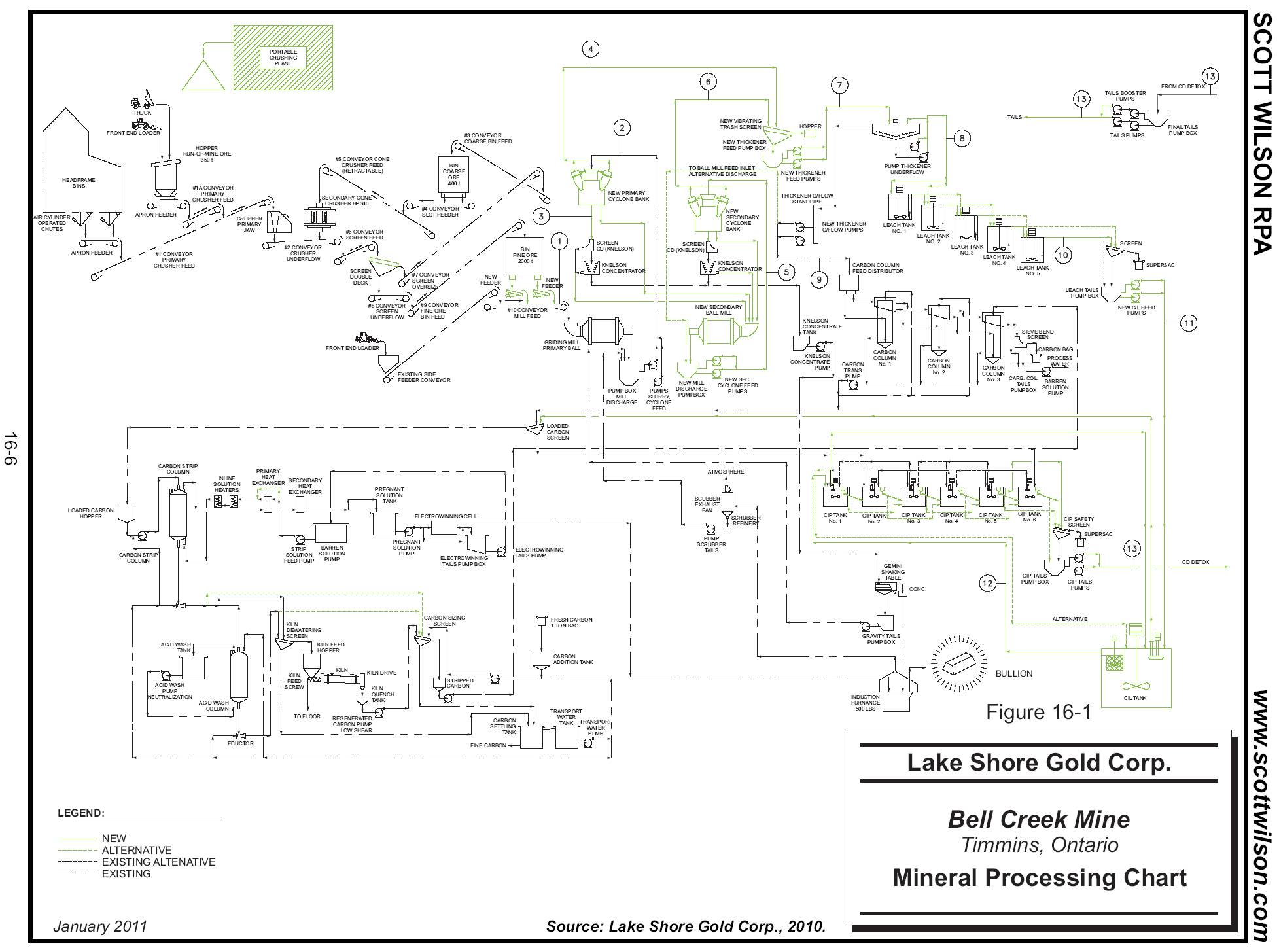
17 MINERAL RESOURCE AND MINERAL
RESERVE ESTIMATES
SUMMARY
Scott Wilson RPA carried out an audit of the grade-block model developed by Lake Shore Gold for the gold mineralization at the Bell Creek Mine, and subsequently prepared a Mineral Resource estimate for the North A, North A2, North B, North B2, North A3, and North A Extension domains using the supplied grade-block model.
Table 17-1 summarizes the Scott Wilson RPA Mineral Resource estimates at a cut-off grade of 2.2 g/t Au. Based on the density of drilling, observed continuity of the gold mineralization, and results from a variography study, Scott Wilson RPA has classified the Mineral Resources into the Measured, Indicated, and Inferred categories.
TABLE 17-1 ESTIMATED MINERAL RESOURCE BY DOMAIN AS AT
NOVEMBER 2010
Lake Shore Gold Corp. — Bell Creek Deposit
Category | | Tonnes | | Capped Grade
(g/t Au) | | Oz Au | |
North A Domain | |
Measured | | 375,000 | | 4.49 | | 54,200 | |
Indicated | | 960,000 | | 4.86 | | 149,800 | |
Sub-total, M&I | | 1,335,000 | | 4.75 | | 204,000 | |
| | | | | | | |
Inferred | | 4,462,000 | | 4.55 | | 653,000 | |
North A2 Domain | |
Measured | | — | | 0.00 | | — | |
Indicated | | 44,000 | | 2.95 | | 4,200 | |
Sub-total, M&I | | 44,000 | | 2.95 | | 4,200 | |
Inferred | | 1,728,000 | | 5.14 | | 285,400 | |
North B Domain | |
Measured | | — | | 0.00 | | — | |
Indicated | | 229,000 | | 3.05 | | 22,500 | |
Sub-total, M&I | | 229,000 | | 3.05 | | 22,500 | |
| | | | | | | |
Inferred | | 1,580,000 | | 3.48 | | 177,000 | |
17-1
Category | | Tonnes | | Capped Grade
(g/t Au) | | Oz Au | |
North A3 Domain | |
Measured | | — | | 0.00 | | — | |
Indicated | | 147,000 | | 3.24 | | 15,300 | |
Sub-total, M&I | | 147,000 | | 3.24 | | 15,300 | |
| | | | | | | |
Inferred | | 148,000 | | 2.84 | | 13,500 | |
North B2 Domain | |
Measured | | — | | 0.00 | | — | |
Indicated | | — | | 0.00 | | — | |
Sub-total, M&I | | — | | 0.00 | | — | |
Inferred | | 509,000 | | 3.92 | | 64,100 | |
North A Extension Domain | |
Measured | | 34,000 | | 4.65 | | 5,100 | |
Indicated | | — | | 0.00 | | — | |
Sub-total, M&I | | 34,000 | | 4.65 | | 5,100 | |
| | | | | | | |
Inferred | | — | | 0.00 | | — | |
GRAND TOTAL | |
Measured | | 410,000 | | 4.51 | | 59,300 | |
Indicated | | 1,380,000 | | 4.32 | | 191,800 | |
M & I | | 1,790,000 | | 4.36 | | 251,200 | |
| | | | | | | |
Inferred | | 8,427,000 | | 4.40 | | 1,192,900 | |
Notes:
1. CIM definitions were followed for classification of Mineral Resources.
2. Mineral Resources are estimated at a cut-off grade of 2.2 g/t Au.
3. Mineral Resources are estimated using an average long-term gold price of US$1,125 per ounce, and a US$/C$ exchange rate of 0.95.
4. A minimum mining width of two metres was used.
5. Capped gold grades are used in estimating the Mineral Resource average grade.
6. Sums may not add due to rounding.
7. Mr. Reno Pressacco, M.Sc.(A), P.Geo., is the Qualified Person for this resource estimate.
There are no Mineral Reserves present on the Bell Creek property as of the date of this Technical Report.
MINERAL RESOURCES
DESCRIPTION OF THE DATABASE
A digital database was provided to Scott Wilson RPA by Lake Shore Gold in which drill hole information such as collar location, downhole survey, lithology, and assays was
17-2
stored in comma delimited format. The cut-off date for the drill hole database is October 26, 2010. Drill hole information in this database includes both historical data, gathered by such prior operators as Canamax, and new drill holes completed by Lake Shore Gold in support of the preparation of this Mineral Resource estimate. In total, the database contains information for 726 drill holes as of the cut-off date. The drilling completed by both Canamax and Lake Shore Gold was carried out on the local Bell Creek geology grid coordinate system.
This drill hole information was modified slightly so as to be compatible with the format requirements of the Gemcom-Surpac v.6.1.4 mine planning software and was imported into that software package. A description of the revised database is provided in Table 17-2 and a plan view sketch showing the drill hole locations, existing mine workings, property boundaries, and mineralized domains is provided in Figure 17-1.
TABLE 17-2 SUMMARY OF THE DRILL HOLE DATABASE (AS AT
OCTOBER 26, 2010)
Lake Shore Gold Corp. — Bell Creek Deposit
Table Name | | Data Type | | Table Type | | No. of Records | |
assay_raw | | interval | | time-independent | | 42,466 | |
collar | | | | | | 726 | |
comps_1m | | interval | | time-independent | | 1,189 | |
litho | | interval | | time-independent | | 10,517 | |
styles | | | | | | 62 | |
survey | | | | | | 9,315 | |
17-3
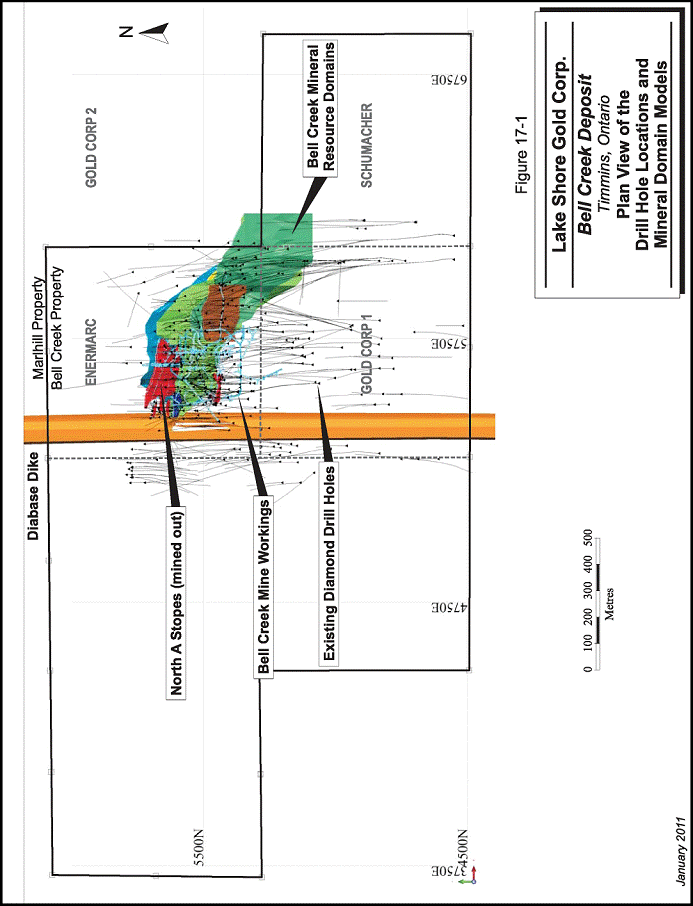
17-4
GEOLOGICAL DOMAIN INTERPRETATIONS
A description of the nature of the gold mineralization encountered by previous operators at the Bell Creek Mine has been presented by Pressacco (1999), and is excerpted below. It is important to bear in mind that the current price of gold is greater than that at the time of writing of either Kent or Pressacco.
Kent (1990) describes the Bell Creek Zone and the North Zone as:
Mineralization consists of two to ten percent pyrite and accessory arsenopyrite (typically 100-500 ppm As in ore), pyrrhotite, and chalcopyrite, although minor quartz veins are present. Roughly 90 percent of the gold is associated with the disseminated sulphides, which occur within highly altered quartz-carbonatesericite-sulphide zones up to 0.5 to seven metres in width. Erratic gold values occur in the quartz veinlets. These veinlets cut the altered rocks at all angles, especially in the hanging wall ultramafic unit. Non-auriferous veins surrounding the sulphide-carbonate gold zone generally occur as gash or en-echelon type structures.
The ore-grade mineralization occurs in pods or lenses not more than 100 metres in strike length and 200 metres vertical extent. The ore lenses appear to plunge steeply to the east. Multiple zones have been located along a strike length of one kilometre at or near the favourable Unit 1 — Unit 2A (ultramafic — basalt) contact. Active carbon occurs in some of the mineralized pods in the form of sheared graphitic interflow sediments and mining is not planned in these areas due to the deleterious effects of the carbon to the recovery of gold.
The North Zone consists of two sub-parallel, west-northwest-striking mineralized bands termed the “A”, in the south, and “B” in the north. The two zones are roughly 25 metres apart and dip at 70° to the south.
The mineralized portion of the “A” horizon consists of a quartz marker vein ten centimetres to two metres in width, and averages only 0.5 metres in width. The marker vein parallels the regional schistosity and crosscuts green, fragmental tuff, variolitic basalt, leucoxene-bearing basalt, and narrow beds of graphitic argillite. Bright green hydromuscovite occurs as fracture and slip coatings in the vein and platy, visible gold occurs with the mica. Tourmaline is fairly wide spread within the vein. The “A” zone contains the best gold values, averaging six to ten g/tonne over widths of two to ten metres. Surrounding the central quartz vein is a grey to buff coloured altered zone, which contains five to fifteen percent pyrite and pyrrhotite with accessory chalcopyrite and arsenopyrite. Up to 30 percent of the gold in the North “A” vein system occurs within the alteration halo, in discrete sulphide zones, in vein-brecciated wall rock zones which extend up to five metres from the margin of the core vein.
Gold mineralization in the North “B” zone has been noted in drill holes over a strike length of 100 metres. As in the “A” zone, gold occurs with sulphides in a quartz vein and in a quartz veinlet halo in the adjacent wall rock. Carbonate alteration of the wall rock is only weakly developed. Abundant graphite occurs in the
17-5
argillaceous host rocks. This zone has an average grade of 2.8 g/tonne across 4.4 metres and is considered to be sub-economic at this time.
The Lake Shore Gold drilling campaigns have intersected the down-dip and along-strike extensions of the North A and North B horizons as well as a number of additional zones of alteration and gold mineralization that sub-parallel these two main horizons. Examples of the variations in the styles of alteration and mineralization intersected in the North A horizon are presented in Figures 17-2, 17-3, and 17-4. It can be seen that the mineralization intersected along the down-dip and along-strike extensions closely resembles the style of mineralization that had been encountered by previous operators in the North A and North B zones. Consequently, Lake Shore Gold proceeded to construct a series of domain models of the various mineralized horizons that are consistent with the current geological understanding at Bell Creek. In all, six domains were created, five of which occur as a series of sub-parallel, east-west striking (az. 100°), steeply south-dipping (-70° to az. 180°) sheets (the North A, North A2, North A3, North B and North B2 domains). One domain (the North A Extension) is interpreted as a minor split or bifurcation of the North A domain, and is located immediately below the western limit of the lowermost level of the Bell Creek Mine.
FIGURE 17-2 VIEW OF THE ALTERATION AND MINERALIZATION IN THE
NORTH A DOMAIN, DRILL HOLE BC-09-53
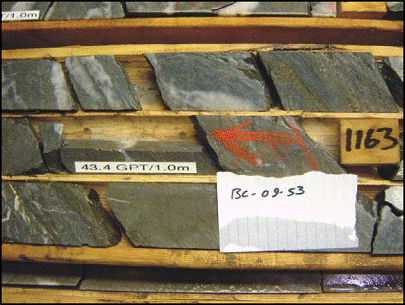
*1153.0-1167.4m: 12.67 g/t Au / 14.4 m core length (uncut)
17-6
FIGURE 17-3 VIEW OF THE ALTERATION AND MINERALIZATION IN THE
NORTH A DOMAIN, DRILL HOLE BC-09-69A
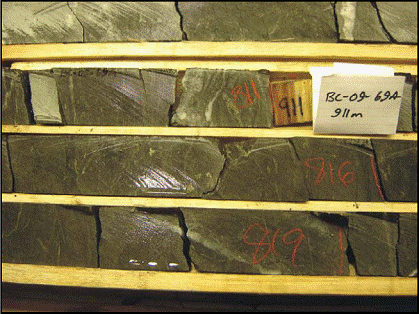
*909.0-912.5m: 6.21 g/t Au / 3.5 m core length (uncut)
FIGURE 17-4 VIEW OF THE ALTERATION AND MINERALIZATION IN THE
NORTH A DOMAIN, DRILL HOLE BC-09-77
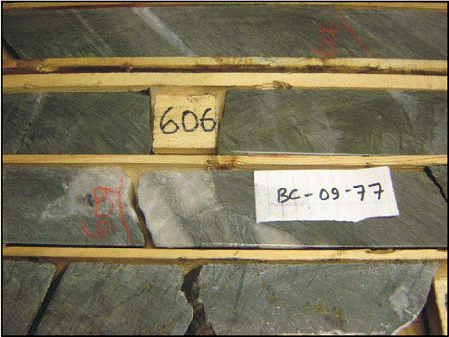
*604.8-619.5m: 6.13 g/t Au / 14.7 m core length (uncut)
17-7
For the most part, the six mineralized zones are hosted by altered metavolcanic flows of either mafic or ultramafic composition.
Interpretation of the geological and mineralization features associated with the Bell Creek gold deposit was carried out by Ralph Koch, Chief Geologist, Bell Creek Mine, according to the most current understanding and level of knowledge. The interpretation was reviewed by Reno Pressacco, Senior Consulting Geologist, Scott Wilson RPA, for accuracy and validity in light of the current understanding of the mineralization controls and geometries. Interpretation of the position of the Bell Creek mineralized domains was carried out on approximately 50 cross sections oriented in a north-south direction and arranged at a spacing of either 12.5 m (± 6.25 m viewing window) or 25 m (± 12.5 m viewing window) between sections. The locations of the domain contacts were “snapped” to the observed contacts in the individual drill holes such that the sectional interpretations “wobbled” in three-dimensional space, to either side of the section plane. Following completion of the solid model of the North A domain, a separate clipping polygon was created to exclude those parts of the domain model located in and about the existing mine workings, so that no part of the estimated Mineral Resources fall within the area of the previous mine workings.
Overall, gold mineralization in the six domain models has been defined from surface to a vertical depth of 1,200 m and along a strike length of approximately 700 m. The depth extensions of the gold mineralization have not been defined by drilling. The western limit of the domain models has been set as the eastern contact of a north-south striking diabase dike and the eastern limit of the mineralization has not been defined by drilling. Additional gold mineralization is known to be present to the west of the diabase dike, however, the focus of the exploration completed to date has been to the east of this dike. Longitudinal and sectional views of the mineralized domains are presented in Figures 17-5 and 17-6, respectively.
17-8
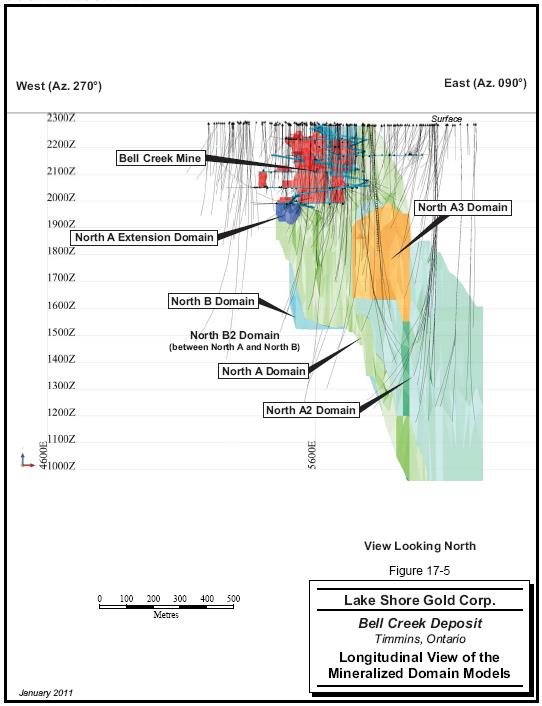
17-9
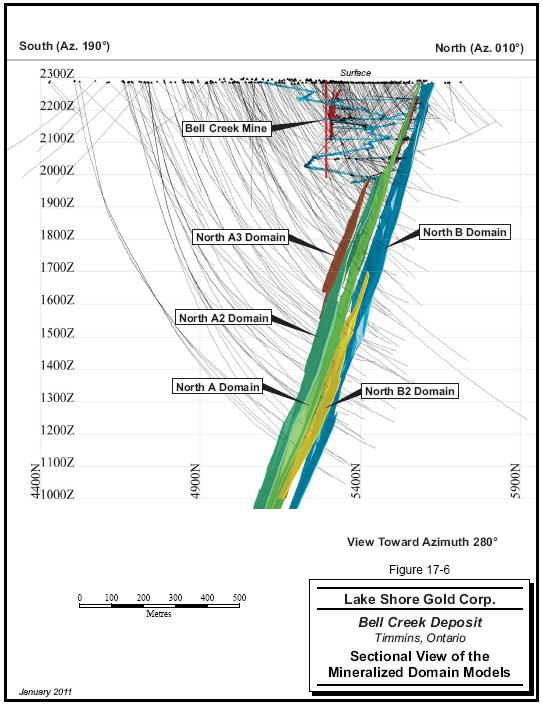
17-10
HISTORICAL MINE WORKINGS
According to information presented in Pressacco (1999), North A Horizon was achieved via a three compartment, timbered vertical shaft to the -60 m, -120 m, -180 m, and -240 m levels, and by a ramp from the -240 m to the -300 m level. Access to the Bell West Zone is provided by the —60 m, -120 m, and —180 m levels. The current shaft bottom is at a depth of 280 m. A central pillar is established from surface to the -240 m level on section 5650 East. A digital model of the underground workings and voids was prepared by previous operators using all available survey information at the time.
A description of the current work being carried out by Lake Shore Gold at the Bell Creek Mine is excerpted from information provided on the Lake shore Gold web site below (Lake Shore Gold, 2010):
On April 28, 2009, the Company announced that it had received the required approvals to commence an advanced exploration program at the Bell Creek Complex, which has included de-watering and rehabilitating the existing Bell Creek Mine shaft and workings and collaring a ramp at Bell Creek to be connected to the Bell Creek mine workings.
As of August 9, 2010, the Bell Creek shaft and workings from previous mining had been de-watered to a depth of 255 metres with the remaining 37 metres to shaft bottom being used as a sump. Slashing of the original shaft ramp from the 240 to the 300 Level was completed in July. The main ramp from surface at Bell Creek has advanced to a vertical depth of 240 metres and, in June, was connected to the 240 shaft ramp, providing a continuous connection from surface to the 300 metre level. The primary ventilation system design required for mining below the 300 level was completed during the first quarter of 2010 and raise boring in support of this program began on June 1, 2010 with the first phase completed by late July. On September 20, 2010, the Company announced that the new access ramp being developed from surface at the Bell Creek Mine has reached the 320 Level and intersected high-grade mineralization in the North A Zone with a development cross cut. The Company also announced that it had commenced development east and west along mineralization on the North A Zone.
In preparation of the Mineral Resource estimate, the digital model of the existing mine workings was used as a guide in understanding the distribution of the newly discovered gold mineralization. No Mineral Resources for the North A Horizon as estimated in this report are located within the volume of the historical mine workings.
17-11
GRADE CAPPING
In Scott Wilson RPA’s experience, the influence of high grade assays must be addressed during the preparation of a Mineral Resource estimate, as many instances have occurred in the industry where the average grade of a deposit has been overestimated due to the typically limited continuity of such high grade values. Several methods are currently in common use by industry practitioners and include grade capping (also known as top cutting), restricting the influence of high grade assays during the estimation of block grades, or Indicator Kriging methods. Scott Wilson RPA believes that application of a grade cap is an appropriate approach for this assignment to deal with high grade assay values in order to prevent undue bias in the average grade of the Mineral Resource estimate.
All samples contained within the six three-dimensional domain solids were coded in the database and extracted for analysis. Normal histograms were generated from this extraction file (Figures 17-7 through 17-12, inclusive) and the descriptive statistics of the sample data sets are presented in Table 17-3. The grade caps were selected by examining the histogram for the grade at which outlier assays begin to occur. These are generally identified by breaks in slope of the probability plots or gaps in the bins of histograms. As can be seen, Lake Shore Gold applied a constant capping value of 34 g/t Au (approximately 1 oz/st Au), which is the historical capping value that has been applied to the deposits in the Timmins Camp over the past 100 years, to the assays for all six domains. The data suggests, however, that a future refinement could include the application of separate capping values to each domain.
Scott Wilson RPA conducted a capping sensitivity analysis for each of the domains separately and found that five of the six domains were relatively insensitive to capping level changes. These five domains host most of the Mineral Resources estimated at Bell Creek. Scott Wilson RPA does recommend, however, that continued studies, in conjunction with accurate reconciliation studies, be carried out in the future to refine the capping level estimates.
17-12
FIGURE 17-7 NORMAL HISTOGRAM OF RAW GOLD ASSAYS CONTAINED
WITHIN THE NORTH A DOMAIN
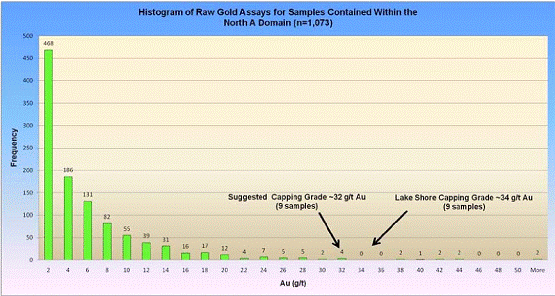
FIGURE 17-8 NORMAL HISTOGRAM OF RAW GOLD ASSAYS CONTAINED WITHIN THE NORTH A2 DOMAIN
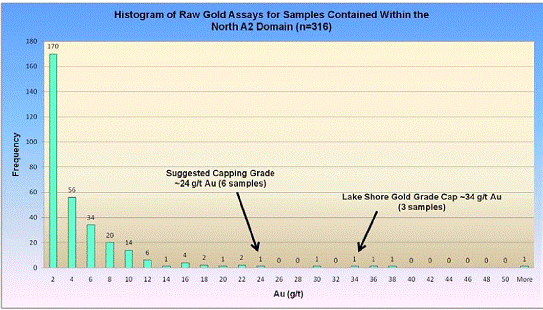
17-13
FIGURE 17-9 NORMAL HISTOGRAM OF RAW GOLD ASSAYS CONTAINED
WITHIN THE NORTH B DOMAIN
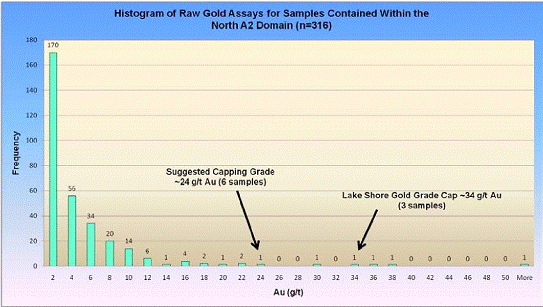
FIGURE 17-10 NORMAL HISTOGRAM OF RAW GOLD ASSAYS
CONTAINED WITHIN THE NORTH B2 DOMAIN

17-14
FIGURE 17-11 NORMAL HISTOGRAM OF RAW GOLD ASSAYS
CONTAINED WITHIN THE NORTH A3 DOMAIN
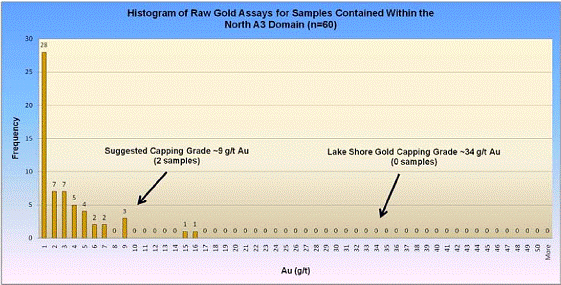
FIGURE 17-12 NORMAL HISTOGRAM OF RAW GOLD ASSAYS
CONTAINED WITHIN THE NORTH A EXTENSION DOMAIN
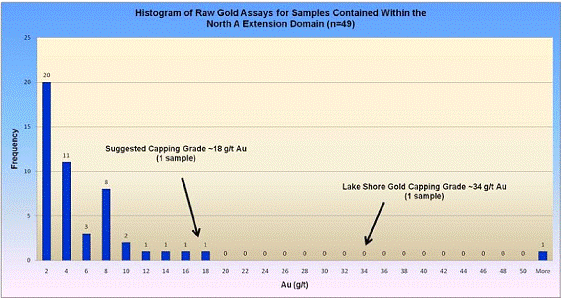
17-15
TABLE 17-3 DESCRIPTIVE STATISTICS OF THE RAW ASSAYS CONTAINED WITHIN THE MINERALIZED DOMAINS
Lake Shore Gold Corp. – Bell Creek Deposit
| | | | | | | | | | | North | | | | | | | North | | | | | | | North A | | | |
Raw Assay Statistics - | | | | North A | | | | | | | A2 | | | | | | | A3 | | | | | | | Extension | | | |
North A Zone | | Raw | | Cap 34 | | Cap 32 | | | Raw | | Cap 34 | | Cap 24 | | | Raw | | Cap 34 | | Cap 9 | | | Raw | | Cap 34 | | Cap 18 | |
Arithmetic Mean | | 5.14 | | 4.85 | | 4.84 | | | 3.64 | | 3.52 | | 3.42 | | | 2.52 | | 2.52 | | 2.32 | | | 5.27 | | 4.80 | | 4.46 | |
Length-Weighted Mean | | 4.52 | | 4.41 | | 4.40 | | | 3.68 | | 3.49 | | 3.36 | | | 2.15 | | 2.15 | | 1.89 | | | 5.06 | | 4.74 | | 4.50 | |
Standard Error | | 0.28 | | 0.19 | | 0.19 | | | 0.33 | | 0.29 | | 0.26 | | | 0.42 | | 0.42 | | 0.34 | | | 1.25 | | 0.87 | | 0.66 | |
Median | | 2.75 | | 2.75 | | 2.75 | | | 1.73 | | 1.73 | | 1.73 | | | 1.33 | | 1.33 | | 1.33 | | | 2.57 | | 2.57 | | 2.57 | |
Mode | | 0.01 | | 0.01 | | 0.01 | | | 0.03 | | 0.03 | | 24.00 | | | 3.33 | | 3.33 | | 3.33 | | | 2.57 | | 2.57 | | 2.57 | |
Standard Deviation | | 9.27 | | 6.12 | | 6.04 | | | 5.89 | | 5.18 | | 4.69 | | | 3.27 | | 3.27 | | 2.61 | | | 8.56 | | 5.95 | | 4.53 | |
Coefficient of Variation- Arithmetic | | 1.80 | | 1.26 | | 1.25 | | | 1.62 | | 1.47 | | 1.37 | | | 1.30 | | 1.30 | | 1.12 | | | 1.63 | | 1.24 | | 1.01 | |
Coefficient of Variation- Weighted | | 2.05 | | 1.39 | | 1.37 | | | 1.60 | | 1.48 | | 1.39 | | | 1.52 | | 1.52 | | 1.38 | | | 1.69 | | 1.25 | | 1.01 | |
Sample Variance | | 85.91 | | 37.42 | | 36.46 | | | 34.64 | | 26.84 | | 21.98 | | | 10.68 | | 10.68 | | 6.83 | | | 73.35 | | 35.36 | | 20.50 | |
Kurtosis | | 161.52 | | 6.04 | | 5.39 | | | 23.52 | | 12.90 | | 7.11 | | | 5.62 | | 5.62 | | 0.64 | | | 27.23 | | 12.17 | | 1.95 | |
Skewness | | 10.14 | | 2.25 | | 2.17 | | | 4.13 | | 3.17 | | 2.50 | | | 2.18 | | 2.18 | | 1.24 | | | 4.75 | | 2.99 | | 1.48 | |
Range | | 171.93 | | 34.00 | | 32.00 | | | 52.80 | | 34.00 | | 24.00 | | | 15.64 | | 15.64 | | 8.99 | | | 55.88 | | 33.99 | | 17.99 | |
Minimum | | 0.00 | | 0.00 | | 0.00 | | | 0.00 | | 0.00 | | 0.00 | | | 0.01 | | 0.01 | | 0.01 | | | 0.01 | | 0.01 | | 0.01 | |
Maximum | | 171.93 | | 34.00 | | 32.00 | | | 52.80 | | 34.00 | | 24.00 | | | 15.65 | | 15.65 | | 9.00 | | | 55.89 | | 34.00 | | 18.00 | |
Sum | | 5,443.21 | | 5,139.36 | | 5,121.36 | | | 1,148.95 | | 1,111.65 | | 1,081.65 | | | 151.34 | | 151.34 | | 139.49 | | | 247.64 | | 225.75 | | 209.75 | |
| | | | | | | | | | | | | | | | | | | | | | | | | | | | |
Count | | 1,059 | | 1,059 | | 1,059 | | | 316 | | 316 | | 316 | | | 60 | | 60 | | 60 | | | 47 | | 47 | | 47 | |
17-16
| | | | | | | | | | | North | | | |
Raw Assay Statistics - | | | | North B | | | | | | | B2 | | | |
North B Zone | | Raw | | Cap 34 | | Cap 20 | | | Raw | | Cap 34 | | Cap 18 | |
Arithmetic Mean | | 2.43 | | 2.40 | | 2.37 | | | 3.15 | | 3.15 | | 3.11 | |
Length-Weighted Mean | | 2.20 | | 2.19 | | 2.17 | | | 2.77 | | 2.77 | | 2.75 | |
Standard Error | | 0.16 | | 0.15 | | 0.14 | | | 0.38 | | 0.38 | | 0.36 | |
Median | | 1.43 | | 1.43 | | 1.43 | | | 2.05 | | 2.05 | | 2.05 | |
Mode | | 0.10 | | 0.10 | | 0.10 | | | 5.87 | | 5.87 | | 5.87 | |
Standard Deviation | | 3.61 | | 3.32 | | 3.09 | | | 3.99 | | 3.99 | | 3.79 | |
Coefficient of Variation- Arithmetic | | 1.48 | | 1.38 | | 1.30 | | | 1.26 | | 1.26 | | 1.22 | |
Coefficient of Variation- Weighted | | 1.64 | | 1.52 | | 1.43 | | | 1.44 | | 1.44 | | 1.38 | |
Sample Variance | | 13.01 | | 11.01 | | 9.57 | | | 15.90 | | 15.90 | | 14.33 | |
Kurtosis | | 49.54 | | 21.20 | | 8.28 | | | 6.81 | | 6.81 | | 4.28 | |
Skewness | | 5.18 | | 3.53 | | 2.53 | | | 2.35 | | 2.35 | | 2.02 | |
Range | | 46.62 | | 34.00 | | 20.00 | | | 22.85 | | 22.85 | | 18.00 | |
Minimum | | 0.00 | | 0.00 | | 0.00 | | | 0.01 | | 0.01 | | 0.01 | |
Maximum | | 46.62 | | 34.00 | | 20.00 | | | 22.85 | | 22.85 | | 18.00 | |
Sum | | 1,164.10 | | 1,151.48 | | 1,137.48 | | | 340.52 | | 340.52 | | 335.67 | |
| | �� | | | | | | | | | | | | |
Count | | 479 | | 479 | | 479 | | | 108 | | 108 | | 108 | |
17-17
COMPOSITING METHODS
All samples contained within the six domain models were composited using the fixed-length method. In this method, the composite sample lengths for a given drill hole intersection are adjusted to yield a set of equal length composite samples across the width of a mineralized zone. By comparison, the traditional method of applying a constant composite sample length down hole along the length of the drill hole (e.g., 1.5 m) typically results in one sample along the footwall contact which is not a full length sample. Scott Wilson RPA believes that the fixed-length method is appropriate for this style of mineralization. Comparisons of the raw gold values versus sample lengths and average composite lengths for each of the six domains are provided in Figures 17-13 through 17-18. A comparison of the descriptive statistics for the capped and uncapped composited gold assays for the six domains is presented in Table 17-4.
FIGURE 17-13 COMPARISON OF RAW GOLD ASSAYS VS. SAMPLE
LENGTH, NORTH A DOMAIN
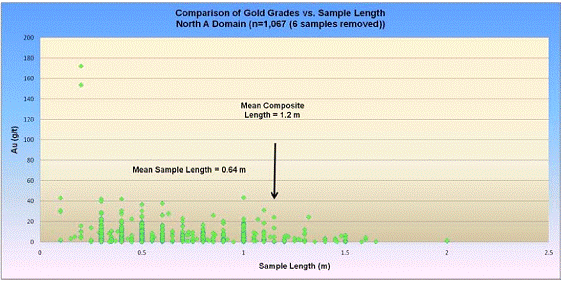
17-18
FIGURE 17-14 COMPARISON OF RAW GOLD ASSAYS VS. SAMPLE
LENGTH, NORTH A2 DOMAIN
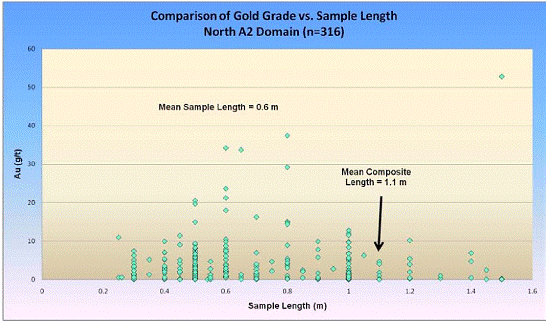
FIGURE 17-15 COMPARISON OF RAW GOLD ASSAYS VS. SAMPLE
LENGTH, NORTH B DOMAIN
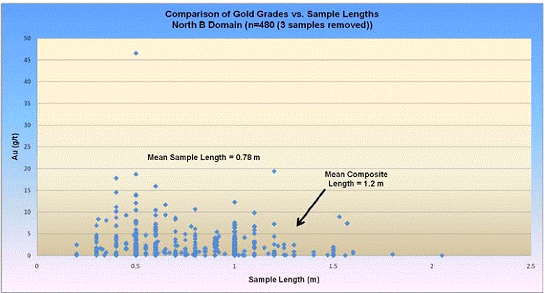
17-19
FIGURE 17-16 COMPARISON OF RAW GOLD ASSAYS VS. SAMPLE
LENGTH, NORTH B2 DOMAIN
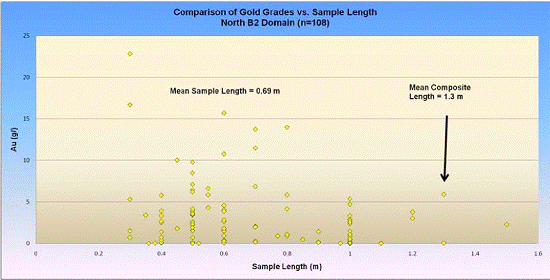
FIGURE 17-17 COMPARISON OF RAW GOLD ASSAYS VS. SAMPLE
LENGTH, NORTH A3 DOMAIN
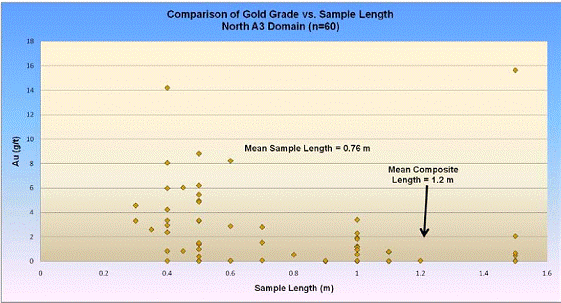
17-20
FIGURE 17-18 COMPARISON OF RAW GOLD ASSAYS VS. SAMPLE
LENGTH, NORTH A EXTENSION DOMAIN
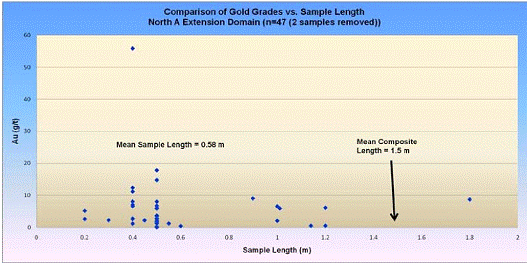
17-21
TABLE 17-4 DESCRIPTIVE STATISTICS OF THE CAPPED AND UNCAPPED COMPOSITE ASSAYS
CONTAINED WITHIN THE MINERALIZED DOMAINS
Lake Shore Gold Corp. – Bell Creek Deposit
| | | | | | | | | North | | | | | North | | | | | North A | |
| | | | North A | | | | | A2 | | | | | A3 | | | | | Extension | |
Composite Assay Statistics - North A Zone | | Raw | | Cap 34 | | | Raw | | Cap 34 | | | Raw | | Cap 34 | | | Raw | | Cap 34 | |
Arithmetic Mean | | 4.54 | | 4.44 | | | 4.04 | | 3.87 | | | 2.21 | | 2.21 | | | 5.00 | | 4.65 | |
Length-Weighted Mean | | 4.52 | | 4.42 | | | 3.95 | | 3.80 | | | 2.35 | | 2.35 | | | 5.04 | | 4.72 | |
Standard Error | | 0.21 | | 0.19 | | | 0.45 | | 0.37 | | | 0.42 | | 0.42 | | | 1.07 | | 0.86 | |
Median | | 3.22 | | 3.22 | | | 2.24 | | 2.24 | | | 1.58 | | 1.58 | | | 4.04 | | 4.04 | |
Mode | | 0.01 | | 0.01 | | | 1.72 | | 1.72 | | | N/A | | N/A | | | N/A | | N/A | |
Standard Deviation | | 5.08 | | 4.60 | | | 6.00 | | 5.02 | | | 2.41 | | 2.41 | | | 4.52 | | 3.67 | |
Coefficient of Variation-Arithmetic | | 1.12 | | 1.04 | | | 1.48 | | 1.30 | | | 1.09 | | 1.09 | | | 0.91 | | 0.79 | |
Coefficient of Variation-Weighted | | 1.12 | | 1.04 | | | 1.52 | | 1.32 | | | 1.02 | | 1.02 | | | 0.90 | | 0.78 | |
Sample Variance | | 25.83 | | 21.17 | | | 35.95 | | 25.23 | | | 5.82 | | 5.82 | | | 20.46 | | 13.43 | |
Kurtosis | | 15.66 | | 3.77 | | | 27.90 | | 12.91 | | | 10.34 | | 10.34 | | | 2.31 | | -0.24 | |
Skewness | | 2.88 | | 1.80 | | | 4.48 | | 3.17 | | | 2.77 | | 2.77 | | | 1.42 | | 0.70 | |
Range | | 52.32 | | 25.13 | | | 52.77 | | 33.97 | | | 12.63 | | 12.63 | | | 17.36 | | 12.27 | |
Minimum | | 0.00 | | 0.00 | | | 0.03 | | 0.03 | | | 0.01 | | 0.01 | | | 0.13 | | 0.13 | |
Maximum | | 52.32 | | 25.13 | | | 52.80 | | 34.00 | | | 12.64 | | 12.64 | | | 17.49 | | 12.40 | |
Sum | | 2,763.25 | | 2,705.21 | | | 727.03 | | 696.74 | | | 72.95 | | 72.95 | | | 89.96 | | 83.70 | |
| | | | | | | | | | | | | | | | | | | | |
Count | | 609 | | 609 | | | 180 | | 180 | | | 33 | | 33 | | | 18 | | 18 | |
17-22
| | | | | | | | | North | |
| | | | North B | | | | | B2 | |
Composite Assay Statistics - North B Zone | | Raw | | Cap 34 | | | Raw | | Cap 34 | |
Arithmetic Mean | | 2.32 | | 2.25 | | | 3.14 | | 3.14 | |
Length-Weighted Mean | | 2.32 | | 2.25 | | | 2.93 | | 2.93 | |
Standard Error | | 0.16 | | 0.13 | | | 0.40 | | 0.40 | |
Median | | 1.62 | | 1.62 | | | 2.33 | | 2.33 | |
Mode | | 0.03 | | 0.03 | | | N/A | | N/A | |
Standard Deviation | | 2.93 | | 2.45 | | | 2.98 | | 2.98 | |
Coefficient of Variation-Arithmetic | | 1.26 | | 1.09 | | | 0.95 | | 0.95 | |
Coefficient of Variation-Weighted | | 1.26 | | 1.09 | | | 1.02 | | 1.02 | |
Sample Variance | | 8.58 | | 6.02 | | | 8.90 | | 8.90 | |
Kurtosis | | 33.93 | | 11.09 | | | 1.56 | | 1.56 | |
Skewness | | 4.59 | | 2.66 | | | 1.43 | | 1.43 | |
Range | | 30.91 | | 19.41 | | | 12.14 | | 12.14 | |
Minimum | | 0.00 | | 0.00 | | | 0.01 | | 0.01 | |
Maximum | | 30.91 | | 19.41 | | | 12.15 | | 12.15 | |
Sum | | 786.642 | | 763.58 | | | 172.60 | | 172.60 | |
| | | | | | | | | | |
Count | | 339 | | 339 | | | 55 | | 55 | |
17-23
BULK DENSITY
Scott Wilson RPA has carried out a small program of bulk density measurements on samples of the Bell Creek mineralized material taken from the remaining historical drill core. A total of 15 samples of drill core were selected from a drill hole in the North A domain and shipped to the Acme facility located in Vancouver, British Columbia. The bulk densities of the samples were determined using Acme’s G8SG method based on water displacement. The numeric results are presented in Table 17-5 and are graphically illustrated in Figure 17-19.
Based on this data set, an average bulk density is 2.82 tonnes/m3. Such a small density data set is useful for providing an indication of the density of the mineralized material only and Scott Wilson RPA recommends that additional density readings be determined for all six of the mineralized domains in a systematic manner.
TABLE 17-5 BULK DENSITY RESULTS
Lake Shore Gold Corp. — Bell Creek Deposit
Drill Hole | | Sample | | Type | | From | | To | | Au (g/t) | | Lithology | | Density | |
BC-09-69A | | H544809 | | Drill Core | | 909.0 | | 909.7 | | 3.81 | | MVOL | | 2.90 | |
BC-09-69A | | H544810 | | Drill Core | | 909.7 | | 910.4 | | 5.60 | | MVOL | | 2.95 | |
BC-09-69A | | H544811 | | Drill Core | | 910.4 | | 911.0 | | 10.45 | | MVOL | | 3.72 | |
BC-09-69A | | H544812 | | Drill Core | | 911.0 | | 911.6 | | 8.45 | | MVOL | | 2.83 | |
BC-09-69A | | H544814 | | Drill Core | | 911.6 | | 912.0 | | 6.37 | | MVOL | | 2.70 | |
BC-09-69A | | H544816 | | Drill Core | | 912.0 | | 912.5 | | 2.27 | | MVOL | | 2.82 | |
BC-09-69A | | H544817 | | Drill Core | | 912.5 | | 913.0 | | 0.97 | | MVOL | | 2.84 | |
BC-09-69A | | H544818 | | Drill Core | | 913.0 | | 913.5 | | 0.32 | | MVOL | | 2.93 | |
BC-09-69A | | H544819 | | Drill Core | | 913.5 | | 913.9 | | 1.97 | | MVOL | | 2.77 | |
BC-09-69A | | H544820 | | Drill Core | | 913.9 | | 914.2 | | 0.75 | | MVOL | | 2.82 | |
BC-09-69A | | H544821 | | Drill Core | | 914.2 | | 914.7 | | 1.18 | | MVOL | | 2.82 | |
BC-09-69A | | H544822 | | Drill Core | | 914.7 | | 914.9 | | 0.90 | | MVOL | | 2.75 | |
BC-09-69A | | H544823 | | Drill Core | | 914.9 | | 915.4 | | 2.64 | | MVOL | | 2.76 | |
BC-09-69A | | H544824 | | Drill Core | | 915.4 | | 916.3 | | 1.56 | | MVOL | | 2.77 | |
BC-09-69A | | H544825 | | Drill Core | | 916.3 | | 917.0 | | 0.50 | | MVOL | | 2.77 | |
17-24
FIGURE 17-19 HISTOGRAM OF BULK DENSITY RESULTS
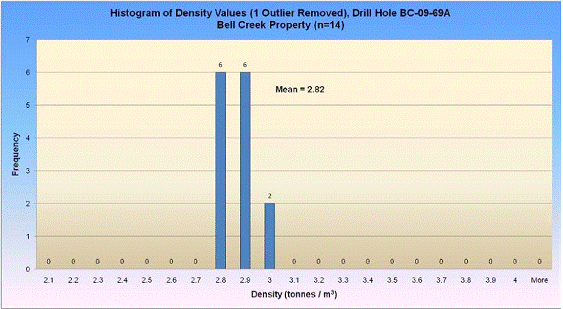
TREND ANALYSIS
As an aid in carrying out variography studies of the continuity of the gold grades in the six mineralized domain models, Scott Wilson RPA conducted a short study of the overall trends that may be present within each of these domains. For this exercise, a data file was prepared that contained the average gold grade across the entire width of the mineralized vein for each drill hole that pierced each of the six domain models. The resulting gold grades were hand-contoured on a longitudinal projection and the results are shown in Figures 17-20 through 17-25.
17-25
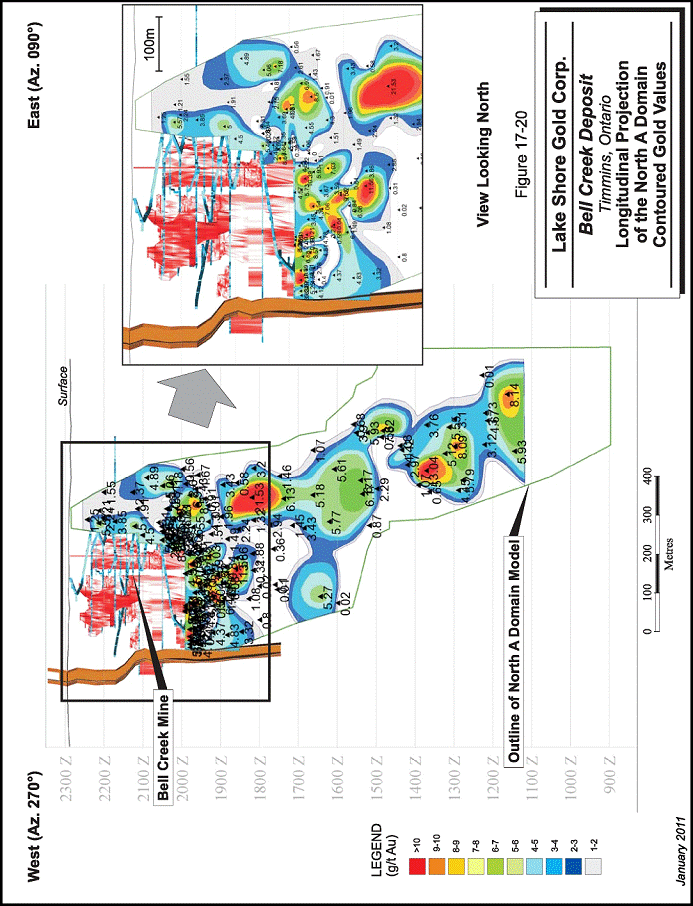
17-26
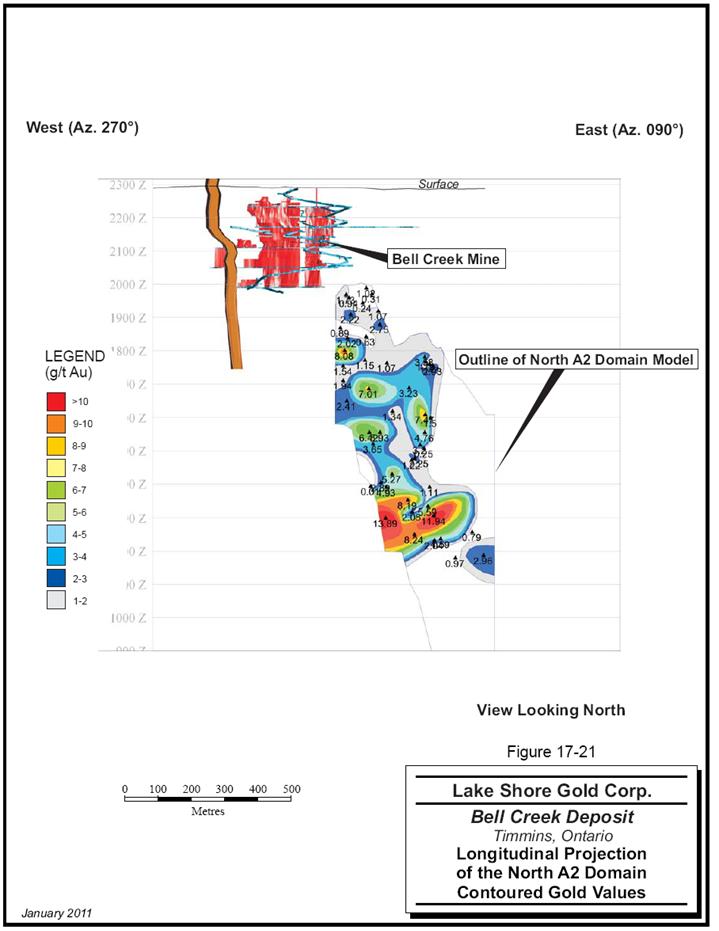
17-27
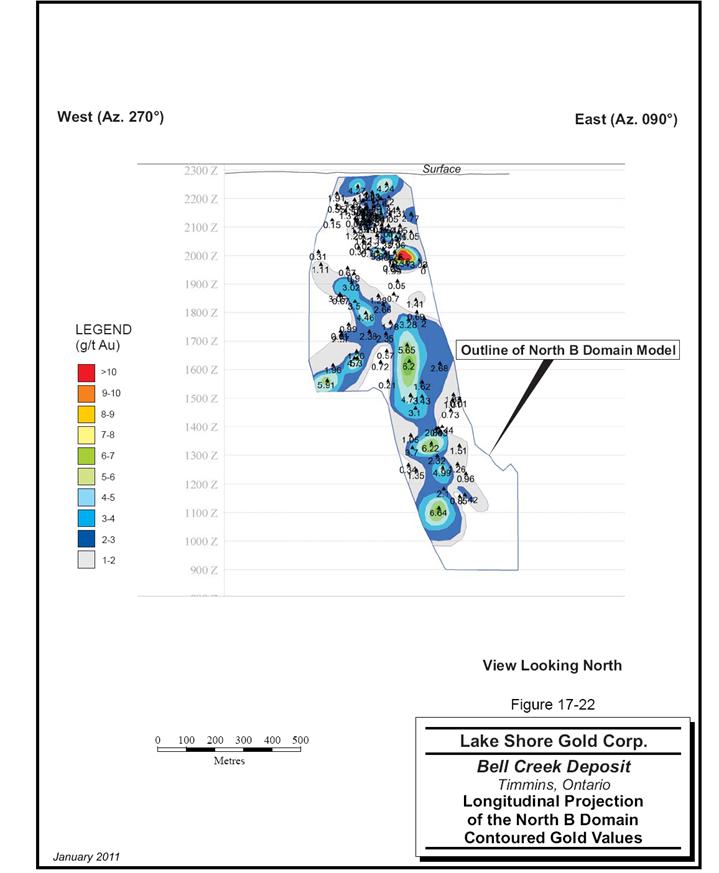
17-28
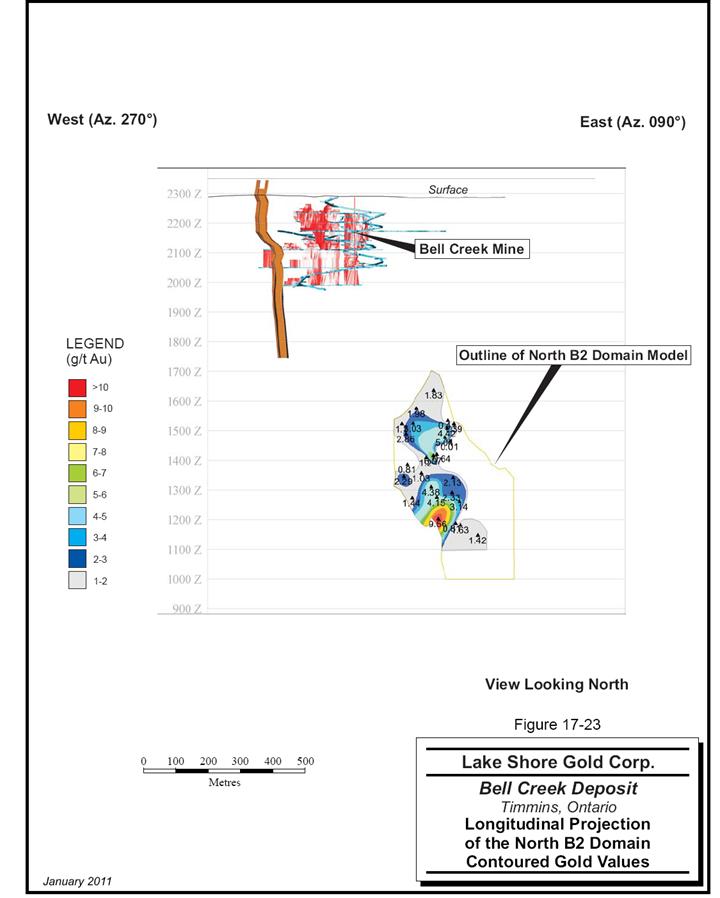
17-29
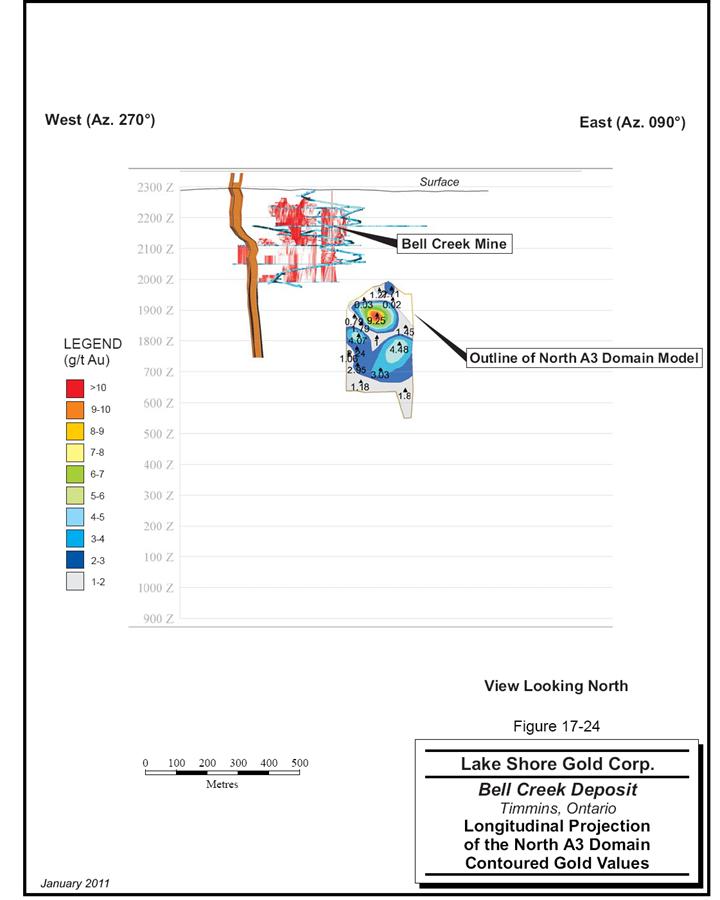
17-30
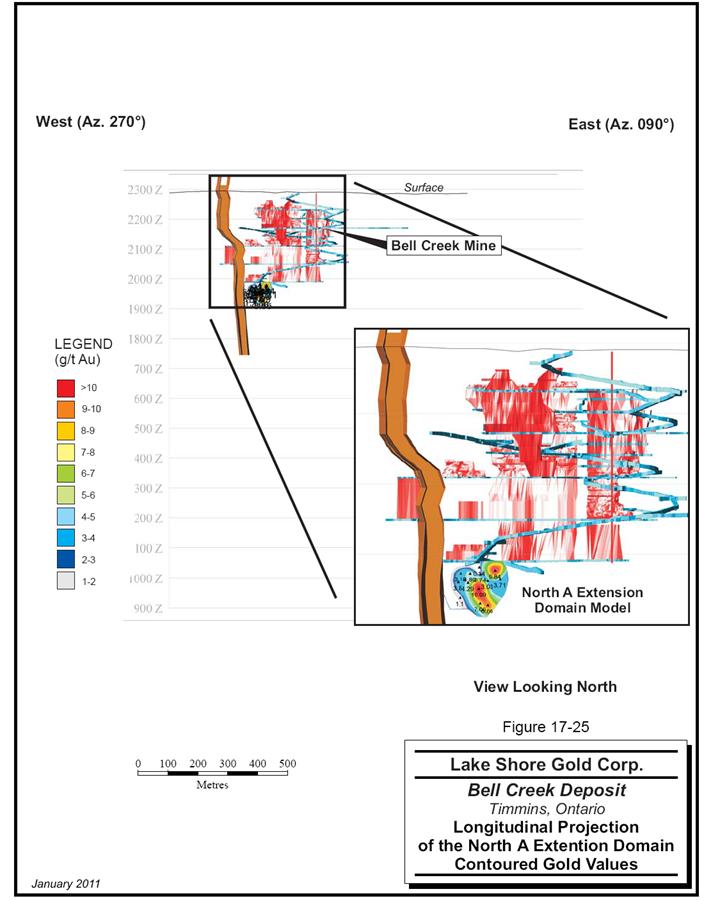
17-31
By their nature, hand-contoured plots are subjective interpretations of the continuity of gold mineralization between adjacent observation points. The accuracy of the contouring is a function of the level of information density and personal skill and experience. While Figures 17-20 to 17-25 present the current understanding of the distribution of the gold values within each of the six domains, alternate interpretations are always possible and the interpretation will likely change as more detailed information becomes available.
Examination of the contour plots presented above suggests that, in general terms, the gold mineralization for the North A, North A2, North B, and North B2 domains generally follows an overall steep plunge to the south, with a slight rake of perhaps 10° to 20° from vertical to the east. Within these larger, steeply plunging, steeply east-raking zones, sub-zones of higher grades are suggested in areas with higher drill hole density. The limited information available at this time suggests that these sub-zones plunge moderately to shallowly to the west, and may represent the intersection lineations of two mineralizing structures, dilational flexures, or the influence of a yet unrecognized structural control on the gold distribution.
VARIOGRAPHY
Scott Wilson RPA constructed downhole and omnidirectional variograms using the capped, equal length composited sample data for domains having larger drill hole data sets, with the objective of determining an appropriate value for the global nugget (C0). The evaluation of any anisotropies that may be present in the data resulted in successful variograms for the down-plunge direction for the North A and North B domains with reasonably good model fits that identified maximum ranges of approximately 30 m to 40 m. Efforts to identify the anisotropies associated with the North A2 domain were not successful. Efforts to identify the anisotropies for the remaining three domains did not produce meaningful variograms due to the limited number of data pairs. A summary of the variographic parameters derived for the North A and North B domains is presented in Table 17-6, and the variograms are presented in Appendix I.
17-32
TABLE 17-6 SUMMARY OF VARIOGRAPHY RESULTS
Lake Shore Gold Corp. — Bell Creek Deposit
Item | | North A Domain (D6) | | North B Domain (D6) |
Variogram Type | | Spherical | | Spherical |
Nugget (Downhole) | | 6.75 | | 0.54 |
Sill (C1-Downhole) | | 22.2 (12m) | | 6.00 (6m) |
Sill (C2-Downhole) | | | | |
| | | | |
Nugget (OmniDirectional) | | 7.37 | | 3.07 |
Sill (C1-OmniDirectional) | | 22.0 (9m) | | 4.45 (6m) |
Sill (C2-OmniDirectional) | | | | |
| | | | |
Anisotropies: | | | | *Trimmed to 15 g/t Au |
Direction | | Down Plunge: | | Down Plunge: |
Orientation | | + 45°@290 (30° Ang. Tol.) | | -70°@180 (45° Ang. Tol.) |
Sill (C1) | | C1 = 13.04 | | C1 = 5.18 |
Range (m) | | Range = 31m | | Range = 40m |
| | | | |
Direction | | Across Plunge: | | Along Strike: |
Orientation | | -60° @ 230 (30° Ang. Tol.) | | 0° @ 090 (45° Ang. Tol.) |
Sill (C1) | | C1 = 11.95 | | C1 = 4.78 |
Range (m) | | Range = 32m | | Range = 24m |
| | | | |
Direction | | Across Dip: | | Across Dip: |
Orientation | | -20@0 (30° Angular Tol.) | | -20@0 (30° Angular Tol.) |
Sill (C1) | | C1 = 43.49 | | C1 = 9.97 |
Range (m) | | Range = 21m | | Range = 5m |
BLOCK MODEL CONSTRUCTION
An upright, non-rotated, partial percentage block model (i.e., the percentage of any block that is contained within the domain model is used to weight the volume and tonnage reports) with the long axis of the blocks oriented along an azimuth of 090º (Figure 17-11) and dipping vertically (i.e., -90°) was constructed using the GEMS v.6.2.3 software package and the parameters presented in Table 17-7. The selected block sizes were 2 m x 3 m x 3 m (width, length, height). A number of attributes were also created to store such information as metal grades, distances to and the number of informing samples, domain codes, resource classification codes, and claim owners. A listing of these attributes is presented in Table 17-8.
17-33
TABLE 17-7 SUMMARY OF BLOCK MODEL LIMITS
Lake Shore Gold Corp. — Bell Creek Deposit
Type | | Y | | X | | Z | |
Minimum Coordinates | | 5050 | | 5400 | | 860 | |
Maximum Coordinates | | 5770 | | 6270 | | 2300 | |
User Block Size | | 2 | | 3 | | 3 | |
Min. Block Size | | 2 | | 3 | | 3 | |
Rotation | | 0.000 | | 0.000 | | 0.000 | |
TABLE 17-8 SUMMARY OF BLOCK MODEL ATTRIBUTES
Lake Shore Gold Corp. — Bell Creek Deposit
Attribute Name | | Type | | Decimals | | Background | | Description | |
au_34 | | Real | | — | | 0 | | | |
au_uncut | | Real | | — | | 0 | | | |
avg_dist | | Real | | — | | 0 | | | |
cat | | Real | | — | | 0 | | | |
claim_holder | | Integer | | — | | 0 | | Enermark (100), Goldcorp1 (101), Goldcorp2 (102), Schumacher (103) | |
density | | Real | | — | | 0 | | | |
distance | | Real | | — | | 0 | | | |
nsamp_selected | | Real | | — | | 0 | | | |
nsamp_used | | Real | | — | | 0 | | | |
percent | | Real | | — | | 0 | | | |
rock_type | | Integer | | — | | 0 | | | |
width | | Real | | — | | 0 | | | |
It is important to note that given the early stage of delineation of the mineralization contained within many of the mineralized domains, selection of the most appropriate mining method(s) which would ultimately be employed is not available at the present. Consequently, the selection of block dimensions is preliminary in nature and may need to be revised at a later date as new information permits the identification of the most appropriate mining method(s) and as data density increases.
Gold grades were interpolated into the individual blocks for the mineralized domains using the inverse distance squared (ID2) interpolation method. A single-pass approach was used with a search ellipse of 80 m radius.
“Hard” domain boundaries were used along the contacts of the mineralized domain model. Only data contained within the respective domain models were allowed to be
17-34
used to estimate the grades of the blocks within the domain in question, and only those blocks within the domain limits were allowed to receive grade estimates. Only the capped, composited grades of the drill hole intersections were used to derive an estimate of a block’s grade.
CUT-OFF GRADE
Given the hiatus in the development and exploitation of the gold mineralization located at the Bell Creek Mine, no recent studies have been undertaken that have contemplated potential operating scenarios. For the purposes of this assignment, a conceptual operating scenario was developed wherein gold-bearing material could be excavated using underground mining methods (with or without backfill, as conditions permit) and the muck processed at the Bell Creek 2,000 tonne/day processing plant which employs a flowsheet that incorporates a “Carbon-in-Pulp” process to generate doré bars. These doré bars are then sold into the commercial market. This conceptual scenario will likely change as more information becomes available for this deposit.
The price of gold is cyclical, responding to the supply and demand relationship and influenced to a degree by market speculation and technical analyses. The gold metal prices have varied widely since the year 2000 and have recently increased to new record high levels. While Scott Wilson RPA is not in the business of predicting future metal prices, it does conduct reviews of the market’s outlook for future metal prices on a regular basis. As a result of its activities, Scott Wilson RPA suggests that a gold price of US$1,125/oz, in conjunction with an exchange rate of $0.95 (USD:CAD), is an appropriate value for use in the estimation of a cut-off grade for this project.
Given the present stage of the project’s history, no current detailed information is available on such input parameters as operating costs for mining, processing, general and administration, and the like in respect of a potential underground mining operation. Historical metallurgical recoveries that were achieved during previous mining operations are available, however.
Scott Wilson RPA estimated the values for these input parameters as shown in Table 17-9 on the basis of its experience in the region, from publically available information for comparable operations and projects in the region, and from general knowledge. Note
17-35
that the estimates presented are only for the purpose of developing a cut-off grade to aid in the preparation of domain models and Mineral Resource reporting criteria. The assumed values will likely change as new information is obtained as a result of further work. For further clarity, these parameters are not intended for use in mine planning and scheduling, or the preparation of cash flow models. Application of these input parameters suggests that a cut-off grade of 2.2 g/t Au is appropriate for use in preparation of Mineral Resource estimates. In recognition of the fact that the current spot price of gold is above the long term consensus gold price selected in support of the cut-off grade estimate, Scott Wilson RPA also examined the impact of the application of the spot price on the cut-off grade estimate. Using the higher gold price only, the cut-off grade was found to decrease to 1.8 g/t Au.
TABLE 17-9 SUMMARY OF CUT-OFF GRADE INPUT PARAMETERS
ESTIMATES
Lake Shore Gold Corp. — Bell Creek Deposit
Item | | Parameter Value |
Operating Costs | | CAD$76.20/tonne |
Metallurgical Recoveries | | 93% (Historical Bell Creek) |
Gold Price | | CAD$1,184/oz (38.08/g) |
Exchange Rate (CAD:USD) | | 1.00 : 0.95 |
Clipping polygons were created in longitudinal view that outline those portions of the domain model that demonstrate continuity of gold mineralization above the estimated cut-off grade for each of the six mineralized domains. Longitudinal projections of the resulting Mineral Resource outlines relative to the limits of the mineralized domain models and the interpolated blocks are presented in Figures 17-26 to 17-31. A summary of the unclassified tonnage and grade within the Mineral Resource outline for each domain showing the proportion of contained internal dilution is presented in Table 17-10.
17-36
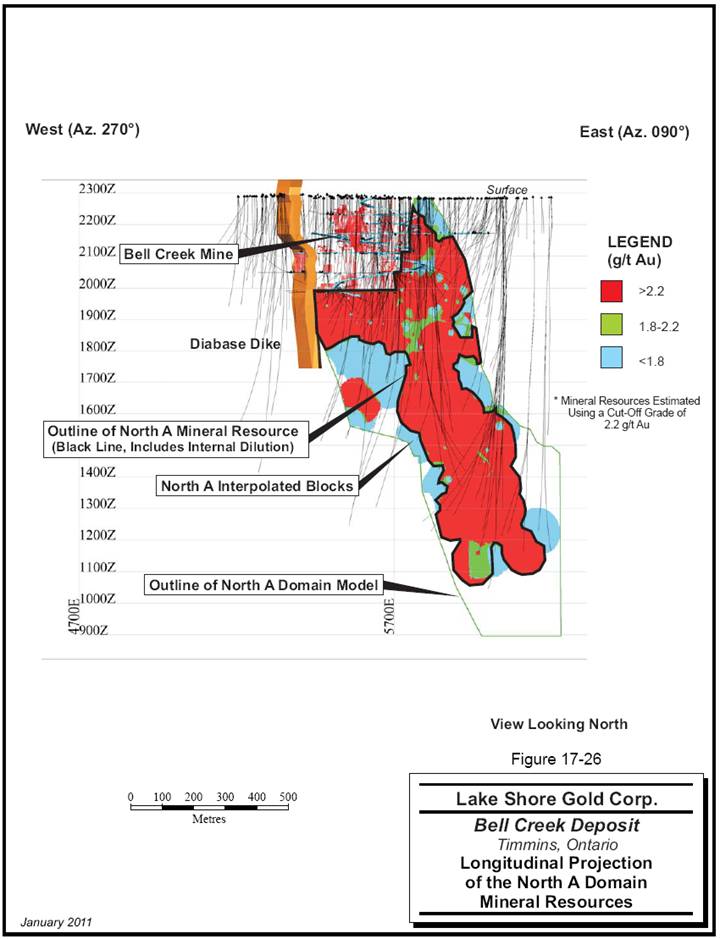
17-37
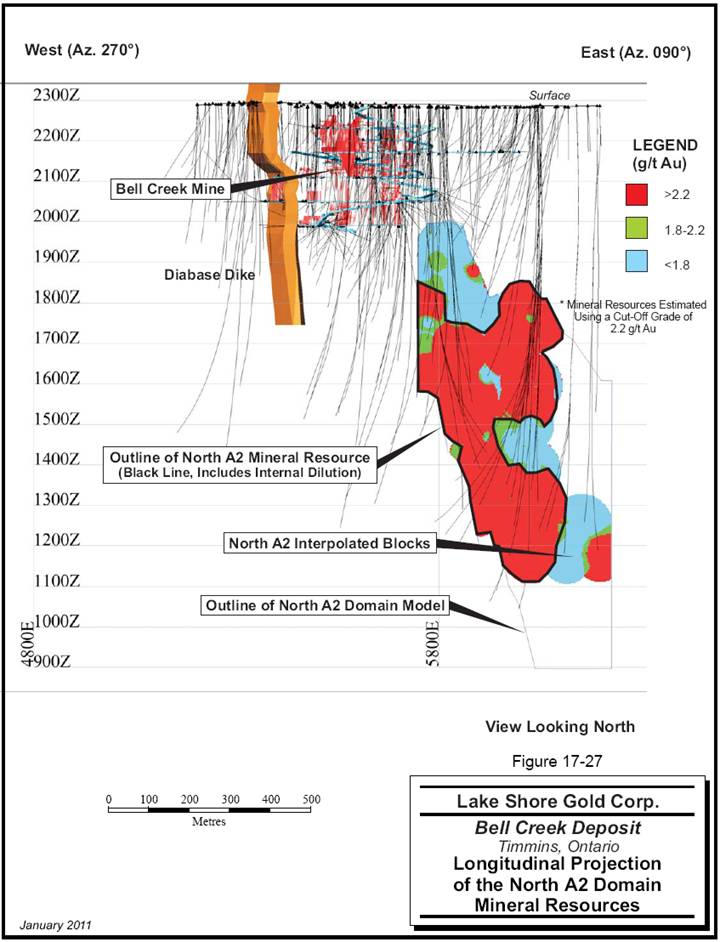
17-38

17-39
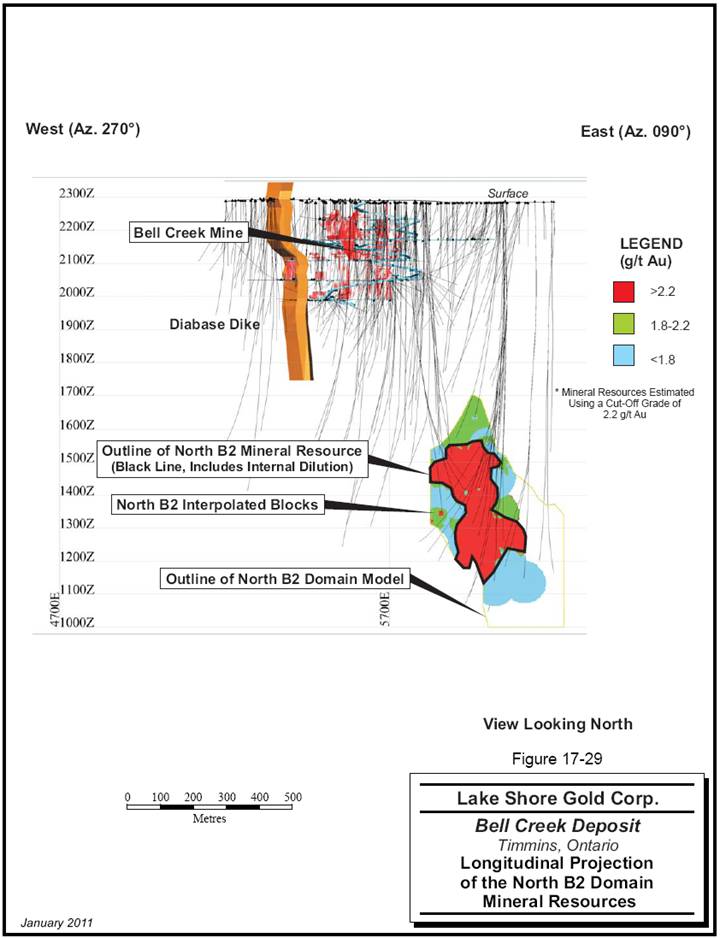
17-40
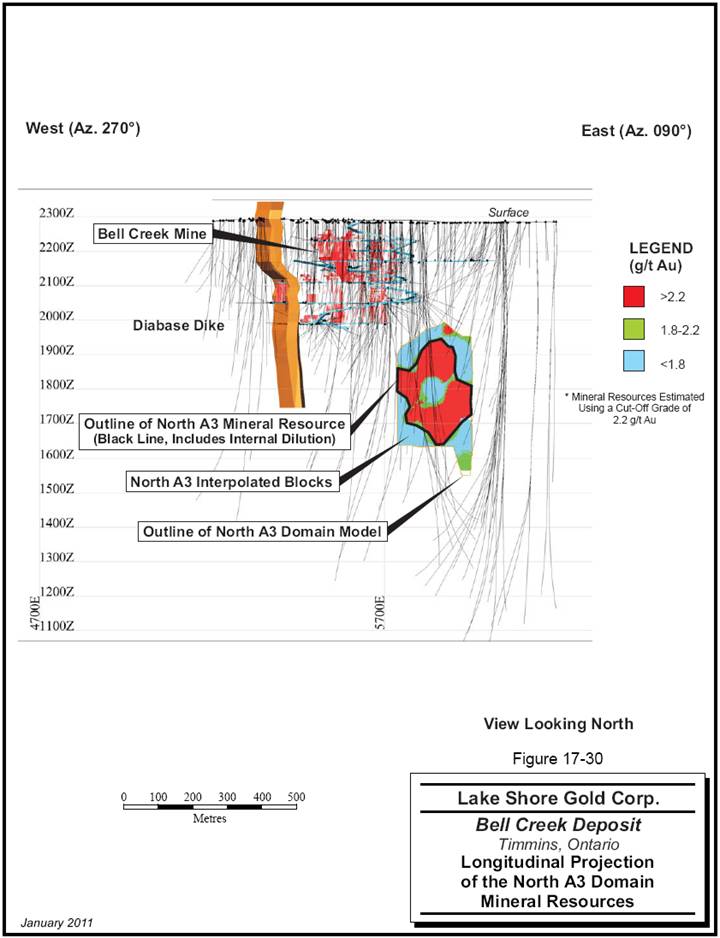
17-41
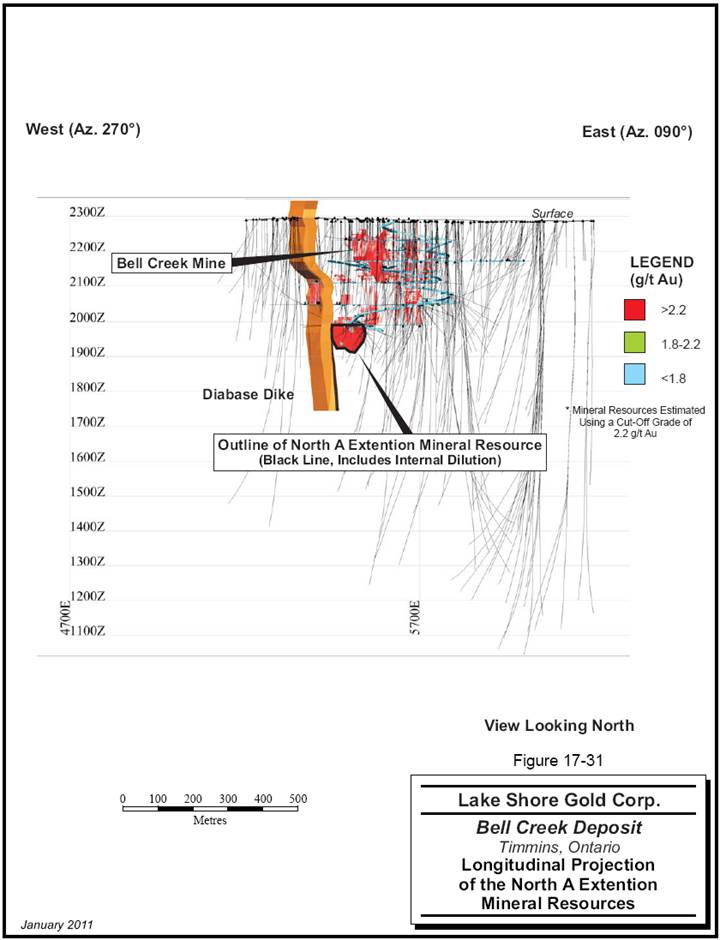
17-42
TABLE 17-10 TONNAGE AND GRADE (UNCLASSIFIED, INCLUSIVE OF
INTERNAL DILUTION) WITHIN THE 2.2 G/T AU MINERALIZED DOMAINS
Lake Shore Gold Corp. — Bell Creek Deposit
Cut-Off | | | | Uncapped
Grade | | Contained
Au | | Capped
Grade | | Contained
Au | |
(g/t Au) | | Tonnes | | (g/t Au) | | (oz) | | (g/t Au) | | (oz) | |
North A Domain | |
<1.8 | | 330,000 | | 0.75 | | 8,000 | | 0.75 | | 8,000 | |
1.8 - 2.2 | | 3345,000 | | 2.01 | | 21,600 | | 2.00 | | 21,600 | |
>2.2 | | 5,132,000 | | 5.06 | | 834,400 | | 5.01 | | 827,500 | |
Sub-total | | 5,797,000 | | 4.64 | | 863,900 | | 4.60 | | 856,900 | |
North B Domain | |
<1.8 | | 74,000 | | 0.74 | | 1,800 | | 0.72 | | 1,700 | |
1.8 - 2.2 | | 167,000 | | 2.06 | | 11,000 | | 2.05 | | 11,000 | |
>2.2 | | 1,569,000 | | 3.76 | | 189,700 | | 3.70 | | 186,800 | |
Sub-total | | 1,810,000 | | 3.48 | | 202,400 | | 3.43 | | 199,500 | |
North A2 Domain | |
<1.8 | | 37,000 | | 1.25 | | 1,500 | | 1.25 | | 1,500 | |
1.8 - 2.2 | | 53,000 | | 2.04 | | 3,500 | | 2.03 | | 3,400 | |
>2.2 | | 1,683,000 | | 5.63 | | 304,600 | | 5.26 | | 284,600 | |
Sub-total | | 1,773,000 | | 5.43 | | 309,600 | | 5.08 | | 289,600 | |
North A3 Domain | |
<1.8 | | 34,000 | | 1.26 | | 1,400 | | 1.26 | | 1,400 | |
1.8 - 2.2 | | 35,000 | | 2.03 | | 2,300 | | 2.03 | | 2,300 | |
>2.2 | | 225,000 | | 3.47 | | 25,106 | | 3.47 | | 25,100 | |
Sub-total | | 294,000 | | 3.04 | | 28,776 | | 3.04 | | 28,800 | |
North B2 Domain | |
<1.8 | | 12,000 | | 1.44 | | 1,000 | | 1.44 | | 600 | |
1.8 - 2.2 | | 26,000 | | 2.07 | | 1,700 | | 2.07 | | 1,700 | |
>2.2 | | 472,000 | | 4.08 | | 61,900 | | 4.08 | | 61,900 | |
Sub-total | | 509,000 | | 3.92 | | 64,100 | | 3.92 | | 64,100 | |
North A Extension Domain | |
<1.8 | | 1,000 | | 1.41 | | –– | | 1.33 | | –– | |
1.8 - 2.2 | | — | | 2.14 | | — | | 2.02 | | — | |
>2.2 | | 33,000 | | 5.04 | | 5,400 | | 4.75 | | 5,000 | |
Sub-total | | 34,000 | | 4.93 | | 5,400 | | 4.65 | | 5,100 | |
Totals | |
<1.8 | | 488,000 | | 0.84 | | 13,200 | | 0.84 | | 13,100 | |
1.8 - 2.2 | | 615,000 | | 2.03 | | 40,100 | | 2.02 | | 40,000 | |
>2.2 | | 9,114,000 | | 4.85 | | 1,421,000 | | 4.75 | | 1,390,900 | |
Grand Total | | 10,217,000 | | 4.49 | | 1,474,200 | | 4.40 | | 1,444,000 | |
Notes:
1. Sums may not add due to rounding
2. Tonnages and grades are reported on an unclassified basis for information purposes only.
17-43
A sensitivity analysis was carried out to examine the impact of a cut-off grade increase up to 5.0 g/t Au on the tonnage and average grade. To this end, a series of individual clipping polygons were created for each domain for a given cut-off grade and were used to prepare the various tonnage and grade reports (Table 17-11). The results are graphically presented in Figure 17-32.
TABLE 17-11 CUT-OFF GRADE SENSITIVITY ANALYSIS (INCLUSIVE OF
INTERNAL DILUTION)
Lake Shore Gold Corp. — Bell Creek Deposit
Domain | | Tonnes | | Au
Cap34 | | Contained
Oz | | Tonnes | | Au No
Cap | | Contained
Oz | |
Cut-Off Grade: 2.2 g/t Au ( Base Case, ~C$1,175/oz Au) | |
North A | | 5,797,000 | | 4.60 | | 856,900 | | 5,797,000 | | 4.64 | | 863,900 | |
North A2 | | 1,773,000 | | 5.08 | | 289,600 | | 1,773,000 | | 5.43 | | 309,500 | |
North B | | 1,810,000 | | 3.43 | | 199,500 | | 1,810,000 | | 3.48 | | 202,400 | |
North A3 | | 294,000 | | 3.04 | | 28,800 | | 294,000 | | 3.04 | | 28,800 | |
North B2 | | 509,000 | | 3.92 | | 64,100 | | 509,000 | | 3.92 | | 64,100 | |
North A Extension | | 34,000 | | 4.65 | | 5,100 | | 34,000 | | 4.93 | | 5,400 | |
Totals | | 10,217,000 | | 4.40 | | 1,443,900 | | 10,217,000 | | 4.49 | | 1,474,200 | |
| | | | | | | | | | | | | |
Cut-Off Grade: 2.5 g/t Au (~ C$1,075/oz Au) | |
North A | | 5,617,000 | | 4.68 | | 845,200 | | 5,617,000 | | 4.72 | | 852,200 | |
North A2 | | 1,693,000 | | 5.22 | | 284,000 | | 1,693,000 | | 5.59 | | 304,000 | |
North B | | 1,376,000 | | 3.85 | | 170,400 | | 1,376,000 | | 3.92 | | 173,200 | |
North A3 | | 286,000 | | 3.08 | | 28,300 | | 286,000 | | 3.08 | | 28,300 | |
North B2 | | 441,000 | | 4.19 | | 59,400 | | 441,000 | | 4.19 | | 59,400 | |
North A Extension | | 34,000 | | 4.65 | | 5,100 | | 34,000 | | 4.93 | | 5,400 | |
Totals | | 9,447,000 | | 4.58 | | 1,392,500 | | 9,447,000 | | 4.68 | | 1,422,400 | |
| | | | | | | | | | | | | |
Cut-Off Grade: 3.0 g/t Au (~ C$900/oz Au) | |
North A | | 5,384,000 | | 4.78 | | 827,700 | | 5,384,000 | | 4.82 | | 834,600 | |
North A2 | | 1,492,000 | | 5.54 | | 266,100 | | 1,492,000 | | 5.96 | | 286,000 | |
North B | | 1,022,000 | | 4.28 | | 140,800 | | 1,022,000 | | 4.37 | | 143,500 | |
North A3 | | 118,000 | | 4.22 | | 16,000 | | 118,000 | | 4.22 | | 15,900 | |
North B2 | | 334,000 | | 4.68 | | 50,300 | | 334,000 | | 4.68 | | 50,300 | |
North A Extension | | 34,000 | | 4.65 | | 5,100 | | 34,000 | | 4.93 | | 5,400 | |
Totals | | 8,385,000 | | 4.84 | | 1,305,800 | | 8,385,000 | | 4.95 | | 1,335,700 | |
17-44
Domain | | Tonnes | | Au
Cap34 | | Contained
Oz | | Tonnes | | Au No
Cap | | Contained
Oz | |
Cut-Off Grade: 3.5 g/t Au (~ C$750/oz Au) | |
North A | | 5,065,000 | | 4.91 | | 799,000 | | 5,065,000 | | 4.95 | | 805,800 | |
North A2 | | 1,207,000 | | 6.17 | | 239,400 | | 1,207,000 | | 6.68 | | 259,300 | |
North B | | 642,000 | | 4.80 | | 99,000 | | 642,000 | | 4.86 | | 100,200 | |
North A3 | | 77,000 | | 4.84 | | 12,000 | | 77,000 | | 4.84 | | 12,000 | |
North B2 | | 274,000 | | 5.02 | | 44,300 | | 274,000 | | 5.02 | | 44,300 | |
North A Extension | | 34,000 | | 4.65 | | 5,100 | | 34,000 | | 4.93 | | 5,400 | |
Totals | | 7,299,000 | | 5.11 | | 1,198,800 | | 7,299,000 | | 5.23 | | 1,227,000 | |
| | | | | | | | | | | | | |
Cut-Off Grade: 4.0 g/t Au (~ C$675/oz Au) | |
North A | | 4,555,000 | | 5.12 | | 749,900 | | 4,555,000 | | 5.17 | | 756,800 | |
North A2 | | 1,046,000 | | 6.79 | | 228,200 | | 1,046,000 | | 7.37 | | 247,800 | |
North B | | 540,000 | | 5.01 | | 87,100 | | 540,000 | | 5.01 | | 87,100 | |
North A3 | | 58,000 | | 5.28 | | 9,800 | | 58,000 | | 5.28 | | 9,800 | |
North B2 | | 193,000 | | 5.61 | | 34,900 | | 193,000 | | 5.61 | | 34,900 | |
North A Extension | | 20,000 | | 5.51 | | 3,500 | | 20,000 | | 5.98 | | 3,800 | |
Totals | | 6,412,000 | | 5.40 | | 1,113,400 | | 6,412,000 | | 5.53 | | 1,140,200 | |
| | | | | | | | | | | | | |
Cut-Off Grade: 4.5 g/t Au (~ C$600/oz Au) | |
North A | | 3,786,000 | | 5.45 | | 663,400 | | 3,786,000 | | 5.50 | | 669,400 | |
North A2 | | 764,000 | | 7.73 | | 189,800 | | 764,000 | | 8.52 | | 209,100 | |
North B | | 341,000 | | 5.36 | | 58,700 | | 341,000 | | 5.36 | | 58,700 | |
North A3 | | 29,000 | | 6.25 | | 5,900 | | 29,000 | | 6.25 | | 5,900 | |
North B2 | | 117,000 | | 6.51 | | 24,400 | | 117,000 | | 6.51 | | 24,400 | |
North A Extension | | 16,000 | | 5.97 | | 3,100 | | 16,000 | | 6.50 | | 3,400 | |
Totals | | 5,052,000 | | 5.82 | | 945,300 | | 5,052,000 | | 5.98 | | 970,800 | |
| | | | | | | | | | | | | |
Cut-Off Grade: 5.0 g/t Au (~ C$550/oz Au) | |
North A | | 3,324,000 | | 5.66 | | 605,200 | | 3,324,000 | | 5.71 | | 610,600 | |
North A2 | | 679,000 | | 8.13 | | 177,600 | | 679,000 | | 8.99 | | 196,400 | |
North B | | 312,000 | | 5.42 | | 54,400 | | 312,000 | | 5.42 | | 54,400 | |
North A3 | | 23,000 | | 6.72 | | 5,100 | | 23,000 | | 6.72 | | 5,100 | |
North B2 | | 105,000 | | 6.74 | | 22,700 | | 105,000 | | 6.74 | | 22,700 | |
North A Extension | | 13,000 | | 6.34 | | 2,700 | | 13,000 | | 6.87 | | 3,000 | |
Totals | | 4,457,000 | | 6.05 | | 867,600 | | 4,457,000 | | 6.23 | | 892,200 | |
17-45
FIGURE 17-32 GRADE-TONNAGE GRAPH AS A FUNCTION OF CUT-OFF
GRADE
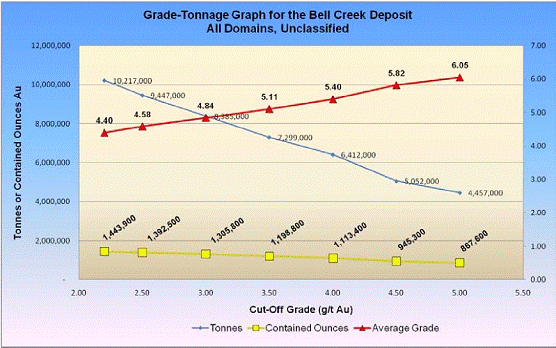
GOLD DISTRIBUTION AND ESTIMATED HORIZONTAL THICKNESSES
The distribution of contained gold as a function of depth from surface is presented in tabular format in Table 17-12 and is presented graphically in Figure 17-32.
TABLE 17-12 DISTRIBUTION OF CONTAINED GOLD BY LEVEL, ALL
DOMAINS
Lake Shore Gold Corp. — Bell Creek Deposit
Level | | Tonnes | | Uncapped
Grade
(g/t Au) | | Contained
Au
(oz) | | Capped
Grade
(g/t Au) | | Contained
Au
(oz) | |
2275 (-13m) | | 5,000 | | 3.89 | | 700 | | 3.89 | | 700 | |
2250 (-38m) | | 35,000 | | 3.64 | | 4,100 | | 3.64 | | 4,100 | |
2225 (-63m) | | 41,000 | | 3.19 | | 4,200 | | 3.19 | | 4,200 | |
2200 (-88m) | | 35,000 | | 2.72 | | 3,100 | | 2.72 | | 3,100 | |
2175 (113m) | | 16,000 | | 2.59 | | 1,300 | | 2.59 | | 1,300 | |
2150 (-138m) | | 21,000 | | 2.94 | | 2,000 | | 2.94 | | 2,000 | |
2125 (-163m) | | 38,000 | | 2.91 | | 3,500 | | 2.91 | | 3,500 | |
2100 (-188m) | | 41,000 | | 2.94 | | 3,800 | | 2.94 | | 3,800 | |
17-46
Level | | Tonnes | | Uncapped
Grade
(g/t Au) | | Contained
Au
(oz) | | Capped
Grade
(g/t Au) | | Contained
Au
(oz) | |
2075 (-213m) | | 44,000 | | 3.11 | | 4,400 | | 3.11 | | 4,400 | |
2050 (-238m) | | 53,000 | | 3.06 | | 5,200 | | 3.06 | | 5,200 | |
2025 (-263m) | | 68,000 | | 3.33 | | 7,300 | | 3.33 | | 7,300 | |
2000 (-288m) | | 101,000 | | 4.03 | | 13,000 | | 3.81 | | 12,300 | |
1975 (-313m) | | 141,000 | | 4.89 | | 22,200 | | 4.54 | | 20,700 | |
1950 (-338m) | | 131,000 | | 4.86 | | 20,400 | | 4.64 | | 19,500 | |
1925 (-363m) | | 114,000 | | 4.18 | | 15,200 | | 4.09 | | 14,900 | |
1900 (-388m) | | 109,000 | | 4.16 | | 14,600 | | 4.10 | | 14,400 | |
1875 (-413m) | | 121,000 | | 3.91 | | 15,200 | | 3.89 | | 15,100 | |
1850 (-438m) | | 138,000 | | 4.40 | | 19,500 | | 4.38 | | 19,400 | |
1825 (-463m) | | 155,000 | | 4.90 | | 24,400 | | 4.87 | | 24,200 | |
1800 (-438m) | | 166,000 | | 5.29 | | 28,300 | | 5.25 | | 28,100 | |
1775 (-513m) | | 182,000 | | 4.47 | | 26,100 | | 4.45 | | 26,000 | |
1750 (-538m) | | 197,000 | | 3.57 | | 22,600 | | 3.57 | | 22,600 | |
1725 (-563m) | | 230,000 | | 3.40 | | 25,100 | | 3.40 | | 25,100 | |
1700 (-588m) | | 231,000 | | 3.65 | | 27,100 | | 3.65 | | 27,100 | |
1675 (-613m) | | 249,000 | | 3.76 | | 30,000 | | 3.76 | | 30,000 | |
1650 (-638m) | | 267,000 | | 3.88 | | 33,300 | | 3.87 | | 33,200 | |
1625 (-663m) | | 291,000 | | 4.24 | | 39,700 | | 4.20 | | 39,300 | |
1600 (-688m) | | 297,000 | | 4.34 | | 41,400 | | 4.30 | | 41,000 | |
1575 (-713m) | | 309,000 | | 4.33 | | 43,000 | | 4.29 | | 42,600 | |
1550 (-738m) | | 292,000 | | 4.38 | | 41,200 | | 4.37 | | 41,100 | |
1525 (-763m) | | 284,000 | | 4.04 | | 36,900 | | 4.04 | | 36,900 | |
1500 (-788m) | | 240,000 | | 3.73 | | 28,700 | | 3.73 | | 28,700 | |
1475 (-813m) | | 212,000 | | 3.43 | | 23,400 | | 3.42 | | 23,300 | |
1450 (-838m) | | 203,000 | | 3.36 | | 21,900 | | 3.35 | | 21,800 | |
1425 (-863m) | | 201,000 | | 3.24 | | 21,000 | | 3.22 | | 20,800 | |
1400 (-888m) | | 195,000 | | 3.26 | | 20,400 | | 3.23 | | 20,200 | |
1375 (-913m) | | 200,000 | | 3.99 | | 25,600 | | 3.96 | | 25,400 | |
1350 (-938m) | | 224,000 | | 5.32 | | 38,300 | | 5.31 | | 38,300 | |
1325 (-963m) | | 289,000 | | 6.00 | | 55,800 | | 5.94 | | 55,200 | |
1300 (-988m) | | 353,000 | | 6.37 | | 72,300 | | 6.26 | | 71,000 | |
1275 (-1013m) | | 366,000 | | 5.98 | | 70,400 | | 5.84 | | 68,800 | |
1250 (-1038m) | | 368,000 | | 4.78 | | 56,600 | | 4.66 | | 55,200 | |
1225 (-1063m) | | 372,000 | | 3.81 | | 45,600 | | 3.76 | | 45,000 | |
1200 (-1088m) | | 384,000 | | 4.23 | | 52,300 | | 4.06 | | 50,100 | |
1175 (-1113m) | | 372,000 | | 5.18 | | 61,900 | | 4.73 | | 56,600 | |
1150 (-1138m) | | 425,000 | | 5.74 | | 78,300 | | 5.23 | | 71,400 | |
1125 (-1163m) | | 416,000 | | 5.70 | | 76,200 | | 5.42 | | 72,400 | |
1100 (-1188m) | | 390,000 | | 5.26 | | 66,000 | | 5.26 | | 66,000 | |
1075 (-1213m) | | 350,000 | | 5.11 | | 57,600 | | 5.11 | | 57,600 | |
17-47
Level | | Tonnes | | Uncapped
Grade
(g/t Au) | | Contained
Au
(oz) | | Capped
Grade
(g/t Au) | | Contained
Au
(oz) | |
1050 (-1233m) | | 228,000 | | 2.74 | | 20,100 | | 2.74 | | 20,000 | |
1025 (-1288m) | | 38,000 | | 2.77 | | 3,400 | | 2.77 | | 3,400 | |
1050 (1313m) | | — | | | | — | | | | — | |
Notes:
1. Sums may not add due to rounding.
2. Tonnages and grades reported are not Mineral Resources and are reported for information purposes only.
3. Surface elevation = 2,288 m.
FIGURE 17-33 DISTRIBUTION OF CONTAINED GOLD (CAPPED GOLD
GRADES) BY LEVEL, ALL DOMAINS
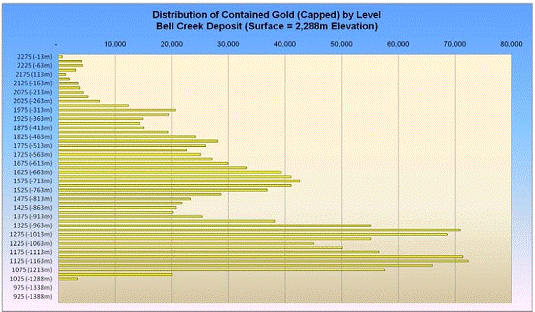
Scott Wilson RPA also prepared an estimate of the average horizontal widths by level within the 2.2 g/t Au clipping polygons for each of the mineralized domains. This was achieved by preparing a regularized interrogation matrix with a cell spacing of 12.5 m in an east-west direction and of 25 m in the vertical direction. The arithmetic average width for each level of a given domain was calculated from the resulting report, and the overall average width of the mineralized domain was calculated using the strike length of the mineralized domain per level as a weighting criterion (Table 17-12). The resulting data for each domain were contoured in a series of longitudinal projections to examine the distribution of the horizontal width (Figures 17-34 to 17-39)
17-48
TABLE 17-13 ESTIMATED HORIZONTAL WIDTH (IN METRES) OF THE
MINERAL RESOURCE OUTLINES BY LEVEL, ALL DOMAINS
Lake Shore Gold Corp. — Bell Creek Deposit
Level/Domain | | North A | | North A2 | | North B | | North
B2 | | North
A3 | | North A
Extension | |
2275 (-13m) | | | | | | | | | | | | | |
2250 (-38m) | | | | | | 2.3 | | | | | | | |
2225 (-63m) | | | | | | 2.4 | | | | | | | |
2200 (-88m) | | | | | | 2.4 | | | | | | | |
2175 (113m) | | 1.9 | | | | 3.6 | | | | | | | |
2150 (-138m) | | 2.0 | | | | | | | | | | | |
2125 (-163m) | | 2.3 | | | | | | | | | | | |
2100 (-188m) | | 2.8 | | | | | | | | | | | |
2075 (-213m) | | 3.3 | | | | | | | | | | | |
2050 (-238m) | | 3.8 | | | | | | | | | | | |
2025 (-263m) | | 4.1 | | | | 2.2 | | | | | | | |
2000 (-288m) | | 4.8 | | | | 3.9 | | | | | | | |
1975 (-313m) | | 3.7 | | | | 3.3 | | | | | | 2.1 | |
1950 (-338m) | | 3.3 | | | | 2.2 | | | | | | 2.4 | |
1925 (-363m) | | 2.9 | | | | | | | | 4.5 | | 1.5 | |
1900 (-388m) | | 3.0 | | | | | | | | 2.7 | | 1.4 | |
1875 (-413m) | | 2.8 | | | | 2.7 | | | | 2.2 | | | |
1850 (-438m) | | 2.8 | | | | 2.3 | | | | 2.3 | | | |
1825 (-463m) | | 2.7 | | 2.2 | | 2.6 | | | | 2.4 | | | |
1800 (-438m) | | 3.0 | | 2.4 | | 3.0 | | | | 2.6 | | | |
1775 (-513m) | | 3.9 | | 2.7 | | 3.5 | | | | 2.4 | | | |
1750 (-538m) | | 5.8 | | 3.7 | | 3.9 | | | | 2.7 | | | |
1725 (-563m) | | 6.8 | | 3.8 | | 3.6 | | | | 2.6 | | | |
1700 (-588m) | | 6.9 | | 3.9 | | 2.7 | | | | 2.7 | | | |
1675 (-613m) | | 6.7 | | 4.1 | | 2.9 | | | | 2.8 | | | |
1650 (-638m) | | 6.9 | | 4.1 | | 3.2 | | | | 2.4 | | | |
1625 (-663m) | | 6.7 | | 4.2 | | 3.8 | | | | | | | |
1600 (-688m) | | 6.2 | | 4.5 | | 3.6 | | | | | | | |
1575 (-713m) | | 5.5 | | 4.6 | | 3.6 | | | | | | | |
1550 (-738m) | | 5.1 | | 5.6 | | 3.6 | | 3.1 | | | | | |
1525 (-763m) | | 5.2 | | 5.5 | | 3.2 | | 2.6 | | | | | |
1500 (-788m) | | 5.6 | | 4.4 | | 3.2 | | 2.5 | | | | | |
1475 (-813m) | | 5.7 | | 3.2 | | 3.1 | | 2.6 | | | | | |
1450 (-838m) | | 5.9 | | 3.2 | | 3.2 | | 2.5 | | | | | |
1425 (-863m) | | 6.9 | | 3.3 | | 3.5 | | 2.4 | | | | | |
1400 (-888m) | | 7.6 | | 3.1 | | 3.5 | | 2.4 | | | | | |
1375 (-913m) | | 7.2 | | 2.6 | | 3.3 | | 2.5 | | | | | |
1350 (-938m) | | 8.3 | | 3.7 | | 2.8 | | 3.1 | | | | | |
17-49
Level/Domain | | North A | | North A2 | | North B | | North
B2 | | North
A3 | | North A
Extension | |
1325 (-963m) | | 8.9 | | 5.2 | | 2.7 | | 3.1 | | | | | |
1300 (-988m) | | 10.1 | | 6.2 | | 2.8 | | 2.7 | | | | | |
1275 (-1013m) | | 10.8 | | 5.7 | | 3.1 | | 3.0 | | | | | |
1250 (-1038m) | | 12.2 | | 5.3 | | 3.4 | | 3.2 | | | | | |
1225 (-1063m) | | 12.5 | | 4.9 | | 3.8 | | 3.9 | | | | | |
1200 (-1088m) | | 12.1 | | 5.0 | | 5.3 | | 4.7 | | | | | |
1175 (-1113m) | | 14.8 | | 5.2 | | 5.2 | | 5.4 | | | | | |
1150 (-1138m) | | 16.4 | | 4.9 | | 5.2 | | 4.6 | | | | | |
1125 (-1163m) | | 17.1 | | 4.6 | | 5.1 | | 3.8 | | | | | |
1100 (-1188m) | | 19.4 | | | | 5.4 | | | | | | | |
1075 (-1213m) | | 37.6 | | | | 5.8 | | | | | | | |
1050 (-1233m) | | 48.7 | | | | 6.1 | | | | | | | |
1025 (-1288m) | | | | | | 5.5 | | | | | | | |
| | | | | | | | | | | | | |
Average (m) | | 6.9 | | 4.4 | | 3.6 | | 3.1 | | 2.6 | | 2.0 | |
17-50

17-51
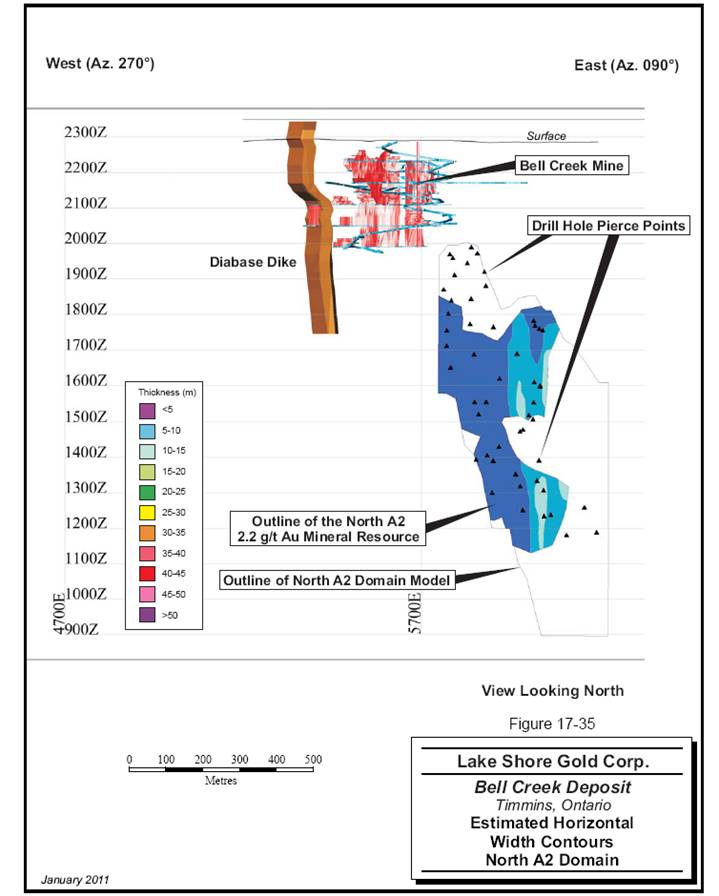
17-52
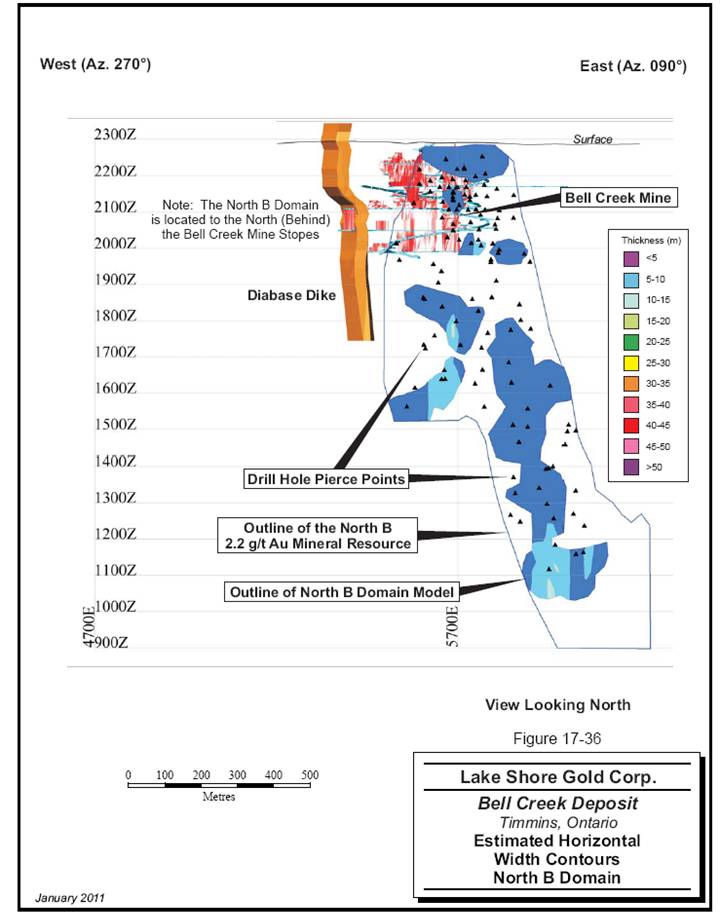
17-53
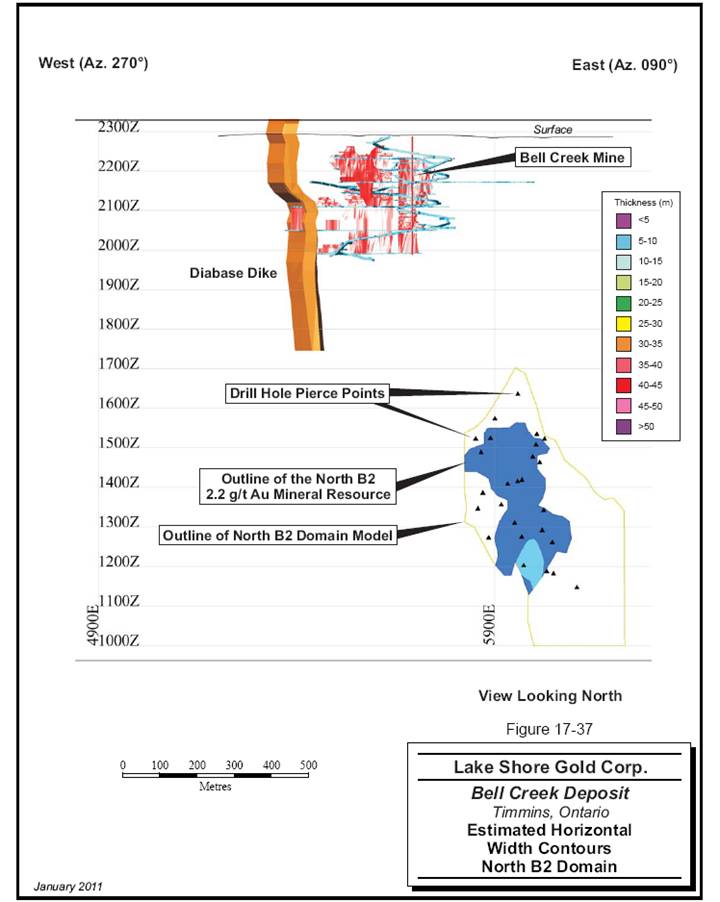
17-54
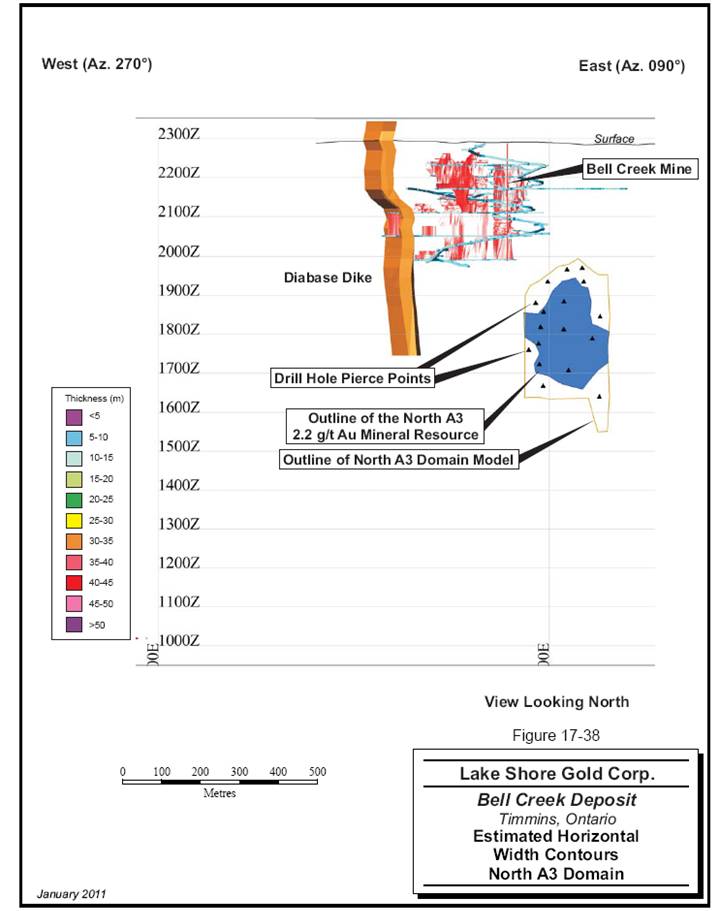
17-55
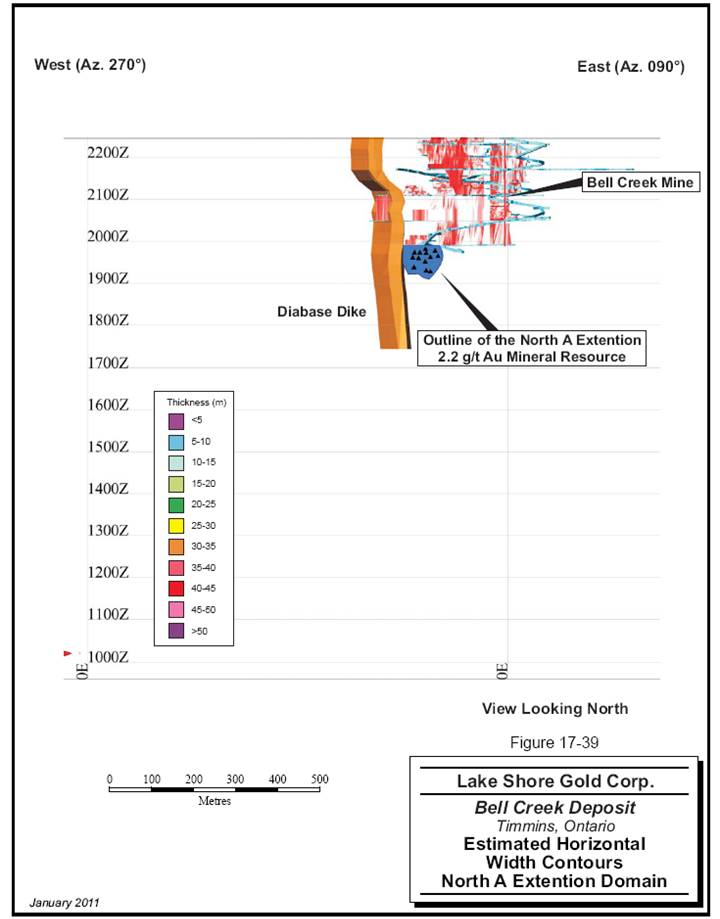
17-56
BLOCK MODEL VALIDATION
The Bell Creek block model validation included a comparison of the average block grades for the capped gold grades versus composite gold grades for each domain. As well, the volumes reported from the block model were compared to the volumes for each resource solid. The reconciliation report is presented in Table 17-14. It can be seen that there is good correlation between the average block and composite gold grades for each domain. In addition, the reported block model volumes for each domain are essentially the same as the domain solid volumes: the block model reports a slightly greater tonnage but a slightly less amount of contained metal in comparison to the original data.
TABLE 17-14 BLOCK MODEL RECONCILIATION REPORT
Lake Shore Gold Corp. — Bell Creek Deposit
| | Volume | | | | Capped Au | | Contained | |
Item | | (m3) | | Tonnes | | (g/t Au) | | Oz | |
North A Domain | |
Block Model Report | | 2,055,700 | | 5,796,900 | | 4.60 | | 856,860 | |
Cross Check | | 2,066,900 | | 5,828,600 | | 4.61 | | 863,900 | |
Difference (BM-Check) | | - 11,200 | | - 31,600 | | | | - 7,000 | |
North B Domain | |
Block Model Report | | 641,700 | | 1,809,600 | | 3.43 | | 199,500 | |
Cross Check | | 617,200 | | 1,740,600 | | 3.52 | | 197,000 | |
Difference (BM-Check) | | 24,500 | | 69,100 | | | | 2,500 | |
North A2 Domain | |
Block Model Report | | 628,600 | | 1,772,500 | | 5.08 | | 289,600 | |
Cross Check | | 615,800 | | 1,736,400 | | 5.01 | | 279,800 | |
Difference (BM-Check) | | 12,800 | | 36,100 | | | | 9,800 | |
North A3 Domain | |
Block Model Report | | 104,400 | | 294,400 | | 3.04 | | 28,800 | |
Cross Check | | 102,000 | | 288,000 | | 3.49 | | 32,300 | |
Difference (BM-Check) | | 2,400 | | 6,800 | | | | - 3,500 | |
North B2 Domain | |
Block Model Report | | 180,600 | | 509,300 | | 3.92 | | 64,100 | |
Cross Check | | 176,300 | | 497,100 | | 4.71 | | 75,300 | |
Difference (BM-Check) | | 4,300 | | 12,200 | | | | -11,200 | |
North A Extension Domain | |
Block Model Report | | 12,100 | | 34,200 | | 4.65 | | 5,100 | |
Cross Check | | 12,400 | | 34,900 | | 4.73 | | 5,306 | |
Difference (BM-Check) | | - 300 | | - 700 | | | | - 200 | |
17-57
| | Volume | | | | Capped Au | | Contained | |
Item | | (m3) | | Tonnes | | (g/t Au) | | Oz | |
| | Totals | | | | | |
Totals, Block Model | | 3,623,000 | | 10,216,900 | | | | 1,443,900 | |
Totals, Cross Check | | 3,590,500 | | 10,125,100 | | | | 1,453,600 | |
Difference (BM-Check) | | 32,600 | | 91,800 | | | | -9,700 | |
Percent Difference | | 0.9 | | 0.9 | | | | -0.7 | |
Notes:
1. Sums may not add due to rounding
2. Tonnages and grades are reported on an unclassified basis for information purposes only
MINERAL RESOURCE CLASSIFICATION CRITERIA
The Mineral Resources in this report were estimated in accordance with the definitions contained in the Canadian Institute of Mining, Metallurgy and Petroleum (CIM) Definition Standards on Mineral Resources and Mineral Reserves that were prepared by the CIM Standing Committee on Reserve Definitions and adopted by the CIM Council on December 11, 2005.
The mineralized material for each domain was classified into the Measured, Indicated, or Inferred Mineral Resource category on the basis of the search ellipse range obtained from the variography study, the demonstrated continuity of the gold mineralization above the suggested cut-off grade, and the density of drill hole information.
RESPONSIBILITY FOR ESTIMATION
The estimate of the Mineral Resources for the Bell Creek gold deposit presented in this report was prepared by Mr. Reno Pressacco, M.Sc.(A), P.Geo., who is a Qualified Person as defined in NI 43-101, and is independent of Lake Shore Gold.
MINERAL RESOURCE ESTIMATE
As a result of the concepts and processes described in this report, the Mineral Resources for the Bell Creek gold deposit include all blocks that are located within the respective domain models defined based on a 2.2 g/t Au cut-off grade. Some small internal areas of lower grade blocks have been included to preserve continuity.
17-58
The estimated Mineral Resources, using the capped gold grades, are set out in Table 17-15. The distribution of the classified Mineral Resources is shown in Figures 17-40 to 17-45.
TABLE 17-15 ESTIMATED MINERAL RESOURCES BY DOMAIN AS AT
NOVEMBER 2010
Lake Shore Gold Corp. — Bell Creek Deposit
Category | | Tonnes | | Capped Grade
(g/t Au) | | Oz Au | |
North A Domain | |
Measured | | 375,000 | | 4.49 | | 54,200 | |
Indicated | | 960,000 | | 4.86 | | 149,800 | |
Sub-total, M&I | | 1,335,000 | | 4.75 | | 204,000 | |
| | | | | | | |
Inferred | | 4,462,000 | | 4.55 | | 653,000 | |
North A2 Domain | |
Measured | | — | | 0.00 | | — | |
Indicated | | 44,000 | | 2.95 | | 4,200 | |
Sub-total, M&I | | 44,000 | | 2.95 | | 4,200 | |
| | | | | | | |
Inferred | | 1,728,000 | | 5.14 | | 285,400 | |
North B Domain | |
Measured | | — | | 0.00 | | — | |
Indicated | | 229,000 | | 3.05 | | 22,500 | |
Sub-total, M&I | | 229,000 | | 3.05 | | 22,500 | |
| | | | | | | |
Inferred | | 1,580,000 | | 3.48 | | 177,000 | |
North A3 Domain | |
Measured | | — | | 0.00 | | — | |
Indicated | | 147,000 | | 3.24 | | 15,300 | |
Sub-total, M&I | | 147,000 | | 3.24 | | 15,300 | |
| | | | | | | |
Inferred | | 148,000 | | 2.84 | | 13,500 | |
North B2 Domain | |
Measured | | — | | 0.00 | | — | |
Indicated | | — | | 0.00 | | — | |
Sub-total, M&I | | — | | 0.00 | | — | |
| | | | | | | |
Inferred | | 509,000 | | 3.92 | | 64,100 | |
17-59
Category | | Tonnes | | Capped Grade
(g/t Au) | | Oz Au | |
North A Extension Domain | |
Measured | | 34,000 | | 4.65 | | 5,100 | |
Indicated | | — | | 0.00 | | — | |
Sub-total, M&I | | 34,000 | | 4.65 | | 5,100 | |
| | | | | | | |
Inferred | | — | | 0.00 | | — | |
GRAND TOTAL | |
Measured | | 410,000 | | 4.51 | | 59,300 | |
Indicated | | 1,380,000 | | 4.32 | | 191,800 | |
M & I | | 1,790,000 | | 4.36 | | 251,200 | |
| | | | | | | |
Inferred | | 8,427,000 | | 4.40 | | 1,192,900 | |
Notes:
1. CIM definitions were followed for classification of Mineral Resources.
2. Mineral Resources are estimated at a cut-off grade of 2.2 g/t Au.
3. Mineral Resources are estimated using an average long-term gold price of US$1,125 per ounce, and a US$/C$ exchange rate of 0.95.
4. A minimum mining width of two metres was used.
5. Capped gold grades are used in estimating the Mineral Resource average grade.
6. Sums may not add due to rounding.
7. Mr. Reno Pressacco, M.Sc.(A), P.Geo., is the Qualified Person for this resource estimate.
17-60
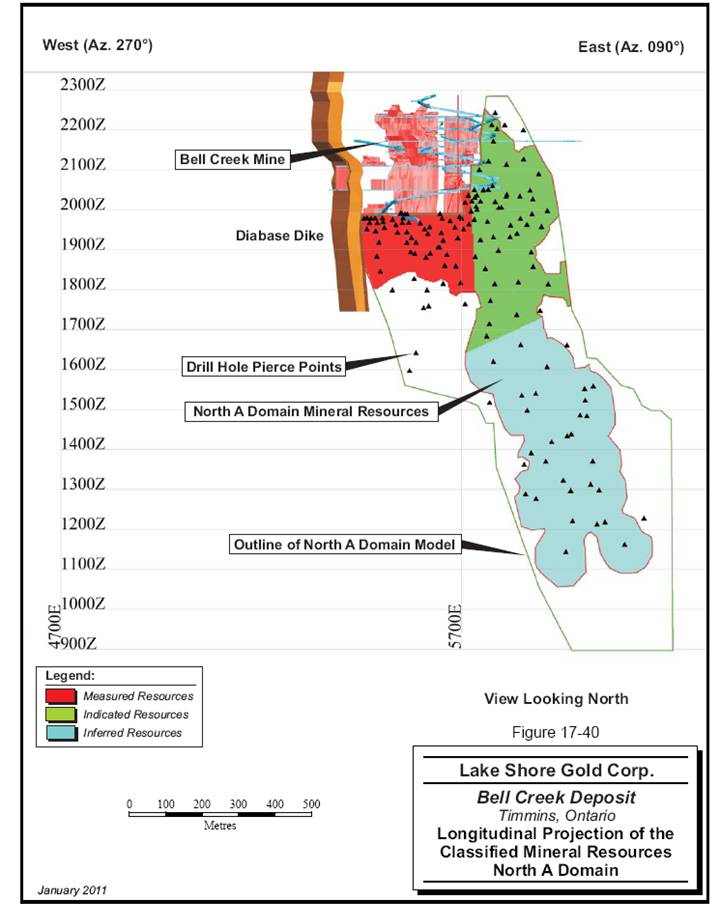
17-61
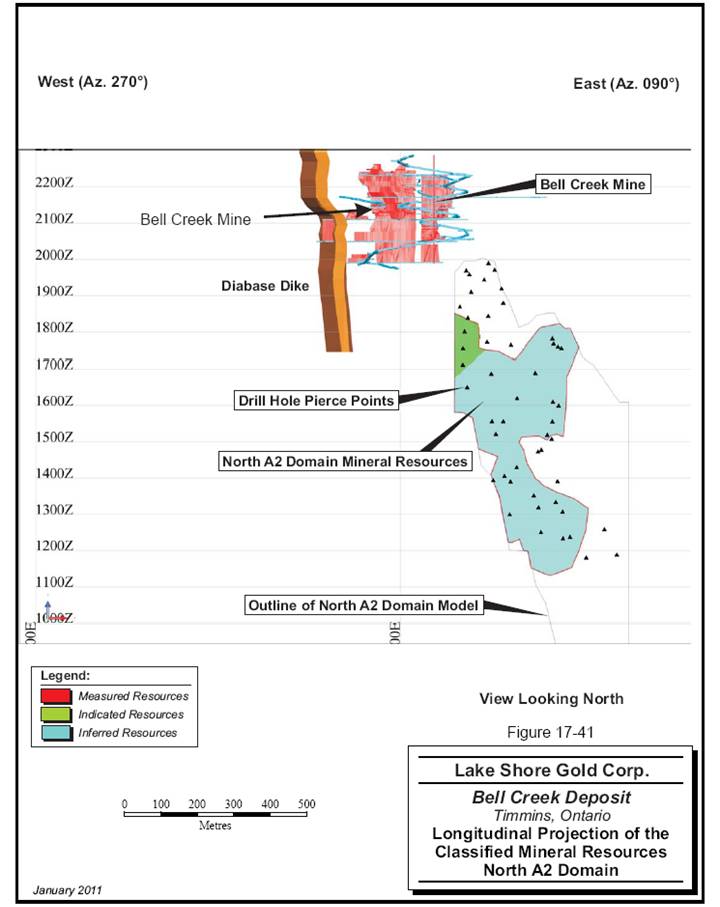
17-62
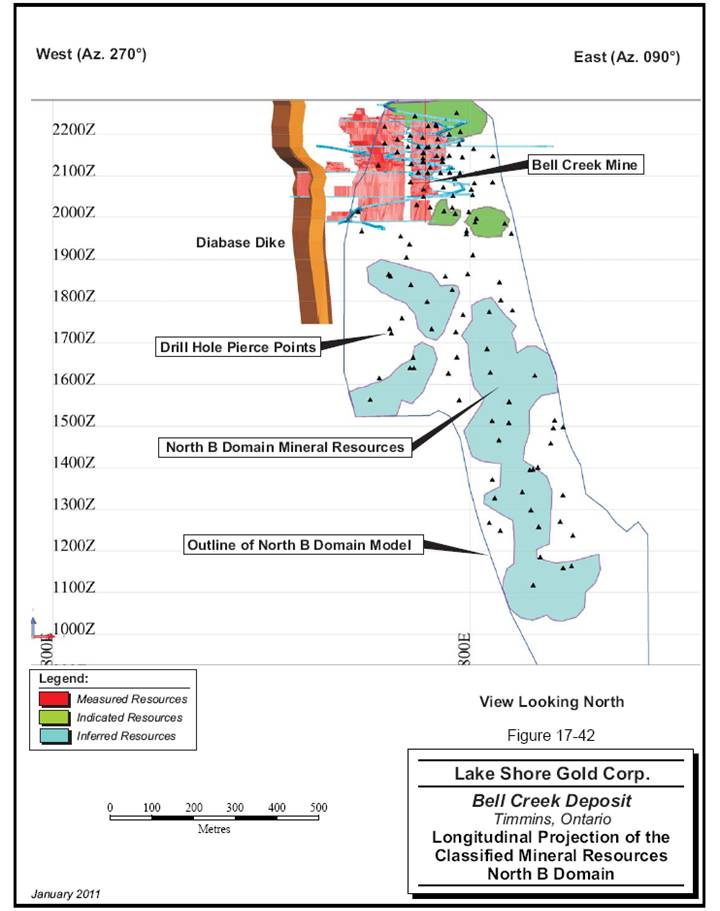
17-63
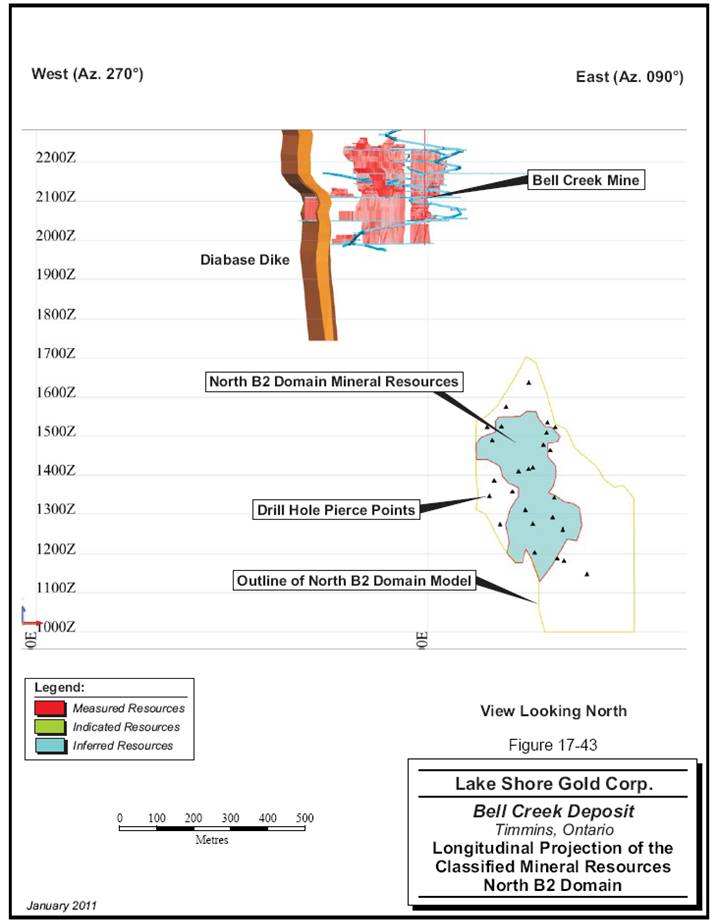
17-64
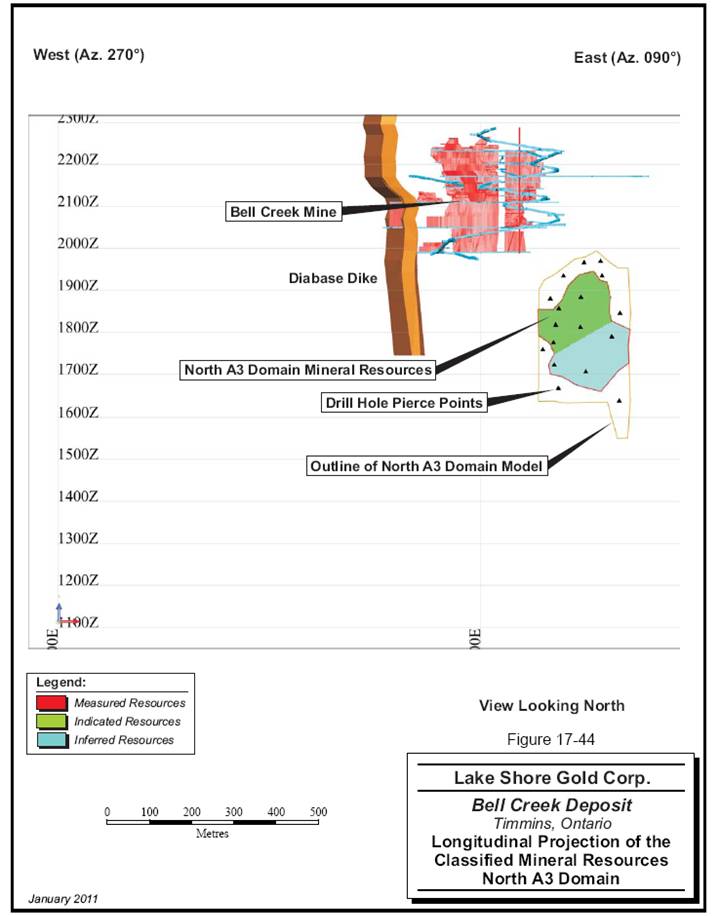
17-65
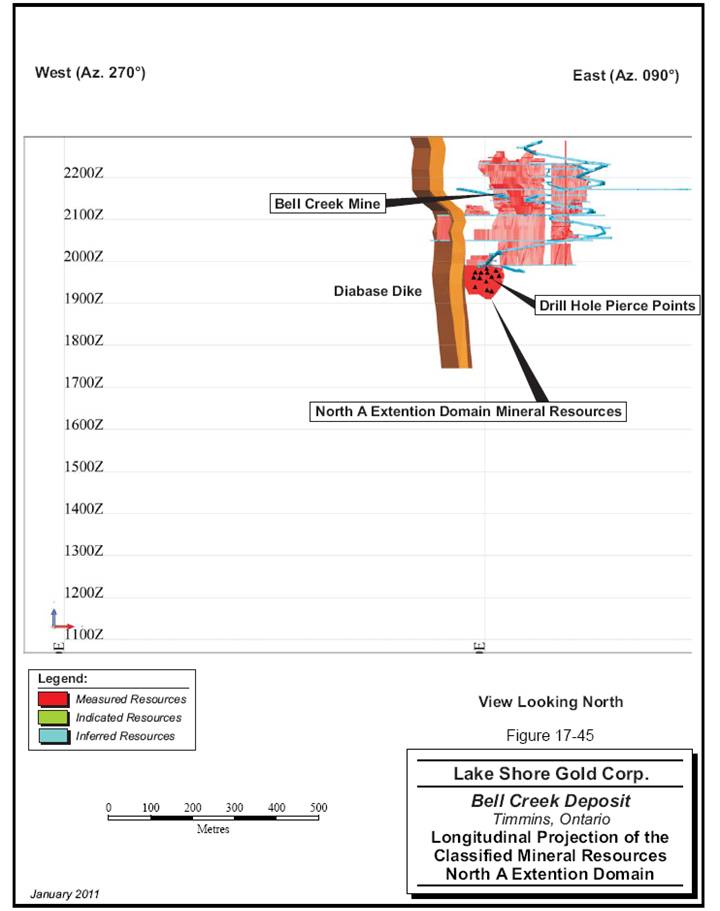
17-66
Categories of Inferred, Indicated, and Measured Mineral Resources are recognized in order of increasing geological confidence. However, Mineral Resources are not equivalent to Mineral Reserves and do not have demonstrated economic viability. There can be no assurance that Mineral Resources in a lower category may be converted to a higher category, or that Mineral Resources may be converted to Mineral Reserves. Inferred Mineral Resources cannot be converted into Mineral Reserves as the ability to assess geological continuity is not sufficient to demonstrate economic viability. Due to the uncertainty which may attach to Inferred Mineral Resources, there is no assurance that Inferred Mineral Resources will be upgraded to Indicated or Measured Mineral Resources with sufficient geological continuity to constitute Proven and Probable Mineral Reserves as a result of continued exploration.
There is a degree of uncertainty to the estimation of Mineral Reserves and Mineral Resources and corresponding grades being mined or dedicated to future production. The estimating of mineralization is a subjective process and the accuracy of estimates is a function of the accuracy, quantity, and quality of available data, the accuracy of statistical computations, and the assumptions used and judgments made in interpreting engineering and geological information. There is significant uncertainty in any Mineral Resource/Mineral Reserve estimate, and the actual deposits encountered and the economic viability of mining a deposit may differ significantly from these estimates. Until Mineral Reserves or Mineral Resources are actually mined and processed, the quantity of Mineral Resources/Mineral Reserves and their respective grades must be considered as estimates only. In addition, the quantity of Mineral Reserves and Mineral Resources may vary depending on, among other things, metal prices. Any material change in quantity of Mineral Reserves, Mineral Resources, grade or stripping ratio may affect the economic viability of the properties. In addition, there can be no assurance that recoveries in small scale laboratory tests will be duplicated in a larger scale tests under on-site conditions or during production. Fluctuation in metal or commodity prices, results of additional drilling, metallurgical testing, receipt of new information, and production and the evaluation of mine plans subsequent to the date of any estimate may require revision of such estimate. The volume and grade of reserves mined and processed and recovery rates may not be the same as currently anticipated. Estimates may have to be recalculated based on changes in mineral prices or further exploration or development activity. This could materially and adversely affect estimates of the volume or grade of mineralization, estimated recovery rates, or other important factors that influence
17-67
estimates. Any material reductions in estimates of Mineral Reserves and Mineral Resources, or the ability to extract these mineral reserves, could have a material adverse effect on Lake Shore Gold’s financial condition, results of operations, and future cash flows.
Scott Wilson RPA has considered the Mineral Resource estimates in light of known environmental, permitting, legal, title, taxation, socio-economic, marketing, political, and other relevant issues and has no reason to believe at this time that the Mineral Resources will be materially affected by these items. Given the current stage of the Bell Creek deposit’s exploration and discovery history, no studies have yet been completed that examine whether the Mineral Resources may be materially affected by mining, infrastructure, or other relevant factors. No metallurgical testing has been completed on the small number of samples taken from the newly discovered mineralization, however, historical information regarding metal recoveries is available from the production period of the Bell Creek Mine.
DISTRIBUTION OF MINERAL RESOURCES BY ROYALTY AGREEMENT
The Bell Creek Mineral Resources are subject to four separate royalty agreements (Enermark Gold Corp 1, Gold Corp 2 and Schumacher). A tabulation of the Mineral Resources by royalty holder is presented in Table 17-16 and the spatial distribution of the resources relative to the royalty claims is displayed in Figure 17-46. It can be seen that a very small amount of tonnes are located on the Gold Corp 2 royalty claim, which historically has been recognized as forming part of the Marlhill property. Given the relatively minor quantity of tonnage located on this royalty claim, this portion of the Mineral Resource is considered as forming part of the Bell Creek deposit for the purposes of this Technical Report.
17-68
TABLE 17-16 DISTRIBUTION OF MINERAL RESOURCES BY ROYALTY
CLAIMS
Lake Shore Gold Corp. — Bell Creek Deposit
Category | | Tonnes | | Uncapped
Grade
(g/t Au) | | Contained
Au
(Oz) | | Capped
Grade
(g/t Au) | | Contained
Au
(Oz) | |
Enermark Royalty | |
Total, Measured & Indicated | | 1,793,000 | | 4.44 | | 255,900 | | 4.36 | | 251,400 | |
Total, Inferred | | 5,819,000 | | 4.08 | | 762,600 | | 4.05 | | 757,400 | |
Gold Corp 1 Royalty | |
Total, Measured & Indicated | | — | | 0.00 | | — | | 0.00 | | — | |
Total, Inferred | | 2,449,000 | | 5.42 | | 426,500 | | 5.16 | | 406,200 | |
Gold Corp 2 Royalty | |
Total, Measured & Indicated | | — | | 0.00 | | — | | 0.00 | | — | |
Total, Inferred | | 7,000 | | 1.89 | | 400 | | 1.89 | | 400 | |
Schumacher Royalty | |
Total, Measured & Indicated | | — | | 0.00 | | — | | 0.00 | | — | |
Total, Inferred | | 151,000 | | 5.98 | | 29,000 | | 5.96 | | 28,900 | |
Notes:
4. CIM definitions were followed for classification of Mineral Resources.
1. Mineral Resources are estimated at a cut-off grade of 2.2 g/t Au.
2. Mineral Resources are estimated using an average long-term gold price of US$1,125 per ounce, and a US$/C$ exchange rate of 0.95.
3. A minimum mining width of 2 metres was used.
4. Capped gold grades are used in estimating the Mineral Resource average grade.
5. Sums may not add due to rounding.
6. Mr. Reno Pressacco, M.Sc.(A), P.Geo., is the Qualified Person for this resource estimate.
MINERAL RESERVES
There are no Mineral Reserves present on the Bell Creek property as of the date of this Technical Report.
17-69

17-70
18 OTHER RELEVANT DATA AND INFORMATION
No additional information or explanation is necessary to make this Technical Report understandable and not misleading.
18-1
19 ADDITIONAL REQUIREMENTS
This section is not applicable.
19-1
20 INTERPRETATION AND CONCLUSIONS
Lake Shore Gold has been conducting exploration programs at the Bell Creek mine to test for the down-dip extension of the gold mineralization that had been previously exploited. These exploration programs have been successful in tracing the down-dip extensions of both the North A horizon (the former producing horizon) and the North B horizon (a sub-parallel zone to the North A horizon), and have been successful in locating a number of new mineralized horizons at depth that appear to sub-parallel these two zones. To date, gold mineralization has been traced from surface to a depth of approximately 1,200 m and along a strike length of approximately 700 m. The depth extensions of the mineralized systems have not been defined by drilling. In addition, there is potential for additional mineralization along the eastern and western strike extensions at depth.
Additional gold mineralization is known to be present to the west of a north-south striking diabase dyke; however, the focus of exploration completed to date has been to the east of this dike. Modelling of the North A horizon has been restricted to those areas below and to the east of the workings of the former producing Bell Creek Mine such that all of the North A mineral resources are located away from these areas.
Lake Shore Gold applied a constant capping value of 34 g/t Au to the assays of the six domain models created by the company for the various mineralized horizons.
Examination of contour plots of the gold distribution for each mineralized domain suggests that the gold mineralization generally follows an overall steep plunge to the south, with a steep rake to the east.
Clipping polygons were created in longitudinal view that outline those portions of the domain model that demonstrate continuity of gold mineralization above the estimated cut-off grade of 2.2 g/t Au for each of the six mineralized domains. A sensitivity analysis was carried out to examine the impact upon the tonnage and average grade of an increase in the cut-off grade up to 5.0 g/t Au. To this end, a series of individual clipping polygons were created for each domain for a given cut-off grade and were used to prepare the various tonnage and grade reports. The results are graphically presented in Figure 20-1.
20-1
FIGURE 20-1 GRADE-TONNAGE GRAPH AS A FUNCTION OF CUT-OFF
GRADE
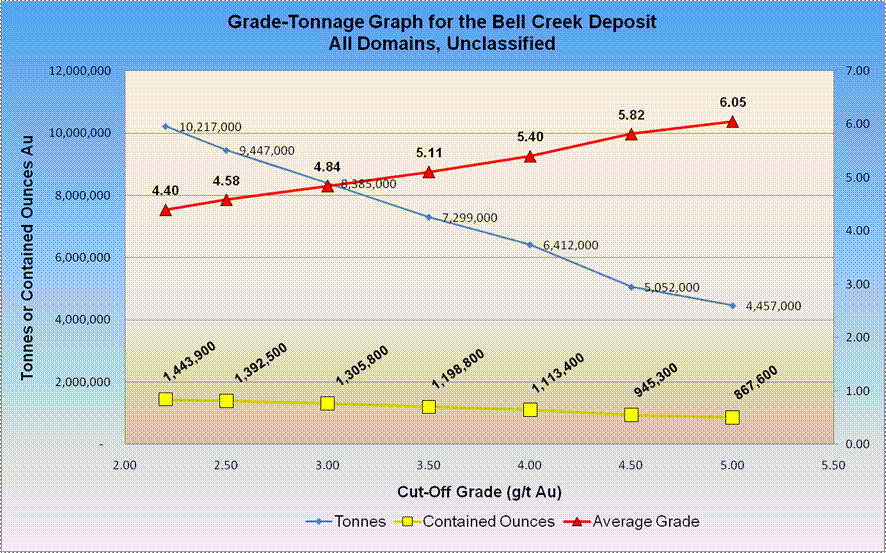
The resources were then classified into the Measured, Indicated, or Inferred categories with the assistance of the information obtained from the preliminary variography studies. The Mineral Resources are presented in Table 20-1.
TABLE 20-1 MINERAL RESOURCE ESTIMATE - NOVEMBER 2010
Lake Shore Gold Corp. — Bell Creek Deposit
Category | | Tonnes | | Capped Grade
(g/t Au) | | Oz Au | |
Measured | | 410,000 | | 4.51 | | 59,300 | |
Indicated | | 1,380,000 | | 4.32 | | 191,800 | |
Measured & Indicated | | 1,790,000 | | 4.36 | | 251,200 | |
| | | | | | | |
Inferred | | 8,427,000 | | 4.40 | | 1,192,900 | |
Notes:
1. CIM definitions were followed for classification of Mineral Resources.
2. Mineral Resources are estimated at a cut-off grade of 2.2 g/t Au.
3. Mineral Resources are estimated using an average long-term gold price of US$1,125 per ounce, and a US$/C$ exchange rate of 0.95.
4. A minimum mining width of approximately two metres was used.
5. Capped gold grades are used in estimating the Mineral Resource average grade.
6. Sums may not add due to rounding.
7. Mr. Reno Pressacco, M.Sc.(A), P.Geo., is the Qualified Person for this resource estimate.
There are no Mineral Reserves estimated for the Bell Creek property.
20-2
21 RECOMMENDATIONS
As a result of its spot check audit of the Bell Creek drill hole database, Scott Wilson RPA finds that the lithologic coding for a number of the drill holes completed by Canamax Resources Inc. (Canamax) in the database is not an accurate reflection of the descriptions in the drill log. Scott Wilson RPA recommends that a program of review/editing of the lithology codes for the Canamax drill holes be carried out prior to building a lithology model.
As well, Scott Wilson RPA notes that zero values have been inserted in the digital database for unsampled intervals. Scott Wilson RPA believes that this can result in a misleading understanding of the sampling coverage and could possibly affect assay statistics. Scott Wilson RPA recommends that a program of review/editing of the assay entries for the Canamax drill holes be carried out.
Scott Wilson RPA recommends that continued studies, in conjunction with accurate reconciliation studies, be carried out in the future to refine the capping level estimates.
Scott Wilson RPA recommends that additional density readings be determined for all six of the mineralized domains in a systematic manner.
The initial mineralization domain models have been prepared using criteria that take into consideration such items as the intensity and style of alteration, the intensity and style of quartz veining, and the gold contents of the mineralized zones. These criteria have been successful in outlining a number of mineralized domains in which the overall trend of the gold mineralization is as steeply south-plunging shoots. Trend analysis suggests that other controls may be affecting the distribution of gold on a more local level. Consequently, Scott Wilson RPA recommends building a lithologic model to improve the understanding of the structural controls at Bell Creek. As well, a lithology model may assist future mine planning studies.
The gold grades contained in the initial block model were interpolated using an inverse distance squared algorithm. Scott Wilson RPA recommends that the gold grades of any future block models also be estimated using the ordinary kriging as an additional cross check.
21-1
It can be seen that the limits of the gold mineralization remain open both along strike and down dip. Additional drilling is clearly warranted to extend the limits of the mineralization. As well, in-fill drilling is recommended in the Inferred areas.
Scott Wilson RPA also recommends that metallurgical testing be carried out on representative samples from each mineralized domain. As well, geotechnical studies should be carried out to support future mine planning studies.
21-2
22 REFERENCES
Aitken, S.A., 1990: The Pamour One Mine-Site Investigation, Timmins, Ontario: Unpublished M.Sc Thesis, Queen’s University, Kinston, Ontario, 194 p.
Ayer J., Trowell, N. (OGS), Amelin, Y., Kamo, S., and Kwok, Y. (ROM), 2000: PowerPoint Presentation: Deep Crustal Structures In The Abitibi Greenstone Belt And Their Prolonged Control On Distribution Of Stratigraphy And Mineral Deposits, Toronto, Ontario. January 2000.
Barrie, C.T., 1992: Geology of the Kamiskotia Area, Ontario Geological Survey Open File Report 5829.
Bateman, R., Ayer, J.A., Dubé, B, and Hamilton, M.A., 2005: the Timmins-Porcupine Gold Camp, Northern Ontario: The Anatomy of an Archean Greenstone Belt and its Gold Mineralization: Discovery Abitibi Initiative, Open File Report 6158, Ontario Geological Survey.
Berger, B.R., 1998: Precambrian Geology, Hoyle and Gowan Townships, Ontario Geological Survey, Report 299, 49p.
Brisbin, D.I., 1997: Geological Setting of Gold Deposits in the Porcupine Mining District, Timmins, Ontario; unpublished PhD Thesis, Queen’s University, Kingston, Ontario, 523 p.
Butler, H.R., 2008: Technical (Geological) Report on Bell Creek Complex, Hoyle Township, Porcupine Mining Division, Ontario, Canada., Prepared for Lake Shore Gold Corp.; Unpublished Document available on the SEDAR web site at www.SEDAR.com, 63 p.
Coad, P.R., Labine, R.J., and Caron, D., 1986: Owl Creek Mine, in Gold ‘86 Excursion Guidebook, pp. 34-36.
Corfu, F., Krogh, T.E., Kwok, Y.Y., and Jensen, L.S., 1989: U-Pb Zircon Geochronology In The Southwestern Abitibi Greenstone Belt, Superior Province. Canadian Journal of Earth Sciences, v. 26.
Cox, S., 2000: Controls On localisation Of Mesothermal Gold Systems - Applications of Stress Transfer Modelling. Australian National University summary
Crick, D., 1997: Schumacher (III) Property. “Drill-Indicated Resource Estimate”
Discover Abitibi Mission Statement, 2010: Retrieved December 17, 2010 (URL: http://www.discoverabitibi.com/mission-state)
Dougherty, E.Y., 1934: Mining of the Vipond Gold Mine, Porcupine District, Ontario. Transactions of the Canadian Institute of Mining and Metallurgy and of the Mining Society of Nova Scotia. v. 37
Fryer, B.J., Kerrich, R., Hutchinson, R.W., Pierce, M.G., and Rogers, D.S., 1979: Archean Precious Metal Hydrothermal Systems, Dome Mine, Abitibi Greenstone Belt.
22-1
I. Patterns of Alteration and Metal Distribution. Canadian Journal of Earth Sciences, v.16.
Griffis, A.T., 1960: Stratigraphy at McIntyre; Unpublished Report, McIntyre Mines Limited.
Hall, R.S., and Rigg, D.M., 1986: Geology of the West Anticline Zone, Musselwhite Prospect, Opapimiskan Lake, Ontario, Canada in Macdonald, A.J., Downes, M., and Chater, A.M., eds., Proceedings of Gold ‘86
Heaman, L.M. 1988: A Precise U-Pb Zircon Age for a Hearst Dyke: Geological Association of Canada Program with Abstracts, v. 13, p. A53.
Holmes, T.C., 1968: Dome Mines Limited: in Geology and Ore Deposits of Tisdale Township, Edited by S.A. Ferguson et al., Ontario Department of Mines, Geological Report 58, pp. 82-98.
Jackson, S.L., and Fyon, J.A., 1991: Geology of Ontario, Special Volume 4, Part 1, Chapter 11, the Western Abitibi Subprovince in Ontario, Ontario Geological Survey, pp. 405-482.
Jackson, S.L., and Fyon, J.A., 1991: Geology of Ontario, Special Volume 4, Part 2, Chapter 22, The Metallogeny of Metallic Mineral Deposits in the Superior Province of Ontario, Ontario Geological Survey, p. 1149.
Kent, G., 1990: Bell Creek and Marlhill Mine Area: in Field Trip Guidebook, 8th IAGOD Symposium, J. A. Fyon and A. H. Green eds., Geological Survey of Canada Open File 2161, pp. 1124—1128.
Lake Shore Gold Corp., 2010: Annual Information Form for the Year Ending December 31, 2009. Dated as of March 10, 2010. Retrieved December 16, 2010 (URL: lsgold-com.sitepreview.ca/SiteResources/data/MediaArchive/.../AIF2010.pdf
Lake Shore Gold Corp., 2010: Bell Creek Mine: Lake Shore Gold web site, visited November 17, 2010 (URL: http://lsgold.com/SiteResources/ViewContent.asp? DocID=150&v1ID=&RevID=601&lang=1#BellCreekMine).
Lakefield Research of Canada Limited, 1983: The Investigation Of The Recovery of Gold From Samples Submitted By Amax Incorporated. Progress Report No. 1. Project No. LR2686, October 5, 1983.
Lakefield Research of Canada Limited, 1985: The Investigation Of The Recovery of Gold From Samples Submitted By Amax Incorporated. Progress Report No. 2. Project No. LR2686, April 17, 1985.
Mason, R., and Melnik, N., 1986: The Anatomy of an Archean Gold System — The McIntyre-Hollinger Complex at Timmins, Ontario, Canada in Proceedings Volume, Gold 86; an International Symposium of the Geology of Gold Deposits, pp. 40-56.
Mortensen, J.K., 1987: U-Pb Geochronostratigraphy of the Abitibi Greenstone Belt (abstract): Geological Association of Canada-Mineralogical Association of Canada Joint Annual Meeting, Program with Abstracts, v. 12, p. A75.
22-2
Pressacco, R., ed., 1999: Economic Geology and Mineralization of the Marlhill Mine in Special Project: Timmins Ore Deposits Descriptions: Ontario Geological Survey, Open File Report 5985, 189 p.
Powers, D.H.R., 2009: A Technical Review and Report for The Bell Creek Complex Properties, Exploration Diamond Drill Programs, August 2005 to July 31, 2009. Prepared for Lake Shore Gold Corp. September 30, 2009; Unpublished Document available on the SEDAR web site at www.SEDAR.com, 225 p.
Pyke, D.R., 1982: Geology of the Timmins area, District of Cochrane; Ontario Geological Survey, Report 219, 141 p.
Rhys, D.A., 2003: Structural Mapping Study of the Surface Outcrops of the Holmer Gold Deposit, Timmins, Ontario, Internal Lake Shore Gold Corp. Report by Panterra Geoservices Inc, Surrey, British Columbia.
22-3
23 DATE AND SIGNATURE PAGE
This report titled “Technical Report on the Initial Mineral Resource Estimate for the Bell Creek Mine, Hoyle Township, Timmins, Ontario, Canada” and dated January 14, 2011, was prepared and signed by the following author:
| | (Signed & Sealed) |
| | |
Dated at Toronto, Ontario | | |
January 14, 2011 | | Reno Pressacco, M.Sc.(A), P.Geo. |
| | Associate Consulting Geologist |
23-1
24 CERTIFICATE OF QUALIFIED PERSON
RENO PRESSACCO
I, Reno Pressacco, M.Sc.(A), P.Geo., as an author of this report entitled “Technical Report on the Initial Mineral Resource Estimate for the Bell Creek Mine, Hoyle Township, Timmins, Ontario, Canada” prepared for Lake Shore Gold Corp. and dated January 14, 2011, do hereby certify that:
1. I am an Associate Consulting Geologist with Scott Wilson Roscoe Postle Associates Inc. of Suite 501, 55 University Ave., Toronto, ON, M5J 2H7. I was Senior Consulting Geologist with Scott Wilson RPA at the time of preparation of the Mineral Resource estimate.
2. I am a graduate of Cambrian College of Applied Arts and Technology, Sudbury, Ontario, in 1982 with a CET Diploma in Geological Technology, Lake Superior State College, Sault Ste. Marie, Michigan, in 1984, with a B.Sc. degree in Geology and McGill University, Montreal, Québec, in 1986 with a M.Sc.(A) degree in Mineral Exploration.
3. I am registered as a Professional Geologist in the Province of Ontario (Reg.# 939). I have worked as a professional geologist for a total of 25 years since my graduation. My relevant experience for the purpose of the Technical Report is:
· Review and report as a consultant on numerous exploration and mining projects around the world for due diligence and regulatory requirements, including preparation of Mineral Resource estimates and NI 43-101 Technical Reports.
· Numerous assignments in North, Central and South America, Finland, Russia, Armenia and China in a variety of deposit types and in a variety of geological environments; commodities including Au, Ag, Cu, Zn, Pb, Ni, Mo, U, PGM and industrial minerals.
· A senior position with an international consulting firm.
4. I have read the definition of “qualified person” set out in National Instrument 43-101 (NI 43-101) and certify that by reason of my education, affiliation with a professional association (as defined in NI 43-101) and past relevant work experience, I fulfill the requirements to be a “qualified person” for the purposes of NI 43-101.
5. I visited the Bell Creek property on April 19 to April 21, 2010.
6. I am responsible for overall preparation of the Technical Report.
7. I am independent of the Issuer applying the test set out in Section 1.4 of NI 43-101.
8. I have had prior involvement with the property that is the subject of the Technical Report, being the activities described in Pressacco, 1999.
9. I have read NI 43-101, and the Technical Report has been prepared in compliance with NI 43-101 and Form 43-101F1.
24-1
10. To the best of my knowledge, information, and belief, the Technical Report contains all scientific and technical information that is required to be disclosed to make the Technical Report not misleading.
Dated this 14th day of January, 2011.
(Signed & Sealed)
Reno Pressacco, M.Sc.(A)., P.Geo.
24-2
25 APPENDIX 1
VARIOGRAMS
25-1
FIGURE A25-1 NORTH A DOMAIN VARIOGRAMS
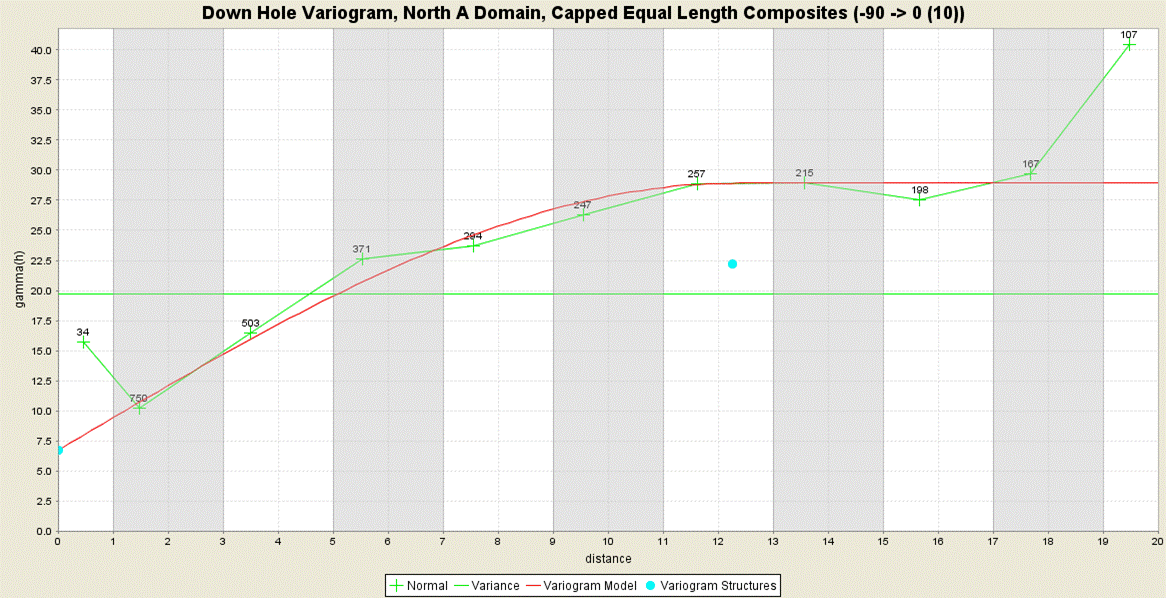
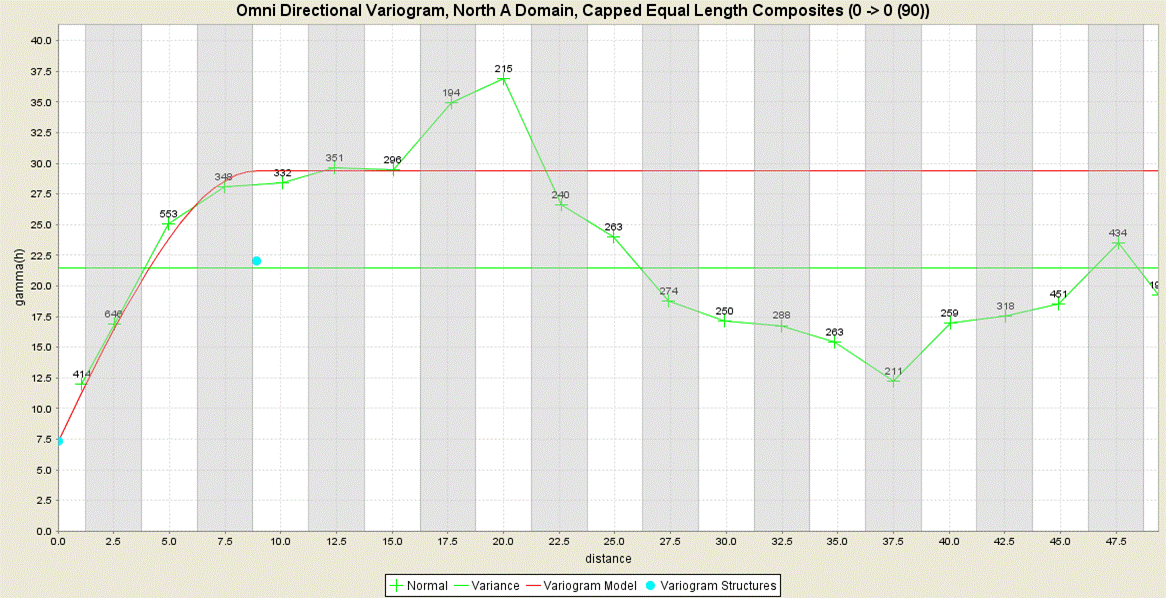
25-2
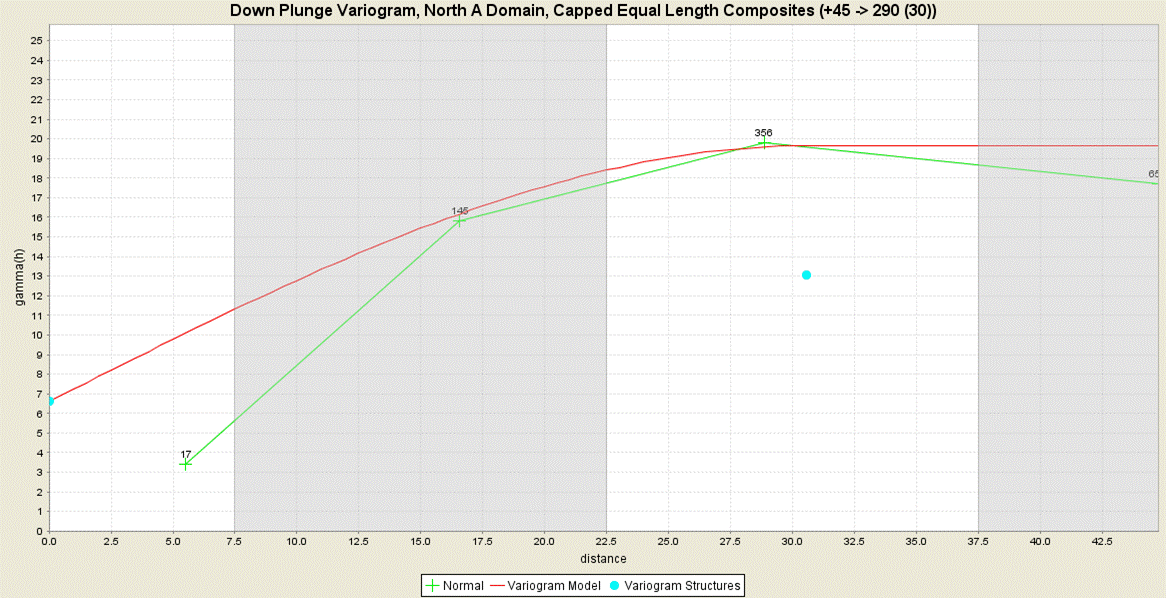
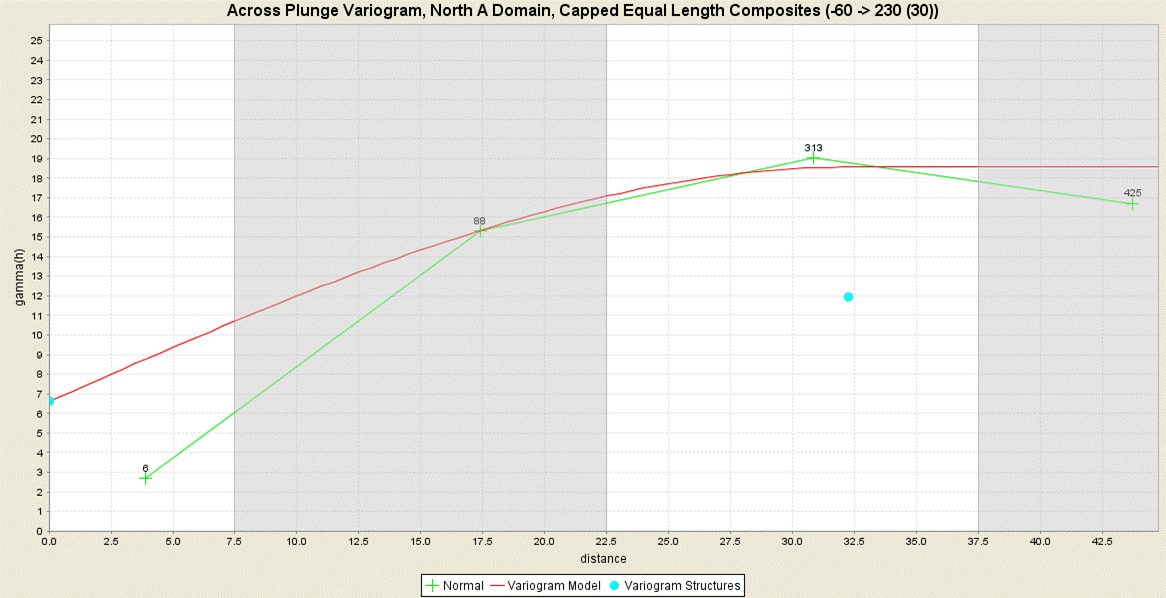
25-3
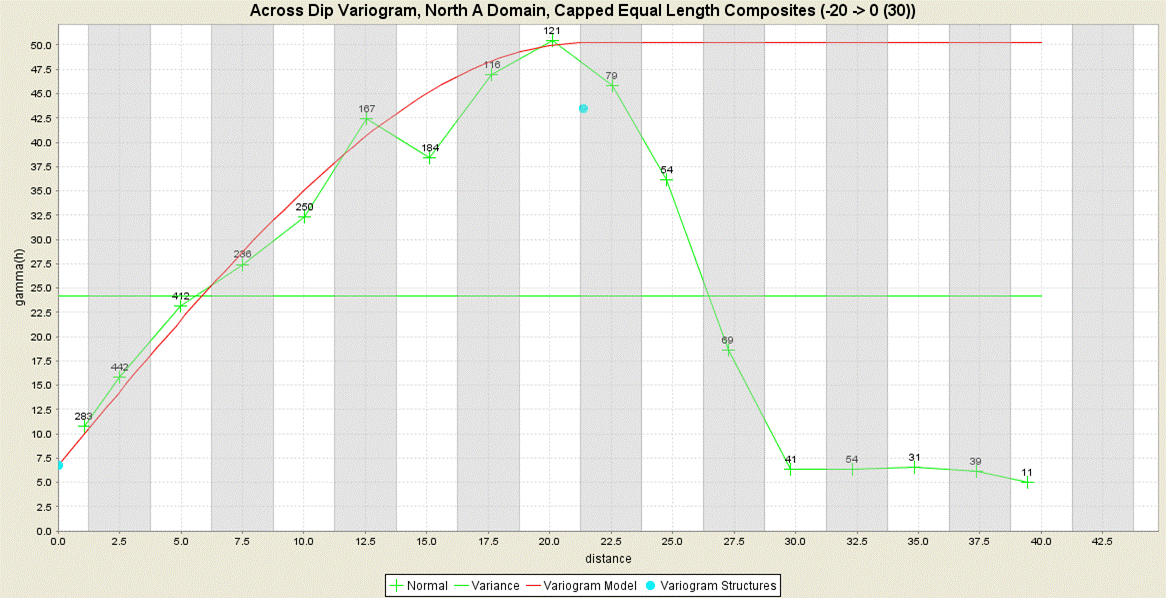
25-4
FIGURE A25-2 NORTH B DOMAIN VARIOGRAMS
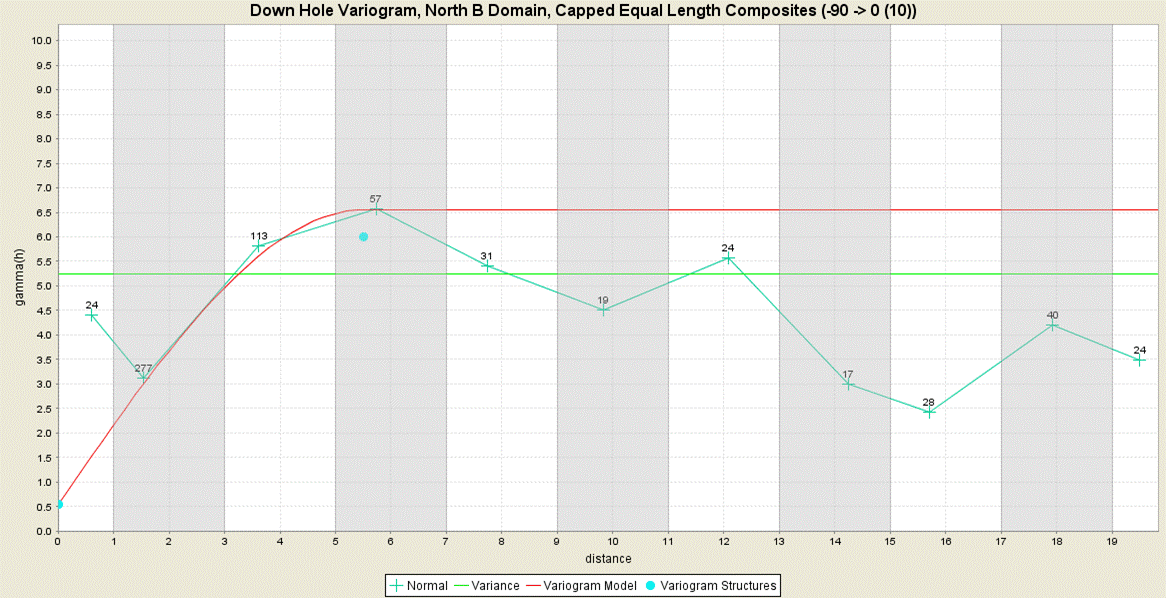
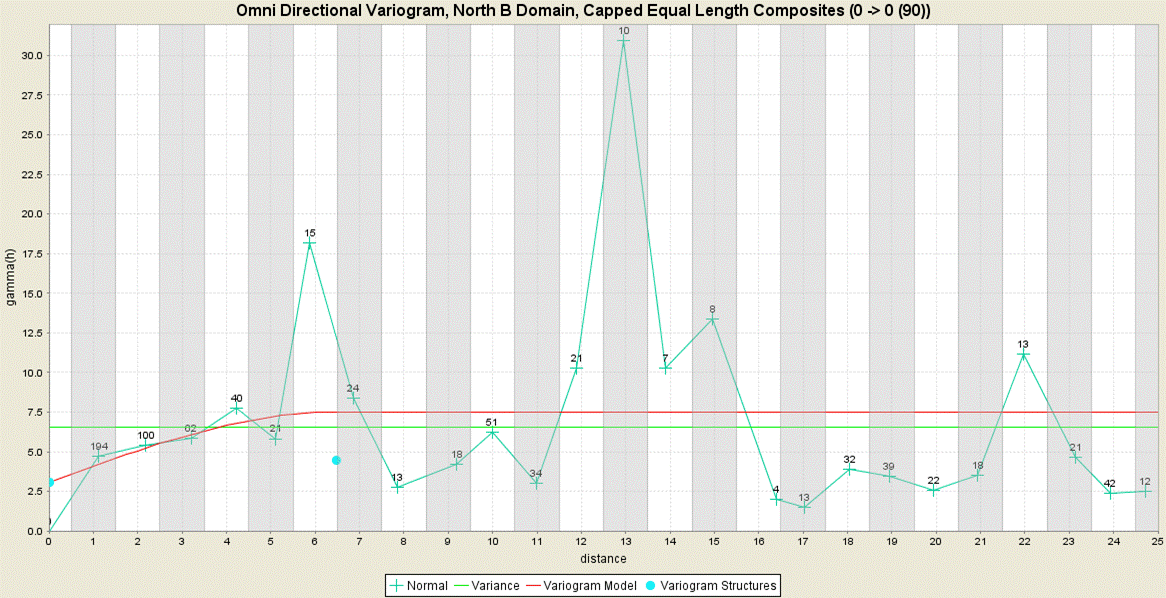
25-5
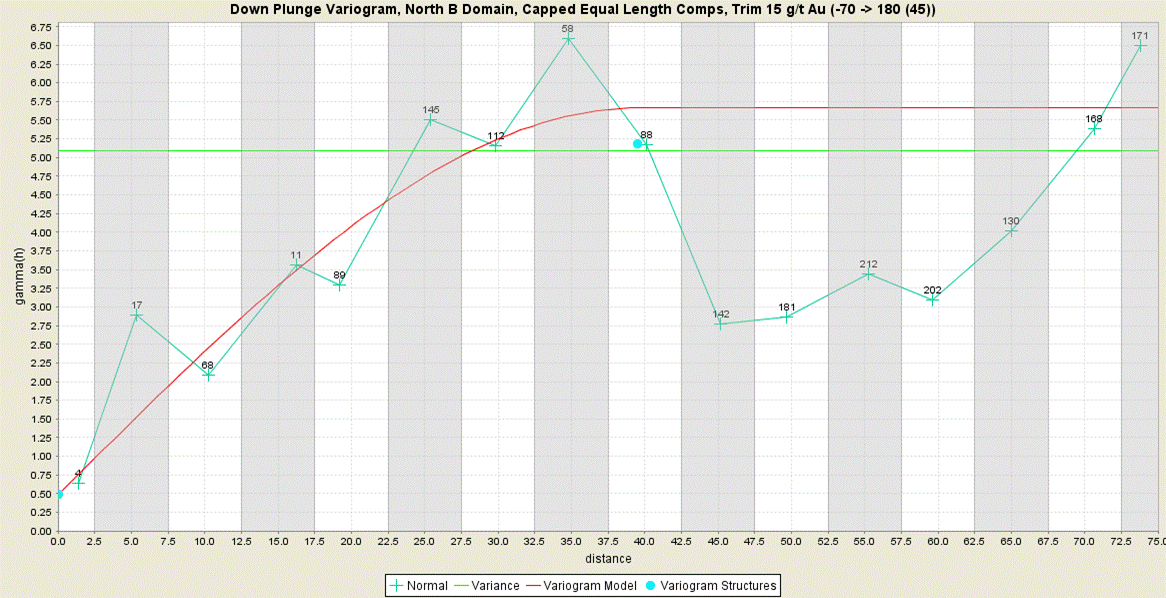
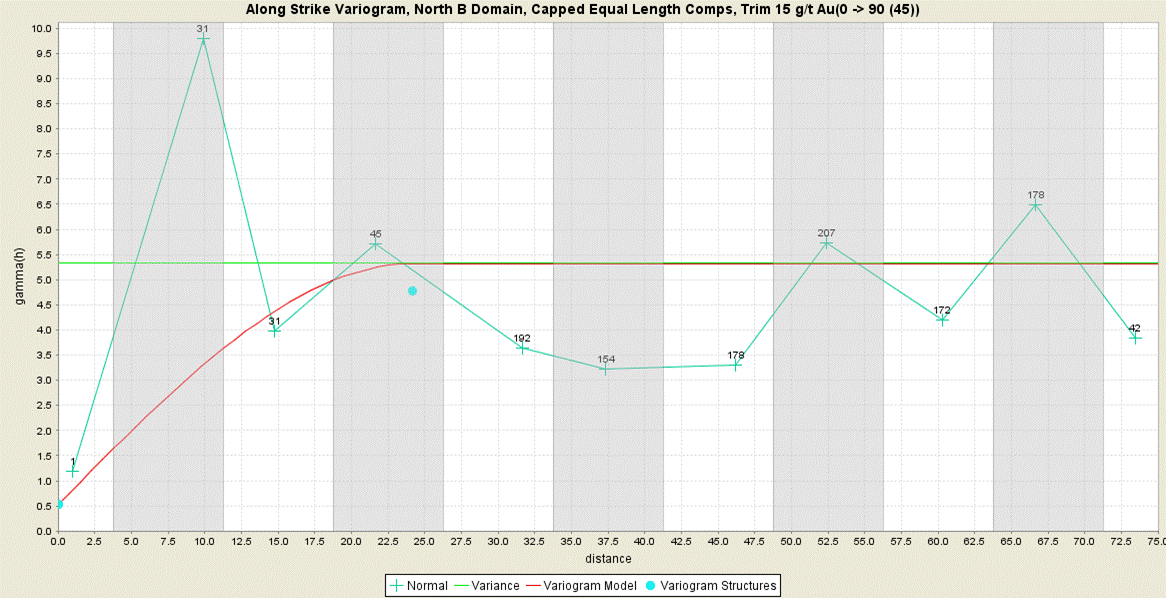
25-6
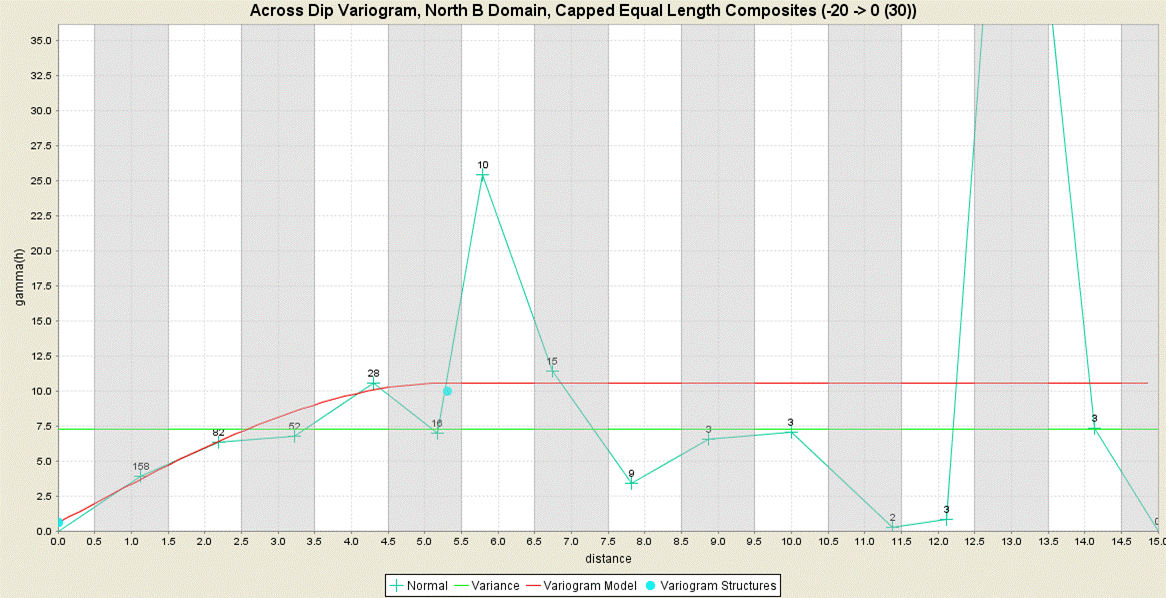
25-7
26 APPENDIX 2
QA/QC CONTROL CHARTS
26-1
FIGURE A26-1 BELL CREEK DEPOSIT CHECKED ASSAYS (2009)

26-2
FIGURE A26-2 BELL CREEK DEPOSIT BLANKS
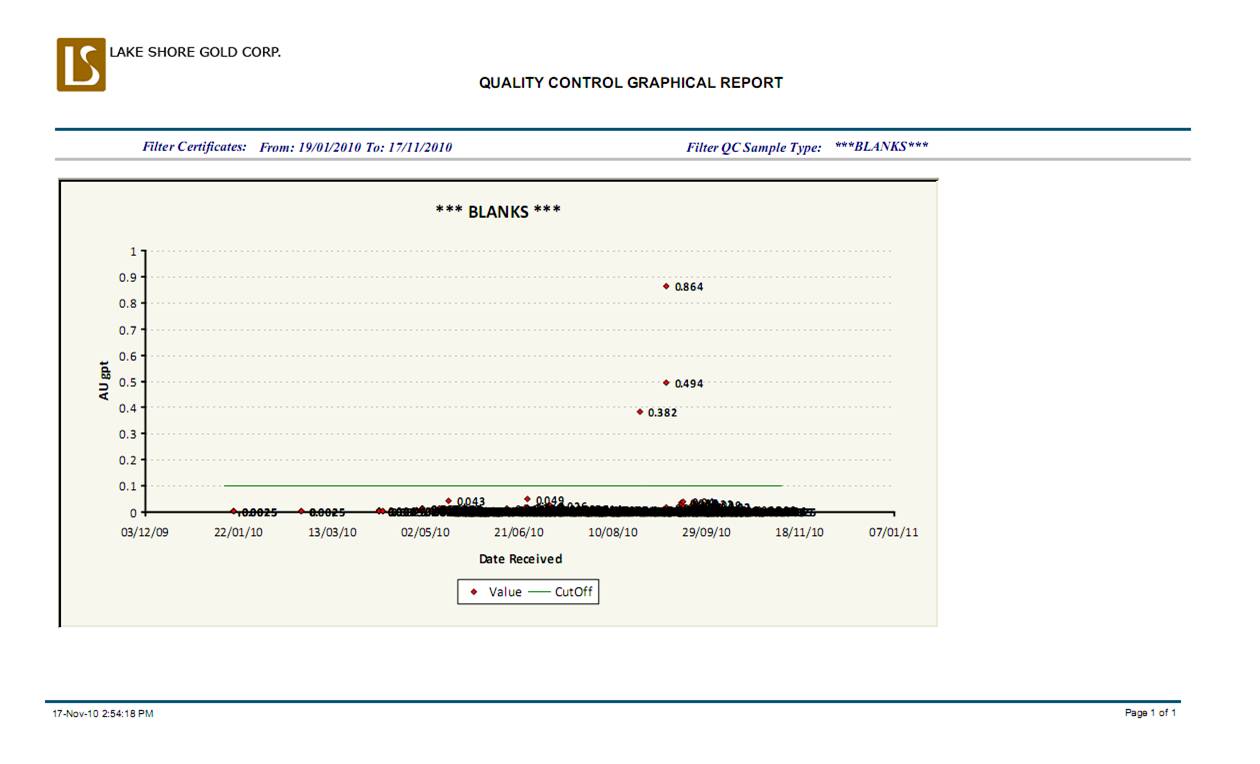
26-3
FIGURE A26-3 BELL CREEK DEPOSIT STANDARDS
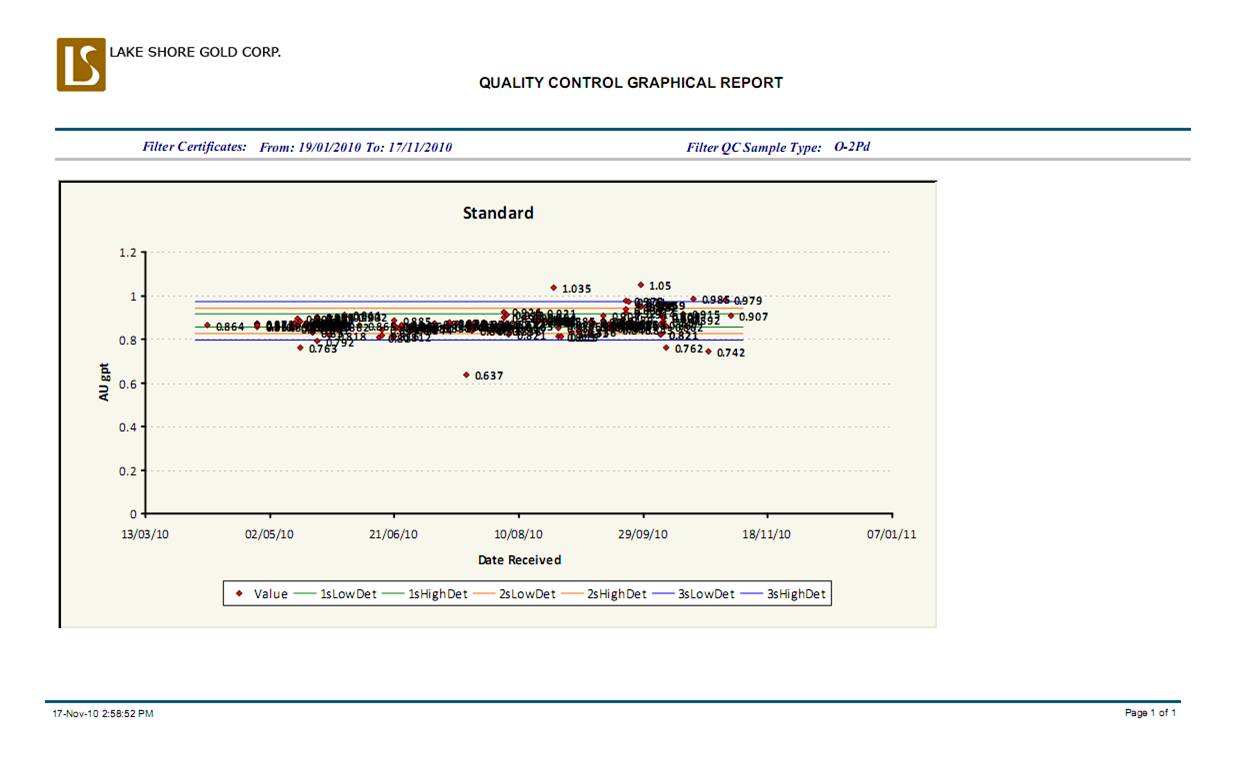
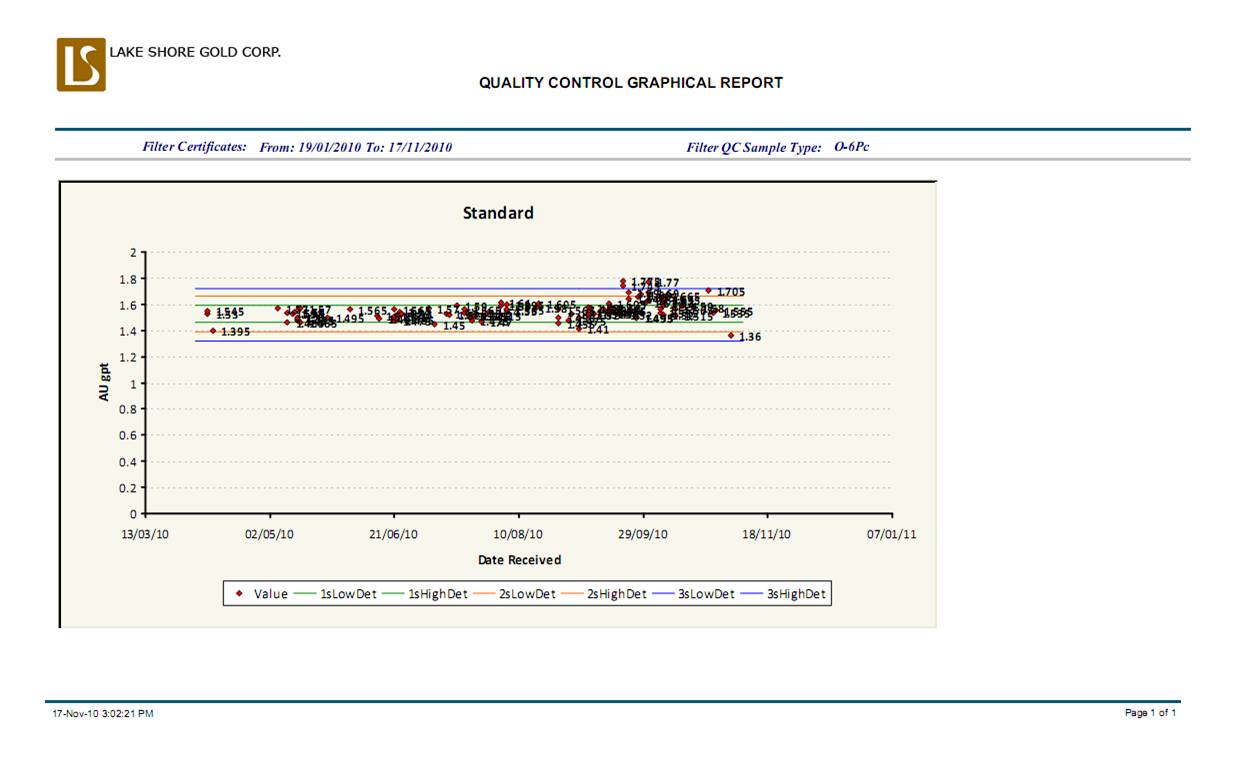
26-4
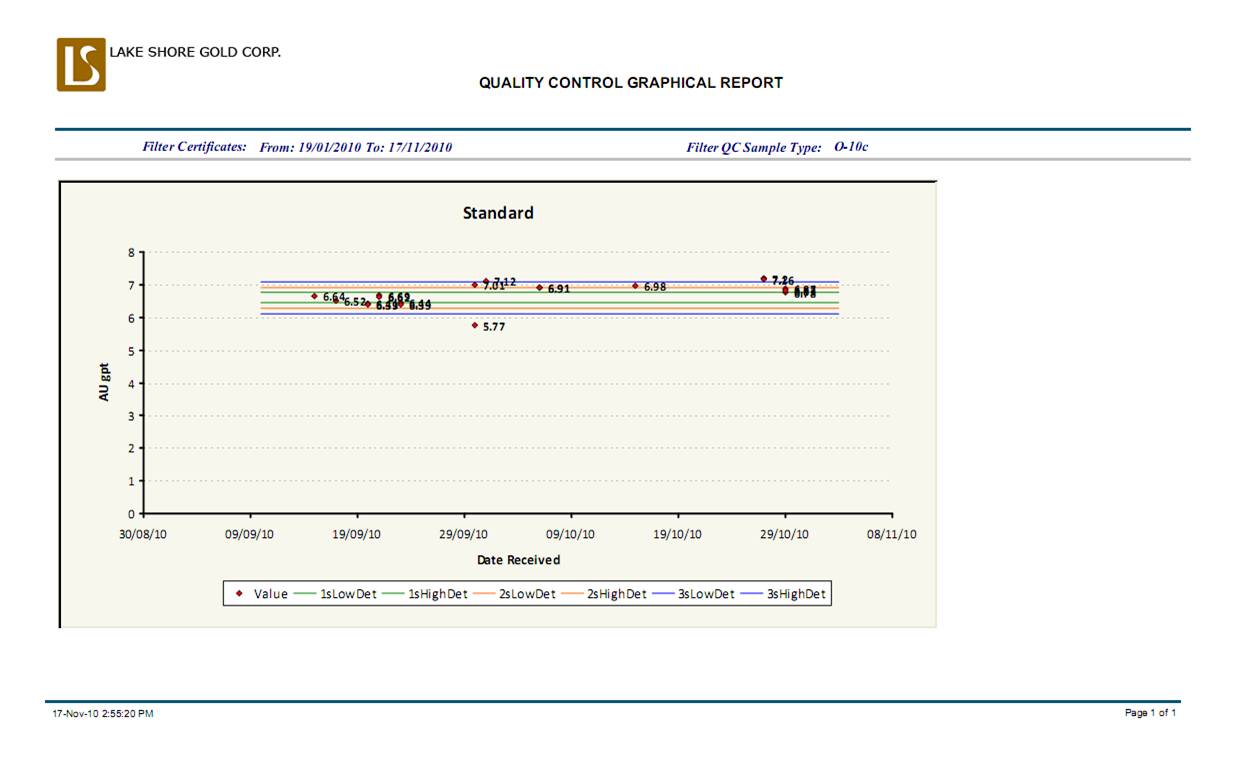
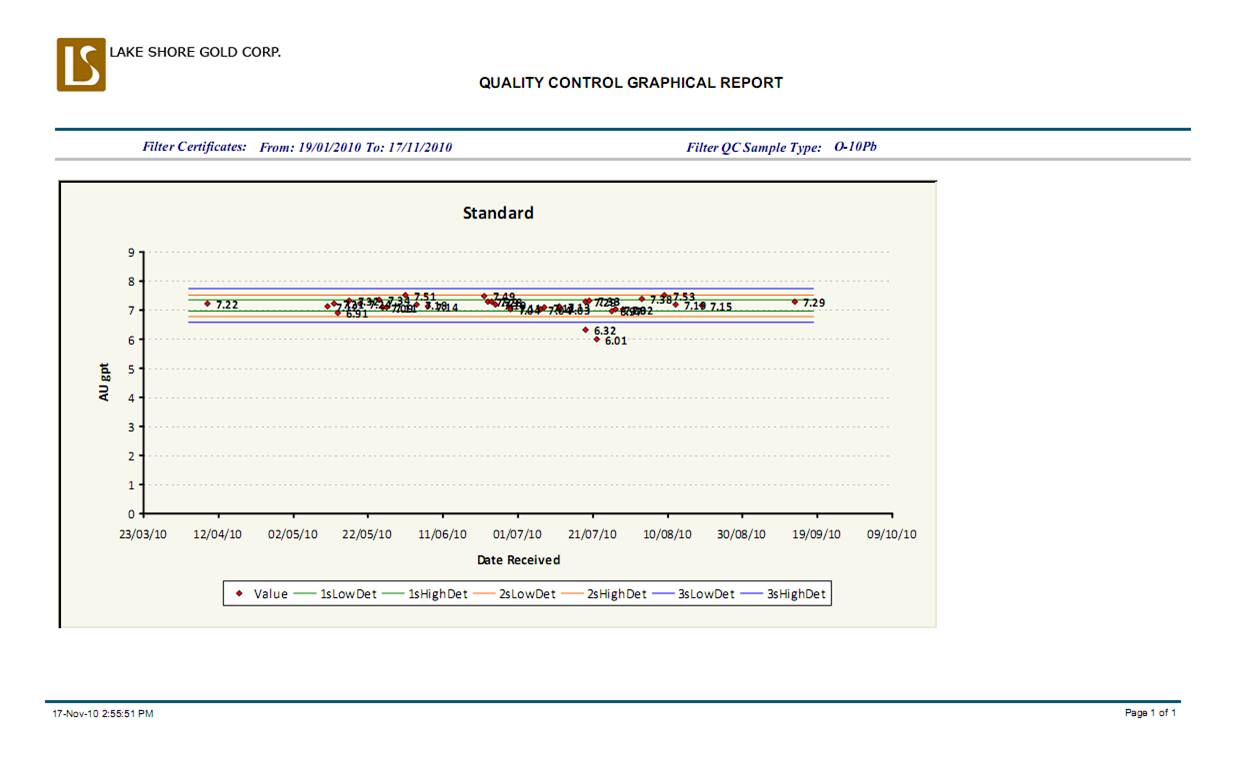
26-5

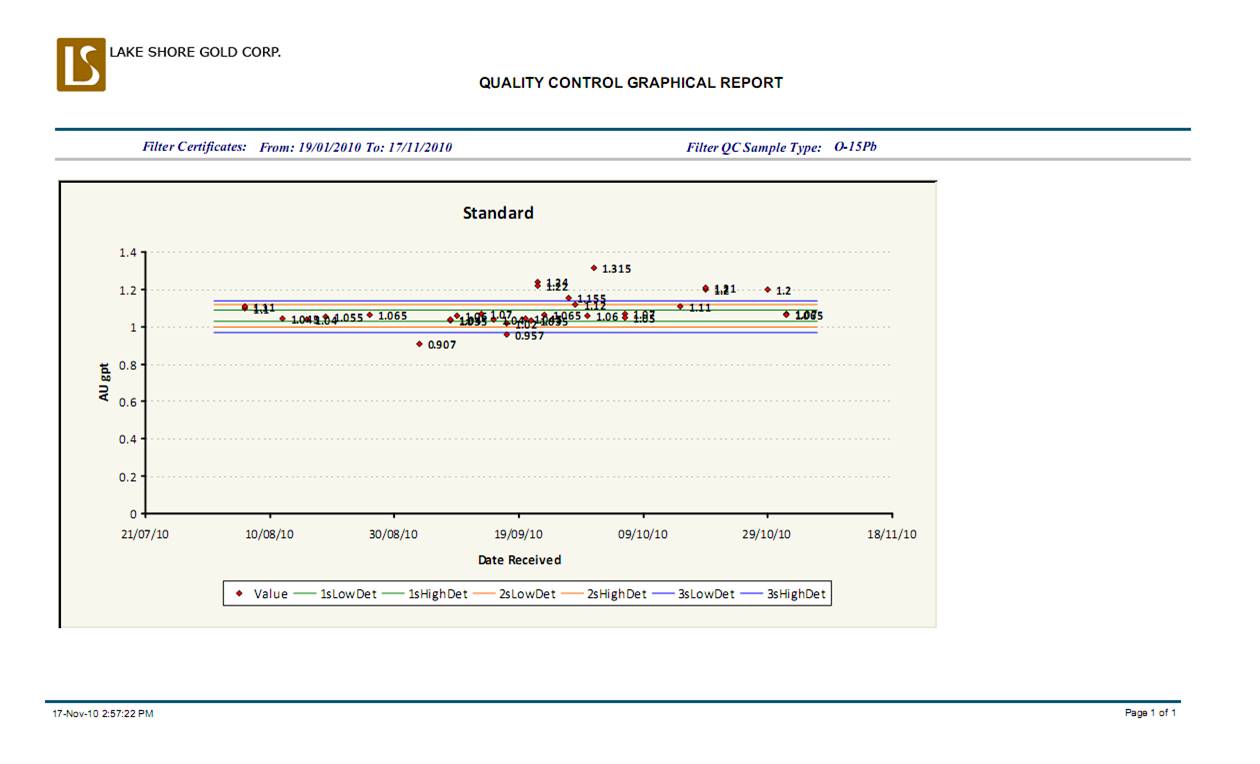
26-6
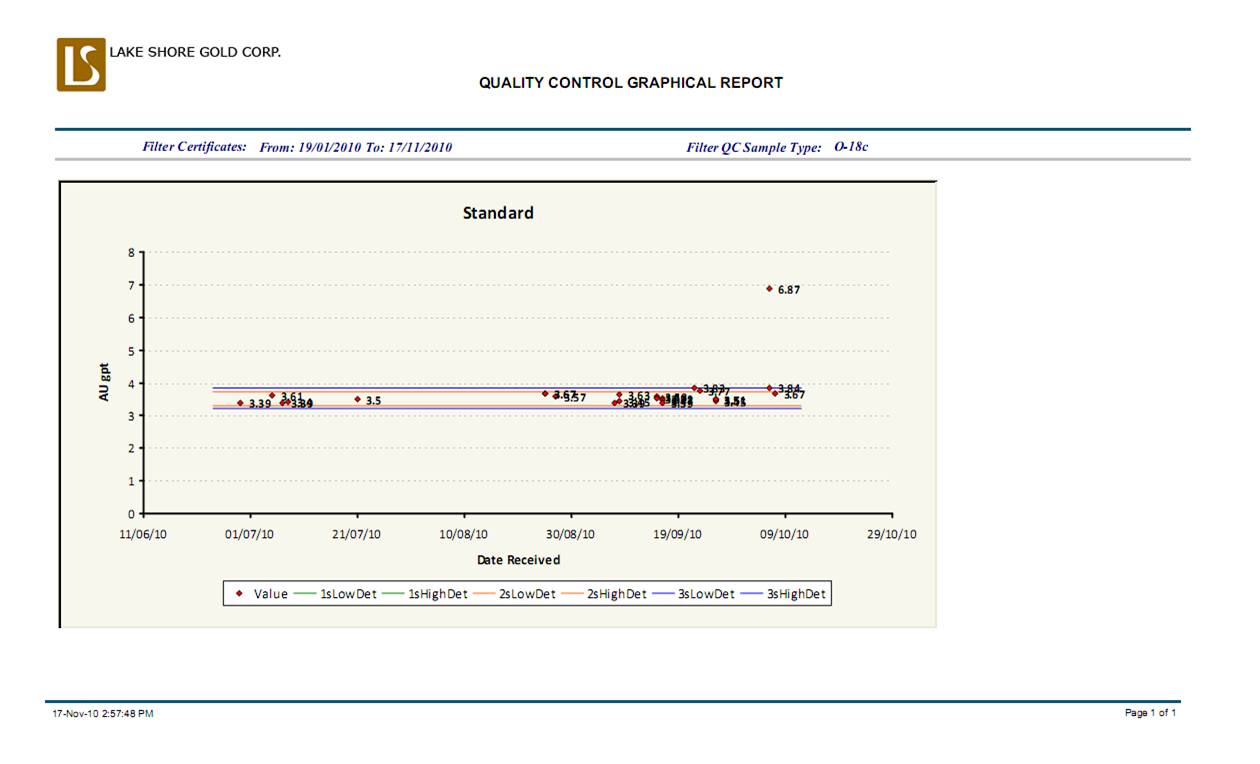
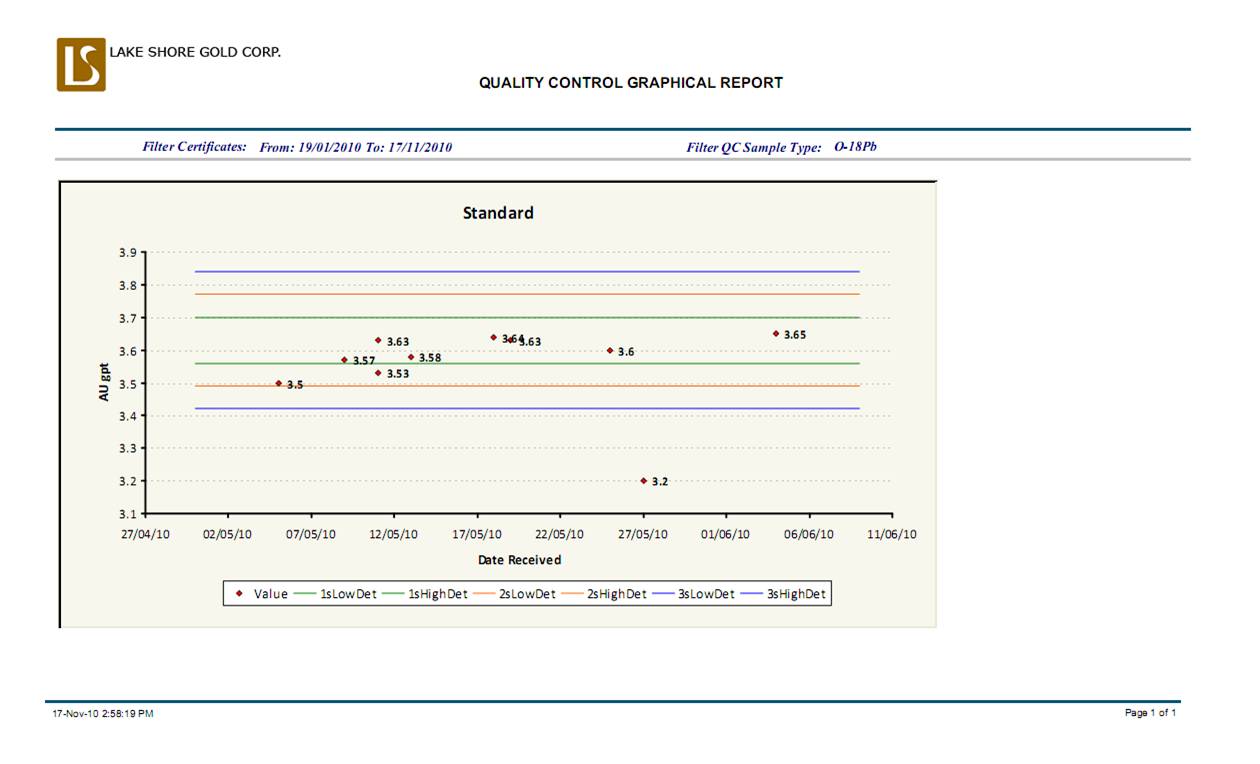
26-7
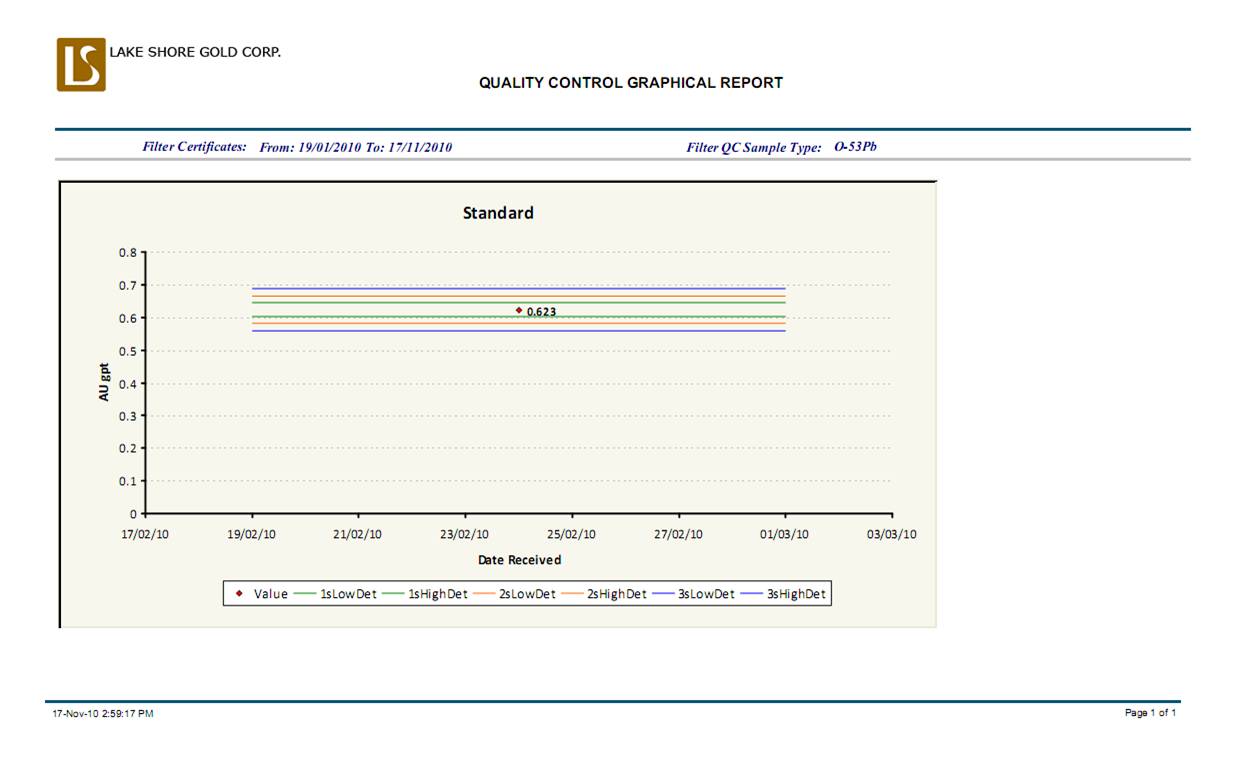
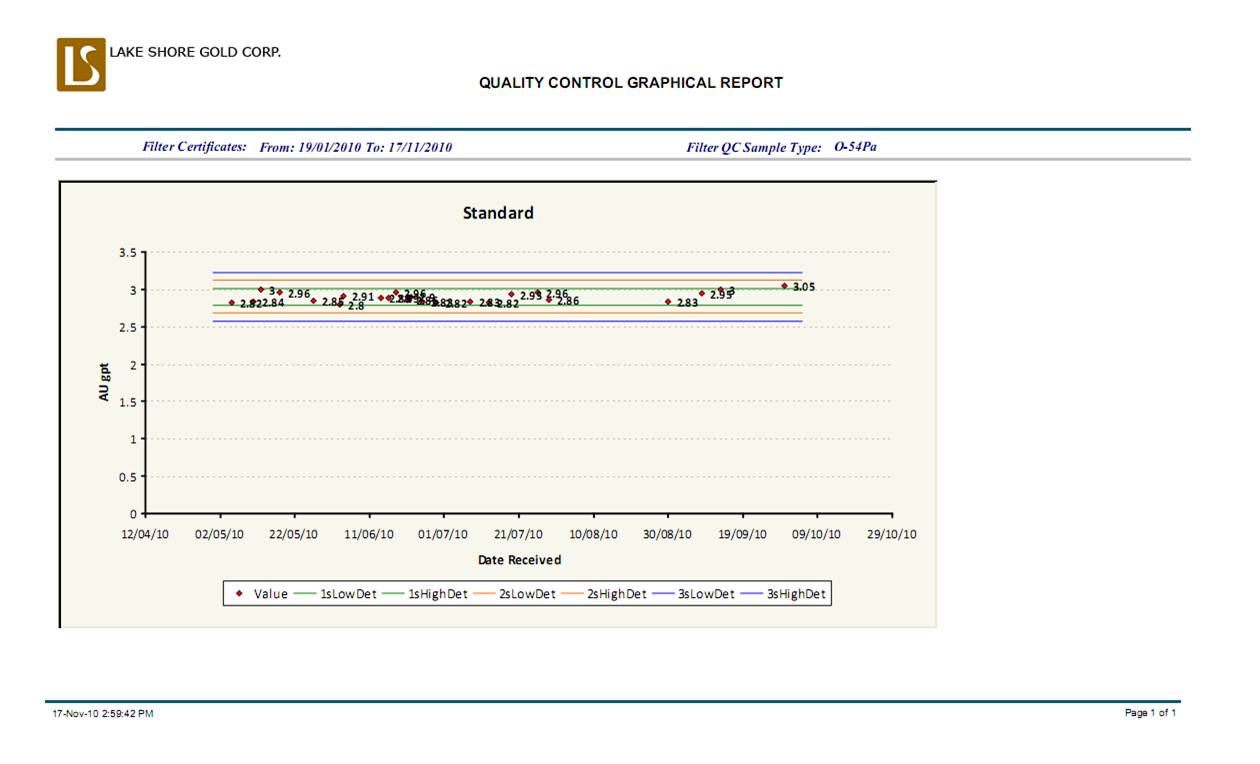
26-8
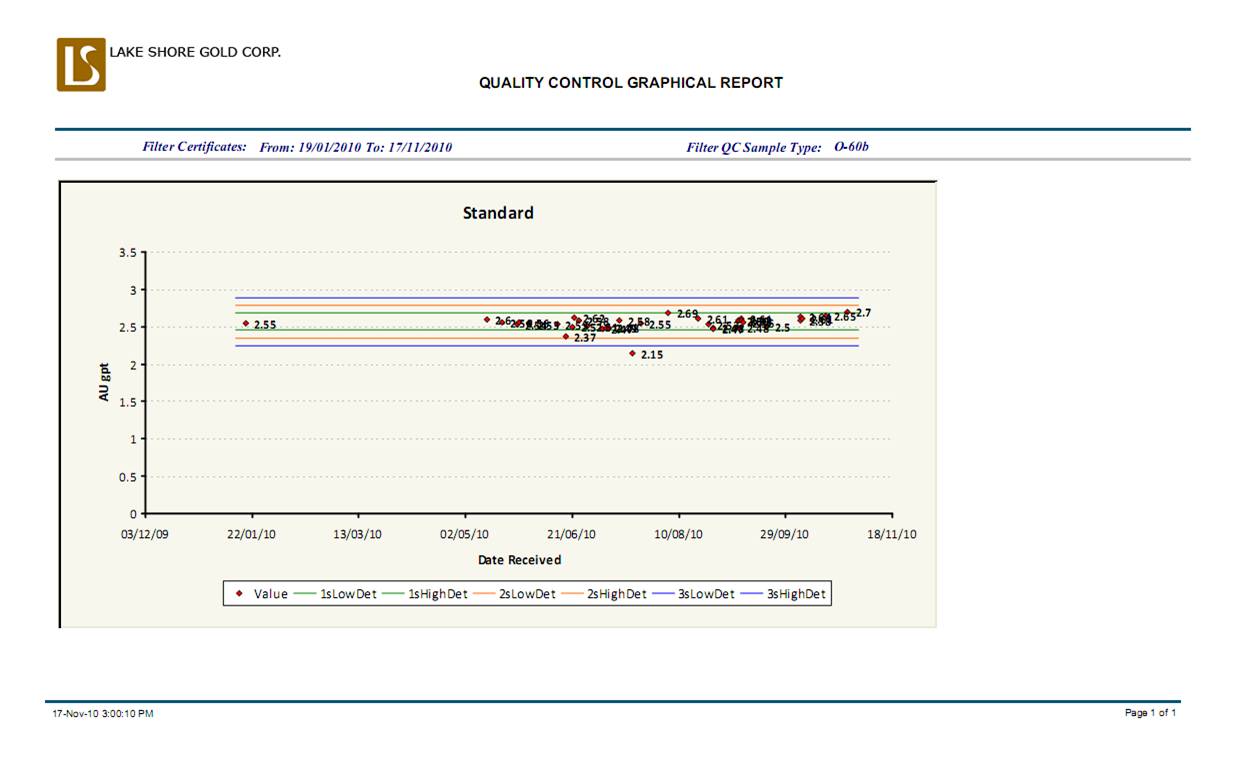
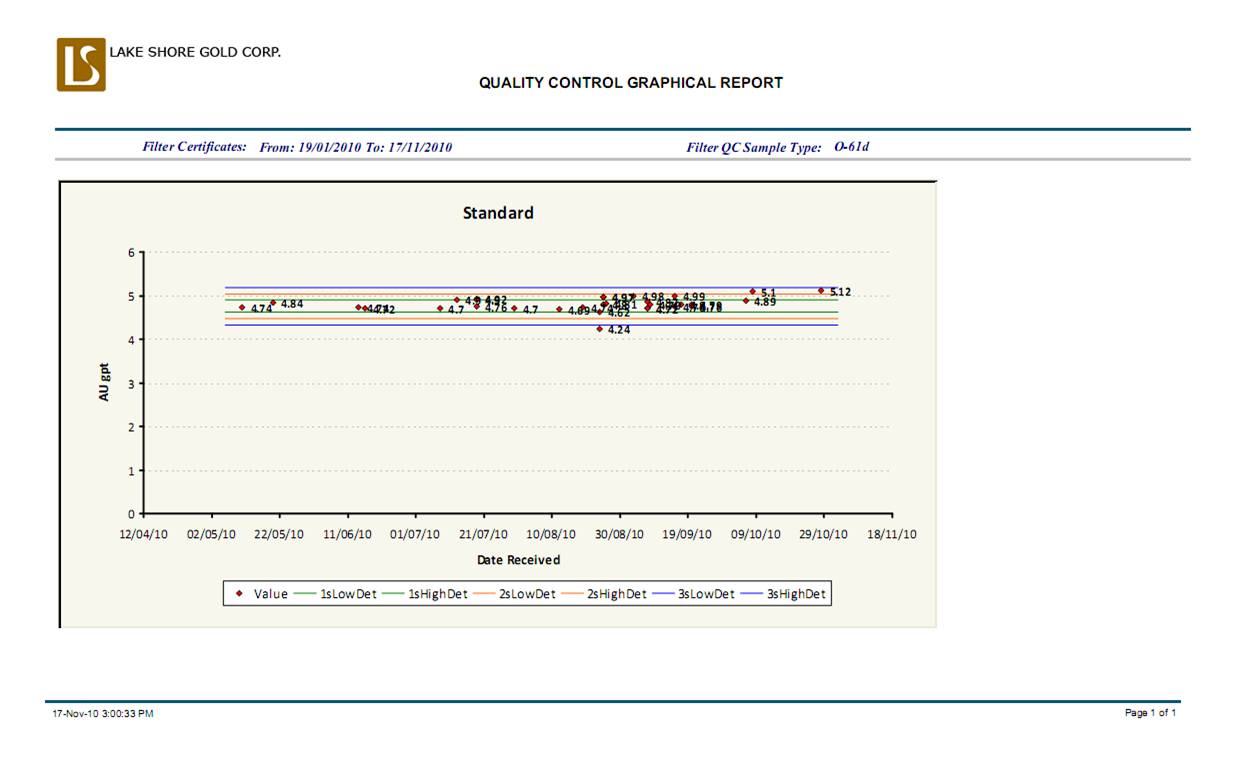
26-9
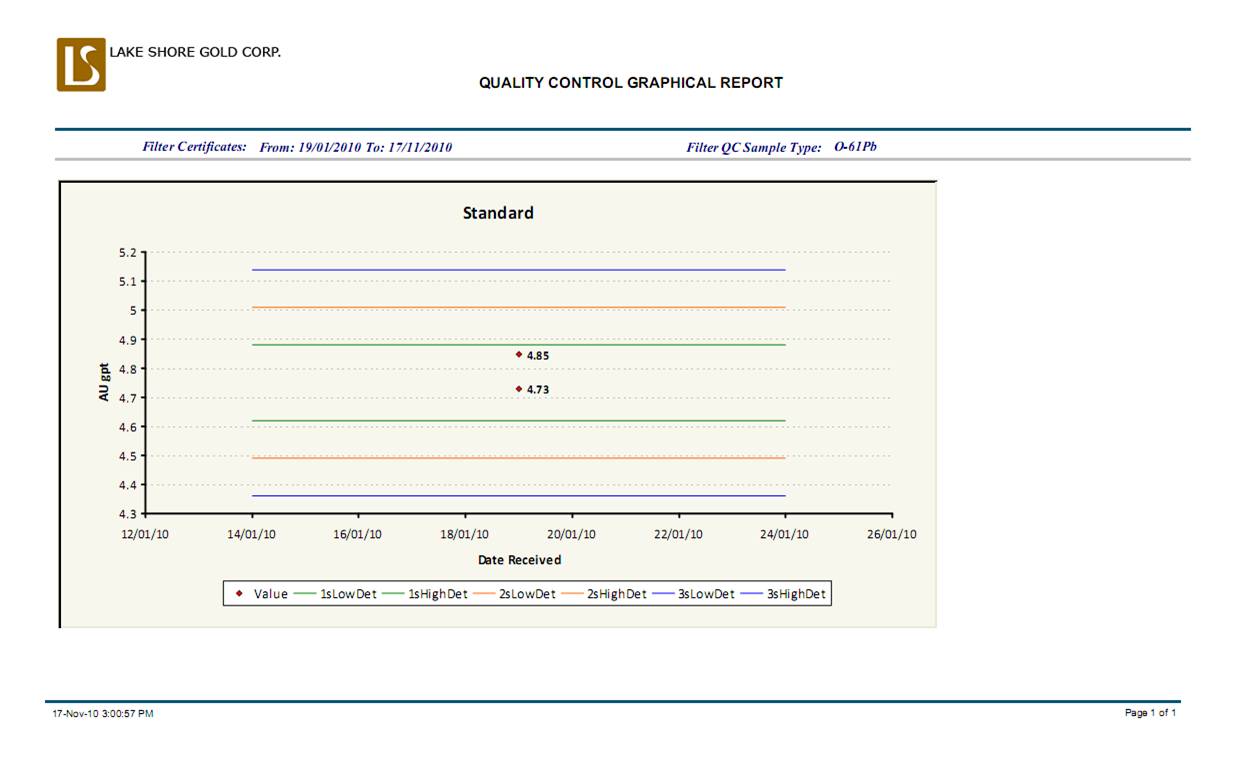
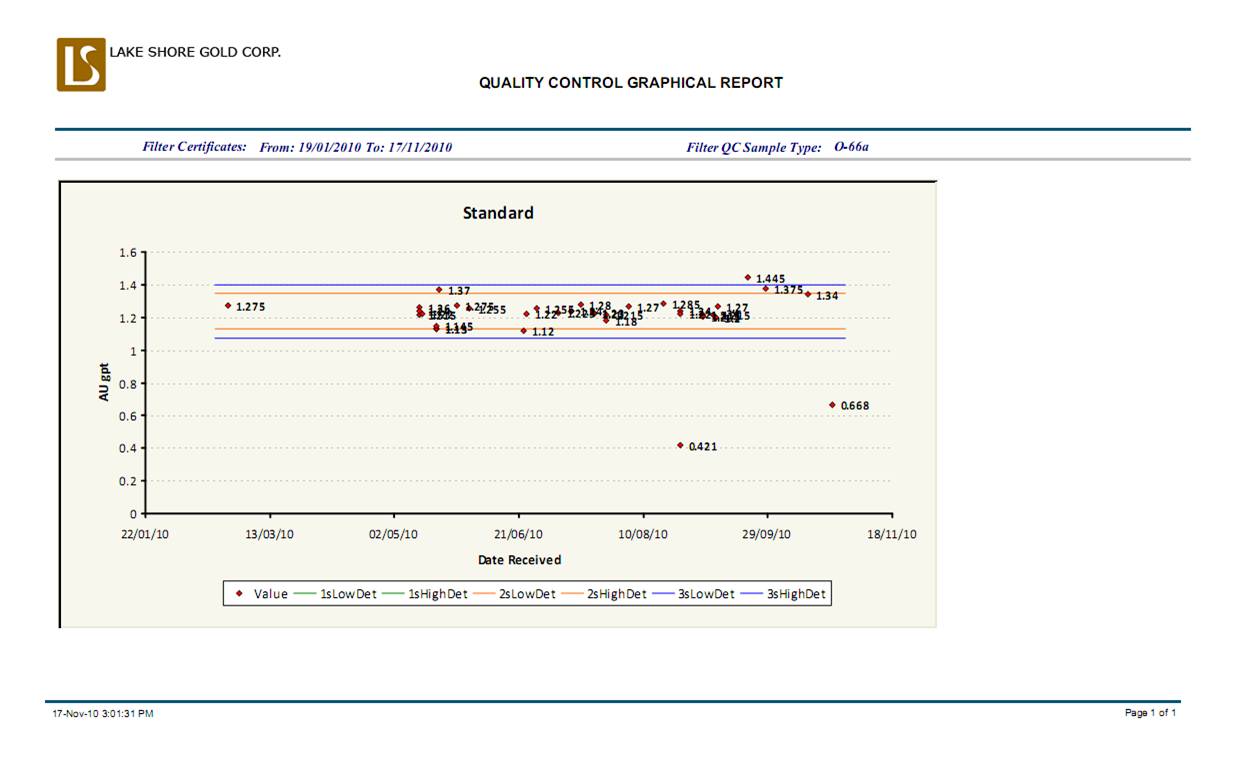
26-10
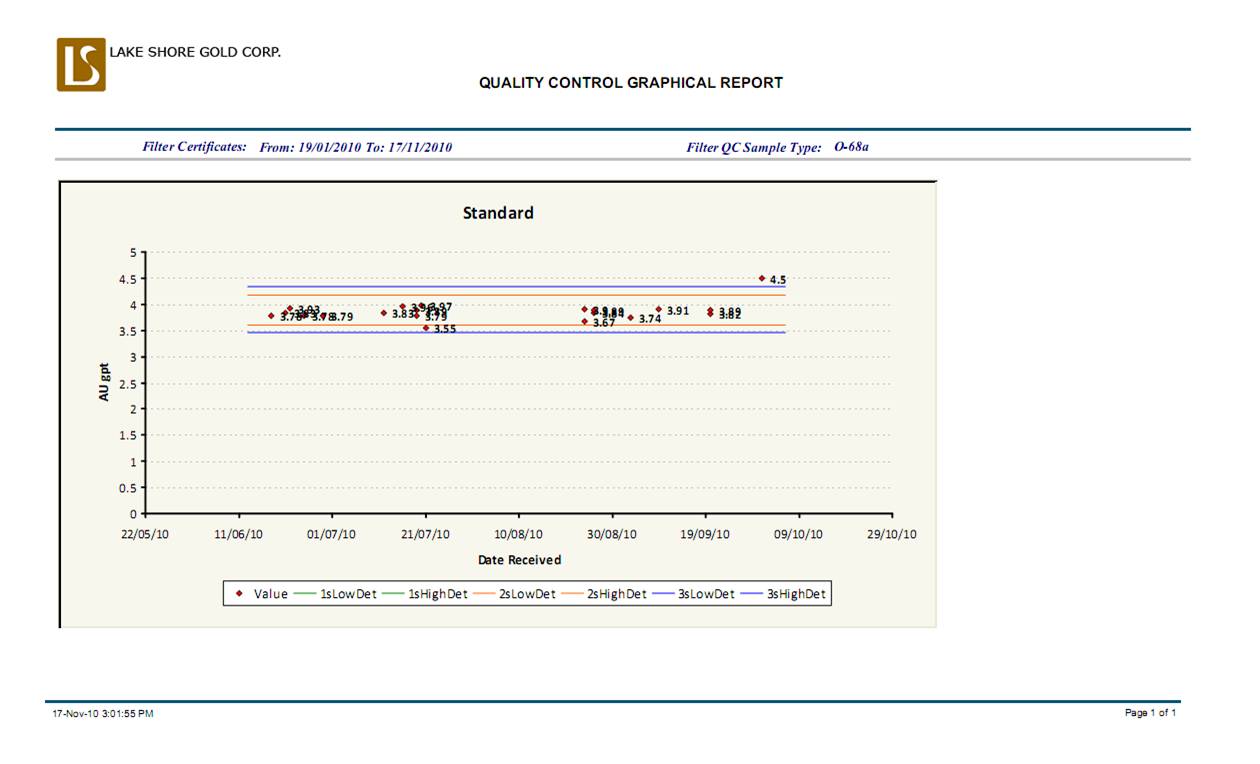
26-11
















































































